長話短說 ---- 在本文中,您將了解如何建立基於 AI 的行銷活動管理應用程式,該應用程式可讓您建立和分析廣告活動,從而使您能夠為您的業務做出正確的決策。 我們將介紹如何: - 使用 Next.js 建立 Web 應用程式, - 使用 CopilotKit 將 AI 助理整合到軟體應用程式中,以及 - 建立特定於操作的人工智慧副駕駛來處理應用程式中的各種任務。 - 建立一名競選經理  --- CopilotKit:建構應用內人工智慧副駕駛的框架 -------------------------- CopilotKit是一個[開源的AI副駕駛平台](https://github.com/CopilotKit/CopilotKit)。我們可以輕鬆地將強大的人工智慧整合到您的 React 應用程式中。 建造: - ChatBot:上下文感知的應用內聊天機器人,可以在應用程式內執行操作 💬 - CopilotTextArea:人工智慧驅動的文字字段,具有上下文感知自動完成和插入功能📝 - 聯合代理:應用程式內人工智慧代理,可以與您的應用程式和使用者互動🤖  {% cta https://git.new/devtoarticle1 %} Star CopilotKit ⭐️ {% endcta %} --- 先決條件 ---- 要完全理解本教程,您需要對 React 或 Next.js 有基本的了解。 我們還將利用以下內容: - [Radix UI](https://www.radix-ui.com/) - 用於為應用程式建立可存取的 UI 元件。 - [OpenAI API 金鑰](https://platform.openai.com/api-keys)- 使我們能夠使用 GPT 模型執行各種任務。 - [CopilotKit](https://github.com/CopilotKit/CopilotKit) - 一個開源副駕駛框架,用於建立自訂 AI 聊天機器人、應用程式內 AI 代理程式和文字區域。 --- 專案設定和套件安裝 --------- 首先,透過在終端機中執行以下程式碼片段來建立 Next.js 應用程式: ``` npx create-next-app campaign-manager ``` 選擇您首選的配置設定。在本教學中,我們將使用 TypeScript 和 Next.js App Router。  接下來,將[Heroicons](https://www.npmjs.com/package/@heroicons/react) 、 [Radix UI](https://www.radix-ui.com/)及其原始元件安裝到專案中。 ``` npm install @heroicons/react @radix-ui/react-avatar @radix-ui/react-dialog @radix-ui/react-dropdown-menu @radix-ui/react-icons @radix-ui/react-label @radix-ui/react-popover @radix-ui/react-select @radix-ui/react-slot @radix-ui/react-tabs ``` 另外,安裝[Recharts 程式庫](https://recharts.org/en-US)(一個用於建立互動式圖表的 React 程式庫)以及以下實用程式套件: ``` npm install recharts class-variance-authority clsx cmdk date-fns lodash react-day-picker tailwind-merge tailwindcss-animate ``` 最後,安裝[CopilotKit 軟體套件](https://docs.copilotkit.ai/getting-started/quickstart-chatbot)。這些套件使 AI copilot 能夠從 React 狀態檢索資料並在應用程式中做出決策。 ``` npm install @copilotkit/react-ui @copilotkit/react-textarea @copilotkit/react-core @copilotkit/backend ``` 恭喜!您現在已準備好建立應用程式。 --- 使用 Next.js 建立 Campaign Manager 應用程式 ----------------------------------- 在本節中,我將引導您建立活動管理器應用程式的使用者介面。 首先,讓我們進行一些初始設定。 在`src`資料夾中建立一個`components`和`lib`資料夾。 ``` cd src mkdir components lib ``` 在**`lib`**資料夾中,我們將聲明應用程式的靜態類型和預設活動。因此,在**`lib`**資料夾中建立**`data.ts`**和**`types.ts`**檔案。 ``` cd lib touch data.ts type.ts ``` 將下面的程式碼片段複製到`type.ts`檔中。它聲明了活動屬性及其資料類型。 ``` export interface Campaign { id: string; objective?: | "brand-awareness" | "lead-generation" | "sales-conversion" | "website-traffic" | "engagement"; title: string; keywords: string; url: string; headline: string; description: string; budget: number; bidStrategy?: "manual-cpc" | "cpa" | "cpm"; bidAmount?: number; segment?: string; } ``` 為應用程式建立預設的行銷活動清單並將其複製到`data.ts`檔案中。 ``` import { Campaign } from "./types"; export let DEFAULT_CAMPAIGNS: Campaign[] = [ { id: "1", title: "CopilotKit", url: "https://www.copilotkit.ai", headline: "Copilot Kit - The Open-Source Copilot Framework", description: "Build, deploy, and operate fully custom AI Copilots. In-app AI chatbots, AI agents, AI Textareas and more.", budget: 10000, keywords: "AI, chatbot, open-source, copilot, framework", }, { id: "2", title: "EcoHome Essentials", url: "https://www.ecohomeessentials.com", headline: "Sustainable Living Made Easy", description: "Discover our eco-friendly products that make sustainable living effortless. Shop now for green alternatives!", budget: 7500, keywords: "eco-friendly, sustainable, green products, home essentials", }, { id: "3", title: "TechGear Solutions", url: "https://www.techgearsolutions.com", headline: "Innovative Tech for the Modern World", description: "Find the latest gadgets and tech solutions. Upgrade your life with smart technology today!", budget: 12000, keywords: "tech, gadgets, innovative, modern, electronics", }, { id: "4", title: "Global Travels", url: "https://www.globaltravels.com", headline: "Travel the World with Confidence", description: "Experience bespoke travel packages tailored to your dreams. Luxury, adventure, relaxation—your journey starts here.", budget: 20000, keywords: "travel, luxury, adventure, tours, global", }, { id: "5", title: "FreshFit Meals", url: "https://www.freshfitmeals.com", headline: "Healthy Eating, Simplified", description: "Nutritious, delicious meals delivered to your door. Eating well has never been easier or tastier.", budget: 5000, keywords: "healthy, meals, nutrition, delivery, fit", }, ]; ``` 由於我們使用 Radix UI 建立可以使用 TailwindCSS 輕鬆自訂的基本 UI 元件,因此請在**`lib`**資料夾中建立一個**`utils.ts`**文件,並將以下程式碼片段複製到該文件中。 ``` //👉🏻 The lib folder now contains 3 files - data.ts, type.ts, util.ts //👇🏻 Copy the code below into the "lib/util.ts" file. import { type ClassValue, clsx } from "clsx"; import { twMerge } from "tailwind-merge"; export function cn(...inputs: ClassValue[]) { return twMerge(clsx(inputs)); } export function randomId() { return Math.random().toString(36).substring(2, 15); } ``` 導航到`components`資料夾並在其中建立其他三個資料夾。 ``` cd components mkdir app dashboard ui ``` `components/app`資料夾將包含應用程式中使用的各種元件,而儀表板資料夾包含某些元素的 UI 元件。 `ui`資料夾包含使用 Radix UI 建立的多個 UI 元素。將[專案儲存庫中的這些元素](https://github.com/CopilotKit/campaign-manager-demo/tree/main/src/components/ui)複製到該資料夾中。 恭喜! `ui`資料夾應包含必要的 UI 元素。現在,我們可以使用它們來建立應用程式中所需的各種元件。 ### 建立應用程式 UI 元件 在這裡,我將引導您完成為應用程式建立使用者介面的過程。  首先,導航至**`app/page.tsx`**檔案並將以下程式碼片段貼到其中。該文件呈現在**`components/app`**資料夾中聲明的 App 元件。 ``` "use client"; import { App } from "@/components/app/App"; export default function DashboardPage() { return <App />; } ``` 在`components/app`資料夾中建立`App.tsx` 、 `CampaignForm.tsx` 、 `MainNav.tsx`和`UserNav.tsx`檔案。 ``` cd components/app touch App.tsx CampaignForm.tsx MainNav.tsx UserNav.tsx ``` 將下面的程式碼片段複製到`App.tsx`檔案中。 ``` "use client"; import { DEFAULT_CAMPAIGNS } from "@/lib/data"; import { Campaign } from "@/lib/types"; import { randomId } from "@/lib/utils"; import { Dashboard } from "../dashboard/Dashboard"; import { CampaignForm } from "./CampaignForm"; import { useState } from "react"; import _ from "lodash"; export function App() { //👇🏻 default segments const [segments, setSegments] = useState<string[]>([ "Millennials/Female/Urban", "Parents/30s/Suburbs", "Seniors/Female/Rural", "Professionals/40s/Midwest", "Gamers/Male", ]); const [campaigns, setCampaigns] = useState<Campaign[]>( _.cloneDeep(DEFAULT_CAMPAIGNS) ); //👇🏻 updates campaign list function saveCampaign(campaign: Campaign) { //👇🏻 newly created campaign if (campaign.id === "") { campaign.id = randomId(); setCampaigns([campaign, ...campaigns]); } else { //👇🏻 existing campaign - search for the campaign and updates the campaign list const index = campaigns.findIndex((c) => c.id === campaign.id); if (index === -1) { setCampaigns([...campaigns, campaign]); } else { campaigns[index] = campaign; setCampaigns([...campaigns]); } } } const [currentCampaign, setCurrentCampaign] = useState<Campaign | undefined>( undefined ); return ( <div className='relative'> <CampaignForm segments={segments} currentCampaign={currentCampaign} setCurrentCampaign={setCurrentCampaign} saveCampaign={(campaign) => { if (campaign) { saveCampaign(campaign); } setCurrentCampaign(undefined); }} /> <Dashboard campaigns={campaigns} setCurrentCampaign={setCurrentCampaign} segments={segments} setSegments={setSegments} /> </div> ); } ``` - 從上面的程式碼片段來看, - 我為行銷活動建立了預設細分列表,並對已定義的行銷活動列表進行了深層複製。 - `saveCampaign`函數接受行銷活動作為參數。如果行銷活動沒有 ID,則表示它是新建立的,因此會將其新增至行銷活動清單。否則,它會找到該活動並更新其屬性。 - `Dashboard`和`CampaignForm`元件接受細分和行銷活動作為 props。 [Dashboard 元件](https://github.com/CopilotKit/campaign-manager-demo/blob/main/src/components/dashboard/Dashboard.tsx)在儀表板上顯示各種 UI 元素,而[CampaignForm 元件](https://github.com/CopilotKit/campaign-manager-demo/blob/main/src/components/app/CampaignForm.tsx)使用戶能夠在應用程式中建立和保存新的行銷活動。 您也可以使用[GitHub 儲存庫](https://github.com/CopilotKit/campaign-manager-demo/tree/main/src/components)中的程式碼片段來更新儀表板和應用程式元件。 恭喜!您應該有一個有效的 Web 應用程式,可讓使用者查看和建立新的行銷活動。 在接下來的部分中,您將了解如何將 CopilotKit 加入到應用程式中,以根據每個行銷活動的目標和預算進行分析和決策。  --- 使用 CopilotKit 透過 AI 分析廣告活動 -------------------------- 在這裡,您將學習如何將人工智慧加入到應用程式中,以幫助您分析行銷活動並做出最佳決策。 在繼續之前,請造訪[OpenAI 開發者平台](https://platform.openai.com/api-keys)並建立一個新的金鑰。  建立一個`.env.local`檔案並將新建立的金鑰複製到該檔案中。 ``` OPENAI_API_KEY=<YOUR_OPENAI_SECRET_KEY> OPENAI_MODEL=gpt-4-1106-preview ``` 接下來,您需要為 CopilotKit 建立 API 端點。在 Next.js 應用程式資料夾中,建立一個包含`route.ts`檔案的`api/copilotkit`資料夾。 ``` cd app mkdir api && cd api mkdir copilotkit && cd copilotkit touch route.ts ``` 將下面的程式碼片段複製到`route.ts`檔中。 [CopilotKit 後端](https://docs.copilotkit.ai/reference/CopilotBackend)接受使用者的請求並使用 OpenAI 模型做出決策。 ``` import { CopilotBackend, OpenAIAdapter } from "@copilotkit/backend"; export const runtime = "edge"; export async function POST(req: Request): Promise<Response> { const copilotKit = new CopilotBackend({}); const openaiModel = process.env["OPENAI_MODEL"]; return copilotKit.response(req, new OpenAIAdapter({ model: openaiModel })); } ``` 若要將您的應用程式連接到此 API 端點,請更新`app/page.tsx`文件,如下所示: ``` "use client"; import { App } from "@/components/app/App"; import { CopilotKit } from "@copilotkit/react-core"; import { CopilotSidebar } from "@copilotkit/react-ui"; export default function DashboardPage() { return ( <CopilotKit url='/api/copilotkit/'> <CopilotSidebar instructions='Help the user create and manage ad campaigns.' defaultOpen={true} labels={{ title: "Campaign Manager Copilot", initial: "Hello there! I can help you manage your ad campaigns. What campaign would you like to work on?", }} clickOutsideToClose={false} > <App /> </CopilotSidebar> </CopilotKit> ); } ``` `CopilotKit`元件包裝整個應用程式並接受包含 API 端點連結的`url`屬性。 `CopilotSidebar`元件為應用程式加入了一個聊天機器人側邊欄面板,使我們能夠向 CopilotKit 提供各種指令。  ### 如何讓AI副駕駛執行各種動作 CopilotKit 提供了兩個鉤子,使我們能夠處理使用者的請求並插入應用程式狀態: [useCopilotAction](https://docs.copilotkit.ai/reference/useCopilotAction)和[useMakeCopilotReadable](https://docs.copilotkit.ai/reference/useMakeCopilotReadable) 。 `useCopilotAction`掛鉤可讓您定義 CopilotKit 執行的動作。它接受包含以下參數的物件: - name - 操作的名稱。 - 描述 - 操作的描述。 - 參數 - 包含所需參數清單的陣列。 - render - 預設的自訂函數或字串。 - handler - 由操作觸發的可執行函數。 ``` useCopilotAction({ name: "sayHello", description: "Say hello to someone.", parameters: [ { name: "name", type: "string", description: "name of the person to say greet", }, ], render: "Process greeting message...", handler: async ({ name }) => { alert(`Hello, ${name}!`); }, }); ``` `useMakeCopilotReadable`掛鉤向 CopilotKit 提供應用程式狀態。 ``` import { useMakeCopilotReadable } from "@copilotkit/react-core"; const appState = ...; useMakeCopilotReadable(JSON.stringify(appState)); ``` CopilotKit 還允許您為使用者提示提供上下文,使其能夠做出充分且準確的決策。 將`guidance.ts`和`script.ts`加入到專案內的`lib`資料夾中,並將此[指導](https://github.com/CopilotKit/campaign-manager-demo/blob/main/src/lib/guideline.ts)和[腳本建議](https://github.com/CopilotKit/campaign-manager-demo/blob/main/src/lib/script.ts)複製到檔案中,以便 CopilotKit 做出決策。 在應用程式元件中,將當前日期、腳本建議和指導傳遞到 CopilotKit。 ``` import { GUIDELINE } from "@/lib/guideline"; import { SCRIPT_SUGGESTION } from "@/lib/script"; import { useCopilotAction, useMakeCopilotReadable, } from "@copilotkit/react-core"; export function App() { //-- 👉🏻 ...other component functions //👇🏻 Ground the Copilot with domain-specific knowledge for this use-case: marketing campaigns. useMakeCopilotReadable(GUIDELINE); useMakeCopilotReadable(SCRIPT_SUGGESTION); //👇🏻 Provide the Copilot with the current date. useMakeCopilotReadable("Today's date is " + new Date().toDateString()); return ( <div className='relative'> <CampaignForm segments={segments} currentCampaign={currentCampaign} setCurrentCampaign={setCurrentCampaign} saveCampaign={(campaign) => { if (campaign) { saveCampaign(campaign); } setCurrentCampaign(undefined); }} /> <Dashboard campaigns={campaigns} setCurrentCampaign={setCurrentCampaign} segments={segments} setSegments={setSegments} /> </div> ); } ``` 在`App`元件中建立一個 CopilotKit 操作,該操作可在使用者提供此類指令時建立新的活動或編輯現有的活動。 ``` useCopilotAction({ name: "updateCurrentCampaign", description: "Edit an existing campaign or create a new one. To update only a part of a campaign, provide the id of the campaign to edit and the new values only.", parameters: [ { name: "id", description: "The id of the campaign to edit. If empty, a new campaign will be created", type: "string", }, { name: "title", description: "The title of the campaign", type: "string", required: false, }, { name: "keywords", description: "Search keywords for the campaign", type: "string", required: false, }, { name: "url", description: "The URL to link the ad to. Most of the time, the user will provide this value, leave it empty unless asked by the user.", type: "string", required: false, }, { name: "headline", description: "The headline displayed in the ad. This should be a 5-10 words", type: "string", required: false, }, { name: "description", description: "The description displayed in the ad. This should be a short text", type: "string", required: false, }, { name: "budget", description: "The budget of the campaign", type: "number", required: false, }, { name: "objective", description: "The objective of the campaign", type: "string", enum: [ "brand-awareness", "lead-generation", "sales-conversion", "website-traffic", "engagement", ], }, { name: "bidStrategy", description: "The bid strategy of the campaign", type: "string", enum: ["manual-cpc", "cpa", "cpm"], required: false, }, { name: "bidAmount", description: "The bid amount of the campaign", type: "number", required: false, }, { name: "segment", description: "The segment of the campaign", type: "string", required: false, enum: segments, }, ], handler: (campaign) => { const newValue = _.assign( _.cloneDeep(currentCampaign), _.omitBy(campaign, _.isUndefined) ) as Campaign; setCurrentCampaign(newValue); }, render: (props) => { if (props.status === "complete") { return "Campaign updated successfully"; } else { return "Updating campaign"; } }, }); ``` {% 嵌入 https://www.youtube.com/watch?v=gCJpH6Tnj5g %} 新增另一個模擬 API 呼叫的操作,以允許 CopilotKit 從先前建立的活動中檢索歷史資料。 ``` // Provide this component's Copilot with the ability to retrieve historical cost data for certain keywords. // Will be called automatically when needed by the Copilot. useCopilotAction({ name: "retrieveHistoricalData", description: "Retrieve historical data for certain keywords", parameters: [ { name: "keywords", description: "The keywords to retrieve data for", type: "string", }, { name: "type", description: "The type of data to retrieve for the keywords.", type: "string", enum: ["CPM", "CPA", "CPC"], }, ], handler: async ({ type }) => { // fake an API call that retrieves historical data for cost for certain keywords based on campaign type (CPM, CPA, CPC) await new Promise((resolve) => setTimeout(resolve, 2000)); function getRandomValue(min: number, max: number) { return (Math.random() * (max - min) + min).toFixed(2); } if (type == "CPM") { return getRandomValue(0.5, 10); } else if (type == "CPA") { return getRandomValue(5, 100); } else if (type == "CPC") { return getRandomValue(0.2, 2); } }, render: (props) => { // Custom in-chat component rendering. Different components can be rendered based on the status of the action. let label = "Retrieving historical data ..."; if (props.args.type) { label = `Retrieving ${props.args.type} for keywords ...`; } if (props.status === "complete") { label = `Done retrieving ${props.args.type} for keywords.`; } const done = props.status === "complete"; return ( <div className=''> <div className=' w-full relative max-w-xs'> <div className='absolute inset-0 h-full w-full bg-gradient-to-r from-blue-500 to-teal-500 transform scale-[0.80] bg-red-500 rounded-full blur-3xl' /> <div className='relative shadow-xl bg-gray-900 border border-gray-800 px-4 py-8 h-full overflow-hidden rounded-2xl flex flex-col justify-end items-start'> <h1 className='font-bold text-sm text-white mb-4 relative z-50'> {label} </h1> <p className='font-normal text-base text-teal-200 mb-2 relative z-50 whitespace-pre'> {props.args.type && `Historical ${props.args.type}: ${props.result || "..."}`} </p> </div> </div> </div> ); }, }); ```  恭喜!您已完成本教學的專案。 結論 -- [CopilotKit](https://copilotkit.ai/)是一款令人難以置信的工具,可讓您在幾分鐘內將 AI Copilot 加入到您的產品中。無論您是對人工智慧聊天機器人和助理感興趣,還是對複雜任務的自動化感興趣,CopilotKit 都能讓您輕鬆實現。 如果您需要建立 AI 產品或將 AI 工具整合到您的軟體應用程式中,您應該考慮 CopilotKit。 您可以在 GitHub 上找到本教學的源程式碼: <https://github.com/CopilotKit/campaign-manager-demo> 感謝您的閱讀! --- 原文出處:https://dev.to/copilotkit/build-an-ai-powered-campaign-manager-nextjs-openai-copilotkit-59ii
ReactJS 庫已經上市很久了,我們都非常了解它的強大功能。我們都知道如何使用 ReactJS 建立 UI、建立元件等等。如果您不了解 React,您可以使用大量線上免費資源。 在本部落格中,我們將研究 Wing 以及如何建立連接到 Wing 後端的 React 應用程式。 Wing 是世界上第一個在雲端服務上執行的雲端程式語言。 Wing 讓開發人員可以輕鬆建置和部署雲端應用程式。 Wing 使得在單一模型中編寫基礎設施程式碼 (terraform) 和應用程式程式碼成為可能。 Wing 附帶一個標準函式庫“cloud”,並有“Api”方法。 Api 方法表示客戶端可以透過 Internet 呼叫的 HTTP 端點的集合。此 Api 方法可用於建立一個 API,該 API 可以作為後端 API 來儲存和擷取資料。 您可以嘗試使用 Winglang 語言並了解它在[遊樂場功能](http://winglang.io/play)中的工作原理。 讓我們建立一個 React 應用程式,它將連接到使用 Wing 建立的 API。 安裝 -- 在您的裝置中安裝[Wing 工具鏈](https://www.winglang.io/)。確保您的裝置中有 Node.js 18.13.0 或更高版本。要安裝 Wing Toolchain,請在您的裝置中執行以下命令 - ``` npm install -g winglang ``` 安裝[VS Code 市場](https://marketplace.visualstudio.com/items?itemName=Monada.vscode-wing)上提供的 Wing VS code 擴充。 您可以檢查已安裝的 Wing CLI 的版本: ``` wing --version ``` 建立專案 ---- 在檔案系統中建立專案目錄並為其指定所需的名稱。在 VS Code 中開啟此目錄。在專案目錄中建立一個名為 backend 的目錄。 在後端目錄中建立一個名為“main.w”的文件,並將以下程式碼貼到其中: ``` bring cloud; let queue = new cloud.Queue(); let bucket = new cloud.Bucket(); let counter = new cloud.Counter(); queue.setConsumer(inflight (body: str): void => { let next = counter.inc(); let key = "key-{next}"; bucket.put(key, body); }); ``` *注意:如果您在整個過程中遇到任何困難,我們建議您加入我們的[Slack 頻道](https://t.winglang.io/slack)* 在本地執行 Wing 工具鏈以檢查其是否按預期工作。在終端機中執行此命令: ``` wing run backend/main.w ``` 輸出顯示將是: 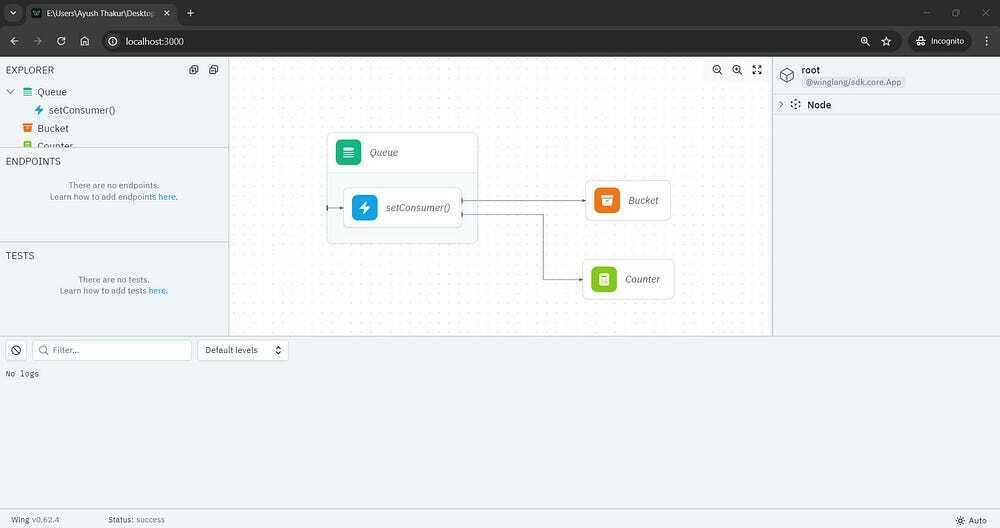 這是 Wing Console,它充當模擬器,您可以在其中嘗試、測試和試驗雲端應用程式,看看它是否正常工作。 建立反應應用程式 -------- 現在讓我們建立一個 React App 作為前端,然後將其連接到我們建立的 Wing 後端。 我們將使用`create-react-app`在您的專案目錄中建立 React App。確保您位於主專案目錄內,而不是後端目錄內。 打開一個新終端機並執行以下命令: ``` npx create-react-app client cd client npm i --save @babel/plugin-proposal-private-property-in-object npm start ``` 一旦您看到 React 應用程式成功執行,您可以使用`CTRL+C`關閉伺服器。 連接Wing後端 -------- 現在,我們將 Wing 後端連接到我們的 React 應用程式。它將允許我們從 Wing 後端獲取資料並將其顯示在使用者介面上。 開啟`backend/main.w`檔案並將其內容替換為: 對於 Windows: ``` bring ex; bring cloud; let react = new ex.ReactApp( useBuildCommand: true, projectPath: "../client", buildCommand: "npm run start", ); ``` 對於Linux: ``` bring ex; bring cloud; let react = new ex.ReactApp( projectPath: "../client", ); ``` 使用`CTRL+C`終止`wing run`正在執行的終端,並使用設定`BROWSER=none`環境變數再次執行它: 對於 Windows: ``` set BROWSER=none wing run backend/main.w ``` 對於 Linux/Mac: ``` BROWSER=none wing run backend/main.w ``` `BROWSER=none`將限制 React 在每次執行時開啟一個新的瀏覽器視窗。 現在,您已經成功執行了一個連接到 Wing 工具鏈後端的 React 應用程式。 將配置從後端傳遞到前端 ----------- Wing 在`client/public/wing.js`中產生一個`wing.js`文件,該文件將配置從 Wing 後端傳遞到前端程式碼。 該文件的目前內容將包含: ``` // This file is generated by Wing window.wingEnv = {}; ``` 將以下程式碼加入`backend/main.w` : ``` react.addEnvironment("key1", "value1"); ``` 正在執行的`wing run`會將此鍵值對新增至`client/public/wing.js` : ``` // This file is generated by wing window.wingEnv = { "key1": "value1" }; ``` 現在,您需要將前端程式碼連結到`wing.js`檔案。將以下程式碼複製並貼上到`client/public/index.html`檔案中的`<title>`標記上方: ``` <script src="./wing.js"></script> ``` 我們將從後端獲取標題並將其顯示在 React 應用程式中。將`client/src/App.js`檔案中的「Learn React」(出現在第 18 行左右)字串替換為以下程式碼: ``` {window.wingEnv.title || "Learn React"} ``` 此表達式顯示從 React 應用程式中的 wingEnv 物件動態取得的標題。如果 wingEnv 物件沒有 title 屬性或 window.wingEnv.title 的值為假,它將顯示預設標題「Learn React」。 返回`backend/main.w`並加入以下程式碼: ``` react.addEnvironment("title", "Learn React with Wing"); ``` 這將在`wing.js`檔案中加入包含`Learn React with Wing`訊息的`title`鍵。 從後台取得標題 ------- 現在我們知道如何從客戶端向後端傳遞參數(資料)。我們可以使用這種做法在客戶端設定`window.wingEnv.apiUrl`並從後端取得標題。 我們需要透過在`backend/main.w`檔案中加入以下程式碼來啟用跨域資源共享(CORS): ``` let api = new cloud.Api( cors: true ); ``` 這會將`apiUrl`鍵和後端 API 的目前 URL 新增到`main.w`檔案中。 在後端 API 中建立`/title`路由。將此程式碼加入`backend/main.w`檔案: ``` api.get("/title", inflight () => { return { status: 200, body: "Hello from the API" }; }); ``` 當向`/tite`端點發出 GET 請求時,伺服器將使用 HTTP 狀態碼 200 和`Hello from the API`進行回應。 您可以根據您的意願更改此正文資訊。 將以下程式碼替換為`client/src/App.js`中的內容: ``` import logo from './logo.svg'; import { useEffect, useState } from "react"; import './App.css'; function App() { const [title, setTitle] = useState("Default Value"); const getTitle = async () => { const response = await fetch(`${window.wingEnv.apiUrl}/title`); setTitle(await response.text()); } useEffect(() => { getTitle(); }, []); return ( <div className="App"> <header className="App-header"> <img src={logo} className="App-logo" alt="logo" /> {title} </header> </div> ); } export default App; ``` 在這裡,我們使用`fetch`方法從後端 API 取得標題, `useState`和`useEffect`鉤子用於將取得的標題儲存在`title`變數中。 最終輸出將是:  恭喜!您已成功建立一個從 Wing 工具鏈後端取得資料的 React 應用程式。 這就是您如何將資料儲存在 Winglang 後端並獲取它以將其顯示在前端 UI 上。 有什麼地方卡住了嗎?請查看我們的影片教程,我們已經實際解釋了整個過程: {% 嵌入 https://www.youtube.com/embed/LMDnTCRXzJU?si=vuFGkqoK2fKBXb00 %} --- 原文出處:https://dev.to/ayush2390/create-react-app-with-wing-30hm
**長話短說** -------- 在本文中,您將學習如何建立人工智慧驅動的電子表格應用程式,該應用程式允許您使用簡單的英語命令執行各種會計功能並輕鬆與資料互動。 我們將介紹如何: - 使用 Next.js 建立 Web 應用程式, - 使用 React Spreadsheet 建立電子表格應用程式,以及 - 使用 CopilotKit 將 AI 整合到軟體應用程式中。 - 讓電子表格更容易使用、更有趣  --- CopilotKit:建構應用內人工智慧副駕駛的框架 ========================== CopilotKit是一個[開源的AI副駕駛平台](https://github.com/CopilotKit/CopilotKit)。我們可以輕鬆地將強大的人工智慧整合到您的 React 應用程式中。 建造: - ChatBot:上下文感知的應用內聊天機器人,可以在應用程式內執行操作 💬 - CopilotTextArea:人工智慧驅動的文字字段,具有上下文感知自動完成和插入功能📝 - 聯合代理:應用程式內人工智慧代理,可以與您的應用程式和使用者互動🤖  {% cta https://github.com/CopilotKit/CopilotKit %} Star CopilotKit ⭐️ {% endcta %} (請原諒 AI 的拼字錯誤並給 CopilotKit 加上星號:) 現在回到文章! --- 先決條件 ---- 要完全理解本教程,您需要對 React 或 Next.js 有基本的了解。 以下是建立人工智慧驅動的電子表格應用程式所需的工具: - [React Spreadsheet](https://github.com/iddan/react-spreadsheet) - 一個簡單的包,使我們能夠在 React 應用程式中加入電子表格。 - [OpenAI API](https://platform.openai.com/api-keys) - 提供 API 金鑰,使我們能夠使用 ChatGPT 模型執行各種任務。 - [Tavily AI](https://tavily.com/) - 一個搜尋引擎,使人工智慧代理能夠在應用程式中進行研究並存取即時知識。 - [CopilotKit](https://github.com/CopilotKit) - 一個開源副駕駛框架,用於建立自訂 AI 聊天機器人、應用程式內 AI 代理程式和文字區域。 專案設定和套件安裝 --------- 首先,透過在終端機中執行以下程式碼片段來建立 Next.js 應用程式: ``` npx create-next-app spreadsheet-app ``` 選擇您首選的配置設定。在本教學中,我們將使用 TypeScript 和 Next.js App Router。  接下來,安裝[OpenAI 函式庫](https://platform.openai.com/docs/introduction)、 [Heroicons](https://www.npmjs.com/package/@heroicons/react)和[React Spreadsheet](https://github.com/iddan/react-spreadsheet)套件及其相依性: ``` npm install openai react-spreadsheet scheduler @heroicons/react ``` 最後,安裝 CopilotKit 軟體套件。這些套件使我們能夠從 React 狀態檢索資料並將 AI copilot 新增至應用程式。 ``` npm install @copilotkit/react-ui @copilotkit/react-textarea @copilotkit/react-core @copilotkit/backend ``` 恭喜!您現在已準備好建立應用程式。 --- 建立電子表格應用程式 ---------- 在本節中,我將引導您使用 React Spreadsheet 建立電子表格應用程式。 該應用程式分為兩個元件: `Sidebar`和`SingleSpreadsheet` 。 要設定這些元件,請導航至 Next.js 應用程式資料夾並建立一個包含以下檔案的`components`資料夾: ``` cd app mkdir components && cd components touch Sidebar.tsx SingleSpreadsheet.tsx ``` 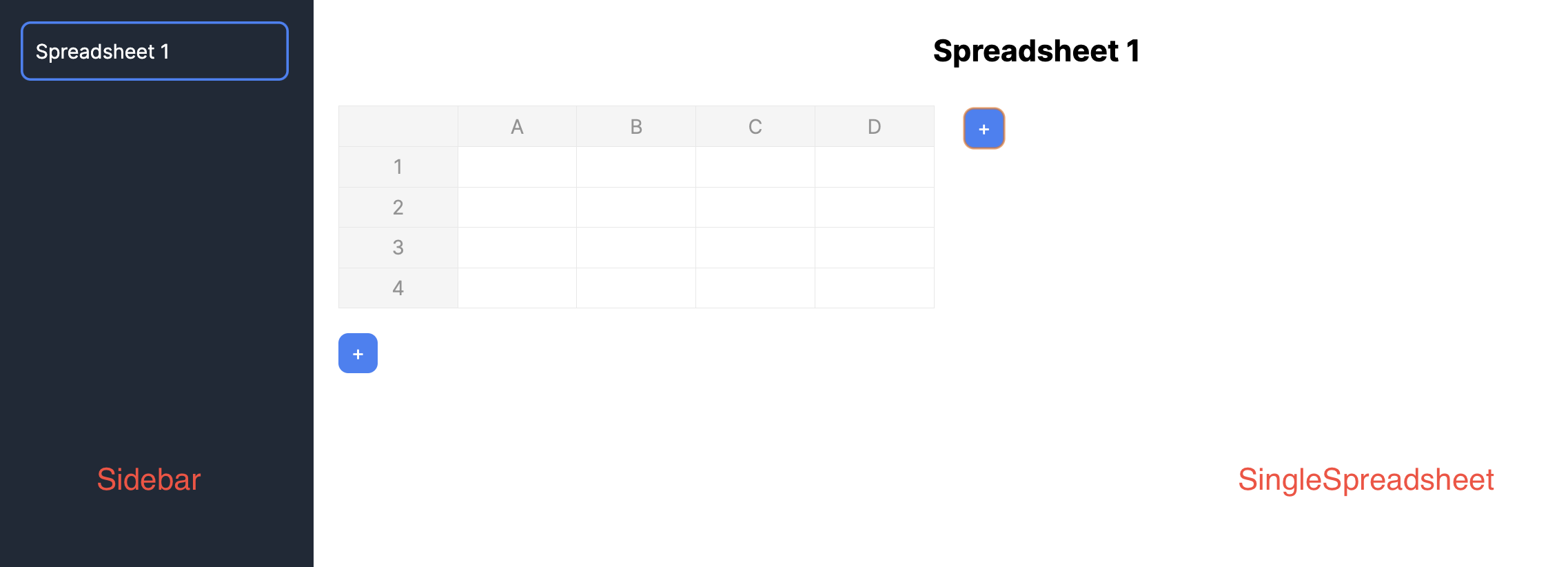 將新建立的元件匯入到**`app/page.tsx`**檔案中。 ``` "use client"; import React, { useState } from "react"; //👇🏻 import the components import { SpreadsheetData } from "./types"; import Sidebar from "./components/Sidebar"; import SingleSpreadsheet from "./components/SingleSpreadsheet"; const Main = () => { return ( <div className='flex'> <p>Hello world</p> </div> ); }; export default Main; ``` 接下來,建立將包含電子表格資料的 React 狀態,並將它們作為 props 傳遞到元件中。 ``` const Main = () => { //👇🏻 holds the title and data within a spreadsheet const [spreadsheets, setSpreadsheets] = React.useState<SpreadsheetData[]>([ { title: "Spreadsheet 1", data: [ [{ value: "" }, { value: "" }, { value: "" }], [{ value: "" }, { value: "" }, { value: "" }], [{ value: "" }, { value: "" }, { value: "" }], ], }, ]); //👇🏻 represents the index of a spreadsheet const [selectedSpreadsheetIndex, setSelectedSpreadsheetIndex] = useState(0); return ( <div className='flex'> <Sidebar spreadsheets={spreadsheets} selectedSpreadsheetIndex={selectedSpreadsheetIndex} setSelectedSpreadsheetIndex={setSelectedSpreadsheetIndex} /> <SingleSpreadsheet spreadsheet={spreadsheets[selectedSpreadsheetIndex]} setSpreadsheet={(spreadsheet) => { setSpreadsheets((prev) => { console.log("setSpreadsheet", spreadsheet); const newSpreadsheets = [...prev]; newSpreadsheets[selectedSpreadsheetIndex] = spreadsheet; return newSpreadsheets; }); }} /> </div> ); }; ``` 此程式碼片段建立了 React 狀態,用於保存電子表格資料及其索引,並將它們作為 props 傳遞到元件中。 `Sidebar`元件接受所有可用的電子表格, `SingleSpreadsheet`元件接收所有電子表格,包括更新電子表格資料的`setSpreadsheet`函數。 將下面的程式碼片段複製到`Sidebar.tsx`檔案中。它顯示應用程式中的所有電子表格,並允許使用者在它們之間進行切換。 ``` import React from "react"; import { SpreadsheetData } from "../types"; interface SidebarProps { spreadsheets: SpreadsheetData[]; selectedSpreadsheetIndex: number; setSelectedSpreadsheetIndex: (index: number) => void; } const Sidebar = ({ spreadsheets, selectedSpreadsheetIndex, setSelectedSpreadsheetIndex, }: SidebarProps) => { return ( <div className='w-64 h-screen bg-gray-800 text-white overflow-auto p-5'> <ul> {spreadsheets.map((spreadsheet, index) => ( <li key={index} className={`mb-4 cursor-pointer ${ index === selectedSpreadsheetIndex ? "ring-2 ring-blue-500 ring-inset p-3 rounded-lg" : "p-3" }`} onClick={() => setSelectedSpreadsheetIndex(index)} > {spreadsheet.title} </li> ))} </ul> </div> ); }; export default Sidebar; ``` 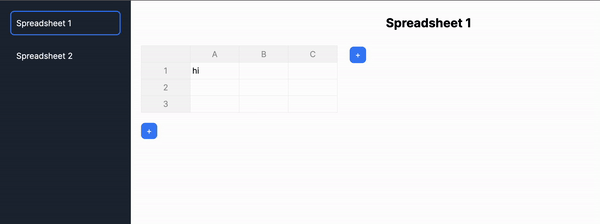 更新`SingleSpreadsheet.tsx`文件,如下所示: ``` import React from "react"; import Spreadsheet from "react-spreadsheet"; import { SpreadsheetData, SpreadsheetRow } from "../types"; interface MainAreaProps { spreadsheet: SpreadsheetData; setSpreadsheet: (spreadsheet: SpreadsheetData) => void; } //👇🏻 adds a new row to the spreadsheet const addRow = () => { const numberOfColumns = spreadsheet.rows[0].length; const newRow: SpreadsheetRow = []; for (let i = 0; i < numberOfColumns; i++) { newRow.push({ value: "" }); } setSpreadsheet({ ...spreadsheet, rows: [...spreadsheet.rows, newRow], }); }; //👇🏻 adds a new column to the spreadsheet const addColumn = () => { const spreadsheetData = [...spreadsheet.data]; for (let i = 0; i < spreadsheet.data.length; i++) { spreadsheet.data[i].push({ value: "" }); } setSpreadsheet({ ...spreadsheet, data: spreadsheetData, }); }; const SingleSpreadsheet = ({ spreadsheet, setSpreadsheet }: MainAreaProps) => { return ( <div className='flex-1 overflow-auto p-5'> {/** -- Spreadsheet title ---*/} <div className='flex items-start'> {/** -- Spreadsheet rows and columns---*/} {/** -- Add column button ---*/} </div> {/** -- Add row button ---*/} </div> ); }; export default SingleSpreadsheet; ``` - 從上面的程式碼片段來看, ``` - The `SingleSpreadsheet.tsx` file includes the addRow and addColumn functions. ``` ``` - The `addRow` function calculates the current number of rows, adds a new row, and updates the spreadsheet accordingly. ``` ``` - Similarly, the `addColumn` function adds a new column to the spreadsheet. ``` ``` - The `SingleSpreadsheet` component renders placeholders for the user interface elements. ``` 更新`SingleSpreadsheet`元件以呈現電子表格標題、其資料以及新增行和列按鈕。 ``` return ( <div className='flex-1 overflow-auto p-5'> {/** -- Spreadsheet title ---*/} <input type='text' value={spreadsheet.title} className='w-full p-2 mb-5 text-center text-2xl font-bold outline-none bg-transparent' onChange={(e) => setSpreadsheet({ ...spreadsheet, title: e.target.value }) } /> {/** -- Spreadsheet rows and columns---*/} <div className='flex items-start'> <Spreadsheet data={spreadsheet.data} onChange={(data) => { console.log("data", data); setSpreadsheet({ ...spreadsheet, data: data as any }); }} /> {/** -- Add column button ---*/} <button className='bg-blue-500 text-white rounded-lg ml-6 w-8 h-8 mt-0.5' onClick={addColumn} > + </button> </div> {/** -- Add row button ---*/} <button className='bg-blue-500 text-white rounded-lg w-8 h-8 mt-5 ' onClick={addRow} > + </button> </div> ); ``` 為了確保一切按預期工作,請在`app`資料夾中建立一個`types.ts`文件,其中包含應用程式中聲明的所有靜態類型。 ``` export interface Cell { value: string; } export type SpreadsheetRow = Cell[]; export interface SpreadsheetData { title: string; rows: SpreadsheetRow[]; } ``` 恭喜! 🎉 您的電子表格應用程式應該可以完美執行。在接下來的部分中,您將了解如何新增 AI 副駕駛,以使用 CopilotKit 自動執行各種任務。 --- 使用 CopilotKit 改進應用程式功能 ---------------------- 在這裡,您將學習如何將 AI 副駕駛加入到電子表格應用程式,以使用 CopilotKit 自動執行複雜的操作。 CopilotKit 提供前端和[後端](https://docs.copilotkit.ai/getting-started/quickstart-backend)套件。它們使您能夠插入 React 狀態並使用 AI 代理在後端處理應用程式資料。 首先,我們將 CopilotKit React 元件新增到應用程式前端。 ### 將 CopilotKit 加入前端 在`app/page.tsx`中,將以下程式碼片段加入`Main`元件的頂部。 ``` import "@copilotkit/react-ui/styles.css"; import { CopilotKit } from "@copilotkit/react-core"; import { CopilotSidebar } from "@copilotkit/react-ui"; import { INSTRUCTIONS } from "./instructions"; const HomePage = () => { return ( <CopilotKit url='/api/copilotkit'> <CopilotSidebar instructions={INSTRUCTIONS} labels={{ initial: "Welcome to the spreadsheet app! How can I help you?", }} defaultOpen={true} clickOutsideToClose={false} > <Main /> </CopilotSidebar> </CopilotKit> ); }; const Main = () => { //--- Main component // }; export default HomePage; ``` - 從上面的程式碼片段來看, ``` - I imported the CopilotKit, its sidebar component, and CSS file to use its frontend components within the application. ``` ``` - The [CopilotKit component](https://docs.copilotkit.ai/reference/CopilotKit) accepts a `url` prop that represents the API server route where CopilotKit will be configured. ``` ``` - The Copilot component also renders the [CopilotSidebar component](https://docs.copilotkit.ai/reference/CopilotSidebar) , allowing users to provide custom instructions to the AI copilot within the application. ``` ``` - Lastly, you can export the `HomePage` component containing the `CopilotSidebar` and the `Main` components. ``` 從上面的程式碼片段中,您會注意到`CopilotSidebar`元件有一個`instructions`屬性。此屬性使您能夠為 CopilotKit 提供額外的上下文或指導。 因此,在`app`資料夾中建立`instructions.ts`檔案並將這些[命令](https://github.com/CopilotKit/spreadsheet-demo/blob/main/src/app/instructions.ts)複製到該檔案中。  接下來,您需要將 CopilotKit 插入應用程式的狀態以存取應用程式的資料。為了實現這一點,CopilotKit 提供了兩個鉤子: [useCopilotAction](https://docs.copilotkit.ai/reference/useCopilotAction)和[useMakeCopilotReadable](https://docs.copilotkit.ai/reference/useMakeCopilotReadable) 。 [useCopilotAction](https://docs.copilotkit.ai/reference/useCopilotAction)掛鉤可讓您定義 CopilotKit 執行的動作。它接受包含以下參數的物件: - `name` - 操作的名稱。 - `description` - 操作的描述。 - `parameters` - 包含所需參數清單的陣列。 - `render` - 預設的自訂函數或字串。 - `handler` - 由操作觸發的可執行函數。 ``` useCopilotAction({ name: "sayHello", description: "Say hello to someone.", parameters: [ { name: "name", type: "string", description: "name of the person to say greet", }, ], render: "Process greeting message...", handler: async ({ name }) => { alert(`Hello, ${name}!`); }, }); ``` [useMakeCopilotReadable](https://docs.copilotkit.ai/reference/useMakeCopilotReadable)掛鉤向 CopilotKit 提供應用程式狀態。 ``` import { useMakeCopilotReadable } from "@copilotkit/react-core"; const appState = ...; useMakeCopilotReadable(JSON.stringify(appState)); ``` 現在,讓我們回到電子表格應用程式。在`SingleSpreadsheet`元件中,將應用程式狀態傳遞到 CopilotKit 中,如下所示。 ``` import { useCopilotAction, useMakeCopilotReadable, } from "@copilotkit/react-core"; const SingleSpreadsheet = ({ spreadsheet, setSpreadsheet }: MainAreaProps) => { //👇🏻 hook for providing the application state useMakeCopilotReadable( "This is the current spreadsheet: " + JSON.stringify(spreadsheet) ); // --- other lines of code }; ``` 接下來,您需要在`SingleSpreadsheet`元件中新增兩個操作,該元件在使用者更新電子表格資料並使用 CopilotKit 新增資料行時執行。 在繼續之前,請在`app`資料夾中建立一個包含`canonicalSpreadsheetData.ts`檔案的`utils`資料夾。 ``` cd app mkdir utils && cd utils touch canonicalSpreadsheetData.ts ``` 將下面的程式碼片段複製到檔案中。它接受對電子表格所做的更新,並將其轉換為電子表格中資料行所需的格式。 ``` import { SpreadsheetRow } from "../types" export interface RowLike { cells: CellLike[] | undefined; } export interface CellLike { value: string; } export function canonicalSpreadsheetData( rows: RowLike[] | undefined ): SpreadsheetRow[] { const canonicalRows: SpreadsheetRow[] = []; for (const row of rows || []) { const canonicalRow: SpreadsheetRow = []; for (const cell of row.cells || []) { canonicalRow.push({value: cell.value}); } canonicalRows.push(canonicalRow); } return canonicalRows; } ``` 現在,讓我們使用`SingleSpreadsheet`元件中的`useCopilotAction`掛鉤建立操作。複製下面的第一個操作: ``` import { canonicalSpreadsheetData } from "../utils/canonicalSpreadsheetData"; import { PreviewSpreadsheetChanges } from "./PreviewSpreadsheetChanges"; import { SpreadsheetData, SpreadsheetRow } from "../types"; import { useCopilotAction } from "@copilotkit/react-core"; useCopilotAction({ name: "suggestSpreadsheetOverride", description: "Suggest an override of the current spreadsheet", parameters: [ { name: "rows", type: "object[]", description: "The rows of the spreadsheet", attributes: [ { name: "cells", type: "object[]", description: "The cells of the row", attributes: [ { name: "value", type: "string", description: "The value of the cell", }, ], }, ], }, { name: "title", type: "string", description: "The title of the spreadsheet", required: false, }, ], render: (props) => { const { rows } = props.args const newRows = canonicalSpreadsheetData(rows); return ( <PreviewSpreadsheetChanges preCommitTitle="Replace contents" postCommitTitle="Changes committed" newRows={newRows} commit={(rows) => { const updatedSpreadsheet: SpreadsheetData = { title: spreadsheet.title, rows: rows, }; setSpreadsheet(updatedSpreadsheet); }} /> ) }, handler: ({ rows, title }) => { // Do nothing. // The preview component will optionally handle committing the changes. }, }); ``` 上面的程式碼片段執行使用者的任務並使用 CopilotKit 產生 UI 功能顯示結果預覽。 `suggestSpreadsheetOverride`操作傳回一個自訂元件 ( `PreviewSpreadsheetChanges` ),該元件接受以下內容為 props: - 要新增到電子表格的新資料行, - 一些文字 - `preCommitTitle`和`postCommitTitle` ,以及 - 更新電子表格的`commit`函數。 您很快就會學會如何使用它們。 在元件資料夾中建立`PreviewSpreadsheetChanges`元件,並將下列程式碼片段複製到檔案中: ``` import { CheckCircleIcon } from '@heroicons/react/20/solid' import { SpreadsheetRow } from '../types'; import { useState } from 'react'; import Spreadsheet from 'react-spreadsheet'; export interface PreviewSpreadsheetChanges { preCommitTitle: string; postCommitTitle: string; newRows: SpreadsheetRow[]; commit: (rows: SpreadsheetRow[]) => void; } export function PreviewSpreadsheetChanges(props: PreviewSpreadsheetChanges) { const [changesCommitted, setChangesCommitted] = useState(false); const commitChangesButton = () => { return ( <button className="inline-flex items-center gap-x-2 rounded-md bg-indigo-600 px-3.5 py-2.5 text-sm font-semibold text-white shadow-sm hover:bg-indigo-500 focus-visible:outline focus-visible:outline-2 focus-visible:outline-offset-2 focus-visible:outline-indigo-600" onClick={() => { props.commit(props.newRows); setChangesCommitted(true); }} > {props.preCommitTitle} </button> ); } const changesCommittedButtonPlaceholder = () => { return ( <button className=" inline-flex items-center gap-x-2 rounded-md bg-gray-100 px-3.5 py-2.5 text-sm font-semibold text-green-600 shadow-sm cursor-not-allowed" disabled > {props.postCommitTitle} <CheckCircleIcon className="-mr-0.5 h-5 w-5" aria-hidden="true" /> </button> ); } return ( <div className="flex flex-col"> <Spreadsheet data={props.newRows} /> <div className="mt-5"> {changesCommitted ? changesCommittedButtonPlaceholder() : commitChangesButton() } </div> </div> ); } ``` `PreviewSpreadsheetChanges`元件傳回一個電子表格,其中包含從請求產生的資料和一個按鈕(帶有`preCommitTitle`文字),該按鈕允許您將這些變更提交到主電子表格表(透過觸發`commit`函數)。這可確保您在將結果新增至電子表格之前對結果感到滿意。 將下面的第二個操作加入到`SingleSpreadsheet`元件。 ``` useCopilotAction({ name: "appendToSpreadsheet", description: "Append rows to the current spreadsheet", parameters: [ { name: "rows", type: "object[]", description: "The new rows of the spreadsheet", attributes: [ { name: "cells", type: "object[]", description: "The cells of the row", attributes: [ { name: "value", type: "string", description: "The value of the cell", }, ], }, ], }, ], render: (props) => { const status = props.status; const { rows } = props.args const newRows = canonicalSpreadsheetData(rows); return ( <div> <p>Status: {status}</p> <Spreadsheet data={newRows} /> </div> ) }, handler: ({ rows }) => { const canonicalRows = canonicalSpreadsheetData(rows); const updatedSpreadsheet: SpreadsheetData = { title: spreadsheet.title, rows: [...spreadsheet.rows, ...canonicalRows], }; setSpreadsheet(updatedSpreadsheet); }, }); ``` `appendToSpreadsheet`操作透過在電子表格中新增資料行來更新電子表格。 以下是操作的簡短示範: \[https://www.youtube.com/watch?v=kGQ9xl5mSoQ\] 最後,在`Main`元件中新增一個操作,以便在使用者提供指令時建立一個新的電子表格。 ``` useCopilotAction({ name: "createSpreadsheet", description: "Create a new spreadsheet", parameters: [ { name: "rows", type: "object[]", description: "The rows of the spreadsheet", attributes: [ { name: "cells", type: "object[]", description: "The cells of the row", attributes: [ { name: "value", type: "string", description: "The value of the cell", }, ], }, ], }, { name: "title", type: "string", description: "The title of the spreadsheet", }, ], render: (props) => { const { rows, title } = props.args; const newRows = canonicalSpreadsheetData(rows); return ( <PreviewSpreadsheetChanges preCommitTitle="Create spreadsheet" postCommitTitle="Spreadsheet created" newRows={newRows} commit={ (rows) => { const newSpreadsheet: SpreadsheetData = { title: title || "Untitled Spreadsheet", rows: rows, }; setSpreadsheets((prev) => [...prev, newSpreadsheet]); setSelectedSpreadsheetIndex(spreadsheets.length); }} /> ); }, handler: ({ rows, title }) => { // Do nothing. // The preview component will optionally handle committing the changes. }, }); ``` 恭喜!您已成功為此應用程式建立所需的操作。現在,讓我們將應用程式連接到 Copilotkit 後端。 ### 將 Tavily AI 和 OpenAI 加入到 CopilotKit 在本教程的開頭,我向您介紹了[Tavily AI](https://tavily.com/) (一個為 AI 代理提供知識的搜尋引擎)和 OpenAI(一個使我們能夠存取[GPT-4 AI 模型的](https://openai.com/gpt-4)庫)。 在本部分中,您將了解如何取得 Tavily 和 OpenAI API 金鑰並將它們整合到 CopilotKit 中以建立高級智慧應用程式。 造訪[Tavily AI 網站](https://app.tavily.com/sign-in),建立一個帳戶,然後將您的 API 金鑰複製到您專案的`.env.local`檔案中。 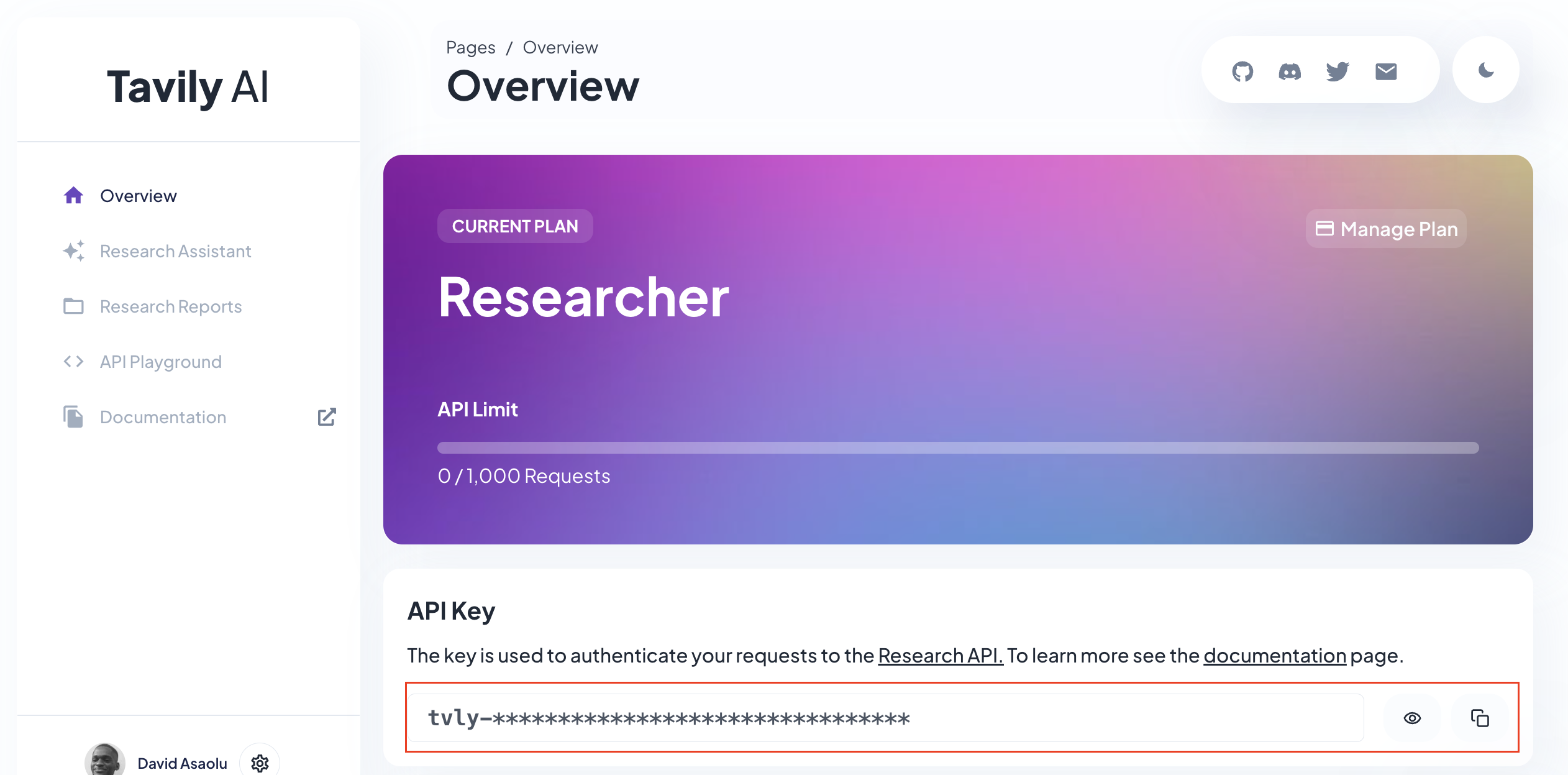 接下來,導覽至[OpenAI 開發者平台](https://platform.openai.com/api-keys),建立 API 金鑰,並將其複製到`.env.local`檔案中。 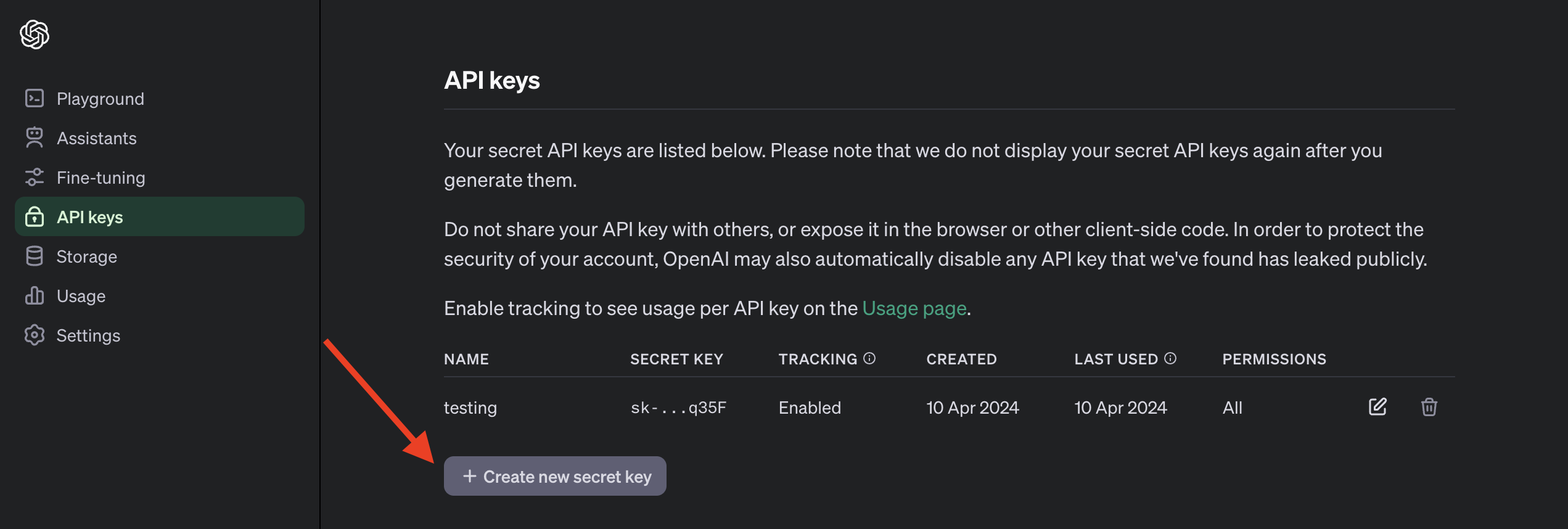 以下是`.env.local`檔案的預覽,其中包括 API 金鑰並指定要使用的 OpenAI 模型。請注意,存取 GPT-4 模型需要[訂閱 ChatGPT Plus](https://openai.com/chatgpt/pricing) 。 ``` TAVILY_API_KEY=<your_API_key> OPENAI_MODEL=gpt-4-1106-preview OPENAI_API_KEY=<your_API_key> ``` 回到我們的應用程式,您需要為 Copilot 建立 API 路由。因此,建立一個包含`route.ts`的`api/copilotkit`資料夾並新增一個`tavily.ts`檔案。 ``` cd app mkdir api && cd api mkdir copilotkit && cd copilotkit touch route.ts tavily.ts ``` 在`tavily.ts`檔案中建立一個函數,該函數接受使用者的查詢,使用 Tavily Search API 對查詢進行研究,並使用[OpenAI GPT-4 模型](https://openai.com/gpt-4)總結結果。 ``` import OpenAI from "openai"; export async function research(query: string) { //👇🏻 sends the request to the Tavily Search API const response = await fetch("https://api.tavily.com/search", { method: "POST", headers: { "Content-Type": "application/json", }, body: JSON.stringify({ api_key: process.env.TAVILY_API_KEY, query, search_depth: "basic", include_answer: true, include_images: false, include_raw_content: false, max_results: 20, }), }); //👇🏻 the response const responseJson = await response.json(); const openai = new OpenAI({ apiKey: process.env.OPENAI_API_KEY! }); //👇🏻 passes the response into the OpenAI GPT-4 model const completion = await openai.chat.completions.create({ messages: [ { role: "system", content: `Summarize the following JSON to answer the research query \`"${query}"\`: ${JSON.stringify( responseJson )} in plain English.`, }, ], model: process.env.OPENAI_MODEL, }); //👇🏻 returns the result return completion.choices[0].message.content; } ``` 最後,您可以透過將使用者的查詢傳遞到函數中並向 CopilotKit 提供其回應來執行`route.ts`檔案中的`research`函數。 ``` import { CopilotBackend, OpenAIAdapter } from "@copilotkit/backend"; import { Action } from "@copilotkit/shared"; import { research } from "./tavily"; //👇🏻 carries out a research on the user's query const researchAction: Action<any> = { name: "research", description: "Call this function to conduct research on a certain query.", parameters: [ { name: "query", type: "string", description: "The query for doing research. 5 characters or longer. Might be multiple words", }, ], handler: async ({ query }) => { console.log("Research query: ", query); const result = await research(query); console.log("Research result: ", result); return result; }, }; export async function POST(req: Request): Promise<Response> { const actions: Action<any>[] = []; if (process.env.TAVILY_API_KEY!) { actions.push(researchAction); } const copilotKit = new CopilotBackend({ actions: actions, }); const openaiModel = process.env.OPENAI_MODEL; return copilotKit.response(req, new OpenAIAdapter({ model: openaiModel })); } ``` 恭喜!您已完成本教學的專案。 結論 -- [CopilotKit](https://copilotkit.ai/)是一款令人難以置信的工具,可讓您在幾分鐘內將 AI Copilot 加入到您的產品中。無論您是對人工智慧聊天機器人和助理感興趣,還是對複雜任務的自動化感興趣,CopilotKit 都能讓您輕鬆實現。 如果您需要建立 AI 產品或將 AI 工具整合到您的軟體應用程式中,您應該考慮 CopilotKit。 您可以在 GitHub 上找到本教學的源程式碼: https://github.com/CopilotKit/spreadsheet-demo 感謝您的閱讀! --- 原文出處:https://dev.to/copilotkit/build-an-ai-powered-spreadsheet-app-nextjs-langchain-copilotkit-109d
在本文中,我們透過從頭開始建立幾個關鍵元件來探索 JavaScript 的基本建構塊。當我們深入研究這些概念時,我們將應用一系列從基礎到複雜的技術,使這種探索對於 JavaScript 世界的新手和專業人士都很有價值。 大綱 ---- - [`memoize()`](#memoize) - [`Array.map()`](#arraymap) - [`Array.filter()`](#arrayfilter) - [`Array.reduce()`](#arrayreduce) - [`bind()`](#bind) - [`call()` 、 `apply()`](#callapply) - [`setInterval()`](#setinterval) - [`cloneDeep()`](#clonedeep) - [`debounce()`](#debounce) - [`throttle()`](#throttle) - [`Promise`](#promise) - \[ `EventEmitter` ) <a name="memoize"></a> `memoize()` ----------- ### 任務說明 重新建立`memoize`函數(來自“lodash”),該函數透過快取函數呼叫的結果來優化效能。透過傳回快取的結果而不是重新計算,可以確保使用相同參數的重複函數呼叫更快。 ### 執行 ``` function customSerializer(entity, cache = new WeakSet()) { if (typeof entity !== 'object' || entity === null) { return `${typeof entity}:${entity}`; } if (cache.has(entity)) { return 'CircularReference'; } cache.add(entity); let objKeys = Object.keys(entity).sort(); let keyRepresentations = objKeys.map(key => `${customSerializer(key, cache)}:${ customSerializer(entity[key], cache) }` ); if (Array.isArray(entity)) { return `Array:[${keyRepresentations.join(',')}]`; } return `Object:{${keyRepresentations.join(',')}}`; } function myMemoize(fn) { const cache = new Map(); return function memoized(...args) { const keyRep = args.map(arg => customSerializer(arg) ).join('-'); const key = `${typeof this}:${this}-${keyRep}`; if (cache.has(key)) { return cache.get(key); } else { const result = fn.apply(this, args); cache.set(key, result); return result; } }; } ``` ### 實施的關鍵面 1. **快取機制:**它使用`Map`物件`cache`來儲存函數呼叫的結果。選擇`Map`物件是因為其高效率的鍵值配對和檢索功能。 2. **Custom Serializer** : `customSerializer`函數將函數參數轉換為用作快取鍵的字串表示形式。此序列化考慮了基本類型、物件(包括巢狀物件)、陣列和循環參考。對於物件和陣列,它們的鍵經過排序以確保一致的字串表示形式,無論屬性聲明順序如何。 3. **序列化`this`** : `this`的值指的是函數所屬的物件。在 JavaScript 中,方法可以根據呼叫它們的物件(即呼叫它們的上下文)而有不同的行為。這是因為`this`提供了對上下文物件的屬性和方法的存取,並且其值可能會根據函數的呼叫方式而變化。 4. **循環引用**:當物件直接或透過其屬性間接引用自身時,就會發生循環引用。這可能發生在更複雜的資料結構中,例如,物件`A`包含對物件`B`的引用,而物件`B`則直接或間接引用物件`A` 。處理循環引用以避免無限循環至關重要。 5. **使用`WeakSet`進行自動垃圾收集**: `WeakSet`保留對其物件的「弱」引用,這表示如果沒有其他引用, `WeakSet`中物件的存在不會阻止該物件被垃圾收集。此行為在需要臨時追蹤物件存在而又不會不必要地延長其生命週期的情況下特別有用。由於`customSerializer`函數可能只需要在序列化過程中標記物件的存取,而不儲存額外的資料,因此使用`WeakSet`可以確保物件不會僅僅因為它們在集合中的存在而保持活動狀態,從而防止潛在的內存洩漏。 <a name="arraymap"></a> `Array.map()` ------------- ### 任務說明 重新建立`Array.map()` ,它將轉換函數作為參數。此轉換函數將在陣列的每個元素上執行,並採用三個參數:當前元素、目前元素的索引和陣列本身。 ### 實施的關鍵面 1. **記憶體預先分配**: `new Array(this.length)`用於建立預先確定大小的陣列,以優化記憶體分配並透過避免加入元素時動態調整大小來提高效能。 ### 執行 ``` Array.prototype.myMap = function(fn) { const result = new Array(this.length); for (let i = 0; i < this.length; i++) { result[i] = fn(this[i], i, this); } return result; } ``` <a name="arrayfilter"></a> `Array.filter()` ---------------- ### 任務說明 重新建立`Array.filter()` ,它將謂詞函數作為輸入,迭代呼叫它的陣列的元素,將謂詞應用於每個元素。它傳回一個新陣列,僅包含謂詞函數傳回`true`元素。 ### 實施的關鍵面 1. **動態記憶體分配**:它動態地將符合條件的元素加入到`filteredArray`中,從而在很少有元素通過謂詞函數的情況下使該方法更有效地使用記憶體。 ### 執行 ``` Array.prototype.myFilter = function(pred) { const filteredArray = []; for (let i = 0; i < this.length; i++) { if (pred(this[i], i, this)) { filteredArray.push(this[i]); } } return filteredArray; } ``` <a name="arrayreduce"></a> `Array.reduce()` ---------------- ### 任務說明 重新建立`Array.reduce()` ,它對陣列的每個元素執行`reducer`函數,從而產生單一輸出值。 `reducer`函數有四個參數:累加器、currentValue、currentIndex 和整個陣列。 ### 實施的關鍵面 1. **`initialValue` value** : `accumulator`和`startIndex`會根據是否將`initialValue`作為參數傳遞來初始化。如果提供了`initialValue` (意味著`arguments.length`至少為`2` ),則`accumulator`設定為此`initialValue` ,並且迭代從第0個元素開始。否則,如果未提供`initialValue` ,則將陣列本身的第 0 個元素用作`initialValue` 。 ### 執行 ``` Array.prototype.myReduce = function(callback, initialValue) { let accumulator = arguments.length >= 2 ? initialValue : this[0]; let startIndex = arguments.length >= 2 ? 0 : 1; for (let i = startIndex; i < this.length; i++) { accumulator = callback(accumulator, this[i], i, this); } return accumulator; } ``` <a name="bind"></a> `bind()` -------- ### 任務說明 重新建立`bind()`函數,該函數允許將物件以及預先指定的初始參數(如果有)作為呼叫原始函數的上下文傳遞。它還應該支援`new`運算符的使用,從而能夠建立新實例,同時維護正確的原型鏈。 ### 執行 ``` Function.prototype.mybind = function(context, ...bindArgs) { const self = this; const boundFunction = function(...callArgs) { const isNewOperatorUsed = new.target !== undefined; const thisContext = isNewOperatorUsed ? this : context; return self.apply(thisContext, bindArgs.concat(callArgs)); }; if (self.prototype) { boundFunction.prototype = Object.create(self.prototype); } return boundFunction; }; ``` ### 實施的關鍵面 1. **處理`new` Operator** :語句`const isNewOperatorUsed = new.target !== undefined;`檢查是否透過`new`運算子將`boundFunction`作為建構函數呼叫。如果使用`new`運算符,則`thisContext`將設定為新建立的物件 ( `this` ) 而不是提供的`context` ,確認實例化應使用新的上下文而不是綁定期間提供的上下文。 2. **原型保留**:為了維護原始函數的原型鏈, `mybind`有條件地將`boundFunction`的原型設定為繼承自`self.prototype`的新物件。此步驟確保從`boundFunction` (用作建構函數時)建立的實例正確地繼承原始函數原型的屬性。此機制保留了預期的繼承層次結構並維護instanceof 檢查。 ### 將`bind()`與`new`一起使用的範例 讓我們考慮一個簡單的建構函數,它建立代表汽車的物件: ``` function Car(make, model, year) { this.make = make; this.model = model; this.year = year; } ``` 想像一下,我們常常創造「豐田」品牌的`Car`物件。為了讓這個過程更有效率,我們可以使用`bind`為Toyotas建立一個專門的建構函數,預先填入`make`參數: ``` // Creating a specialized Toyota constructor with 'Toyota' // as the pre-set 'make' const ToyotaConstructor = Car.bind(null, 'Toyota'); // Now, we can create Toyota car instances // without specifying 'make' const myCar = new ToyotaConstructor('Camry', 2020); // Output: Car { make: 'Toyota', model: 'Camry', year: 2020 } console.log(myCar); ``` <a name="callapply"></a> `call()` 、 `apply()` -------------------- ### 任務說明 重新建立`call()`和`apply()`函數,它們允許使用給定的 this 值和單獨提供的參數來呼叫函數。 ### 執行 ``` Function.prototype.myCall = function(context, ...args) { const fnSymbol = Symbol('fnSymbol'); context[fnSymbol] = this; const result = context[fnSymbol](...args); delete context[fnSymbol]; return result; }; Function.prototype.myApply = function(context, args) { const fnSymbol = Symbol('fnSymbol'); context[fnSymbol] = this; const result = context[fnSymbol](...args); delete context[fnSymbol]; return result; }; ``` ### 實施的關鍵面 1. **屬性命名的符號用法**:為了防止覆蓋上下文物件上潛在的現有屬性或由於名稱衝突而導致意外行為,使用唯一的`Symbol`作為屬性名稱。這確保了我們的臨時屬性不會幹擾上下文物件的原始屬性。 2. **執行後清理**:函數呼叫執行後,新增到上下文物件中的臨時屬性將被刪除。此清理步驟對於避免在上下文物件上留下修改後的狀態至關重要。 <a name="setinterval"></a> `setInterval()` --------------- ### 任務說明 使用`setTimeout`重新建立`setInterval` 。此函數應以指定的時間間隔重複呼叫提供的回呼函數。它會傳回一個函數,當呼叫該函數時,該函數會停止間隔。 ### 執行 ``` function mySetInterval(callback, interval) { let timerId; const repeater = () => { callback(); timerId = setTimeout(repeater, interval); }; repeater(); return () => { clearTimeout(timerId); }; } ``` ### 實施的關鍵面 1. **取消功能**: `mySetInterval`傳回的函數提供了一種簡單直接的方法來取消正在進行的間隔,而無需在函數範圍之外公開或管理計時器 ID。 <a name="clonedeep"></a> `cloneDeep()` ------------- ### 任務說明 重新建立執行給定輸入的深度複製的`cloneDeep`函數(來自“lodash”)。該函數應該能夠複製複雜的資料結構,包括物件、陣列、映射、集合、日期和正規表示式,並保持每個元素的結構和類型完整性。 ### 執行 ``` function myCloneDeep(entity, map = new WeakMap()) { if (entity === null || typeof entity !== 'object') { return entity; } if (map.has(entity)) { return map.get(entity); } let cloned; switch (true) { case Array.isArray(entity): cloned = []; map.set(entity, cloned); cloned = entity.map(item => myCloneDeep(item, map)); break; case entity instanceof Date: cloned = new Date(entity.getTime()); break; case entity instanceof Map: cloned = new Map(Array.from(entity.entries(), ([key, val]) => [myCloneDeep(key, map), myCloneDeep(val, map)])); break; case entity instanceof Set: cloned = new Set(Array.from(entity.values(), val => myCloneDeep(val, map))); break; case entity instanceof RegExp: cloned = new RegExp(entity.source, entity.flags); break; default: cloned = Object.create( Object.getPrototypeOf(entity)); map.set(entity, cloned); for (let key in entity) { if (entity.hasOwnProperty(key)) { cloned[key] = myCloneDeep(entity[key], map); } } } return cloned; } ``` ### 實施的關鍵面 1. **循環引用處理**:利用`WeakMap`來追蹤已存取的物件。如果遇到已經克隆的物件,則返回先前克隆的物件,有效處理循環參考並防止堆疊溢位錯誤。 2. **特殊物件的處理**:區分幾種物件類型( `Array` 、 `Date` 、 `Map` 、 `Sets` 、 `RegExp` ),以確保每種類型都被適當地克隆,並保留其特定特徵。 ``` - **`Array`**: Recursively clones each element, ensuring deep cloning. ``` ``` - **`Date`**: Copies the date using its numeric value (timestamp). ``` ``` - **Maps and Sets**: Constructs a new instance, recursively cloning each entry (for `Map`) or value (for `Set`). ``` ``` - **`RegExp`**: Clones by creating a new instance with the source and flags of the original. ``` 3. **物件屬性的複製**:當輸入是普通物件時,它會建立一個與原始物件具有相同原型的物件,然後遞歸地複製每個自己的屬性,在保持原型鏈的同時確保深度克隆。 4. **效率和性能**:利用`WeakMap`進行記憶,有效處理具有重複引用和循環的複雜大型結構,透過避免冗餘克隆來確保最佳性能。 <a name="debounce"></a> `debounce()` ------------ ### 任務說明 重新建立`debounce`函數(來自“lodash”),它允許限制給定回調函數觸發的頻率。當在短時間內重複呼叫時,在指定的延遲後僅執行最後一次呼叫。 ``` function myDebounce(func, delay) { let timerId; const debounced = function(...args) { clearTimeout(timerId); timerId = setTimeout(() => { func.apply(this, args); }, delay); }; debounced.cancel = function() { clearTimeout(timerId); timerId = null; }; debounced.flush = function() { clearTimeout(timerId); func.apply(this, arguments); timerId = null; }; return debounced; } ``` ### 實施的關鍵面 1. **取消功能**:引入`.cancel`方法使外部控制能夠取消去抖函數的任何暫停執行。這增加了靈活性,允許響應特定事件或條件而取消去抖功能。 2. **透過 Flush 立即執行**: `.flush`方法允許立即執行去抖函數,而不考慮延遲。這在需要確保立即應用去抖函數的效果的情況下非常有用,例如,在卸載元件或完成互動之前。 <a name="throttle"></a> `throttle()` ------------ ### 任務說明 重新建立`throttle`函數(來自“lodash”),它確保給定的回調函數在每個指定的時間間隔內最多只呼叫一次(在我們的例子中是在開始時)。與去抖動不同,限制保證函數會定期執行,確保進行更新,儘管更新速度是受控的。 ### 執行 ``` function myThrottle(func, timeout) { let timerId = null; const throttled = function(...args) { if (timerId === null) { func.apply(this, args) timerId = setTimeout(() => { timerId = null; }, timeout) } } throttled.cancel = function() { clearTimeout(timerId); timerId = null; }; return throttled; } ``` ### 實施的關鍵面 1. **取消功能**:引入`.cancel`方法可以清除節流計時器的任何計劃重置。這在清理階段非常有用,例如 UI 庫/框架中的元件卸載,以防止過時的執行並有效管理資源。 <a name="promise"></a> `Promise` --------- ### 任務說明 重新建立`Promise`類別。它是為非同步程式設計的構造,允許暫停程式碼的執行,直到非同步進程完成。從本質上講,承諾代表了在其建立時不一定已知的值的代理。它允許您將處理程序與非同步操作的最終成功值或失敗原因相關聯。這使得非同步方法可以像同步方法一樣傳回值:非同步方法不是立即傳回最終值,而是傳回一個在未來某個時刻提供該值的承諾。 `Promise`包含處理已完成和拒絕狀態的方法( `then` 、 `catch` ),以及無論結果如何都執行程式碼的方法( `finally` )。 ``` class MyPromise { constructor(executor) { ... } then(onFulfilled, onRejected) { ... } catch(onRejected) { ... } finally(callback) { ... } } ``` ### `constructor`實現 ``` constructor(executor) { this.state = 'pending'; this.value = undefined; this.reason = undefined; this.onFulfilledCallbacks = []; this.onRejectedCallbacks = []; const resolve = (value) => { if (this.state === 'pending') { this.state = 'fulfilled'; this.value = value; this.onFulfilledCallbacks.forEach(fn => fn()); } }; const reject = (reason) => { if (this.state === 'pending') { this.state = 'rejected'; this.reason = reason; this.onRejectedCallbacks.forEach(fn => fn()); } }; try { executor(resolve, reject); } catch (error) { reject(error); } } ``` ### `constructor`實現的關鍵方面 1. **狀態管理**:以「待處理」狀態初始化。解決時切換為“已完成”,被拒絕時切換為“拒絕”。 2. **值和原因**:保存承諾的最終結果( `value` )或拒絕的原因( `reason` )。 - **處理非同步**:接受包含非同步操作的`executor`函數。 `executor`採用兩個函數, `resolve`和`reject` ,當呼叫它們時,將promise轉換到對應的狀態。 3. **回呼陣列**:維護回呼佇列( `onFulfilledCallbacks` 、 `onRejectedCallbacks` ),以用於等待解決或拒絕承諾的延遲操作。 ### `.then`實施 ``` resolvePromise(promise2, x, resolve, reject) { if (promise2 === x) { return reject(new TypeError( 'Chaining cycle detected for promise')); } if (x instanceof MyPromise) { x.then(resolve, reject); } else { resolve(x); } } then(onFulfilled, onRejected) { onFulfilled = typeof onFulfilled === 'function' ? onFulfilled : value => value; onRejected = typeof onRejected === 'function' ? onRejected : reason => { throw reason; }; let promise2 = new MyPromise((resolve, reject) => { if (this.state === 'fulfilled') { setTimeout(() => { try { let x = onFulfilled(this.value); this.resolvePromise(promise2, x, resolve, reject); } catch (error) { reject(error); } }); } else if (this.state === 'rejected') { setTimeout(() => { try { let x = onRejected(this.reason); this.resolvePromise(promise2, x, resolve, reject); } catch (error) { reject(error); } }); } else if (this.state === 'pending') { this.onFulfilledCallbacks.push(() => { setTimeout(() => { try { let x = onFulfilled(this.value); this.resolvePromise(promise2, x, resolve, reject); } catch (error) { reject(error); } }); }); this.onRejectedCallbacks.push(() => { setTimeout(() => { try { let x = onRejected(this.reason); this.resolvePromise(promise2, x, resolve, reject); } catch (error) { reject(error); } }); }); } }); return promise2; } ``` ### `.then`實施的關鍵方面 1. **預設處理程序**:將非函數處理程序轉換為標識函數(用於實現)或拋出程序(用於拒絕),以確保承諾鏈中的正確轉發和錯誤處理。 2. **Promise 連結**: `then`方法允許連結 Promise,從而實現順序非同步操作。它會建立一個新的 Promise ( `promise2` ),該 Promise 取決於傳遞給它的回呼函數 ( `onFulfilled` 、 `onRejected` ) 的結果。 3. **處理解決方案和拒絕**:僅在當前承諾解決(履行或拒絕)後才會呼叫所提供的回調。每個回呼的結果 ( `x` ) 可能是一個值或另一個 Promise,決定了`promise2`的解析。 4. **防止連結循環**: `resolvePromise`函數檢查`promise2`是否與結果 ( `x` ) 相同,避免 Promise 等待自身的循環,從而導致`TypeError` 。 5. **支援 MyPromise 和 Non-Promise 值**:如果結果 ( `x` ) 是`MyPromise`的實例, `then`使用其解析或拒絕來解決`promise2` 。此功能支援基於 Promise 的操作的無縫集成,無論是來自`MyPromise`實例還是本機 JavaScript Promise,假設它們具有相似的行為。對於非 Promise 值,或當`onFulfilled`或`onRejected`只是傳回一個值時, `promise2`將使用該值進行解析,從而在 Promise 鏈中實現簡單的轉換或分支邏輯。 6. **非同步執行保證**:透過使用`setTimeout`延遲`onFulfilled`和`onRejected`的執行, `then`確保非同步為。此延遲保持一致的執行順序,確保`onFulfilled`和`onRejected`在執行堆疊清除後呼叫。 7. **錯誤處理**:如果`onFulfilled`或`onRejected`內發生異常, `promise2`會因錯誤而被拒絕,從而允許錯誤處理通過 Promise 鏈傳播。 ### `catch`並`finally`實現 ``` static resolve(value) { if (value instanceof MyPromise) { return value; } return new MyPromise((resolve, reject) => resolve(value)); } catch(onRejected) { return this.then(null, onRejected); } finally(callback) { return this.then( value => MyPromise.resolve(callback()) .then(() => value), reason => MyPromise.resolve(callback()) .then(() => { throw reason; }) ); } ``` ### `.catch`實施的關鍵面向: 1. **簡化的錯誤處理:** `.catch`方法是`.then(null, onRejected)`的簡寫,專門專注於處理拒絕場景。當只需要拒絕處理程序時,它允許更清晰的語法,從而提高程式碼的可讀性和可維護性。 2. **Promise Chaining 支援:**由於它在內部委託給`.then` ,所以`.catch`返回一個新的 Promise,從而保持 Promise 鏈功能。這允許在錯誤恢復或透過重新拋出或返回新的被拒絕的承諾傳播錯誤後繼續進行鏈操作。 3. **錯誤傳播:**如果提供了`onRejected`並且執行時沒有錯誤,則傳回的 Promise 將使用`onRejected`的傳回值進行解析,從而有效地允許 Promise 鏈中的錯誤復原。如果`onRejected`拋出錯誤或傳回被拒絕的 Promise,則錯誤會沿著鏈傳播。 ### `.finally`實現的關鍵面向: 1. **始終執行:** `.finally`方法確保執行提供的`callback` ,無論 Promise 是履行還是拒絕。這對於需要在非同步操作之後發生的清理操作特別有用,與其結果無關。 2. **傳回值保留:**雖然`.finally`中的`callback`不接收任何參數(與`.then`或`.catch`不同),但 Promise 的原始履行值或拒絕原因將被保留並透過鏈傳遞。從`.finally`傳回的 Promise 會以相同的值或原因被解析或拒絕,除非`callback`本身導致被拒絕的 Promise。 3. **錯誤處理與傳播:**如果`callback`執行成功, `.finally`傳回的 Promise 將按照與原始 Promise 相同的方式進行結算。但是,如果`callback`拋出錯誤或返回被拒絕的 Promise,則從`.finally`返回的 Promise 會因這個新錯誤而被拒絕,從而允許錯誤攔截並更改 Promise 鏈中的拒絕原因。 <a name="eventemitter"></a> `EventEmitter` -------------- ### 任務說明 重新建立`EventEmitter`類,該類別允許實現觀察者模式,使物件(稱為「發射器」)能夠發出命名事件,從而導致呼叫先前註冊的偵聽器(或「處理程序」)。這是 Node.js 中用於處理非同步事件的關鍵元件,廣泛用於發出訊號以及管理應用程式狀態和行為。實作自訂`EventEmitter`涉及建立用於註冊事件偵聽器、觸發事件和刪除偵聽器的方法。 ``` class MyEventEmitter { constructor() { this.events = {}; } on(eventName, listener) { if (!this.events[eventName]) { this.events[eventName] = []; } this.events[eventName].push(listener); } once(eventName, listener) { const onceWrapper = (...args) => { listener.apply(this, args); this.off(eventName, onceWrapper); }; this.on(eventName, onceWrapper); } emit(eventName, ...args) { const listeners = this.events[eventName]; if (listeners && listeners.length) { listeners.forEach((listener) => { listener.apply(this, args); }); } } off(eventName, listenerToRemove) { if (!this.events[eventName]) { return; } const filterListeners = (listener) => listener !== listenerToRemove; this.events[eventName] = this.events[eventName].filter(filterListeners); } } ``` ### `EventEmitter`實現的關鍵面 1. **EventListener Registration `.on` :**將偵聽器函數新增至指定事件的偵聽器陣列中,如果該事件名稱尚不存在則建立一個新陣列。 2. **一次性事件偵聽器`.once` :**註冊一個偵聽器,該偵聽器在呼叫一次後會自行刪除。它將原始偵聽器包裝在一個函數 ( `onceWrapper` ) 中,該函數也會在執行後刪除包裝器,確保偵聽器僅觸發一次。 3. **發出事件`.emit` :**觸發事件,使用提供的參數呼叫所有已註冊的偵聽器。它將參數應用於每個偵聽器函數,從而允許將資料傳遞給偵聽器。 4. **刪除事件偵聽器`.off` :**從事件偵聽器陣列中刪除特定偵聽器。如果事件在刪除後沒有偵聽器,則可以將其保留為空陣列或可選地進一步清理(此實作中未顯示)。 --- 原文出處:https://dev.to/antonzo/implementing-javascript-concepts-from-scratch-4623
JavaScript 生態系統正以驚人的速度發展。當您熟悉某種技術時,就會出現大量新方法。其中一些(例如 TypeScript)獲得了廣泛採用,而另一些(例如 CoffeeScript)則悄悄消失。每項創新最初都會引起人們的興奮,但隨著時間的推移,社區經常分裂,批評者最終會產生自己的框架。這種無止盡的循環讓我對聲稱可以解決所有問題的最新「神奇」框架越來越警惕。我已經從尋求工具作為解決方案轉變為擁抱對模式的理解,而不是不斷追求新技術。 這就是為什麼我向您指出針對 TypeScript 專案的特殊工具,不僅僅是另一個工具,而是鼓勵良好實踐的範例: [Effect](https://effect.website/) 。 讓我們來看看為什麼你應該踏出這一步。 彩色函數 ---- 您是否曾經問過自己,[您的功能是什麼顏色?](https://journal.stuffwithstuff.com/2015/02/01/what-color-is-your-function/) 讓我為您總結一下。想像一下您的程式碼庫中有藍色和紅色函數。規則很簡單:您可以在藍色函數中使用紅色函數,但反之則不行。那不是一場惡夢嗎?現在用“async”替換藍色。是的,你在 Javascript 得到了函數著色。 那我們該如何對抗這種著色問題呢?如果我們想刪除彩色函數,我們需要建立某種包裝器,僅在需要時使用 Promise。例如「未來」還是…「效果」? ``` import { Effect, pipe } from "effect"; const fibonacci = (a: number): Effect.Effect<number> => a <= 1 ? Effect.succeed(a) : pipe( Effect.all([fibonacci(a - 1), fibonacci(a - 2)]), Effect.map(([a, b]) => a + b) ); await Effect.runPromise(fibonacci(10)); ``` 使用`Effect`與`Promise`主要差異在於如何處理並發。 Effect 提供了 Fiber,它是類似於綠色線程或 goroutine 的輕量級並發結構。此功能允許我們在不阻塞主執行緒的情況下執行長時間執行或非同步任務,即使在傳統的同步函數中也可以啟動主執行緒。 ``` import { Effect, Console, pipe } from "effect"; const longRunningTask = pipe( Console.log("Start of long running task"), Effect.delay(1000), Effect.tap(Console.log("End of long running task")) ); console.log("Start of program"); Effect.runFork(longRunningTask); console.log("End of program"); /** * OUTPUT: * Start of program * End of program * Start of long running task * End of long running task */ ``` 雖然Effect 並沒有消除JavaScript 中固有的非同步/同步差異(函數著色),但透過使用纖程處理非同步操作,它允許同步函數呼叫非同步效果,而不會使其本身成為非同步,從而在很大程度上緩解“著色”問題。 類型安全錯誤 ------ 我們來看看這個函數: ``` const divide = (a: number, b: number) => a / b; ``` 我們這裡剛剛引入了一個問題,我們不能除以零。那麼讓我們稍微重構一下程式碼: ``` const divide = (a: number, b: number) => { if (b === 0) throw new Error('Cannot divide by zero.'); return a / b; } ``` 你覺得不錯嗎?它不是。因為它不是類型安全的。想要使用您的函數的人不會知道您的函數可能會拋出異常。對於像這樣的簡單函數來說,這可能看起來微不足道,但是當您有數十個潛在錯誤時,它可能會變成一場噩夢。其他較成熟的語言有諸如`Either`或`Result`之類的概念來表示類型安全錯誤。看起來像這樣: ``` type Result<T, E> = Ok<T> | Err<E>; // With something like: type Ok<T> = { kind: "Ok", data: T }; type Err<E> = { kind: "Err", err: E }; ``` 使用 Effect,您將擁有開箱即用的功能: `Effect<T, E>` 。您不必問自己在執行過程中會發生什麼樣的錯誤,您可以直接從函數簽名中知道它。它還附帶幫助函數來從錯誤中恢復。 ``` const divide = (a: number, b: number): Effect<number, "DivisionByZeroError"> => { if (b === 0) return Effect.fail("DivisionByZeroError"); return Effect.succeed(a / b); } ``` 新類型或品牌類型 -------- 你知道,回顧我以前的職能,我意識到我們可以做得更好。 ``` const divide = (a: number, b: NonZeroNumber) => ... ``` 那麼如何定義`NonZeroNumber`呢?如果您只是`type NonZeroNumber = number`它不會阻止人們用「0」來呼叫它。有一個模式:新類型。是的,Effect 也支持這一點: ``` import { Brand } from "effect" type NonZeroNumber = number & Brand.Brand<"NonZeroNumber"> const NonZeroNumber = Brand.refined<NonZeroNumber>( (n) => n !== 0, // Check if the value is a non-zero number (n) => Brand.error(`Expected ${n} to be a non-zero number`) ) ``` 這樣,您就知道您的函數**不能**使用任何數字來呼叫:它需要一種不包括零的特殊類型的數字。 依賴注入 ---- 如果您想遵循「控制反轉」原則,您可能需要研究「依賴注入」。這個概念非常簡單:函數應該能夠從自己的上下文中存取它所需要的內容。 ``` // With a singleton const read = (filename) => FileReader.read(filename); // With dependency injection const read = (reader: FileReader) => (filename) => reader.read(filename); ``` 出於多種原因,最好這樣做,例如解耦事物、允許輕鬆測試、具有不同的上下文等。 雖然有幾個框架可以幫助實現這一點,但 Effect 確實透過簡化來粉碎它:將依賴項作為 Effect 的第三個參數。 ``` const read = (filename): Effect<File, Error, FileReader> => { return Effect.flatMap(FileReader, fileReader => { return fileReader.read(filename); }) } ``` 結論 -- 您應該考慮 Effect 的原因還有很多。當然,一開始並不容易,您必須學習以不同的方式編碼。但與許多讓你學習「他們的」做事方式的框架相反,Effect 實際上教你好的模式,這些模式已經在其他語言中得到了證明。實際上,Effect 很大程度上受到了 Scala 中的 ZIO 的啟發,而 Scala 本身也受到了 Haskell 的啟發,而 Haskell 至今仍被認為是良好程式模式的頂峰之一。 --- 原文出處:https://dev.to/almaju/someone-finally-fixed-javascript-426i
長話短說 ==== 我收集了您應該了解的 React 庫,以建立許多不同類型的專案並成為 React 奇才🧙♂️。 其中每一項都是獨一無二的,並且都有自己的用例。 別忘了給他們加星號🌟 讓我們開始吧!  --- 1. [CopilotKit](https://github.com/CopilotKit/CopilotKit) - 建立應用內人工智慧聊天機器人、代理程式和文字區域 ------------------------------------------------------------------------------------  將 AI 功能整合到 React 中是很困難的,這就是 Copilot 的用武之地。一個簡單快速的解決方案,可將可投入生產的 Copilot 整合到任何產品中! 您可以使用兩個 React 元件將關鍵 AI 功能整合到 React 應用程式中。它們還提供內建(完全可自訂)Copilot 原生 UX 元件,例如`<CopilotKit />` 、 `<CopilotPopup />` 、 `<CopilotSidebar />` 、 `<CopilotTextarea />` 。 開始使用以下 npm 指令。 ``` npm i @copilotkit/react-core @copilotkit/react-ui ``` Copilot Portal 是 CopilotKit 提供的元件之一,CopilotKit 是一個應用程式內人工智慧聊天機器人,可查看目前應用狀態並在應用程式內採取操作。它透過插件與應用程式前端和後端以及第三方服務進行通訊。 這就是整合聊天機器人的方法。 `CopilotKit`必須包裝與 CopilotKit 互動的所有元件。建議您也開始使用`CopilotSidebar` (您可以稍後切換到不同的 UI 提供者)。 ``` "use client"; import { CopilotKit } from "@copilotkit/react-core"; import { CopilotSidebar } from "@copilotkit/react-ui"; import "@copilotkit/react-ui/styles.css"; export default function RootLayout({children}) { return ( <CopilotKit url="/path_to_copilotkit_endpoint/see_below"> <CopilotSidebar> {children} </CopilotSidebar> </CopilotKit> ); } ``` 您可以使用此[快速入門指南](https://docs.copilotkit.ai/getting-started/quickstart-backend)設定 Copilot 後端端點。 之後,您可以讓 Copilot 採取行動。您可以閱讀如何提供[外部上下文](https://docs.copilotkit.ai/getting-started/quickstart-chatbot#provide-context)。您可以使用`useMakeCopilotReadable`和`useMakeCopilotDocumentReadable`反應掛鉤來執行此操作。 ``` "use client"; import { useMakeCopilotActionable } from '@copilotkit/react-core'; // Let the copilot take action on behalf of the user. useMakeCopilotActionable( { name: "setEmployeesAsSelected", // no spaces allowed in the function name description: "Set the given employees as 'selected'", argumentAnnotations: [ { name: "employeeIds", type: "array", items: { type: "string" } description: "The IDs of employees to set as selected", required: true } ], implementation: async (employeeIds) => setEmployeesAsSelected(employeeIds), }, [] ); ``` 您可以閱讀[文件](https://docs.copilotkit.ai/getting-started/quickstart-textarea)並查看[演示影片](https://github.com/CopilotKit/CopilotKit?tab=readme-ov-file#demo)。 您可以輕鬆整合 Vercel AI SDK、OpenAI API、Langchain 和其他 LLM 供應商。您可以按照本[指南](https://docs.copilotkit.ai/getting-started/quickstart-chatbot)將聊天機器人整合到您的應用程式中。 基本概念是在幾分鐘內建立可用於基於 LLM 的應用程式的 AI 聊天機器人。 用例是巨大的,作為開發人員,我們絕對應該在下一個專案中嘗試使用 CopilotKit。 https://github.com/CopilotKit/CopilotKit Star CopilotKit ⭐️ --- 2. [xyflow](https://github.com/xyflow/xyflow) - 使用 React 建立基於節點的 UI。 --------------------------------------------------------------------  XYFlow 是一個功能強大的開源程式庫,用於使用 React 或 Svelte 建立基於節點的 UI。它是一個 monorepo,提供[React Flow](https://reactflow.dev)和[Svelte Flow](https://svelteflow.dev) 。讓我們更多地了解可以使用 React flow 做什麼。  您可以觀看此影片,在 60 秒內了解 React Flow。 https://www.youtube.com/watch?v=aUBWE41a900 有些功能在專業模式下可用,但免費層中的功能足以形成一個非常互動的流程。 React 流程以 TypeScript 編寫並使用 Cypress 進行測試。 開始使用以下 npm 指令。 ``` npm install reactflow ``` 以下介紹如何建立兩個節點( `Hello`和`World` ,並透過邊連接。節點具有預先定義的初始位置以防止重疊,並且我們還應用樣式來確保有足夠的空間來渲染圖形。 ``` import ReactFlow, { Controls, Background } from 'reactflow'; import 'reactflow/dist/style.css'; const edges = [{ id: '1-2', source: '1', target: '2' }]; const nodes = [ { id: '1', data: { label: 'Hello' }, position: { x: 0, y: 0 }, type: 'input', }, { id: '2', data: { label: 'World' }, position: { x: 100, y: 100 }, }, ]; function Flow() { return ( <div style={{ height: '100%' }}> <ReactFlow nodes={nodes} edges={edges}> <Background /> <Controls /> </ReactFlow> </div> ); } export default Flow; ``` 這就是它的樣子。您還可以新增標籤、更改類型並使其具有互動性。 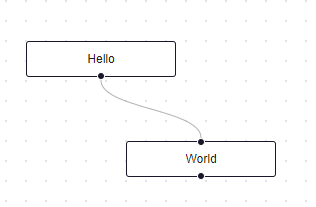 您可以在 React Flow 的 API 參考中查看[完整的選項清單](https://reactflow.dev/api-reference/react-flow)以及元件、鉤子和實用程式。 最好的部分是您還可以加入[自訂節點](https://reactflow.dev/learn/customization/custom-nodes)。在您的自訂節點中,您可以渲染您想要的一切。您可以定義多個來源和目標句柄並呈現表單輸入或圖表。您可以查看此[codesandbox](https://codesandbox.io/p/sandbox/pensive-field-z4kv3w?file=%2FApp.js&utm_medium=sandpack)作為範例。 您可以閱讀[文件](https://reactflow.dev/learn)並查看 Create React App、Next.js 和 Remix 的[範例 React Flow 應用程式](https://github.com/xyflow/react-flow-example-apps)。 React Flow 附帶了幾個額外的[插件](https://reactflow.dev/learn/concepts/plugin-components)元件,可以幫助您使用 Background、Minimap、Controls、Panel、NodeToolbar 和 NodeResizer 元件製作更高級的應用程式。 例如,您可能已經注意到許多網站的背景中有圓點,增強了美觀性。要實現此模式,您可以簡單地使用 React Flow 中的後台元件。 ``` import { Background } from 'reactflow'; <Background color="#ccc" variant={'dots'} /> // this will be under React Flow component. Just an example. ```  如果您正在尋找一篇快速文章,我建議您查看 Webkid 的[React Flow - A Library for Rendering Interactive Graphs](https://webkid.io/blog/react-flow-node-based-graph-library/) 。 React Flow 由 Webkid 開發和維護。 它在 GitHub 上有超過 19k 顆星,並且在`v11.10.4`上顯示它們正在不斷改進,npm 套件每週下載量超過 40 萬次。您可以輕鬆使用的最佳專案之一。  https://github.com/xyflow/xyflow 星 xyflow ⭐️ --- 3. [Zod](https://github.com/colinhacks/zod) + [React Hook Form](https://github.com/react-hook-form) - 致命的驗證組合。 -------------------------------------------------------------------------------------------------------------- 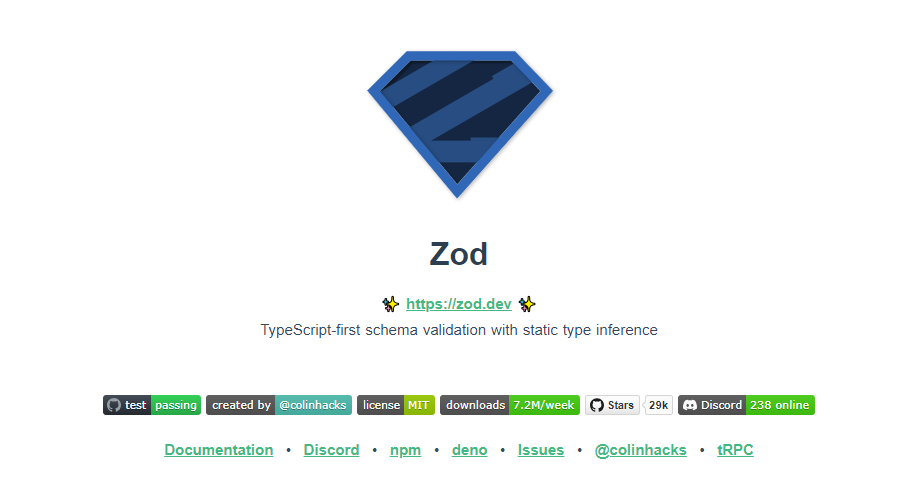 第一個問題是:為什麼我在同一個選項中包含 Zod 和 React Hook 表單?好吧,請閱讀它來找出答案。 Zod 的目標是透過最大限度地減少重複的類型聲明來對開發人員友好。使用 Zod,您聲明一次驗證器,Zod 將自動推斷靜態 TypeScript 類型。將更簡單的類型組合成複雜的資料結構很容易。 開始使用以下 npm 指令。 ``` npm install zod ``` 這是您在建立字串架構時自訂一些常見錯誤訊息的方法。 ``` const name = z.string({ required_error: "Name is required", invalid_type_error: "Name must be a string", }); ``` ``` // It does provide lots of options // validations z.string().min(5, { message: "Must be 5 or more characters long" }); z.string().max(5, { message: "Must be 5 or fewer characters long" }); z.string().length(5, { message: "Must be exactly 5 characters long" }); z.string().email({ message: "Invalid email address" }); z.string().url({ message: "Invalid url" }); z.string().emoji({ message: "Contains non-emoji characters" }); z.string().uuid({ message: "Invalid UUID" }); z.string().includes("tuna", { message: "Must include tuna" }); z.string().startsWith("https://", { message: "Must provide secure URL" }); z.string().endsWith(".com", { message: "Only .com domains allowed" }); z.string().datetime({ message: "Invalid datetime string! Must be UTC." }); z.string().ip({ message: "Invalid IP address" }); ``` 請閱讀[文件](https://zod.dev/)以了解有關 Zod 的更多資訊。 它適用於 Node.js 和所有現代瀏覽器。 現在,第二部分來了。 有很多可用的表單整合。 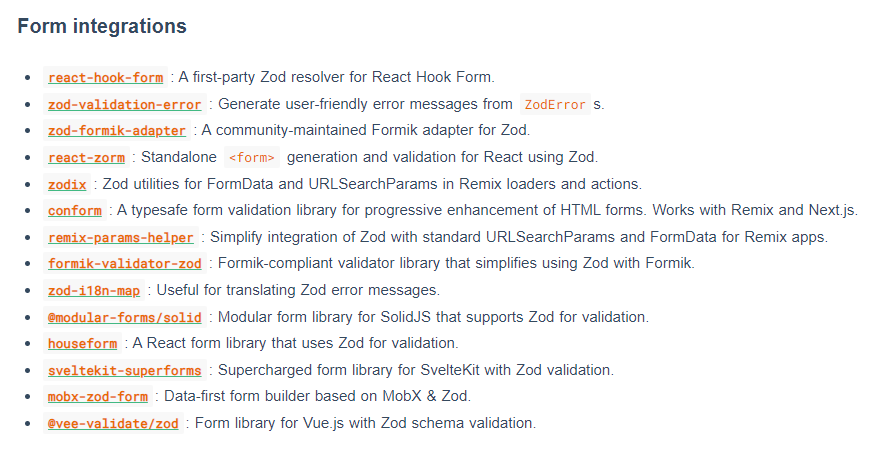 雖然 Zod 可以驗證物件,但如果沒有自訂邏輯,它不會影響您的用戶端和後端。 React-hook-form 是用於客戶端驗證的優秀專案。例如,它可以顯示輸入錯誤。  開始使用以下 npm 指令。 ``` npm install react-hook-form ``` 這就是如何使用`React Hook Form` 。 ``` import { useForm, SubmitHandler } from "react-hook-form" type Inputs = { example: string exampleRequired: string } export default function App() { const { register, handleSubmit, watch, formState: { errors }, } = useForm<Inputs>() const onSubmit: SubmitHandler<Inputs> = (data) => console.log(data) console.log(watch("example")) // watch input value by passing the name of it return ( /* "handleSubmit" will validate your inputs before invoking "onSubmit" */ <form onSubmit={handleSubmit(onSubmit)}> {/* register your input into the hook by invoking the "register" function */} <input defaultValue="test" {...register("example")} /> {/* include validation with required or other standard HTML validation rules */} <input {...register("exampleRequired", { required: true })} /> {/* errors will return when field validation fails */} {errors.exampleRequired && <span>This field is required</span>} <input type="submit" /> </form> ) } ``` 您甚至可以隔離重新渲染,從而提高整體效能。 您可以閱讀[文件](https://react-hook-form.com/get-started)。 兩者結合起來就是一個很好的組合。嘗試一下! 我透過 Shadcn 發現了它,它使用它作為表單元件的預設值。我自己在幾個專案中使用過它,效果非常好。它提供了很大的靈活性,這確實很有幫助。 https://github.com/colinhacks/zod Star Zod ⭐️ https://github.com/react-hook-form Star React Hook Form ⭐️ --- 4. [React DND](https://github.com/react-dnd/react-dnd) - 用於 React 的拖放。 ---------------------------------------------------------------------- 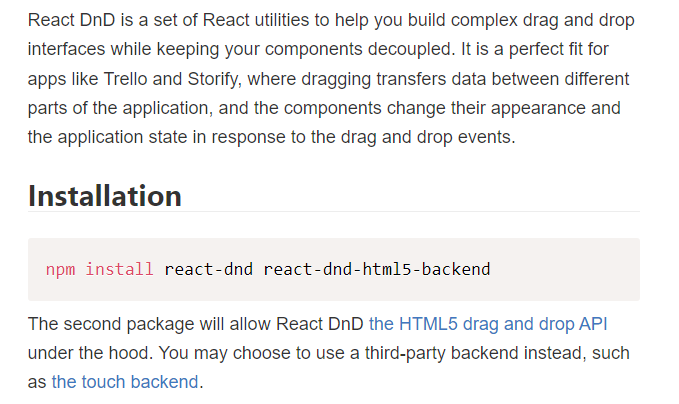 我還沒有完全實現拖放功能,而且我經常發現自己對選擇哪個選項感到困惑。我遇到的另一個選擇是[interactjs.io](https://interactjs.io/) ,根據我讀過的文件,它似乎非常有用。由於他們提供了詳細的範例,這非常容易。  但我現在只介紹 React DND。 開始使用以下 npm 指令。 ``` npm install react-dnd react-dnd-html5-backend ``` 除非您正在編寫自訂後端,否則您可能想要使用 React DnD 隨附的 HTML5 後端。 這是安裝`react-dnd-html5-backend`方法。閱讀[文件](https://react-dnd.github.io/react-dnd/docs/backends/html5)。 這是起點。 ``` import { HTML5Backend } from 'react-dnd-html5-backend' import { DndProvider } from 'react-dnd' export default class YourApp { render() { return ( <DndProvider backend={HTML5Backend}> /* Your Drag-and-Drop Application */ </DndProvider> ) } } ``` 透過這種方式,您可以非常輕鬆地實現卡片的拖放操作。 ``` // Let's make <Card text='Write the docs' /> draggable! import React from 'react' import { useDrag } from 'react-dnd' import { ItemTypes } from './Constants' export default function Card({ isDragging, text }) { const [{ opacity }, dragRef] = useDrag( () => ({ type: ItemTypes.CARD, item: { text }, collect: (monitor) => ({ opacity: monitor.isDragging() ? 0.5 : 1 }) }), [] ) return ( <div ref={dragRef} style={{ opacity }}> {text} </div> ) } ``` 請注意,HTML5 後端不支援觸控事件。因此它不適用於平板電腦和行動裝置。您可以將`react-dnd-touch-backend`用於觸控裝置。閱讀[文件](https://react-dnd.github.io/react-dnd/docs/backends/touch)。 ``` import { TouchBackend } from 'react-dnd-touch-backend' import { DndProvider } from 'react-dnd' class YourApp { <DndProvider backend={TouchBackend} options={opts}> {/* Your application */} </DndProvider> } ``` 這個codesandbox規定了我們如何正確使用React DND。 https://codesandbox.io/embed/3y5nkyw381?view=Editor+%2B+Preview&module=%2Fsrc%2Findex.tsx&hidenavigation=1 你可以看看React DND的[例子](https://react-dnd.github.io/react-dnd/examples)。 它們甚至有一個乾淨的功能,您可以使用 Redux 檢查內部發生的情況。 您可以透過為提供者新增 debugModeprop 來啟用[Redux DevTools](https://github.com/reduxjs/redux-devtools) ,其值為 true。 ``` <DndProvider debugMode={true} backend={HTML5Backend}> ``` 它提供了多種元件選項,我需要親自測試一下。總的來說,這看起來相當不錯,特別是如果你剛開始的話。 React DND 已獲得`MIT`許可,並在 GitHub 上擁有超過 20k Stars,這使其具有令人難以置信的可信度。 https://github.com/react-dnd/react-dnd Star React DND ⭐️ --- 5. [Cypress](https://github.com/cypress-io/cypress) - 快速測試瀏覽器中執行的內容。 --------------------------------------------------------------------  近年來已經證明了測試的重要性,而 Jest 和 Cypress 等選項使其變得異常簡單。 但我們只會介紹 Cypress,因為它本身就很方便。 只需一張圖片就能證明 Cypress 值得付出努力。 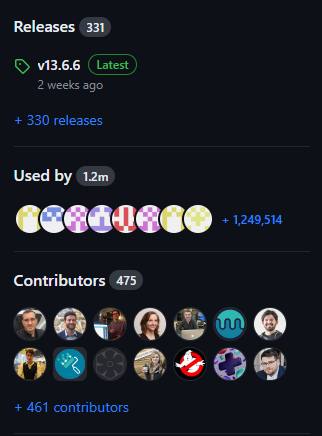 開始使用以下 npm 指令。 ``` npm install cypress -D ``` 如果您在專案中沒有使用 Node 或套件管理器,或者您想快速試用 Cypress,您始終可以[直接從 CDN 下載 Cypress](https://download.cypress.io/desktop) 。 一旦安裝並打開它。您必須使用`.cy.js`建立一個規範檔案。 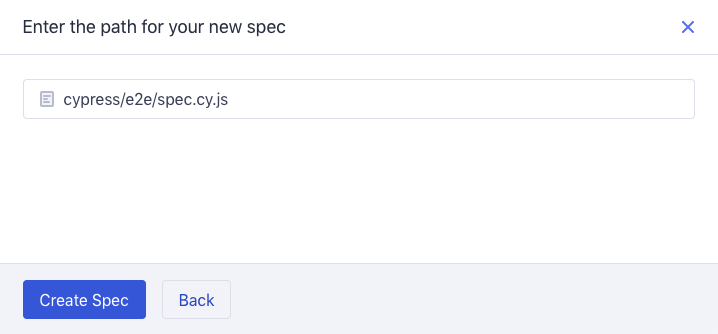 現在,您可以編寫並測試您的應用程式(範例程式碼)。 ``` describe('My First Test', () => { it('Does not do much!', () => { expect(true).to.equal(true) }) }) ``` Cypress 提供了多種選項,例如`cy.visit()`或`cy.contains()` 。由於我沒有廣泛使用 Cypress,因此您需要在其[文件](https://docs.cypress.io/guides/end-to-end-testing/writing-your-first-end-to-end-test)中進一步探索它。 如果它看起來很可怕,那麼請前往這個[為初學者解釋 Cypress 的](https://www.youtube.com/watch?v=u8vMu7viCm8&pp=ygUQY3lwcmVzcyB0dXRvcmlhbA%3D%3D)freeCodeCamp 教程。 Freecodecamp 影片確實是金礦 :D Cypress 在 GitHub 上擁有超過 45,000 顆星,並且在目前的 v13 版本中,它正在不斷改進。 https://github.com/cypress-io/cypress 星柏 ⭐️ --- [6.Refine](https://github.com/refinedev/refine) - 面向企業的開源 Retool。 ----------------------------------------------------------------- 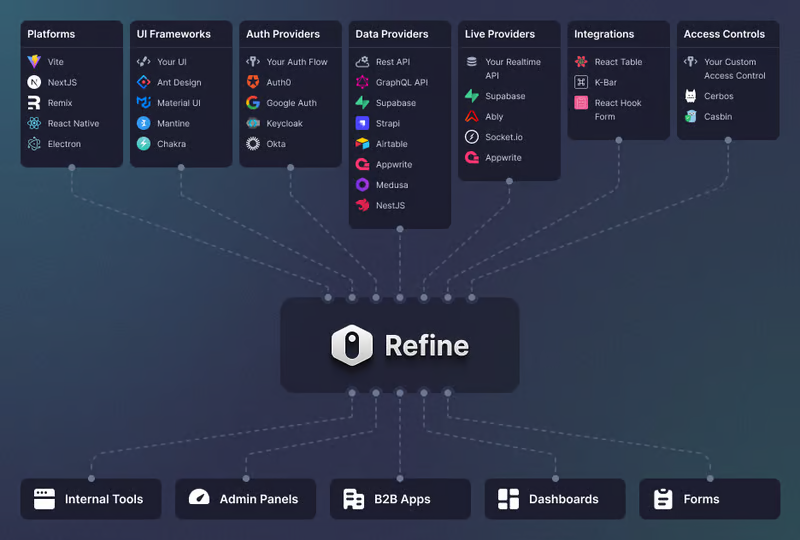 Refine 是一個元 React 框架,可以快速開發各種 Web 應用程式。 從內部工具到管理面板、B2B 應用程式和儀表板,它可作為建立任何類型的 CRUD 應用程式(例如 DevOps 儀表板、電子商務平台或 CRM 解決方案)的全面解決方案。  您可以在一分鐘內使用單一 CLI 命令進行設定。 它具有適用於 15 多個後端服務的連接器,包括 Hasura、Appwrite 等。 您可以查看可用的[整合清單](https://refine.dev/integrations/)。 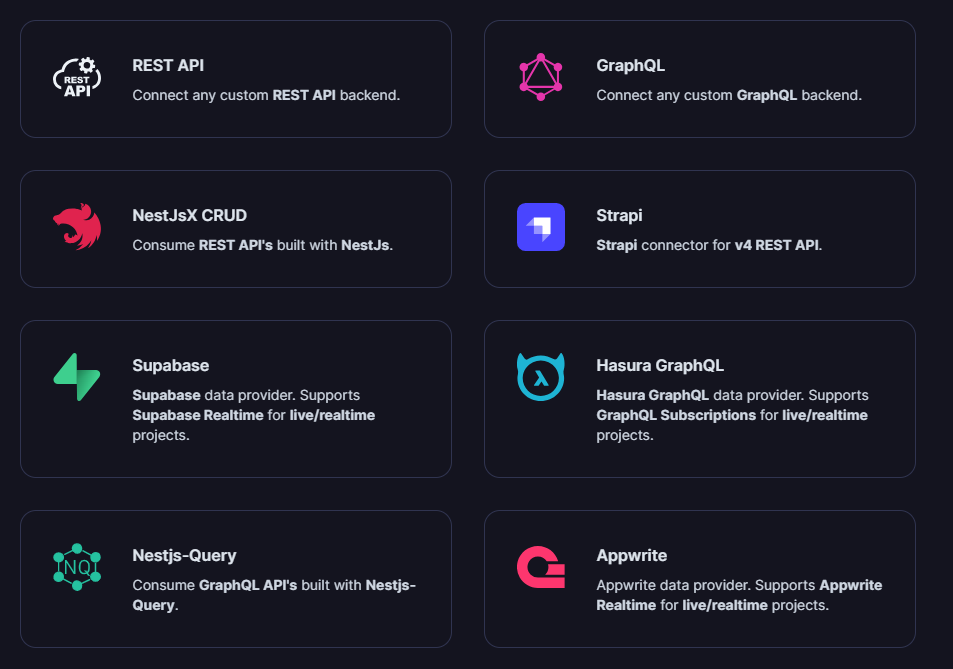 但最好的部分是,Refine `headless by design` ,從而提供無限的樣式和自訂選項。 由於該架構,您可以使用流行的 CSS 框架(如 TailwindCSS)或從頭開始建立樣式。 這是最好的部分,因為我們不希望最終受到與特定庫的兼容性的樣式限制,因為每個人都有自己的風格並使用不同的 UI。 開始使用以下 npm 指令。 ``` npm create refine-app@latest ``` 這就是使用 Refine 新增登入資訊的簡單方法。 ``` import { useLogin } from "@refinedev/core"; const { login } = useLogin(); ``` 使用 Refine 概述程式碼庫的結構。 ``` const App = () => ( <Refine dataProvider={dataProvider} resources={[ { name: "blog_posts", list: "/blog-posts", show: "/blog-posts/show/:id", create: "/blog-posts/create", edit: "/blog-posts/edit/:id", }, ]} > /* ... */ </Refine> ); ``` 您可以閱讀[文件](https://refine.dev/docs/)。 您可以看到一些使用 Refine 建立的範例應用程式: - [全功能管理面板](https://example.admin.refine.dev/) - [優化不同的用例場景](https://github.com/refinedev/refine/tree/master/examples)。 他們甚至提供模板,這就是為什麼這麼多用戶喜歡Refine。 你可以看到[模板](https://refine.dev/templates/)。  他們在 GitHub 上擁有大約 22k+ 顆星。 https://github.com/refinedev/refine 星際精煉 ⭐️ --- 7. [Tremor](https://github.com/tremorlabs/tremor) - React 元件來建立圖表和儀表板。 ----------------------------------------------------------------------  Tremor 提供了 20 多個開源 React 元件,用於建立基於 Tailwind CSS 的圖表和儀表板,使資料視覺化再次變得簡單。  開始使用以下 npm 指令。 ``` npm i @tremor/react ``` 這就是您如何使用 Tremor 快速建立東西。 ``` import { Card, ProgressBar } from '@tremor/react'; export default function Example() { return ( <Card className="mx-auto max-w-md"> <h4 className="text-tremor-default text-tremor-content dark:text-dark-tremor-content"> Sales </h4> <p className="text-tremor-metric font-semibold text-tremor-content-strong dark:text-dark-tremor-content-strong"> $71,465 </p> <p className="mt-4 flex items-center justify-between text-tremor-default text-tremor-content dark:text-dark-tremor-content"> <span>32% of annual target</span> <span>$225,000</span> </p> <ProgressBar value={32} className="mt-2" /> </Card> ); } ``` 這就是基於此生成的內容。  您可以閱讀[文件](https://www.tremor.so/docs/getting-started/installation)。其間,他們在引擎蓋下使用混音圖標。 從我見過的各種元件來看,這是一個很好的起點。相信我! Tremor 還提供了一個[乾淨的 UI 工具包](https://www.figma.com/community/file/1233953507961010067)。多麼酷啊!  Tremor 在 GitHub 上擁有超過 14k 顆星,並有超過 280 個版本,這意味著它正在不斷改進。 https://github.com/tremorlabs/tremor 星震 ⭐️ --- 8. [Watermelon DB](https://github.com/Nozbe/WatermelonDB) - 用於 React 和 React Native 的反應式和非同步資料庫。 ------------------------------------------------------------------------------------------------  我不知道為什麼資料庫有這麼多選項;甚至很難全部數清。但如果我們使用 React,Watermelon DB 是一個不錯的選擇。即使在 4k+ 提交之後,它們仍然處於`v0.28`版本,這是一個相當大的問題。 Rocket.chat 使用 Watermelon DB,這給了他們巨大的可信度。 開始使用以下 npm 指令。 ``` npm install @nozbe/watermelondb ``` 您需要做的第一件事是建立模型和後續遷移(閱讀文件)。 ``` import { appSchema, tableSchema } from '@nozbe/watermelondb' export default appSchema({ version: 1, tables: [ // We'll add to tableSchemas here ] }) ``` 根據文件,使用 WatermelonDB 時,您正在處理模型和集合。然而,在 Watermelon 之下有一個底層資料庫(SQLite 或 LokiJS),它使用不同的語言:表格和欄位。這些一起稱為資料庫模式。 您可以閱讀有關[CRUD 操作的](https://watermelondb.dev/docs/CRUD)[文件](https://watermelondb.dev/docs/Installation)和更多內容。 https://github.com/Nozbe/WatermelonDB 明星 WatermelonDB ⭐️ --- 9. [Evergreen UI](https://github.com/segmentio/evergreen) - 按 Segment 劃分的 React UI 框架。 --------------------------------------------------------------------------------------  沒有 UI 框架的清單幾乎是不可能的。有許多受歡迎的選項,例如 Material、Ant Design、Next UI 等等。 但我們正在報道 Evergreen,它本身就非常好。 開始使用以下 npm 指令。 ``` $ npm install evergreen-ui ``` [Evergreen Segment 網站](https://evergreen.segment.com/foundations)上顯示了任何使用者介面的基礎以及詳細的選項。  它提供了很多元件,其中一些非常好,例如`Tag Input`或`File uploader` 。  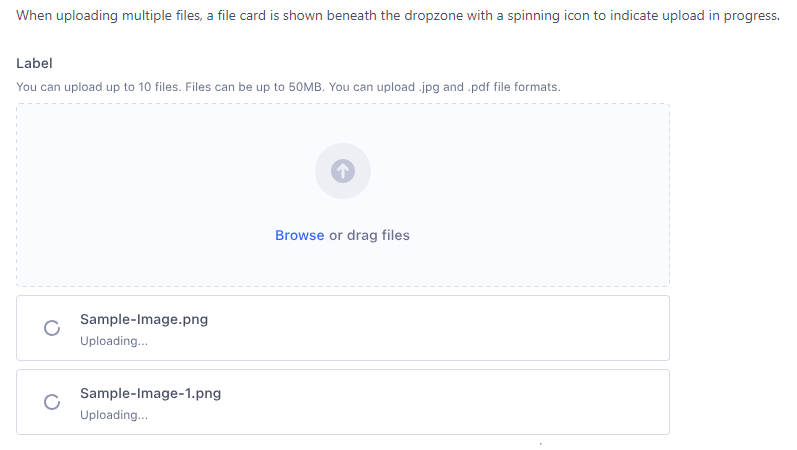 您可以看到 Evergreen UI 提供的所有[元件](https://evergreen.segment.com/components)。 https://github.com/segmentio/evergreen Star Evergreen UI ⭐️ --- 10. [React Spring](https://www.react-spring.dev/) - 流暢的動畫來提升 UI 和互動。 -------------------------------------------------------------------- 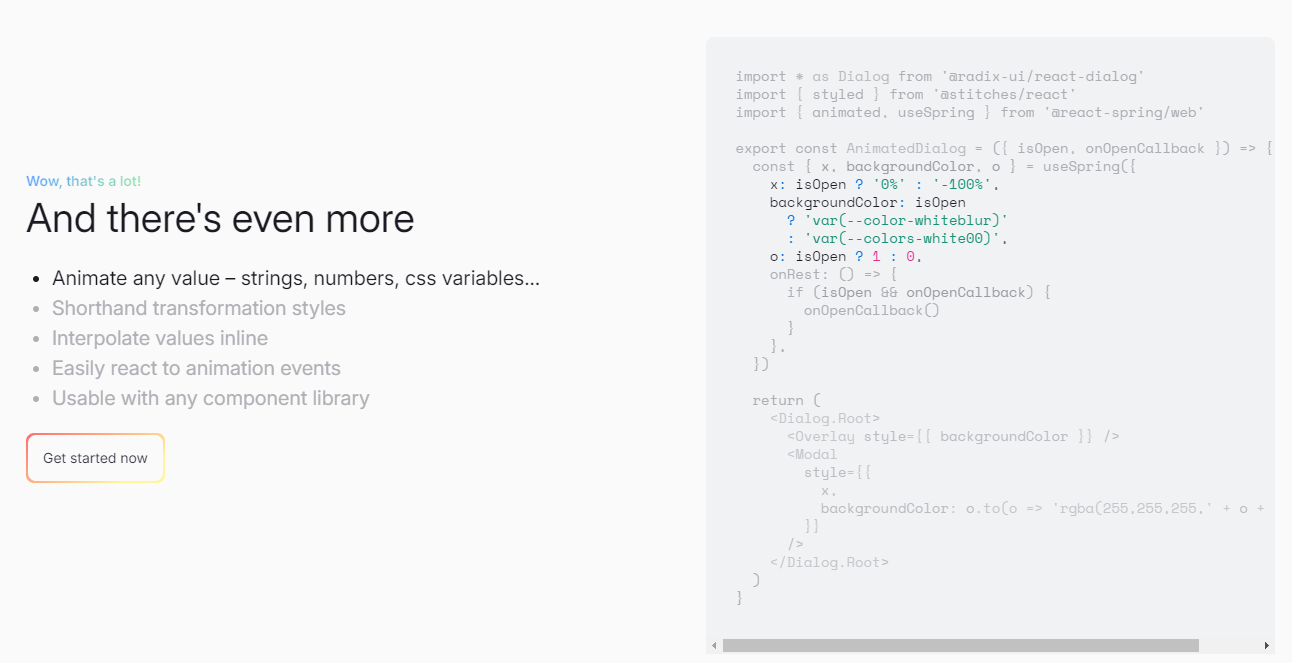  如果您喜歡 React-Motion 但感覺過渡不流暢,那是因為它專門使用 React 渲染。 如果你喜歡 Popmotion,但感覺自己的能力受到限制,那是因為它完全跳過了 React 渲染。 `react-spring`提供了兩種選擇,試試看! 開始使用以下 npm 指令。 ``` npm i @react-spring/web ``` 這就是導入高階元件來包裝動畫的方法。 ``` import { animated } from '@react-spring/web' // use it. export default function MyComponent() { return ( <animated.div style={{ width: 80, height: 80, background: '#ff6d6d', borderRadius: 8, }} /> ) } ``` 由於以下程式碼和框,我決定嘗試 React Spring。令人驚訝的是,我們可以使用 React Spring 做很多事情。 https://codesandbox.io/embed/mdovb?view=Editor+%2B+Preview&module=%2Fsrc%2Findex.tsx&hidenavigation=1 您可以閱讀[文件](https://www.react-spring.dev/docs/getting-started)。 他們還提供了很多您可以學習的[範例](https://www.react-spring.dev/examples)。  它提供了大量的選項,例如`useScroll` ,它允許您建立滾動連結動畫。 例如,這個codesandbox告訴了`useScroll`的用法。 https://codesandbox.io/embed/b07dmz?view=Editor+%2B+Preview&module=%2Fsrc%2Findex.tsx&hidenavigation=1 React Spring 在 GitHub 上有大約 27k+ Stars。 https://github.com/pmndrs/react-spring Star React Spring ⭐️ --- 11. [React Tweet](https://github.com/vercel/react-tweet) - 將推文嵌入到你的 React 應用程式中。 --------------------------------------------------------------------------------  `React Tweet`可讓您在使用 Next.js、Create React App、Vite 等時將推文嵌入到 React 應用程式中。 該函式庫不需要使用 Twitter API。推文可以靜態呈現,從而無需包含 iframe 和額外的客戶端 JavaScript。 它是 Vercel 的開源專案。 開始使用以下 npm 指令。 ``` npm i react-tweet ``` 為了顯示推文,我們需要從 Twitter 的 API 請求資料。透過此 API 進行速率限制具有挑戰性,但如果您僅依賴我們提供的 SWR 端點 ( `react-tweet.vercel.app/api/tweet/:id` ),這是可能的,因為伺服器的IP 位址向Twitter 發出了許多請求API。這也適用於 RSC,其中 API 端點不是必需的,但伺服器仍然從相同 IP 位址發送請求。 為了避免 API 限制,您可以使用 Redis 或 Vercel KV 等資料庫快取推文。例如,您可以使用 Vercel KV。 ``` import { Suspense } from 'react' import { TweetSkeleton, EmbeddedTweet, TweetNotFound } from 'react-tweet' import { fetchTweet, Tweet } from 'react-tweet/api' import { kv } from '@vercel/kv' async function getTweet( id: string, fetchOptions?: RequestInit ): Promise<Tweet | undefined> { try { const { data, tombstone, notFound } = await fetchTweet(id, fetchOptions) if (data) { await kv.set(`tweet:${id}`, data) return data } else if (tombstone || notFound) { // remove the tweet from the cache if it has been made private by the author (tombstone) // or if it no longer exists. await kv.del(`tweet:${id}`) } } catch (error) { console.error('fetching the tweet failed with:', error) } const cachedTweet = await kv.get<Tweet>(`tweet:${id}`) return cachedTweet ?? undefined } const TweetPage = async ({ id }: { id: string }) => { try { const tweet = await getTweet(id) return tweet ? <EmbeddedTweet tweet={tweet} /> : <TweetNotFound /> } catch (error) { console.error(error) return <TweetNotFound error={error} /> } } const Page = ({ params }: { params: { tweet: string } }) => ( <Suspense fallback={<TweetSkeleton />}> <TweetPage id={params.tweet} /> </Suspense> ) export default Page ``` 您可以直接使用它,方法非常簡單。 ``` <div className="dark"> <Tweet id="1629307668568633344" /> </div> ``` 如果您不喜歡使用 Twitter 主題,您也可以使用多個選項建立自己的[自訂主題](https://react-tweet.vercel.app/custom-theme)。 例如,您可以建立自己的推文元件,但沒有回覆按鈕,如下所示: ``` import type { Tweet } from 'react-tweet/api' import { type TwitterComponents, TweetContainer, TweetHeader, TweetInReplyTo, TweetBody, TweetMedia, TweetInfo, TweetActions, QuotedTweet, enrichTweet, } from 'react-tweet' type Props = { tweet: Tweet components?: TwitterComponents } export const MyTweet = ({ tweet: t, components }: Props) => { const tweet = enrichTweet(t) return ( <TweetContainer> <TweetHeader tweet={tweet} components={components} /> {tweet.in_reply_to_status_id_str && <TweetInReplyTo tweet={tweet} />} <TweetBody tweet={tweet} /> {tweet.mediaDetails?.length ? ( <TweetMedia tweet={tweet} components={components} /> ) : null} {tweet.quoted_tweet && <QuotedTweet tweet={tweet.quoted_tweet} />} <TweetInfo tweet={tweet} /> <TweetActions tweet={tweet} /> {/* We're not including the `TweetReplies` component that adds the reply button */} </TweetContainer> ) } ``` 您可以閱讀[文件](https://react-tweet.vercel.app/#installation)。 您可以查看[React Tweet 的演示,](https://react-tweet-next.vercel.app/light/1761133168772489698)以了解它如何在頁面上呈現。 它們已發布`v3.2`版本,這表明它們正在不斷改進,並且[每週下載量超過 46k+](https://www.npmjs.com/package/react-tweet) 。 https://github.com/vercel/react-tweet Star React 推文 ⭐️ --- 12. [React 360](https://github.com/facebookarchive/react-360) - 使用 React 建立令人驚嘆的 360 度和 VR 內容。 ----------------------------------------------------------------------------------------------  儘管 Facebook 已將其存檔,但許多開發人員仍然發現它足夠有用,因此繼續使用。 React 360 是一個函式庫,它利用大量 React Native 功能來建立在 Web 瀏覽器中執行的虛擬實境應用程式。 它使用 Three.js 進行渲染,並作為 npm 套件提供。透過將 WebGL 和 WebVR 等現代 API 與 React 的聲明性功能結合,React 360 有助於簡化建立跨平台 VR 體驗的過程。 開始使用以下 npm 指令。 ``` npm install -g react-360-cli ``` 涉及的事情有很多,但您可以使用 VrButton 加入重要的互動功能到您的 React VR 應用程式。 ``` import { AppRegistry, StyleSheet, Text, View, VrButton } from 'react-360'; state = { count: 0 }; _incrementCount = () => { this.setState({ count: this.state.count + 1 }) } <View style={styles.panel}> <VrButton onClick={this._incrementCount} style={styles.greetingBox}> <Text style={styles.greeting}> {`You have visited Simmes ${this.state.count} times`} </Text> </VrButton> </View> ``` 除了許多令人驚奇的東西之外,您還可以加入聲音。請參閱[使用 React 360 的 React Resources](https://reactresources.com/topics/react-360)範例。 您也可以閱讀 Log Rocket 撰寫的關於[使用 React 360 建立 VR 應用](https://blog.logrocket.com/building-a-vr-app-with-react-360/)程式的部落格。 這個codesandbox代表了我們可以使用React 360做什麼的一個常見範例。 https://codesandbox.io/embed/2bye27?view=Editor+%2B+Preview&module=%2Fsrc%2Findex.js&hidenavigation=1 https://github.com/facebookarchive/react-360 Star React 360 ⭐️ --- 13. [React Advanced Cropper](https://github.com/advanced-cropper/react-advanced-cropper) - 建立適合您網站的裁剪器。 -------------------------------------------------------------------------------------------------------   React Advanced Cropper 是一個高級庫,可讓您建立適合任何網站設計的裁剪器。這意味著您不僅可以更改裁剪器的外觀,還可以自訂其行為。 它們仍處於測試版本,這意味著 API 可能會在未來版本中發生變化。 簡單的用例是設計軟體和裁剪圖像表面以獲得進一步的見解。 他們有很多選擇,因此值得。 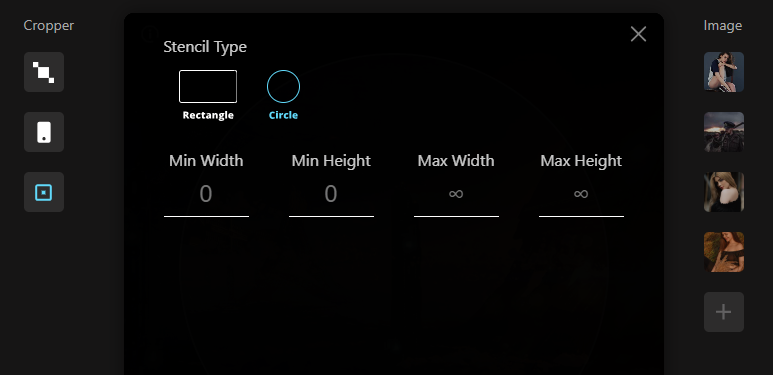  開始使用以下 npm 指令。 ``` npm install --save react-advanced-cropper ``` 您可以這樣使用它。 ``` import React, { useState } from 'react'; import { CropperRef, Cropper } from 'react-advanced-cropper'; import 'react-advanced-cropper/dist/style.css' export const GettingStartedExample = () => { const [image, setImage] = useState( 'https://images.unsplash.com/photo-1599140849279-1014532882fe?ixlib=rb-1.2.1&ixid=eyJhcHBfaWQiOjEyMDd9&auto=format&fit=crop&w=1300&q=80', ); const onChange = (cropper: CropperRef) => { console.log(cropper.getCoordinates(), cropper.getCanvas()); }; return ( <Cropper src={image} onChange={onChange} className={'cropper'} /> ) }; ``` 您可以閱讀[文件](https://advanced-cropper.github.io/react-advanced-cropper/docs/intro),它們提供了[20 多個自訂選項](https://github.com/advanced-cropper/react-advanced-cropper?tab=readme-ov-file#cropper)。 他們主要提供三種類型的[裁剪器選項](https://advanced-cropper.github.io/react-advanced-cropper/docs/guides/cropper-types/):固定、經典和混合以及範例和程式碼。 您可以使用 React Advanced Cropper 製作一些令人興奮的東西來向世界展示:) https://github.com/advanced-cropper/react-advanced-cropper Star React 進階裁剪器 ⭐️ --- 14. [Mobx](https://github.com/mobxjs/mobx) - 簡單、可擴展的狀態管理。 ---------------------------------------------------------  MobX 是一個經過驗證的基於訊號的函式庫,可透過函數反應式程式設計簡化和擴展狀態管理。它提供了靈活性,使您能夠獨立於任何 UI 框架來管理應用程式狀態。 這種方法會產生解耦、可移植且易於測試的程式碼。 以下是使用 MobX 的任何應用程式中處理事件的方式。  圖片來自文件 開始使用以下 npm 指令。 ``` npm install mobx-react --save // CDN is also available ``` 這就是它的樣子。 ``` import { observer } from "mobx-react" // ---- ES6 syntax ---- const TodoView = observer( class TodoView extends React.Component { render() { return <div>{this.props.todo.title}</div> } } ) // ---- ESNext syntax with decorator syntax enabled ---- @observer class TodoView extends React.Component { render() { return <div>{this.props.todo.title}</div> } } // ---- or just use function components: ---- const TodoView = observer(({ todo }) => <div>{todo.title}</div>) ``` 您可以使用 props、全域變數或使用 React Context 在觀察者中使用外部狀態。 您可以閱讀[有關 React Integration](https://mobx.js.org/react-integration.html)和[npm docs](https://www.npmjs.com/package/mobx-react#api-documentation)的文件。 您也可以閱讀[MobX 和 React 的 10 分鐘互動介紹](https://mobx.js.org/getting-started)。 MobX 在 GitHub 上擁有超過 27k 顆星,並在 GitHub 上被超過 140K 開發者使用。 https://github.com/mobxjs/mobx 明星 Mobx ⭐️ --- 15. [React Virtualized](https://github.com/bvaughn/react-virtualized) - 渲染大型清單和表格資料。 ------------------------------------------------------------------------------------  開始使用以下 npm 指令。 ``` npm install react-virtualized --save ``` 以下是如何在網格中使用 ColumnSizer 元件。探索演示(文件)以詳細了解可用選項。 ``` import React from 'react'; import ReactDOM from 'react-dom'; import {ColumnSizer, Grid} from 'react-virtualized'; import 'react-virtualized/styles.css'; // only needs to be imported once // numColumns, numRows, someCalculatedHeight, and someCalculatedWidth determined here... // Render your list ReactDOM.render( <ColumnSizer columnMaxWidth={100} columnMinWidth={50} columnCount={numColumns} width={someCalculatedWidth}> {({adjustedWidth, getColumnWidth, registerChild}) => ( <Grid ref={registerChild} columnWidth={getColumnWidth} columnCount={numColumns} height={someCalculatedHeight} cellRenderer={someCellRenderer} rowHeight={50} rowCount={numRows} width={adjustedWidth} /> )} </ColumnSizer>, document.getElementById('example'), ); ``` 您可以閱讀[文件](https://github.com/bvaughn/react-virtualized/tree/master/docs#documentation)和[演示](https://bvaughn.github.io/react-virtualized/#/components/List)。 他們提供了 React-window 作為輕量級的替代方案,但這個在發布和明星方面更受歡迎,所以我介紹了這個選項。您可以閱讀哪個選項更適合您: [React-Window 與 React-Virtualized 有何不同?](https://github.com/bvaughn/react-window?tab=readme-ov-file#how-is-react-window-different-from-react-virtualized) 。 它被超過 85,000 名開發人員使用,並在 GitHub 上擁有超過 25,000 顆星。它還擁有令人印象深刻的[170 萬+ 每週下載量](https://www.npmjs.com/package/react-virtualized)。 https://github.com/bvaughn/react-virtualized Star React 虛擬化 ⭐️ --- 16.React [Google Analytics](https://github.com/react-ga/react-ga) - React Google Analytics 模組。 ---------------------------------------------------------------------------------------------- 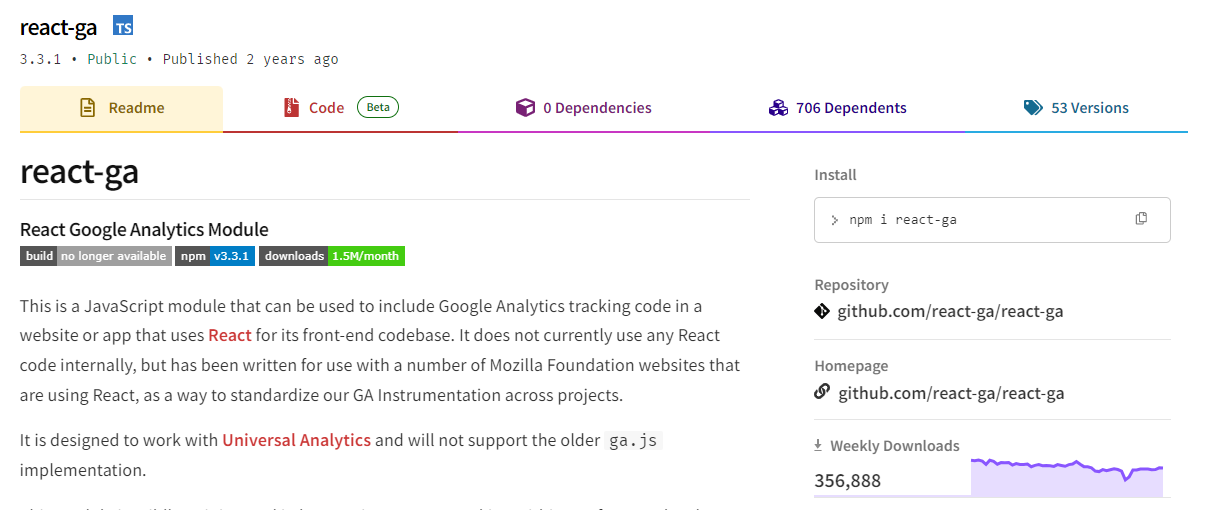 這是一個 JavaScript 模組,可用於在使用 React 作為前端程式碼庫的網站或應用程式中包含 Google Analytics 追蹤程式碼。 該模組對我們如何在前端程式碼中進行追蹤有一定的看法。我們的 API 比核心 Google Analytics 庫稍微詳細一些,以使程式碼更易於閱讀。 開始使用以下 npm 指令。 ``` npm install react-ga --save ``` 您可以這樣使用它。 ``` import ReactGA from 'react-ga'; ReactGA.initialize('UA-000000-01'); ReactGA.pageview(window.location.pathname + window.location.search); <!-- The core React library --> <script src="https://unpkg.com/[email protected]/dist/react.min.js"></script> <!-- The ReactDOM Library --> <script src="https://unpkg.com/[email protected]/dist/react-dom.min.js"></script> <!-- ReactGA library --> <script src="/path/to/bower_components/react-ga/dist/react-ga.min.js"></script> <script> ReactGA.initialize('UA-000000-01', { debug: true }); </script> ``` 執行`npm install` `npm start`並前往`port 8000 on localhost`後,您可以閱讀[文件](https://github.com/react-ga/react-ga?tab=readme-ov-file#installation)並查看[演示](https://github.com/react-ga/react-ga/tree/master/demo)。 它每週的下載量超過 35 萬次,在 GitHub 上擁有超過 5,000 顆星(已存檔)。 https://github.com/react-ga/react-ga Star React Google Analytics ⭐️ --- 17.react [-i18next](https://github.com/i18next/react-i18next) - React 的國際化做得很好。 ------------------------------------------------------------------------------- 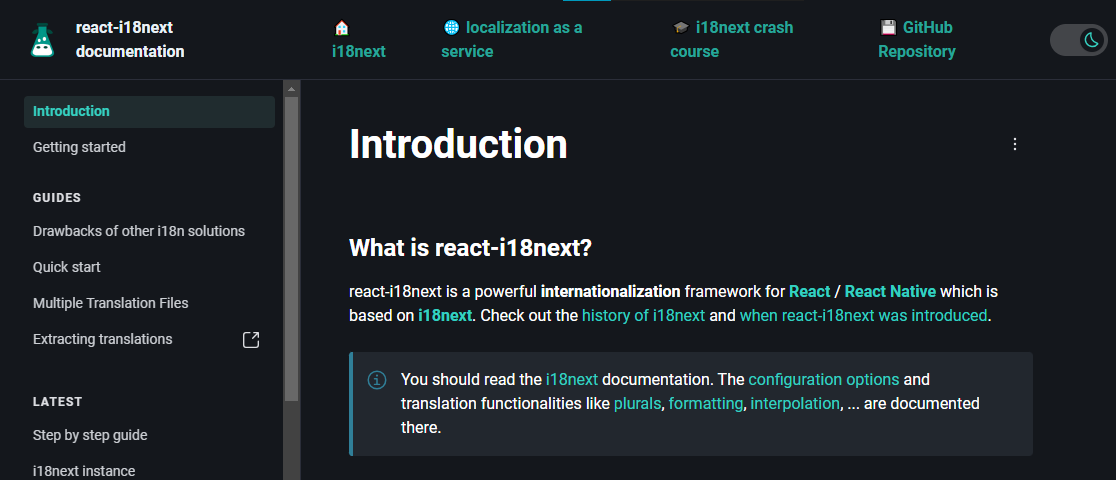 無需更改 webpack 配置或加入額外的 babel 轉譯器。 開始使用以下 npm 指令。 ``` npm i react-i18next ``` 我們來比較一下程式碼結構。 > 在使用react-i18next之前。 ``` ... <div>Just simple content</div> <div> Hello <strong title="this is your name">{name}</strong>, you have {count} unread message(s). <Link to="/msgs">Go to messages</Link>. </div> ... ``` > 使用react-i18next後。 ``` ... <div>{t('simpleContent')}</div> <Trans i18nKey="userMessagesUnread" count={count}> Hello <strong title={t('nameTitle')}>{{name}}</strong>, you have {{count}} unread message. <Link to="/msgs">Go to messages</Link>. </Trans> ... ``` 您可以閱讀[文件](https://react.i18next.com/)並前往[Codesandbox 的互動式遊樂場](https://codesandbox.io/s/1zxox032q)。 該工具已被超過 182,000 名開發人員使用,在 GitHub 上擁有超過 8,000 顆星。軟體包中令人印象深刻的 3400k+ 下載量進一步鞏固了它的可信度,使其成為您下一個 React 專案的絕佳選擇。 您也可以閱讀 Locize 關於[React Localization - Internationalize with i18next](https://locize.com/blog/react-i18next/)的部落格。 https://github.com/i18next/react-i18next 明星react-i18next ⭐️ --- 哇!如此長的有用專案清單。 我知道您有更多想法,分享它們,讓我們一起建造:D 現在就這些了! 在開展新專案時,開發人員經驗至關重要,這就是為什麼有些專案擁有龐大的社區,而有些則沒有。 React 社群非常龐大,所以成為這些社群的一部分,並使用這些開源專案將您的專案提升到一個新的水平。 祝你有美好的一天!直到下一次。 在 GitHub 上關注我。 https://github.com/Anmol-Baranwal 請關注 CopilotKit 以了解更多此類內容。 https://dev.to/copilotkit --- 原文出處:https://dev.to/copilotkit/libraries-you-should-know-if-you-build-with-react-1807
過去十年來,人工智慧世界取得了長足發展。 人工智慧無所不在,從語音助理到軟體開發,如果我們正確使用它,它會非常有幫助。 在這樣的世界中,製作 AI 應用程式是有利可圖的,因此我在這裡介紹 25 個開源專案,您可以使用它們來製作 AI 應用程式並將其提升到新的水平。 其中有一些令人興奮的概念,例如使用語音合成與 3D 角色進行互動式溝通。堅持到底。 將會有大量的資源、文章、專案想法、指南等可供參考。 讓我們涵蓋這一切! --- 1. [Taipy](https://github.com/Avaiga/taipy) - 將資料和人工智慧演算法整合到生產就緒的 Web 應用程式中。 ----------------------------------------------------------------------------  Taipy 是一個開源 Python 庫,可用於輕鬆的端到端應用程式開發,具有假設分析、智慧管道執行、內建調度和部署工具。 我相信你們大多數人都不明白 Taipy 用於為基於 Python 的應用程式建立 GUI 介面並改進資料流管理。 因此,您可以繪製資料集的圖表,並使用類似 GUI 的滑桿來提供使用其他實用功能來處理資料的選項。 雖然 Streamlit 是一種流行的工具,但在處理大型資料集時,其效能可能會顯著下降,這使得它在生產級使用上不切實際。 另一方面,Taipy 在不犧牲性能的情況下提供了簡單性和易用性。透過嘗試 Taipy,您將親身體驗其用戶友好的介面和高效的資料處理。 在底層,Taipy 利用各種函式庫來簡化開發並增強功能。 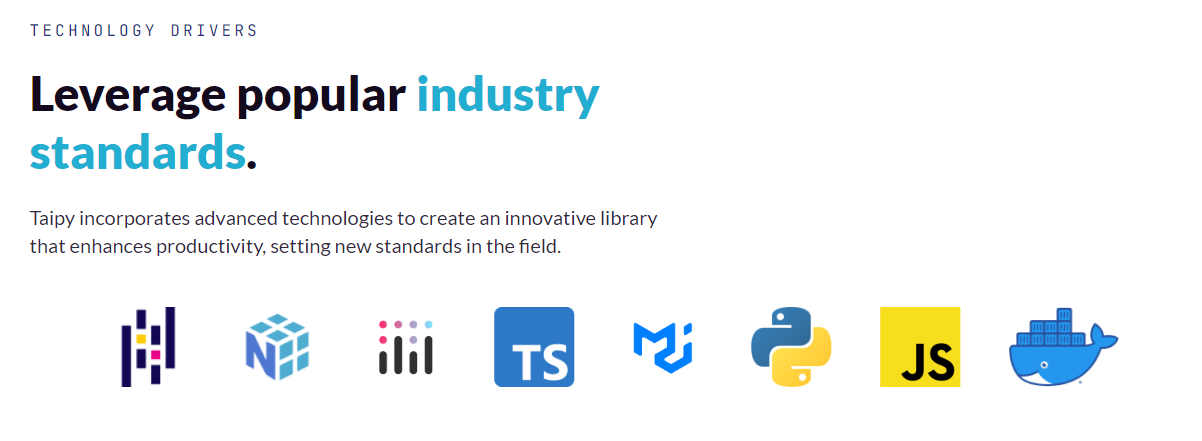 開始使用以下命令。 ``` pip install taipy ``` 我們來談談最新的[Taipy v3.1 版本](https://docs.taipy.io/en/latest/relnotes/)。 最新版本使得在 Taipy 的多功能零件物件中可視化任何 HTML 或 Python 物件成為可能。 這意味著[Folium](https://python-visualization.github.io/folium/latest/) 、 [Bokeh](https://bokeh.org/) 、 [Vega-Altair](https://altair-viz.github.io/)和[Matplotlib](https://matplotlib.org/)等程式庫現在可用於視覺化。 這也帶來了對[Plotly python 的](https://plotly.com/python/)原生支持,使繪製圖表變得更加容易。  他們還使用分散式運算提高了效能,但最好的部分是 Taipy,它的所有依賴項現在都與 Python 3.12 完全相容,因此您可以在使用 Taipy 進行專案的同時使用最新的工具和程式庫。 您可以閱讀[文件](https://docs.taipy.io/en/latest/)。 例如,您可以看到[聊天演示](https://docs.taipy.io/en/release-3.1/gallery/llm/5_chatbot/),它使用 OpenAI 的 GPT-4 API 來產生對您的訊息的回應。您可以輕鬆更改程式碼以使用任何其他 API 或模型。  另一個有用的事情是,Taipy 團隊提供了一個名為[Taipy Studio](https://docs.taipy.io/en/latest/manuals/studio/)的 VSCode 擴充功能來加速 Taipy 應用程式的建置。  您也可以使用 Taipy 雲端部署應用程式。 如果您想閱讀部落格來了解程式碼庫結構,您可以閱讀 HuggingFace 的[使用 Taipy 在 Python 中為您的 LLM 建立 Web 介面](https://huggingface.co/blog/Alex1337/create-a-web-interface-for-your-llm-in-python)。 嘗試新技術通常很困難,但 Taipy 提供了[10 多個演示教程](https://docs.taipy.io/en/release-3.1/gallery/),其中包含程式碼和適當的文件供您遵循。 例如,一些現場演示範例: - [新冠儀表板](https://covid-dashboard.taipy.cloud/Country) - [推文生成](https://tweet-generation.taipy.cloud/) - [資料視覺化](https://production-planning.taipy.cloud/Data-Visualization) - [即時人臉辨識](https://face-recognition.taipy.cloud/) Taipy 在 GitHub 上有 7k+ Stars,並且處於`v3`版本,因此它們正在不斷改進。  https://github.com/Avaiga/taipy Star Taipy ⭐️ --- 2. [Supabase](https://github.com/supabase/supabase) - 開源 Firebase 替代品。 ----------------------------------------------------------------------  要建立AI應用程式,您需要一個後端,而Supabase作為優秀的後端服務提供者可以滿足這一需求。 開始使用以下 npm 指令 (Next.js)。 ``` npx create-next-app -e with-supabase ``` 這就是使用 CRUD 操作的方式。 ``` import { createClient } from '@supabase/supabase-js' // Initialize const supabaseUrl = 'https://chat-room.supabase.co' const supabaseKey = 'public-anon-key' const supabase = createClient(supabaseUrl, supabaseKey) // Create a new chat room const newRoom = await supabase .from('rooms') .insert({ name: 'Supabase Fan Club', public: true }) // Get public rooms and their messages const publicRooms = await supabase .from('rooms') .select(` name, messages ( text ) `) .eq('public', true) // Update multiple users const updatedUsers = await supabase .from('users') .eq('account_type', 'paid') .update({ highlight_color: 'gold' }) ``` 您可以閱讀[文件](https://supabase.com/docs)。 您可以使用身份驗證、即時、邊緣功能、儲存等功能建立一個速度極快的應用程式。 Supabase 涵蓋了這一切! Supabase 也提供了幾個入門套件,例如[Nextjs 與 LangChain](https://github.com/langchain-ai/langchain-nextjs-template) 、 [Stripe 與 Nextjs](https://github.com/vercel/nextjs-subscription-payments)或[AI Chatbot](https://github.com/supabase-community/vercel-ai-chatbot) 。 Supabase 在 GitHub 上擁有超過 63,000 顆星,並且擁有大量提交超過 27,000 次的貢獻者。 https://github.com/supabase/supabase 明星 Supabase ⭐️ --- 3. [Chatwoot](https://github.com/chatwoot/chatwoot) - 即時聊天、電子郵件支援、全通路服務台並擁有您的資料。 --------------------------------------------------------------------------------  Chatwoot 連接流行的客戶溝通管道,如電子郵件、網站即時聊天、Facebook、Twitter、WhatsApp、Instagram、Line 等。這有助於您從單一儀表板跨管道提供一致的客戶體驗。 這在各種情況下都可能很重要,例如當您圍繞人工智慧應用程式建立社群時。  您可以閱讀[文件](https://www.chatwoot.com/docs/product)來發現各種整合選項,以便更輕鬆地管理整個生態系統。 他們在每個整合中都有非常詳細的文件和快照範例,例如[帶有 WhatsApp Cloud API 的 WhatsApp 通道](https://www.chatwoot.com/docs/product/channels/whatsapp/whatsapp-cloud)。您可以根據需要一鍵式或自架部署到 Heroku。 他們在 GitHub 上擁有 18k+ Stars,並且發布了`v3.6`版本。 https://github.com/chatwoot/chatwoot 明星 Chatwoot ⭐️ --- 4. [CopilotKit](https://github.com/CopilotKit/CopilotKit) - 在數小時內為您的產品提供 AI Copilot。 ------------------------------------------------------------------------------------  您可以使用兩個 React 元件將關鍵 AI 功能整合到 React 應用程式中。它們還提供內建(完全可自訂)Copilot 原生 UX 元件,例如`<CopilotKit />` 、 `<CopilotPopup />` 、 `<CopilotSidebar />` 、 `<CopilotTextarea />` 。 開始使用以下 npm 指令。 ``` npm i @copilotkit/react-core @copilotkit/react-ui @copilotkit/react-textarea ``` 這是整合 CopilotTextArea 的方法。 ``` import { CopilotTextarea } from "@copilotkit/react-textarea"; import { useState } from "react"; export function SomeReactComponent() { const [text, setText] = useState(""); return ( <> <CopilotTextarea className="px-4 py-4" value={text} onValueChange={(value: string) => setText(value)} placeholder="What are your plans for your vacation?" autosuggestionsConfig={{ textareaPurpose: "Travel notes from the user's previous vacations. Likely written in a colloquial style, but adjust as needed.", chatApiConfigs: { suggestionsApiConfig: { forwardedParams: { max_tokens: 20, stop: [".", "?", "!"], }, }, }, }} /> </> ); } ``` 您可以閱讀[文件](https://docs.copilotkit.ai/getting-started/quickstart-textarea)。 基本概念是在幾分鐘內建立可用於基於 LLM 的全端應用程式的 AI 聊天機器人。 https://github.com/CopilotKit/CopilotKit Star CopilotKit ⭐️ --- 5. [DALL·E Mini](https://github.com/borisdayma/dalle-mini) - 根據文字提示產生圖像。 ------------------------------------------------------------------------  OpenAI 擁有第一個令人印象深刻的模型,用於使用 DALL·E 生成圖像。 Craiyon/DALL·E mini 嘗試使用開源模型重現這些結果。 如果您想知道這個名字,DALL-E mini 應母公司的要求更名為 Craiyon,並以更易於存取的網路應用程式格式使用類似的技術。 您可以在[Craiyon](https://www.craiyon.com/)上使用該模型。 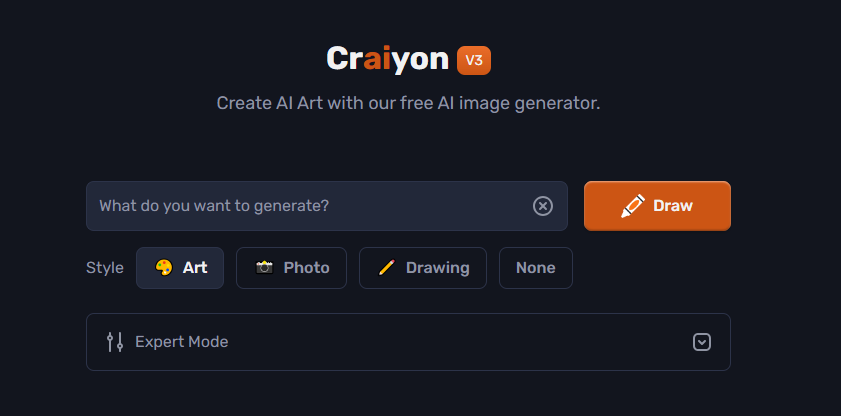 開始使用以下命令(用於開發)。 ``` pip install dalle-mini ``` 您可以閱讀[文件](https://github.com/borisdayma/dalle-mini?tab=readme-ov-file#development)。 您可以閱讀[DALL-E Mini 解釋](https://wandb.ai/dalle-mini/dalle-mini/reports/DALL-E-Mini-Explained-with-Demo--Vmlldzo4NjIxODA)來了解有關資料集、架構和所涉及演算法的更多資訊。 您可以閱讀[最佳真實感 AI 圖像和提示的終極指南](https://www.craiyon.com/blog/ultimate-guide-best-ai-art-photorealistic-images-and-prompts),以便更好地理解優質資源。 DALL·E Mini 在 GitHub 上擁有 14k+ Stars,目前處於`v0.1`版本。 https://github.com/borisdayma/dalle-mini 明星 DALL·E Mini ⭐️ --- 6. [Deepgram](https://github.com/deepgram) - 將語音 AI 建置到您的應用程式中。 --------------------------------------------------------------- 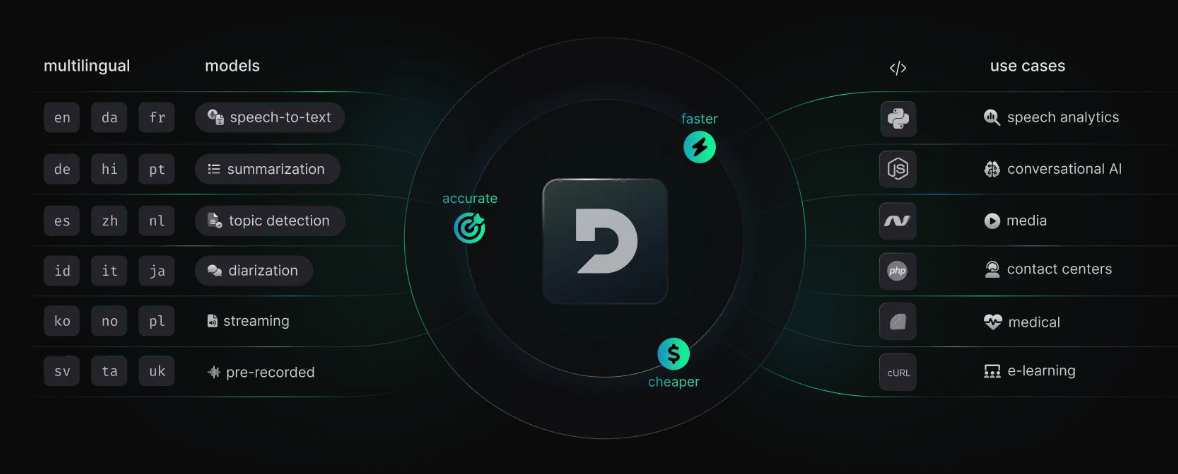 從新創公司到 NASA,Deepgram API 每天都用於轉錄和理解數百萬分鐘的音訊。快速、準確、可擴展且經濟高效。 它為開發人員提供語音到文字和音訊智慧模型。  儘管他們有免費增值模式,但免費套餐的限制足以讓您入門。 可視化效果更上一層樓。您可以檢查即時串流媒體回應或音訊檔案並比較音訊的智慧程度。  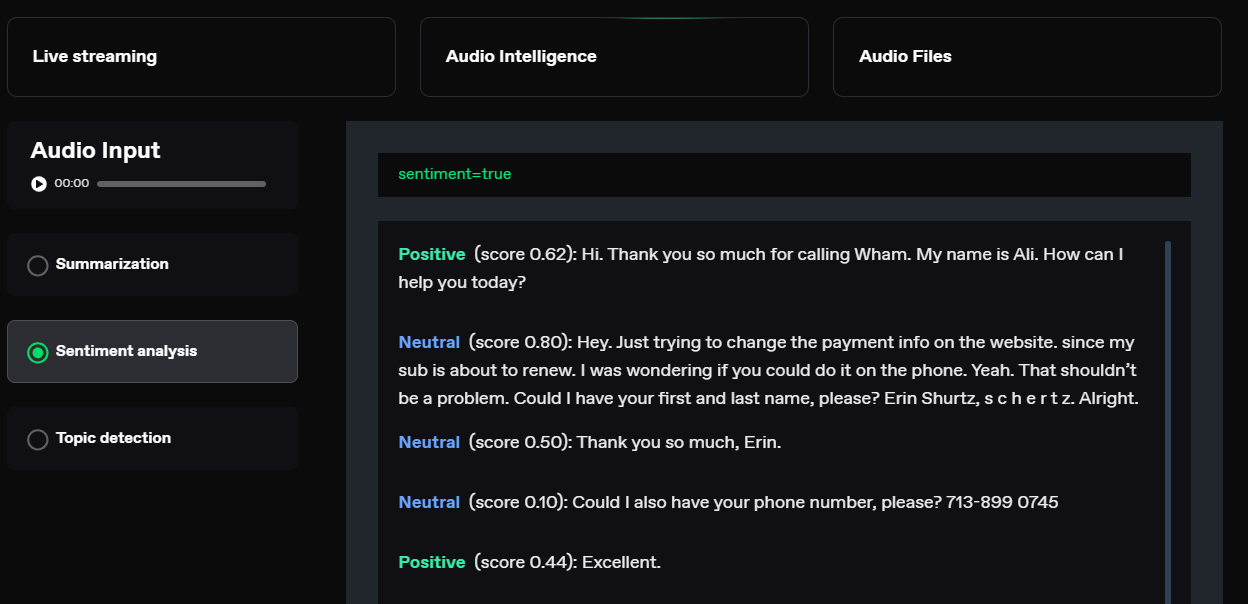 您可以閱讀[文件](https://developers.deepgram.com/docs/introduction)。 您也可以閱讀 Deepgram 撰寫的[關於如何將語音辨識新增至您的 React 和 Node.js 專案的](https://deepgram.com/learn/how-to-add-speech-recognition-to-your-react-project)範例部落格。 如果您想嘗試 API 來親自了解模型的靈活性,請查看他們的[API Playground](https://playground.deepgram.com/?smart_format=true&language=en&model=nova-2) 。 https://github.com/deepgram 明星 Deepgram ⭐️ --- 7. [InvokeAI](https://github.com/invoke-ai/InvokeAI) - 領先的穩定擴散模型創意引擎。 ---------------------------------------------------------------------  關於 InvokeAI 是 Stable Diffusion(開源文字到圖像和圖像到圖像生成器)的實現。 它可以在 Windows、Mac 和 Linux 機器上執行,並在 RAM 低至 4 GB 的 GPU 卡上執行。 此解決方案提供業界領先的WebUI,支援透過CLI進行終端使用,並作為多種商業產品的基礎。  您可以閱讀有關[安裝和硬體要求](https://invoke-ai.github.io/InvokeAI/installation/INSTALLATION/)、[如何安裝不同型號](https://invoke-ai.github.io/InvokeAI/installation/050_INSTALLING_MODELS/)以及最重要的[自動安裝的資訊](https://invoke-ai.github.io/InvokeAI/installation/010_INSTALL_AUTOMATED/)。 令人興奮的功能是能夠使用另一個圖像生成圖像,如[文件](https://invoke-ai.github.io/InvokeAI/features/IMG2IMG/)中所述。 InvokeAI 在 GitHub 上有近 21k 顆星, https://github.com/invoke-ai/InvokeAI 明星 InvokeAI ⭐️ --- 8. [OpenAI](https://github.com/openai) - 您所需要的一切。 -------------------------------------------------  Gemini by Google 和 OpenAI 非常受歡迎,但我們在此列表中專注於 OpenAI。 如果您想了解更多訊息,可以在 Medium 上閱讀[Google AI Gemini API in web using React 🤖](https://generativeai.pub/google-gemini-api-in-web-using-react-7e5bf0bf0abc) 。這很簡單,也很切中要害。 透過 OpenAI,您可以使用 DALL·E(根據文字描述建立原創、逼真的圖像和藝術)、Whisper(語音辨識模型)和 GPT-4。在評論中告訴我們關於索拉的事吧! 您可以使用簡單的 API 開始建置。 ``` completion = openai.ChatCompletion.create( model="gpt-3.5-turbo", messages=[ {"role": "system", "content": "You are a helpful assistant."}, {"role": "user", "content": "What are some famous astronomical observatories?"} ] ) ``` 您可以閱讀[文件](https://platform.openai.com/docs/introduction)。它提供瞭如此多的選項來建立非常酷的東西! 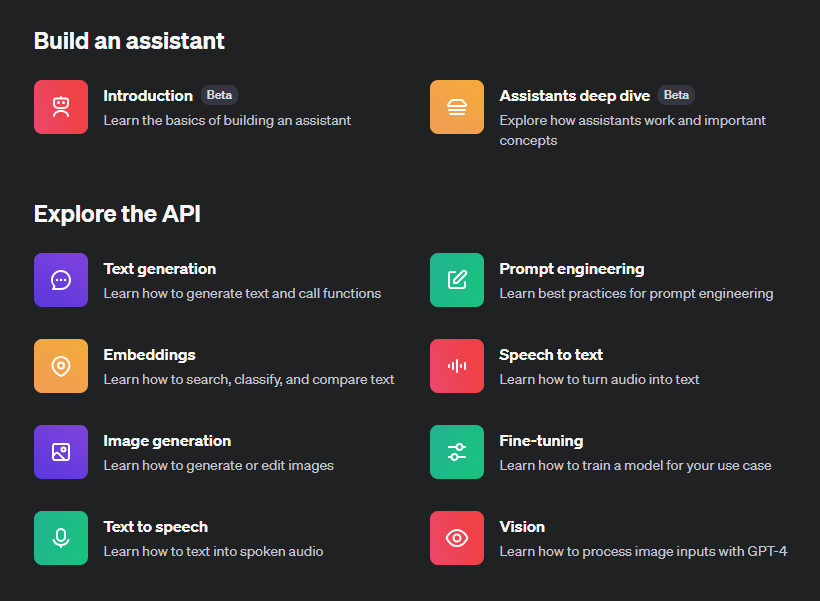 甚至 Stripe 也使用 GPT-4 來改善使用者體驗。 例如,您可以建立[Assistant 應用程式](https://platform.openai.com/docs/assistants/overview)並查看[API 遊樂場](https://platform.openai.com/playground/p/default-chat?model=text-davinci-003)以更好地理解它。 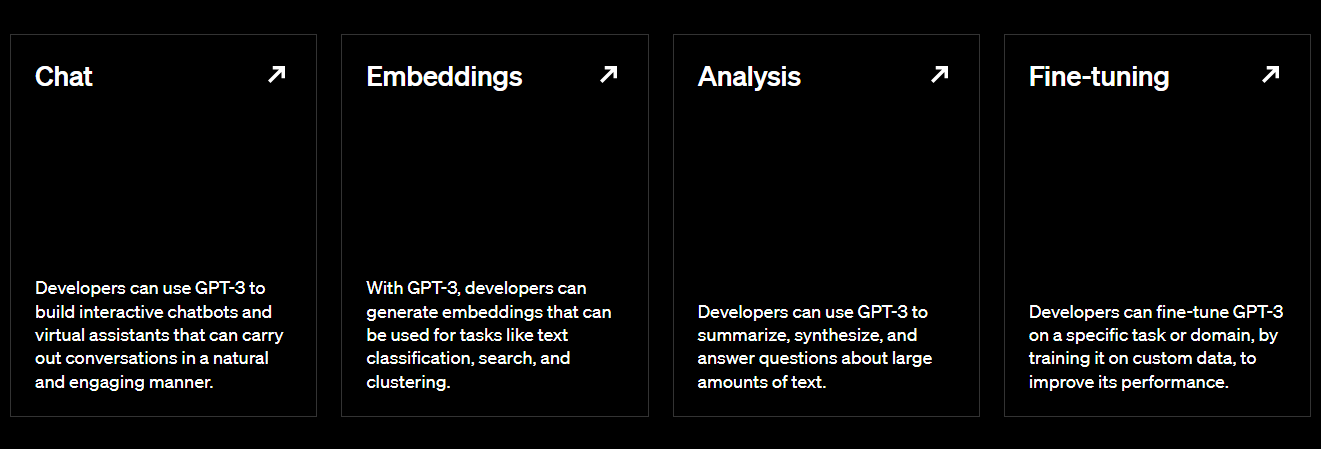 如果您需要指南,可以閱讀 Dzone 的[Integrating ChatGPT With ReactJS](https://dzone.com/articles/integrating-chatgpt-with-reactjs-a-comprehensive-g) 。 其間,OpenAI收購了Sora,獲得了壟斷地位。你怎麼認為? https://github.com/openai 明星 OpenAI ⭐️ --- 9. [DeepFaceLab](https://github.com/iperov/DeepFaceLab) - 用於建立深度贗品的領先軟體。 ------------------------------------------------------------------------  DeepFaceLab 是製作 Deepfakes 的頂級開源工具。 Deepfakes 是透過深度學習製作的經過修改的圖像和影片。它們經常被用來交換圖片或剪輯中的臉孔,有時是為了開玩笑,但也有出於有害的原因。 DeepFaceLab,用Python建置,是一個強大的deepfake工具。它可以改變媒體中的臉孔,甚至消除皺紋和老化跡象。 這些是您可以使用 DeepFaceLab 執行的一些操作。 - 換臉。  - [臉部抗衰老 - YouTube](https://www.youtube.com/watch?v=Ddx5B-84ebo) 。  - 更換頭部。  - 操縱嘴唇。 您可以使用這個基本教學來了解[如何有效地使用 DeepFaceLab](https://www.youtube.com/watch?v=kOIMXt8KK8M)來完成這些事情。 您可以在[YouTube](https://www.youtube.com/channel/UCGf4OlX_aTt8DlrgiH3jN3g/videos)上看到使用此 DeepLab 演算法的影片。 不幸的是,DeepFaceLab 中沒有「讓一切正常」按鈕,但值得根據您的特定需求了解其工作流程。 儘管它於 2023 年 11 月 9 日存檔,在 GitHub 上有近 44k+ 顆星,但由於其大量的教程和可靠的演算法,它仍然是您的 AI 應用程式的可靠選擇。 https://github.com/iperov/DeepFaceLab 明星 DeepFaceLab ⭐️ --- 10. [Detectron2](https://github.com/facebookresearch/detectron2) - 基於 PyTorch 的模組化物件偵測庫。 ----------------------------------------------------------------------------------------  Detectron2 是 Facebook AI Research 的下一代函式庫,提供最先進的偵測和分割演算法。它是 Detectron 和 maskrcnn-benchmark 的後繼者。 它支援 Facebook 上的多個電腦視覺研究專案和生產應用程式。 使用此[YouTube 教學](https://www.youtube.com/watch?v=eUSgtfK4ivk)將 Detectron2 與 Facebook 開發者倡導者的機器學習結合使用。 Detectron2 旨在支援各種最先進的物件偵測和分割模型,同時也適應不斷發展的前沿研究領域。 您可以閱讀[如何入門](https://detectron2.readthedocs.io/en/latest/tutorials/getting_started.html)以及 [元博客](https://ai.meta.com/blog/-detectron2-a-pytorch-based-modular-object-detection-library-/),其中深入介紹了 Detectron 的目標。 舊版的 Detectron 使用的是 Caffe,因此很難與後來結合 Caffe2 和 PyTorch 的程式碼變更一起使用。為了回應社群回饋,Facebook AI 發布了 Detectron2 作為更新的、更容易使用的版本。 Detectron2 配備了用於物件偵測的先進演算法,例如 DensePose 和全景特徵金字塔網路。 此外,Detectron2 還可以進行語義分割和全景分割,這有助於更準確地偵測和分割影像和影片中的物件。 Detectron2 不僅支援使用邊界框和實例分割遮罩進行物件偵測,還可以預測人體姿勢,與 Detectron 類似。 它們在 GitHub 儲存庫上擁有 28k+ Stars,並在 GitHub 上被 1.6k+ 開發人員使用。 https://github.com/facebookresearch/detectron2 Star Detectron2 ⭐️ --- [11.FastAI-](https://github.com/fastai/fastai)深度學習庫。 ---------------------------------------------------- 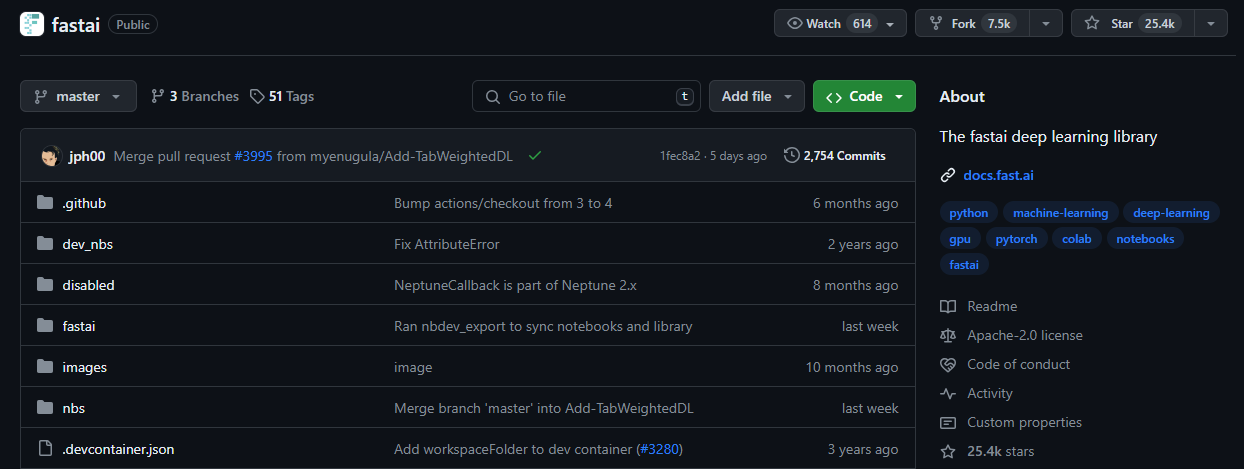 Fastai 是一個多功能的深度學習庫,旨在滿足從業者和研究人員的需求。它為從業者提供了高級元件,以便他們在常見的深度學習任務中快速獲得一流的結果。 同時,它為研究人員提供低階元件來實驗和開發新方法。 Detectron2 透過其分層架構實現了易用性和靈活性之間的平衡。 該架構將複雜的深度學習技術分解為可管理的抽象,簡潔地利用了 Python 的動態特性和 PyTorch 的靈活性。 它建構在較低層級 API 的層次結構之上,這些 API 提供可組合的建構塊。這樣,想要重寫部分高級 API 或加入特定行為以滿足其需求的用戶無需學習如何使用最低級別。 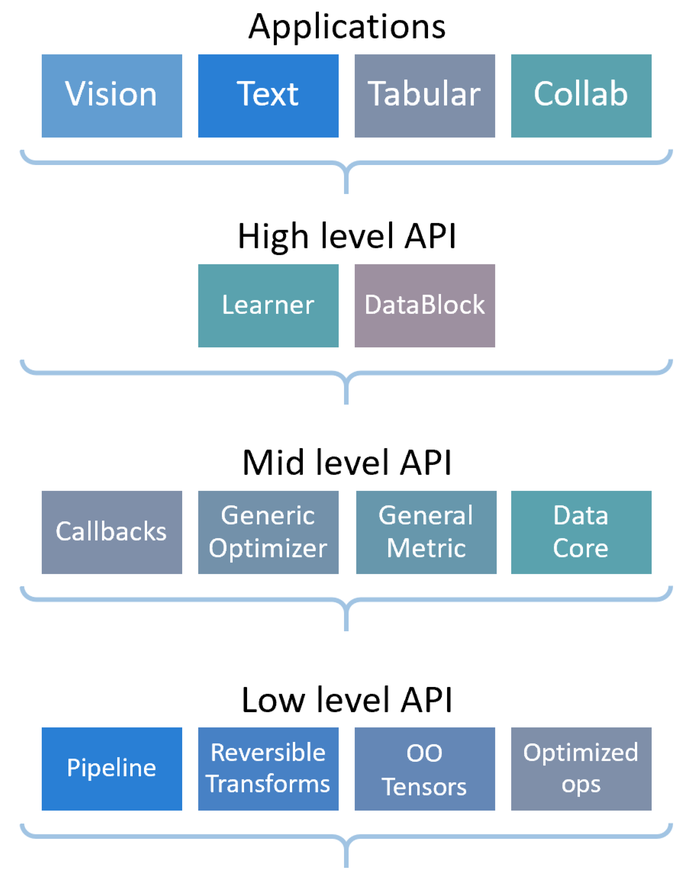 [安裝 pyTorch](https://pytorch.org/get-started/locally/)後即可開始使用以下命令。 ``` conda install -c fastai fastai ``` 您可以閱讀[文件](https://docs.fast.ai/)。 它們針對初學者、中級和專家的[教程](https://docs.fast.ai/tutorial.html)有不同的起點。 如果您想為 FastAI 做出貢獻,您應該閱讀他們的[程式碼風格指南](https://docs.fast.ai/dev/style.html)。 如果您更喜歡影片,可以在 YouTube 上觀看傑里米霍華德 (Jeremy Howard) 撰寫的[課程“0”:程式設計師實用深度學習 (fastai)](https://www.youtube.com/watch?v=gGxe2mN3kAg) 。 它們在 GitHub 上擁有超過 25,000 顆星,並已被 GitHub 上超過 16,000 名開發人員使用。 https://github.com/fastai/fastai 明星 FastAI ⭐️ --- 12.[穩定擴散](https://github.com/CompVis/stable-diffusion)- 潛在文字到影像擴散模型。 --------------------------------------------------------------------  > 什麼是穩定擴散? 穩定擴散是指生成模型中使用的一種技術,特別是在文字到圖像合成的背景下,其中將資訊從文字描述轉移到圖像的過程是逐漸且平滑地完成的。 在潛在文字到影像擴散模型中,穩定擴散可確保來自文字描述的訊息在整個模型的潛在空間中一致地擴散或傳播。這種擴散過程有助於產生與給定文字輸入相符的高品質和逼真的圖像。 穩定的擴散機制確保模型在生成過程中不會出現突然的跳躍或不穩定。我希望這能解決問題! 下載和採樣穩定擴散的簡單方法是使用[擴散器庫](https://github.com/huggingface/diffusers/tree/main#new--stable-diffusion-is-now-fully-compatible-with-diffusers)。 ``` # make sure you're logged in with `huggingface-cli login` from torch import autocast from diffusers import StableDiffusionPipeline pipe = StableDiffusionPipeline.from_pretrained( "CompVis/stable-diffusion-v1-4", use_auth_token=True ).to("cuda") prompt = "a photo of an astronaut riding a horse on mars" with autocast("cuda"): image = pipe(prompt)["sample"][0] image.save("astronaut_rides_horse.png") ``` 您可以閱讀[研究論文](https://ommer-lab.com/research/latent-diffusion-models/)以及有關[穩定擴散影像修改](https://github.com/CompVis/stable-diffusion?tab=readme-ov-file#image-modification-with-stable-diffusion)的更多資訊。 例如,這是輸入。  這是放大一點後的輸出。  Stable Diffusion v1 是一種特定的模型配置,它採用 860M UNet 和 CLIP ViT-L/14 文字編碼器進行擴散模型,並具有下採樣因子 8 自動編碼器。該模型在 256x256 影像上進行了預訓練,隨後在 512x512 影像上進行了微調。 他們在 GitHub 儲存庫上擁有大約 64k+ Stars。 https://github.com/CompVis/stable-diffusion 恆星穩定擴散 ⭐️ --- 13. [Mocap Drones](https://github.com/jyjblrd/Mocap-Drones) - 用於房間規模追蹤的低成本動作捕捉系統。 ---------------------------------------------------------------------------------  該專案需要 SFM(運動結構)OpenCV 模組,這需要您從原始程式碼編譯 OpenCV。 從`computer_code`目錄中,執行此命令來安裝節點相依性。 ``` yarn install yarn run dev // to start the web server. ``` 您將獲得前端介面的 URL 視圖。 開啟一個單獨的終端機視窗並執行命令`python3 api/index.py`來啟動後端伺服器。此伺服器負責接收攝影機串流並執行動作捕捉計算。 架構如下。  您可以觀看此[YouTube 影片](https://www.youtube.com/watch?v=0ql20JKrscQ)來了解 Mocap 無人機的工作原理,也可以觀看該專案所有者的[部落格](https://joshuabird.com/blog/post/mocap-drones)。 https://www.youtube.com/watch?v=0ql20JKrscQ 您可以閱讀[文件](https://github.com/jyjblrd/Mocap-Drones?tab=readme-ov-file#runing-the-code)。 這是一個最近的開源專案,在 GitHub 儲存庫上擁有 900 多個 star。 https://github.com/jyjblrd/Mocap-Drones 明星動捕無人機 ⭐️ --- 14. [Whisper Speech](https://github.com/collabora/WhisperSpeech) - 透過反轉 Whisper 建構的文字轉語音系統。 -------------------------------------------------------------------------------------------  該模型與穩定擴散類似,但用於語音,功能強大且高度可自訂。 該團隊確保使用經過適當許可的語音錄音,並且所有程式碼都是開源的,使該模型對於商業應用程式來說是安全的。 目前,這些模型是在英語 LibreLight 資料集上進行訓練的。 您可以進一步研究[架構](https://github.com/collabora/WhisperSpeech?tab=readme-ov-file#architecture)。  您可以聽到[範例聲音](https://github.com/collabora/WhisperSpeech/assets/107984/aa5a1e7e-dc94-481f-8863-b022c7fd7434)並使用[colab](https://colab.research.google.com/drive/1xxGlTbwBmaY6GKA24strRixTXGBOlyiw)自行嘗試。 它們相當新,在 GitHub 上有大約 3k+ 的星星。 https://github.com/collabora/WhisperSpeech 星語語音 ⭐️ --- 15. [eSpeak NG](https://github.com/espeak-ng/espeak-ng) - 支援一百多種語言和口音的語音合成器。 ----------------------------------------------------------------------------  eSpeak NG 是一款緊湊型開源軟體文字語音合成器,適用於 Linux、Windows、Android 和其他作業系統。它支援 100 多種語言和口音。它基於 Jonathan Duddington 建立的 eSpeak 引擎。 您可以閱讀各種系統上的[安裝指南](https://github.com/espeak-ng/espeak-ng/blob/master/docs/guide.md)。 對於類似 Debian 的發行版(例如 Ubuntu、Mint 等)。您可以使用此命令。 ``` sudo apt-get install espeak-ng ``` 您可以查看[支援的語言](https://github.com/espeak-ng/espeak-ng/blob/master/docs/languages.md)清單、閱讀[文件](https://github.com/espeak-ng/espeak-ng/tree/master?tab=readme-ov-file#documentation)並查看[功能](https://github.com/espeak-ng/espeak-ng/tree/master?tab=readme-ov-file#features)。 該模型將文字轉換為音素程式碼,表明其作為另一個語音合成引擎前端的潛在能力。 他們在 GitHub 上有 2700+ 顆星星, https://github.com/espeak-ng/espeak-ng 明星 eSpeak NG ⭐️ --- 16.[聊天機器人 UI](https://github.com/mckaywrigley/chatbot-ui) - 每個模型的人工智慧聊天。 ------------------------------------------------------------------------  我們都使用過 ChatGPT,這個專案可以幫助我們為任何 AI 聊天機器人設定使用者介面。少一麻煩! 你可以閱讀[安裝指南](https://github.com/mckaywrigley/chatbot-ui?tab=readme-ov-file#1-install-docker)來安裝 docker、supabase CLI 和其他東西。 您可以閱讀<a href="">文件</a>並查看[演示](https://twitter.com/mckaywrigley/status/1738273242283151777?s=20)。 這在底層使用了 Supabase (Postgres),這就是我們之前討論它的原因。 我沒有討論 Vercel AI 聊天機器人,因為它與此機器人相比是一個相當新的比較。 Chatbot UI 在 GitHub 上擁有大約 25k+ Stars,因此它仍然是開發人員為任何聊天機器人建立 UI 介面的首選。 https://github.com/mckaywrigley/chatbot-ui 明星聊天機器人 UI ⭐️ --- 17. [GPT-4 & LangChain](https://github.com/mayooear/gpt4-pdf-chatbot-langchain) - 用於大型 PDF 文件的 GPT4 和 LangChain 聊天機器人。 -------------------------------------------------------------------------------------------------------------------------- 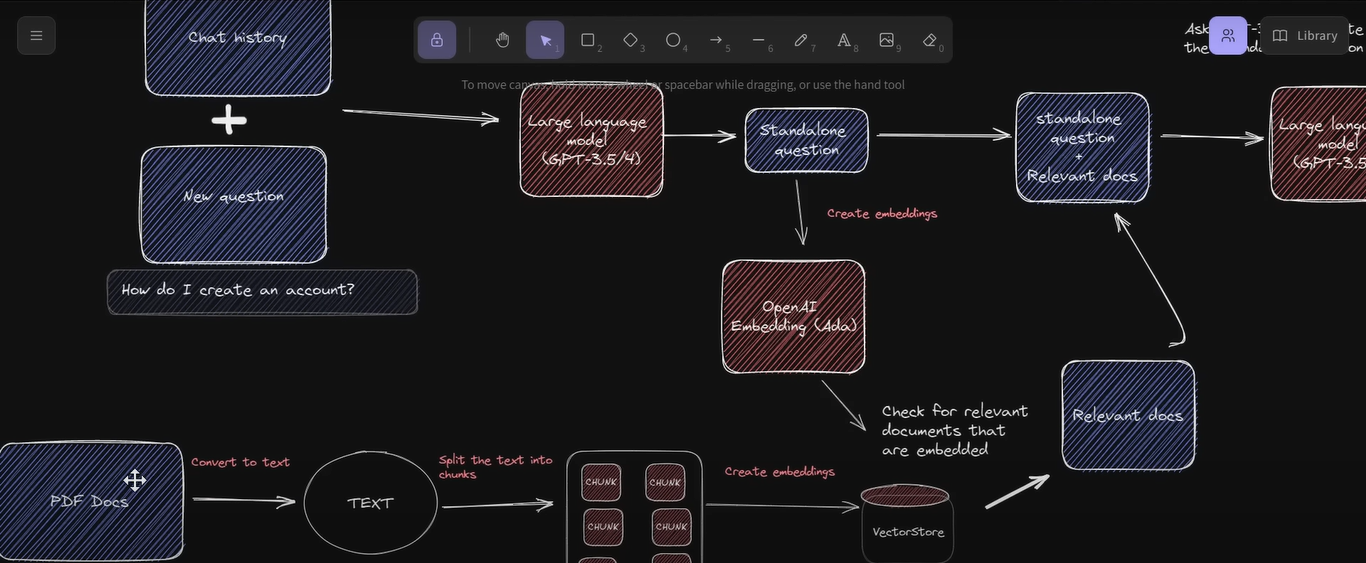 這可用於新的 GPT-4 API 來為多個大型 PDF 檔案建立 chatGPT 聊天機器人。 該系統是使用 LangChain、Pinecone、Typescript、OpenAI 和 Next.js 建構的。 LangChain 是一個簡化可擴展 AI/LLM 應用程式和聊天機器人開發的框架。 Pinecone 用作向量存儲,用於以文字格式儲存嵌入和 PDF,以便以後檢索類似文件。 您可以閱讀涉及複製、安裝依賴項和設定環境 API 金鑰[的開發指南](https://github.com/mayooear/gpt4-pdf-chatbot-langchain?tab=readme-ov-file#development)。 您可以觀看[YouTube 影片](https://www.youtube.com/watch?v=ih9PBGVVOO4),了解如何遵循和使用它。 他們在 GitHub 上擁有 14k+ Stars,僅提交了 34 次。在您的下一個人工智慧應用程式中嘗試! https://github.com/mayooear/gpt4-pdf-chatbot-langchain 明星 GPT-4 和 Langchain ⭐️ --- 18. [Amica](https://github.com/semperai/amica) - 允許您在瀏覽器中輕鬆與 3D 角色聊天。 ---------------------------------------------------------------------  Amica 是一個開源接口,用於透過語音合成和語音辨識與 3D 角色進行互動式通訊。 您可以匯入 VRM 文件,調整聲音以適合角色,並產生包含情緒表達的回應文字。 他們使用 Three.js、OpenAI、Whisper、Bakllava 等進行視覺處理。您可以閱讀[Amica 的工作原理](https://docs.heyamica.com/overview/how-amica-works)及其所涉及的[核心概念](https://docs.heyamica.com/overview/core-concepts)。 您可以克隆該存儲庫並使用它來[開始](https://docs.heyamica.com/getting-started/installation)。 ``` npm i npm run dev ``` 您可以閱讀[文件](https://docs.heyamica.com/)並查看[演示](https://amica.arbius.ai/),這真是太棒了:D  您可以觀看這段簡短的影片,了解它的功能。 https://www.youtube.com/watch?v=hUxAEnFiXH8 Amica 使用 Tauri 建立桌面應用程式。別擔心,我們在此清單的後面部分介紹了金牛座。 他們在 GitHub 上有 400 多個 Star,看起來非常容易使用。 https://github.com/semperai/amica Star Amica ⭐️ --- 19. [Hugging Face Transformers](https://github.com/huggingface/transformers) - 適用於 Pytorch、TensorFlow 和 JAX 的最先進的機器學習。 ----------------------------------------------------------------------------------------------------------------------  Hugging Face Transformers 可以輕鬆存取最先進的預訓練模型和演算法,用於文字分類、語言生成和問答等任務。該庫建置在 PyTorch 和 TensorFlow 之上,允許用戶以最少的努力將高級 NLP 功能無縫整合到他們的應用程式中。 憑藉大量預訓練模型和支援社區,Hugging Face Transformers 簡化了基於 NLP 的解決方案的開發。 這些模型可用於執行 100 多種語言的文本相關任務,例如文字分類、資訊擷取、問答、摘要、翻譯和文字生成。 它們還可以處理與影像相關的任務,例如影像分類、物件偵測和分割,以及與音訊相關的任務,例如語音辨識和音訊分類。 他們還可以執行各種模式的多任務處理,包括表格問答、光學字元辨識、從掃描文件中提取資訊、視訊分類和視覺問答。 您可以看到大量可用的[模型](https://huggingface.co/models)。 您可以瀏覽[文件](https://huggingface.co/docs/transformers/task_summary)以取得完整的目標並向您展示可以執行的各種任務的範例。 例如,使用管道的一種方法是用於影像分割。 ``` from transformers import pipeline segmenter = pipeline(task="image-segmentation") preds = segmenter( "https://huggingface.co/datasets/huggingface/documentation-images/resolve/main/pipeline-cat-chonk.jpeg" ) preds = [{"score": round(pred["score"], 4), "label": pred["label"]} for pred in preds] print(*preds, sep="\n") ``` Transformer 得到了 Jax、PyTorch 和 TensorFlow 這三個最廣泛使用的深度學習庫的支持,並且它們之間可以無縫整合。這種整合可以使用一個庫輕鬆訓練模型,然後加載它們以使用另一個庫進行推理。 它們在 GitHub 上擁有大約 120k+ 星,並被 142k+ 大量開發人員使用。試試看! https://github.com/huggingface/transformers 明星抱臉變形金剛 ⭐️ --- 20. [LLAMA](https://github.com/facebookresearch/llama) - LLaMA 模型的推理程式碼。 ------------------------------------------------------------------------  Llama 2 是 Facebook Research 開發的尖端技術,使個人、創作者、研究人員和各種規模的企業能夠使用大型語言模型負責任地實驗、創新和擴展他們的想法。 最新版本包括模型權重以及預訓練和微調 Llama 語言模型的起始程式碼,參數範圍從 7B 到 70B。 開始使用涵蓋以下步驟的[安裝指南](https://github.com/facebookresearch/llama?tab=readme-ov-file#quick-start)。 - 克隆並下載儲存庫。 - 安裝所需的依賴項。 - 從 Meta 網站註冊並下載模型。 - 執行提供的腳本來下載模型。 - 使用提供的命令在本地執行所需的模型。 您可以觀看由 ZeroToMastery 製作的關於什麼是美洲駝的[YouTube 影片](https://www.youtube.com/watch?v=OqZ0CSKzu10)。 您也可以在[Hugging Face](https://huggingface.co/meta-llama)和[Meta 官方頁面](https://llama.meta.com/)上查看型號清單和更多資訊。 Ollama 基於 llama,在 GitHub 上擁有 50k+ star。請參閱文件並使用此模型進行更多研究。 https://github.com/facebookresearch/llama 明星 LLAMA ⭐️ --- 21. [Fonoster](https://github.com/fonoster/fonoster) - Twilio 的開源替代品。 ---------------------------------------------------------------------  Fonoster Inc. 研究了一種創新的可編程電信堆棧,該堆疊將為企業提供完全基於雲端的實用程序,將電話服務與網路連接起來。 根據您想要實現的目標,有多種開始方法。 開始使用以下 npm 指令。 ``` npm install @fonoster/websdk // CDN is also available ``` 例如,您可以透過以下方式將 Fonoster 與 Google Speech API 結合使用。 (您將需要服務帳戶的金鑰) ``` npm install @fonoster/googleasr @fonoster/googletts ``` 這是您可以配置語音伺服器以使用插件的方法。 ``` const { VoiceServer } = require("@fonoster/voice"); const GoogleTTS = require("@fonoster/googletts"); const GoogleASR = require("@fonoster/googleasr"); const voiceServer = new VoiceServer(); const speechConfig = { keyFilename: "./google.json" }; // Set the server to use the speech APIS voiceServer.use(new GoogleTTS(speechConfig)); voiceServer.use(new GoogleASR(speechConfig)); voiceServer.listen(async(req, res) => { console.log(req); await res.answer(); // To use this verb you MUST have a TTS plugin const speech = await res.gather(); await res.say("You said " + speech); await res.hangup(); }); ``` 您可以閱讀[文件](https://fonoster.com/docs/overview/)。 他們提供了一個足以入門的免費套餐。 他們在 GitHub 上擁有大約 6k+ 顆星,並發布了 250 多個版本。 https://github.com/fonoster/fonoster 明星 Fonoster ⭐️ --- 22. [DIPY](https://github.com/dipy/dipy) - Python 中的 paragon 3D/4D+ 成像庫。 ------------------------------------------------------------------------  DIPY 是 Python 中領先的 3D/4D+ 成像庫。它包含用於空間歸一化、訊號處理、機器學習、統計分析和醫學影像視覺化的各種方法。 此外,它還包含計算解剖學的專門方法,包括擴散、灌注和結構成像。 您可以開始使用。 ``` pip install dipy // run this in python console import dipy print(dipy.get_info()) ``` 如果您使用的是 anaconda 或其他系統,您可以閱讀完整的[安裝指南](https://docs.dipy.org/stable/examples_built/quick_start/quick_start.html#sphx-glr-examples-built-quick-start-quick-start-py)。 您可以閱讀[文件](https://docs.dipy.org/stable/)並存取他們的[YouTube 頻道](https://www.youtube.com/c/diffusionimaginginpython)。 你可以看看詳細的[例子](https://docs.dipy.org/stable/examples_built/index.html)。  他們的下載量超過 428k,並且在 GitHub 儲存庫上擁有 600 多個 Star。 https://github.com/dipy/dipy 明星 DIPY ⭐️ --- 23. [Elastic Search](https://github.com/elastic/elasticsearch) - 免費開放式、分散式、RESTful 搜尋引擎。 ----------------------------------------------------------------------------------------   Elasticsearch 是一種分散式、RESTful 搜尋和分析引擎,能夠解決大量使用案例。 作為 Elastic Stack 的核心,它集中儲存您的資料,以實現閃電般的快速搜尋、微調的相關性以及可輕鬆擴展的強大分析。 他們闡述了使用 ElasticSearch 的用例。  Elasticsearch 使用標準 RESTful API 和 JSON。我們也使用多種語言(例如 Java、Python、.NET、SQL 和 PHP)來建立和維護客戶端。 該結構如下。 ``` const { Client } = require('@elastic/elasticsearch') const client = new Client({ node: 'http://localhost:9200' }) client .search({ index: 'social-*', body: { query: { match: { message: 'myProduct' } }, aggs: { top_10_states: { terms: { field: 'state', size: 10 } } } } }) .then(({ body }) => { const { hits } = body.hits console.log(hits) }) .catch(console.error) ``` 您可以閱讀<a href="">文件</a>並查看[功能清單](https://www.elastic.co/elasticsearch/features)。 儘管具有有用的功能,Elastic Search 的主要缺點是缺乏免費套餐。但是,您仍然可以利用免費試用版來探索和了解開源專案的架構。 Elastic Search 在 GitHub 上擁有超過 67k+ 的星星和近 1900 名貢獻者,並且處於`v8`版本中,正在不斷發展和改進。 https://github.com/elastic/elasticsearch 明星 Elastic Search ⭐️ --- 24. [Tauri](https://github.com/tauri-apps/tauri) - 使用 Web 前端建立更小、更快且安全的桌面應用程式。 ------------------------------------------------------------------------------ 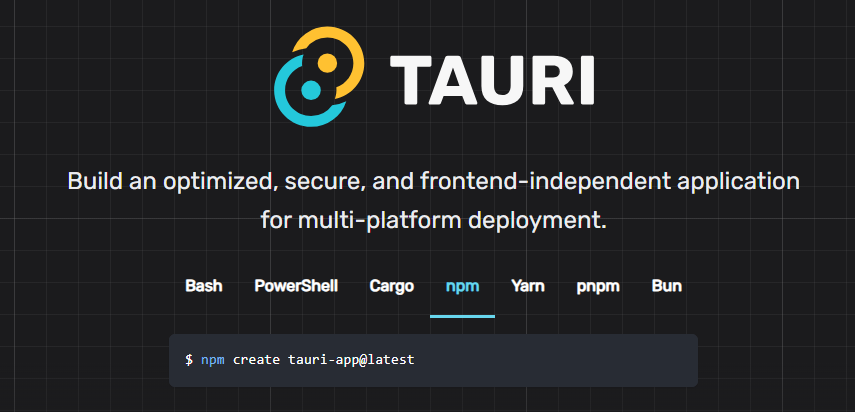 Tauri 是一個工具包,旨在幫助開發人員利用幾乎任何可用的前端框架為主要桌面平台建立應用程式。其核心是使用 Rust 開發的,而 CLI 利用 Node.js,提供了一種真正的多語言方法來開發和維護卓越的應用程式。 Tauri 應用程式中的使用者介面目前利用 Tao 作為 macOS、Windows、Linux、Android 和 iOS 上的視窗處理庫。 為了渲染您的應用程式,Tauri 使用 WRY,這是一個為系統 Web 視圖提供統一介面的程式庫。它在 macOS 和 iOS 上利用 WKWebView、在 Windows 上利用 WebView2、在 Linux 上利用 WebKitGTK 以及在 Android 上利用 Android System WebView。 您可以使用 Vite、HTML/CSS/JS、Next.js、Svelte 等等。 開始使用以下 npm 指令。 ``` npm create tauri-app@latest ``` 您可以閱讀[文件](https://tauri.app/v1/guides/getting-started/prerequisites)並查看 Tauri 提供的[功能清單](https://tauri.app/v1/guides/features/)。 您甚至可以使用 Tauri 建立自己的 CLI,這有多酷:) 團隊提供了[YouTube 影片](https://www.youtube.com/watch?v=UxTJeEbZX-0&t=2s),讓您了解更多關於 Tauri 的訊息。 他們在 GitHub 上擁有超過 75k 顆星星,並發布了 800 多個版本。 https://github.com/tauri-apps/tauri 金牛座之星 ⭐️ --- 25. [AutoGPT](https://github.com/Significant-Gravitas/AutoGPT) - 比 ChatGPT 更令人興奮。 ---------------------------------------------------------------------------------  AutoGPT 的核心在於其主要專案,即由大型語言模型 (LLM) 驅動的半自治代理,旨在為您執行任何任務。 AutoGPT 計畫由[四個主要部分](https://docs.agpt.co/#agent)組成: - 代理 – 也稱為“AutoGPT” - 基準 – 又稱 agbenchmark - 熔爐 - 前端 了解如何使用 OpenAI 金鑰[設定 AutoGPT](https://docs.agpt.co/autogpt/setup/) 。 您可以觀看[Fireship 發布的有關 AutoGPT 的 YouTube 影片](https://www.youtube.com/watch?v=_rGXIXyNqpk)。 https://www.youtube.com/watch?v=\_rGXIXyNqpk 您也可以觀看 Sentral Media 提供的[AutoGPT 教學](https://www.youtube.com/watch?v=FeIIaJUN-4A)。 您可以閱讀[文件](https://docs.agpt.co/)並查看[專案板](https://github.com/orgs/Significant-Gravitas/projects/1),以了解目前正在開發的內容。 即使您對 AI 不太了解,您也可以嘗試 AutoGPT 以了解如何節省時間並建立很酷的東西。 由於如此出色的用例和自動化功能,他們在 GitHub Repo 上擁有大約 159k+ 的星星。 https://github.com/Significant-Gravitas/AutoGPT 明星 AutoGPT ⭐️ --- 還沒結束。 現在,讓我們探索一些有價值的資源,這些資源將幫助您學習新概念並製作更好的人工智慧應用程式。 我們會保持簡單。不掛! - [人工智慧 (AI) 課程、書籍、視訊講座和論文](https://github.com/owainlewis/awesome-artificial-intelligence) - [機器學習/深度學習/AI + Web3 - 教程](https://github.com/TarrySingh/Artificial-Intelligence-Deep-Learning-Machine-Learning-Tutorials) - [ML 初學者](https://github.com/microsoft/ML-For-Beginners)- 12 週、26 節課程、52 個測驗,適合所有人的經典機器學習。 - [機器學習框架、函式庫和軟體](https://github.com/josephmisiti/awesome-machine-learning) - [如何製作人工智慧:逐步指南 - Revelo](https://www.revelo.com/blog/how-to-make-an-ai) 希望這將幫助您學習更多概念! --- 我希望您在列表中找到有用的東西。 我介紹了一些很棒的開源專案,它們可以將您的 AI 應用程式提升到一個新的水平。 人工智慧正在改變世界,最好與人工智慧保持朋友關係,而不是忽視它。 利用它來提高生產力,並抓住機會開發一些非凡的東西。 如果您想以最佳方式改進您的專案,有些開源專案比其他專案更有用,尤其是 Taipy 和 AutoGPT。 請發表評論,讓我們知道哪個專案最讓您感到驚訝。 祝你有美好的一天!直到下一次。 在 GitHub 上關注我。 https://github.com/Anmol-Baranwal 關注 Taipy 以了解更多此類內容。 https://dev.to/taipy --- 原文出處:https://dev.to/taipy/all-the-tools-i-need-to-build-a-perfect-ai-app-2oeh
通常,作為開發人員,我們會編寫類似類型的程式碼,陷入雖然舒適但有時感覺很平凡的模式。 然而,JavaScript 的世界是廣闊的,充滿了高級功能,當發現和使用這些功能時,可以將我們的開發工作變得更加令人興奮和充實。 在本指南中,我們將揭曉 25 個高級 JavaScript 功能,這些功能不僅能揭示這些隱藏的瑰寶,還能將您對 JavaScript 的掌握提升到前所未有的水平。 讓我們一起踏上這段發現之旅,將 JavaScript 的高級功能整合到我們的編碼庫中,以建立更有效率、更優雅、更強大的應用程式。是時候為我們的開發任務注入新的樂趣和創造力了。 1 — 迴圈和區塊語句的標籤 -------------- JavaScript 允許標記迴圈和區塊語句,從而可以使用`break`和`continue`進行精確控制。 ``` outerLoop: for (let i = 0; i < 5; i++) { innerLoop: for (let j = 0; j < 5; j++) { if (i === 2 && j === 2) break outerLoop; console.log(`i=${i}, j=${j}`); } } ``` 2 - 逗號運算符 --------- 逗號運算子允許按序列計算多個表達式,並傳回最後一個表達式的結果。 ``` let a = (1, 2, 3); // a = 3 ``` 3 — 字串格式化以外的標記範本文字 ------------------ 除了建立字串之外,標記範本還可用於 DSL(域特定語言)、清理使用者輸入或本地化。 ``` function htmlEscape(strings, ...values) { // Example implementation } ``` 4 — 區塊內的函數聲明 ------------ 儘管不推薦,但 JavaScript 允許在區塊內聲明函數,這可能會導致非嚴格模式下的不同行為。 ``` if (true) { function test() { return "Yes"; } } else { function test() { return "No"; } } test(); // Behavior varies depending on the environment ``` 5 — 無效運算符 --------- `void`運算子計算任何表達式,然後傳回未定義的值,這對於 JavaScript 的超連結很有用。 ``` void (0); // returns undefined ``` 6 — 用於快速數學的位元運算符 ---------------- 位運算符,例如`|`和`&` ,可以更快地執行一些數學運算,但會犧牲可讀性。 ``` let floor = 5.95 | 0; // Fast way to do Math.floor(5.95) ``` 7 — with 處理物件的語句 ---------------- `with`語句擴展了區塊的作用域鏈,讓您可以編寫更短的程式碼。但是,出於可讀性和效能方面的考慮,不建議這樣做。 ``` with(document.getElementById("myDiv").style) { background = "black"; color = "white"; } ``` [](https://skillshare.eqcm.net/QyLx6z) 與 Christian Heilmann 一起提高您的 JavaScript 技能 - 從今天開始編寫更乾淨、更快、更好的程式碼! 8 — 自動分號插入 (ASI) ---------------- JavaScript 嘗試修復缺少的分號,但依賴它可能會導致意外結果。 ``` let x = 1 let y = 2 [x, y] = [y, x] // Without proper semicolons, this could fail ``` 9 — 在屬性檢查操作員中 ------------- 檢查物件是否具有屬性,而無需直接存取其值。 ``` "toString" in {}; // true ``` 10——instanceof 與 typeof ----------------------- `instanceof`檢查原型鏈,而`typeof`傳回一個字串,指示未計算的操作數的類型。 ``` function Person() {} let person = new Person(); console.log(person instanceof Person); // true console.log(typeof person); // "object" ``` 11 — ES6 中的區塊級函數 ---------------- [ES6](https://www.webdevstory.com/mastering-es6-for-react/)允許函數具有區塊作用域,類似`let`和`const` 。 ``` { function test() { return "block scoped"; } } console.log(typeof test); // "function" in non-strict mode, "undefined" in strict mode ``` 12 — 偵錯器語句 ---------- 使用`debugger`語句暫停執行並開啟偵錯器。 ``` function problematicFunction() { debugger; // Execution pauses here if the developer tools are open } ``` **13 —**用於動態程式碼執行的`eval()` -------------------------- `eval`將字串作為 JavaScript 程式碼執行,但會帶來重大的安全性和效能影響。 ``` eval("let a = 1; console.log(a);"); // 1 ``` [](https://partners.inmotionhosting.com/k0EPWv) 利用 InMotion Hosting 的一系列計劃(從共享伺服器到 VPS 以及專用伺服器)為您的專案找到合適的託管解決方案。 **14 — 非標準**`__proto__`屬性 ------------------------- 雖然`__proto__`被廣泛支持用於設定物件的原型,但它是非標準的。請改用`Object.getPrototypeOf()`和`Object.setPrototypeOf()` 。 ``` let obj = {}; obj.__proto__ = Array.prototype; // Not recommended ``` 15 — document.write() 用於直接文件編輯 ------------------------------ `document.write()`直接寫入 HTML 文件,但使用它可能會產生負面影響,特別是同步載入外部腳本。 ``` document.write("<h1>Hello World!</h1>"); ``` 16 — 鍊式分配 --------- JavaScript 允許鍊式賦值,它可以在一個語句中將單一值指派給多個變數。 ``` let a, b, c; a = b = c = 5; // Sets all three variables to the value of 5 ``` 17 — 屬性存在的 in 運算符 ----------------- `in`運算子檢查屬性是否存在於物件中,而不存取屬性值。 ``` const car = { make: 'Toyota', model: 'Corolla' }; console.log('make' in car); // true ``` 18 — 物件屬性簡寫 ----------- 為物件指派屬性時,如果屬性名稱與變數名稱相同,則可以使用簡寫。 ``` const name = 'Alice'; const age = 25; const person = { name, age }; ``` 19 — 預設參數值和解構組合 --------------- 您可以將預設參數值與函數參數中的解構結合起來,以獲得更具可讀性和更靈活的函數定義。 ``` function createPerson({ name = 'Anonymous', age = 0 } = {}) { console.log(`Name: ${name}, Age: ${age}`); } createPerson({ name: 'Alice' }); // Name: Alice, Age: 0 createPerson(); // Name: Anonymous, Age: 0 ``` **20 — 使用**`Array.fill()`初始化陣列 ------------------------------ 使用`fill()`方法使用特定值快速初始化陣列。 ``` const initialArray = new Array(5).fill(0); // Creates an array [0, 0, 0, 0, 0] ``` [](https://amzn.to/3VhQFae) 利用可調式 LED 照明優化您的工作空間,提高工作效率和舒適度,為專注的工作會議創造理想的環境。 **21 —** `Array.includes()`用於存在檢查 --------------------------------- 使用`includes()`方法可以輕鬆檢查陣列中是否存在元素,這比使用`indexOf()`更具可讀性。 ``` const fruits = ['apple', 'banana', 'mango']; console.log(fruits.includes('banana')); // true ``` 22 — 解構別名 --------- `destructuring`物件時,可以使用別名將屬性指派給具有不同名稱的變數。 ``` const obj = { x: 1, y: 2 }; const { x: newX, y: newY } = obj; console.log(newX); // 1 ``` 23 — 預設值的空合併運算符 --------------- 使用`??`僅在處理`null`或`undefined`時提供預設值,而不是其他`falsy`值,例如 ``` const count = 0; console.log(count ?? 10); // 0, because count is not null or undefined ``` 24 — 動態函數名稱 ----------- 使用物件字面量中的計算屬性名稱建立具有動態名稱的函數。 ``` const dynamicName = 'func'; const obj = { [dynamicName]() { return 'Dynamic Function Name!'; } }; console.log(obj.func()); // "Dynamic Function Name!" ``` 25 — 私有類別字段 ----------- 使用 hash `#`前綴定義類別中的私有字段,該字段無法從類別外部存取。 ``` class Counter { #count = 0; increment() { this.#count++; } getCount() { return this.#count; } } ``` 簡單總結 --- 當我們結束 25 個 JavaScript 高階功能的探索時,JavaScript 的函式庫既龐大又強大。 我們深入研究的每個功能都為解決編碼挑戰開闢了新途徑,類似於在我們的工具包中加入創新工具。 這不僅增強了我們創造性、有效率地制定解決方案的能力,而且還強調了 JavaScript 的動態多功能性。 這些進階功能凸顯了持續學習在 Web 開發領域的關鍵角色。 接受這些細微差別並將它們整合到我們的日常編碼實踐中,使我們能夠提高我們的技能並為[網路技術的發展](https://www.simplilearn.com/what-is-web-1-0-web-2-0-and-web-3-0-with-their-difference-article)做出貢獻。 請記住,[掌握 JavaScript 的](https://www.webdevstory.com/javascript-essential-terms/)道路是一個持續的旅程,每一行程式碼都提供了發現非凡事物的機會。 讓我們不斷突破 JavaScript 所能實現的極限,保持好奇心並對未來的無限可能性保持開放。 ***支持我們的技術見解*** [](https://www.buymeacoffee.com/mmainulhasan) [](https://www.paypal.com/donate/?hosted_button_id=GDUQRAJZM3UR8) 注意:此頁面上的某些連結可能是附屬連結。如果您透過這些連結進行購買,我可能會賺取少量佣金,而您無需支付額外費用。感謝您的支持! --- 原文出處:https://dev.to/mmainulhasan/25-unnoticeable-features-of-javascript-15l1
歡迎使用我們精選的 JavaScript 技巧集合,它將幫助您優化程式碼、使其更具可讀性並節省您的時間。 讓我們深入研究 JavaScript 的功能和超越傳統的技巧,並發現這種強大的程式語言的全部潛力。 ### 1. 使用!!轉換為布林值 使用雙重否定快速將任何值轉換為布林值。 ``` let truthyValue = !!1; // true let falsyValue = !!0; // false ``` ### 2. 預設功能參數 設定函數參數的預設值以避免未定義的錯誤。 ``` function greet(name = "Guest") { return `Hello, ${name}!`; } ``` ### 3. 短 if-else 的三元運算符 `if-else`語句的簡寫。 ``` let price = 100; let message = price > 50 ? "Expensive" : "Cheap"; ``` ### 4. 動態字串的範本文字 使用模板文字在字串中嵌入表達式。 ``` let item = "coffee"; let price = 15; console.log(`One ${item} costs $${price}.`); ``` ### 5. 解構賦值 輕鬆從物件或陣列中提取屬性。 ``` let [x, y] = [1, 2]; let {name, age} = {name: "Alice", age: 30}; ``` ### 6. 用於陣列和物件克隆的擴展運算符 克隆陣列或物件而不引用原始陣列或物件。 ``` let originalArray = [1, 2, 3]; let clonedArray = [...originalArray]; ``` ### 7. 短路評估 使用邏輯運算子進行條件執行。 ``` let isValid = true; isValid && console.log("Valid!"); ``` ### 8. 可選連結 (?.) 如果引用為`nullish`則可以安全地存取巢狀物件屬性,而不會出現錯誤。 ``` let user = {name: "John", address: {city: "New York"}}; console.log(user?.address?.city); // "New York" ``` ### 9. 空合併運算子 (??) 使用`??`為`null`或`undefined`提供預設值。 ``` let username = null; console.log(username ?? "Guest"); // "Guest" ``` [](https://try.monday.com/9xf9ftaa4i2f) ### 10. 使用`map` 、 `filter`和`reduce`進行陣列操作 無需傳統循環即可處理陣列的優雅方法。 ``` // Map let numbers = [1, 2, 3, 4]; let doubled = numbers.map(x => x * 2); // Filter const evens = numbers.filter(x => x % 2 === 0); // Reduce const sum = numbers.reduce((accumulator, currentValue) => accumulator + currentValue, 0); ``` ### 11.標記模板文字 使用模板文字進行函數呼叫以進行自訂字串處理。 ``` function highlight(strings, ...values) { return strings.reduce((prev, current, i) => `${prev}${current}${values[i] || ''}`, ''); } let price = 10; console.log(highlight`The price is ${price} dollars.`); ``` ### 12.使用Object.entries()和Object.fromEntries() 將物件轉換為陣列並返回以方便操作。 ``` let person = {name: "Alice", age: 25}; let entries = Object.entries(person); let newPerson = Object.fromEntries(entries); ``` ### 13. 唯一元素的集合物件 使用 Set 儲存任何類型的唯一值。 ``` let numbers = [1, 1, 2, 3, 4, 4]; let uniqueNumbers = [...new Set(numbers)]; ``` ### 14. 物件中的動態屬性名稱 在物件文字表示法中使用方括號來建立動態屬性名稱。 ``` let dynamicKey = 'name'; let person = {[dynamicKey]: "Alice"}; ``` ### 15. 使用bind()進行函數柯里化 建立一個新函數,在呼叫時將其 this 關鍵字設定為提供的值。 ``` function multiply(a, b) { return a * b; } let double = multiply.bind(null, 2); console.log(double(5)); // 10 ``` ### 16. 使用 Array.from() 從類別陣列物件建立陣列 將類似陣列或可迭代的物件轉換為真正的陣列。 ``` let nodeList = document.querySelectorAll('div'); let nodeArray = Array.from(nodeList); ``` ### 17. 可迭代物件的 for...of 循環 直接迭代可迭代物件(包括陣列、映射、集合等)。 ``` for (let value of ['a', 'b', 'c']) { console.log(value); } ``` ### 18. 使用 Promise.all() 實作並發 Promise 同時執行多個 Promise 並等待所有的都解決。 ``` let promises = [fetch(url1), fetch(url2)]; Promise.all(promises) .then(responses => console.log('All done')); ``` ### 19. 函數參數的剩餘參數 將任意數量的參數捕獲到陣列中。 ``` function sum(...nums) { return nums.reduce((acc, current) => acc + current, 0); } ``` [](https://imp.i384100.net/c/3922519/1320997/14726) ### 20. 用於性能優化的記憶 儲存函數結果以避免冗餘處理。 ``` const memoize = (fn) => { const cache = {}; return (...args) => { let n = args[0]; // assuming single argument for simplicity if (n in cache) { console.log('Fetching from cache'); return cache[n]; } else { console.log('Calculating result'); let result = fn(n); cache[n] = result; return result; } }; }; ``` ### 21. 使用 ^ 交換值 使用 XOR 以位元運算子交換兩個變數的值,無需使用臨時變數。 ``` let a = 1, b = 2; a ^= b; b ^= a; a ^= b; // a = 2, b = 1 ``` ### 22. 使用 flat() 展平陣列 使用`flat()`方法輕鬆展平巢狀陣列,並將展平深度作為可選參數。 ``` let nestedArray = [1, [2, [3, [4]]]]; let flatArray = nestedArray.flat(Infinity); ``` ### 23. 用一元加法轉換為數字 使用一元加運算子快速將字串或其他值轉換為數字。 ``` let str = "123"; let num = +str; // 123 as a number ``` ### 24. HTML 片段的模板字串 使用模板字串建立 HTML 片段,使動態 HTML 生成更加清晰。 ``` let items = ['apple', 'orange', 'banana']; let html = `<ul>${items.map(item => `<li>${item}</li>`).join('')}</ul>`; ``` ### 25. 使用 Object.assign() 合併物件 將多個來源物件合併到一個目標物件中,有效地組合它們的屬性。 ``` let obj1 = { a: 1 }, obj2 = { b: 2 }; let merged = Object.assign({}, obj1, obj2); ``` [](https://amzn.to/3UXGIyx) 使用符合人體工學的滑鼠優化您的編程設置,專為舒適和長時間的編碼會話而定制。 ### 26. 預設值短路 處理潛在的未定義或空變數時,使用邏輯運算子指派預設值。 ``` let options = userOptions || defaultOptions; ``` ### 27. 使用括號表示法動態存取物件屬性 使用括號表示法動態存取物件的屬性,當屬性名稱儲存在變數中時非常有用。 ``` let property = "name"; let value = person[property]; // Equivalent to person.name ``` ### 28. 使用 Array.includes() 進行存在檢查 使用includes() 檢查陣列是否包含某個值,它是indexOf 的更清晰的替代方法。 ``` if (myArray.includes("value")) { // Do something } ``` ### 29. Function.prototype.bind() 的強大功能 將函數綁定到上下文(此值)並部分套用參數,以建立更多可重複使用和模組化的程式碼。 ``` const greet = function(greeting, punctuation) { return `${greeting}, ${this.name}${punctuation}`; }; const greetJohn = greet.bind({name: 'John'}, 'Hello'); console.log(greetJohn('!')); // "Hello, John!" ``` ### 30.防止物件修改 使用`Object.freeze()`防止物件進行修改,使其不可變。對於更深層的不變性,請考慮更徹底地強制不變性的函式庫。 ``` let obj = { name: "Immutable" }; Object.freeze(obj); obj.name = "Mutable"; // Fails silently in non-strict mode ``` 我希望這些 JavaScript 技巧為您提供如何進行[JavaScript 程式設計的](https://www.w3schools.com/js/)新視角。 從利用模板文字的簡潔功能到掌握`map` 、 `filter`和`reduce`的效率,這些 JavaScript 技巧將豐富您的開發工作流程並激發您的下一個專案。 讓這些 JavaScript 技巧不僅可以完善您目前的專案,還可以在您的[程式設計之旅](https://www.webdevstory.com/programming-roadmap/)中激發未來創新的靈感。 ***支持我們的技術見解*** [](https://www.buymeacoffee.com/mmainulhasan) [](https://www.paypal.com/donate/?hosted_button_id=GDUQRAJZM3UR8) 注意:此頁面上的某些連結可能是附屬連結。如果您透過這些連結進行購買,我可能會賺取少量佣金,而無需您支付額外費用。感謝您的支持! --- 原文出處:https://dev.to/mmainulhasan/30-javascript-tricky-hacks-gfc
目錄 == - [介紹](#introduction) - [技術堆疊](#tech-stack) - [特徵](#features) - [設定 Next.js 應用程式](#step-1-setting-up-the-nextjs-application) - [安裝所需的套件](#step-2-installing-required-packages) - [設定 Redis 連接](#step-3-setting-up-redis-connection) - [配置 BullMQ 佇列](#step-4-configuring-bullmq-queue) - [Next.js 儀器設置](#step-5-nextjs-instrumentation-setup) - [設定 Bright Data 的抓取瀏覽器](#step-6-setting-up-bright-datas-scraping-browser) - [Bright Data 的抓取瀏覽器是什麼?](#what-is-bright-datas-scraping-browser) - [設定 Bright Data 抓取瀏覽器的步驟](#steps-to-set-up-bright-datas-scraping-browser) - [使用 Puppeteer 實作抓取邏輯](#implementing-the-scraping-logic-with-puppeteer) - [航班搜尋功能](#flight-search-feature) - [顯示航班搜尋結果](#displaying-flight-search-results) - [探索完整的指南和程式碼庫](#discover-the-complete-guide-and-codebase) - [在 YouTube 上觀看詳細說明](#watch-the-detailed-explanation-on-youtube) - [在 GitHub 上探索完整程式碼](#explore-the-full-code-on-github) - [結論](#conclusion) 介紹 == 在不斷發展的 Web 開發領域,有效收集、處理和顯示外部來源資料的能力變得越來越有價值。無論是市場研究、競爭分析或客戶洞察,網路抓取在釋放網路資料的巨大潛力方面都發揮著至關重要的作用。 這篇部落格文章介紹了建立強大的 Next.js 應用程式的綜合指南,該應用程式旨在從領先的旅行搜尋引擎之一 Kayak 抓取航班資料。透過利用 Next.js 的強大功能以及 BullMQ、Redis 和 Puppeteer 等現代技術。 技術堆疊 ==== - [Next.js](https://nextjs.org/docs) - [順風CSS](https://tailwindcss.com/docs) - [下一個介面](https://nextui.org/docs) - [健康)狀況](https://zustand.surge.sh/) - [條紋](https://stripe.com/docs) - [Bright Data 的抓取瀏覽器](https://brdta.com/kishansheth21) - [打字稿](https://www.typescriptlang.org/docs) - [雷迪斯](https://redis.io/documentation) - [BullMQ](https://docs.bullmq.io/) - [傀儡師](https://pptr.dev/) - [智威湯遜](https://jwt.io/introduction) - [阿克西奧斯](https://axios-http.com/docs/intro) - [PostgreSQL](https://www.postgresql.org/docs) - [棱鏡](https://www.prisma.io/docs) 特徵 == - 🚀 帶有 Tailwind CSS 的 Next.js 14 應用程式目錄 - 體驗由最新 Next.js 14 提供支援的時尚現代的 UI,並使用 Tailwind CSS 進行設計,以實現完美的外觀和感覺。 - 🔗 API 路由和伺服器操作 - 深入研究與 Next.js 14 的 API 路由和伺服器操作的無縫後端集成,確保高效的資料處理和伺服器端邏輯執行。 - 🕷 使用 Puppeteer Redis 和 BullMQ 進行抓取 - 利用 Puppeteer 的強大功能進行進階 Web 抓取,並使用 Redis 和 BullMQ 管理佇列和作業以實現強大的後端操作。 - 🔑 用於身份驗證和授權的 JWT 令牌 - 使用 JWT 令牌保護您的應用程式,為整個平台提供可靠的身份驗證和授權方法。 - 💳 支付網關 Stripe - 整合 Stripe 進行無縫支付處理,為預訂旅行、航班和飯店提供安全、輕鬆的交易。 - ✈️ 使用 Stripe 支付網關預訂旅行、航班和飯店 - 使用我們的 Stripe 支援的支付系統,讓您的旅遊預訂體驗變得輕鬆。 - 📊 從多個網站抓取即時資料 - 從多個來源抓取即時資料,保持領先,讓您的應用程式更新最新資訊。 - 💾 使用 Prisma 將抓取的資料儲存在 PostgreSQL 中 - 利用 PostgreSQL 和 Prisma 高效儲存和管理抓取的資料,確保可靠性和速度。 - 🔄 用於狀態管理的 Zustand - 透過 Zustand 簡化狀態邏輯並增強效能,在您的應用程式中享受流暢且可管理的狀態管理。 - 😈 該應用程式的最佳功能 - 使用 Bright Data 的抓取瀏覽器抓取不可抓取的資料。  Bright Data的抓取瀏覽器為我們提供了自動驗證碼解決功能,可以幫助我們抓取不可抓取的資料。 第 1 步:設定 Next.js 應用程式 --------------------- 1. **建立 Next.js 應用程式**:首先建立一個新的 Next.js 應用程式(如果您還沒有)。您可以透過在終端機中執行以下命令來完成此操作: ``` npx create-next-app@latest booking-app ``` 2. **導航到您的應用程式目錄**:變更為您新建立的應用程式目錄: ``` cd booking-app ``` 步驟2:安裝所需的軟體包 ------------ 您需要安裝多個軟體包,包括 Redis、BullMQ 和 Puppeteer Core。執行以下命令來安裝它們: ``` npm install ioredis bullmq puppeteer-core ``` - `ioredis`是 Node.js 的強大 Redis 用戶端,支援與 Redis 進行通訊。 - `bullmq`以 Redis 作為後端來管理作業和訊息佇列。 - `puppeteer-core`可讓您控制外部瀏覽器以進行抓取。 步驟3:設定Redis連接 ------------- 在適當的目錄(例如`lib/` )中建立一個檔案(例如`redis.js` )來配置 Redis 連線: ``` // lib/redis.js import Redis from 'ioredis'; // Use REDIS_URL from environment or fallback to localhost const REDIS_URL = process.env.REDIS_URL || 'redis://localhost:6379'; const connection = new Redis(REDIS_URL); export { connection }; ``` 步驟4:配置BullMQ佇列 -------------- 透過在 Redis 配置所在的相同目錄中建立另一個檔案(例如, `queue.js` )來設定 BullMQ 佇列: ``` // lib/queue.js import { Queue } from 'bullmq'; import { connection } from './redis'; export const importQueue = new Queue('importQueue', { connection, defaultJobOptions: { attempts: 2, backoff: { type: 'exponential', delay: 5000, }, }, }); ``` 第 5 步:Next.js 儀器設置 ------------------ Next.js 允許偵測,可以在 Next.js 配置中啟用。您還需要建立一個用於作業處理的工作文件。 1.**在 Next.js 中啟用 Instrumentation** :將以下內容新增至`next.config.js`以啟用 Instrumentation: ``` // next.config.js module.exports = { experimental: { instrumentationHook: true, }, }; ``` 2.**建立用於作業處理的 Worker** :在您的應用程式中,建立一個檔案 ( `instrumentation.js` ) 來處理作業處理。該工作人員將使用 Puppeteer 來執行抓取任務: ``` // instrumentation.js export const register = async () => { if (process.env.NEXT_RUNTIME === 'nodejs') { const { Worker } = await import('bullmq'); const puppeteer = await import('puppeteer-core'); const { connection } = await import('./lib/redis'); const { importQueue } = await import('./lib/queue'); new Worker('importQueue', async (job) => { // Job processing logic with Puppeteer goes here }, { connection, concurrency: 10, removeOnComplete: { count: 1000 }, removeOnFail: { count: 5000 }, }); } }; ``` 第 6 步:設定 Bright Data 的抓取瀏覽器 --------------------------- 在設定 Bright 資料抓取瀏覽器之前,我們先來談談什麼是抓取瀏覽器。 ### Bright Data 的抓取瀏覽器是什麼? Bright Data 的抓取瀏覽器是一款用於自動網頁抓取的尖端工具,旨在與 Puppeteer、Playwright 和 Selenium 無縫整合。它提供了一套網站解鎖功能,包括代理輪換、驗證碼解決等,以提高抓取效率。它非常適合需要互動的複雜網頁抓取,透過在 Bright Data 基礎架構上託管無限的瀏覽器會話來實現可擴展性。如欲了解更多詳情,請造訪[光明資料](https://brdta.com/kishansheth21)。 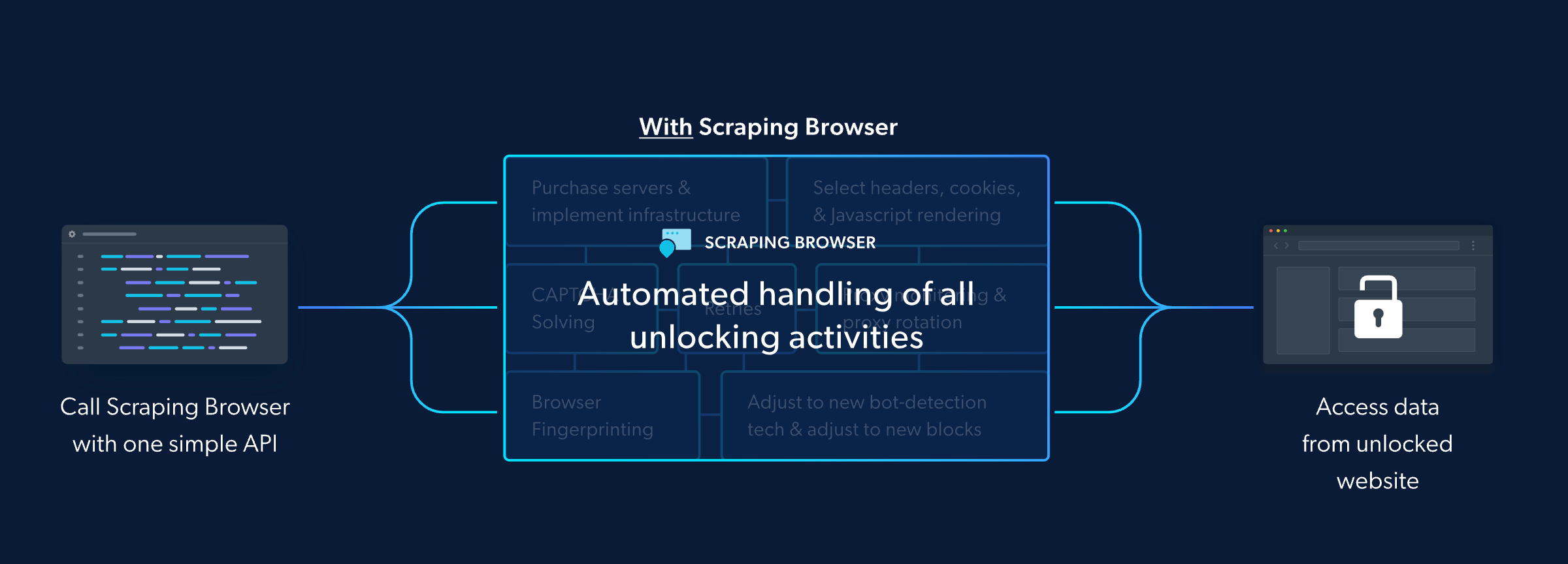 <a id="steps-to-set-up-bright-datas-scraping-browser"></a> #### 第 1 步:導覽至 Bright Data 網站 首先造訪[Brightdata.com](https://brdta.com/kishansheth21) 。這是您存取 Bright Data 提供的豐富網頁抓取資源和工具的入口。  #### 第 2 步:建立帳戶 造訪 Bright Data 網站後,註冊並建立一個新帳戶。系統將提示您輸入基本資訊以啟動並執行您的帳戶。 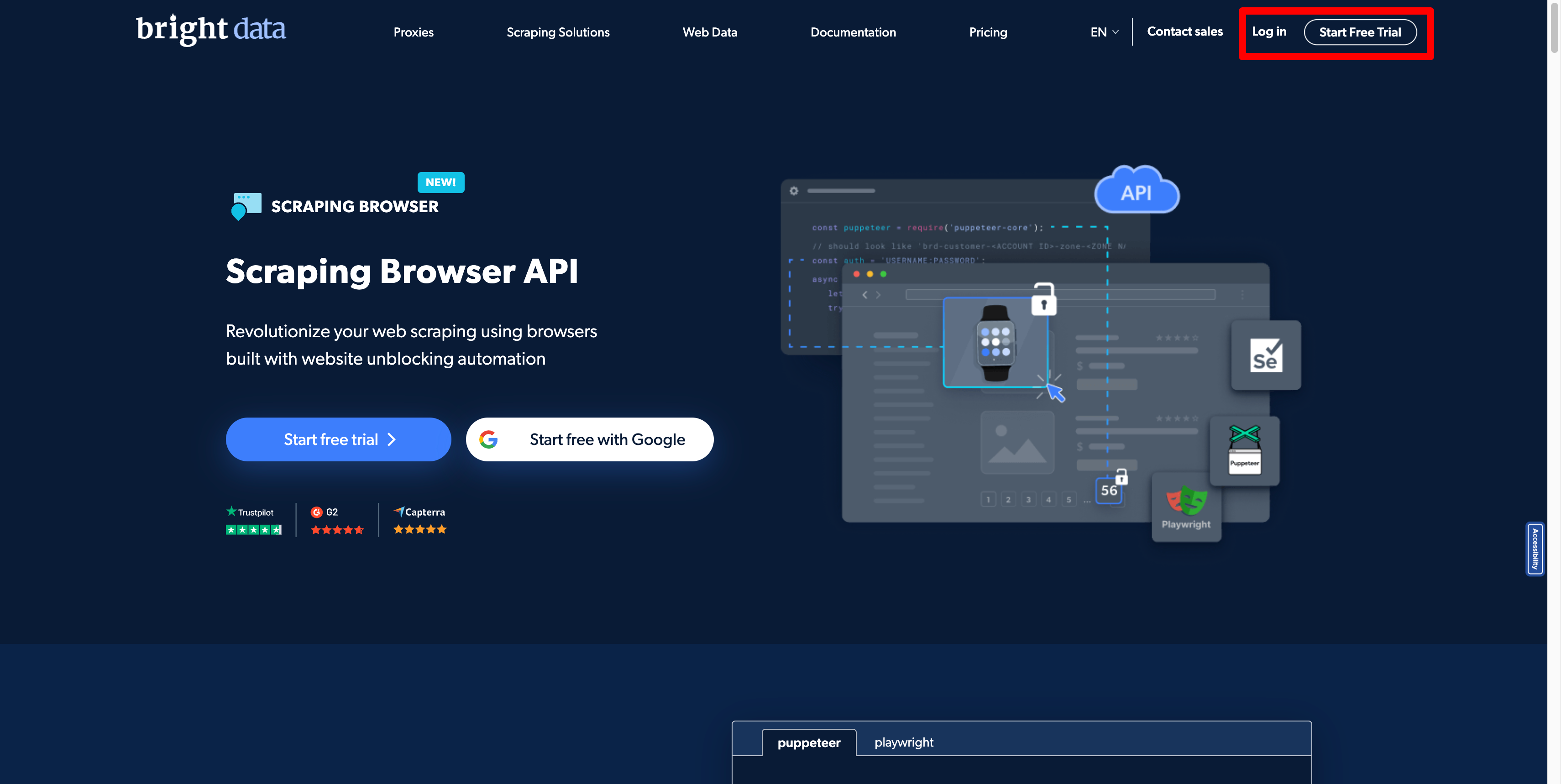 #### 第 3 步:選擇您的產品 在產品選擇頁面上,尋找代理商和抓取基礎設施產品。本產品專為滿足您的網路抓取需求而設計,提供強大的資料擷取工具和功能。  #### 第 4 步:新增代理 在「代理程式和抓取基礎設施」頁面中,您會找到一個「新增按鈕」。點擊此按鈕開始將新的抓取瀏覽器新增到您的工具包的過程。  #### 第五步:選擇抓取瀏覽器 將出現一個下拉列表,您應該從中選擇抓取瀏覽器選項。這告訴 Bright Data 您打算設定一個新的抓取瀏覽器環境。  #### 第 6 步:為您的抓取瀏覽器命名 為您的新抓取瀏覽器指定一個唯一的名稱。這有助於稍後辨識和管理它,特別是如果您計劃對不同的抓取專案使用多個瀏覽器。 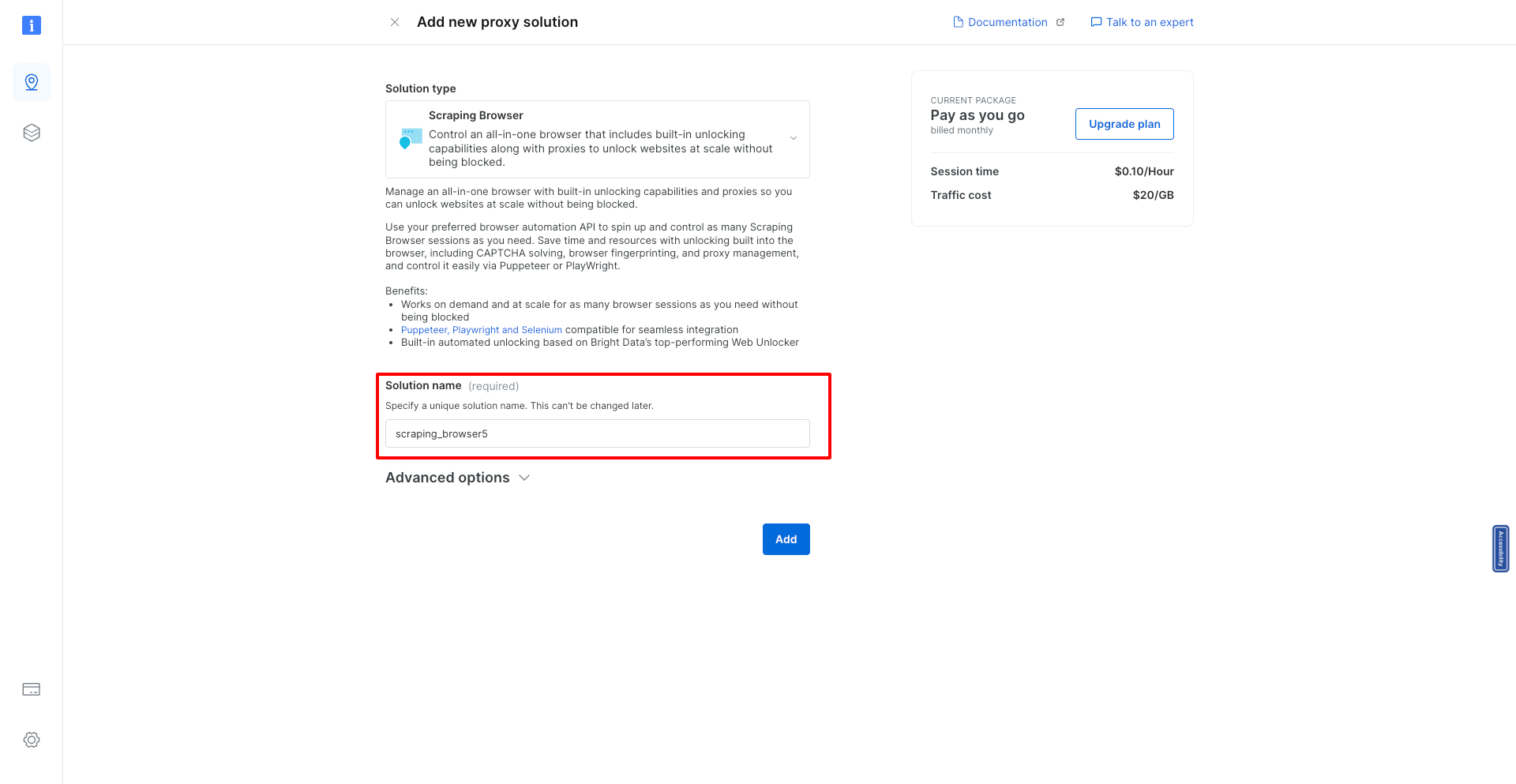 #### 步驟7:新增瀏覽器 命名您的瀏覽器後,按一下「新增」按鈕。此操作完成了新的抓取瀏覽器的建立。 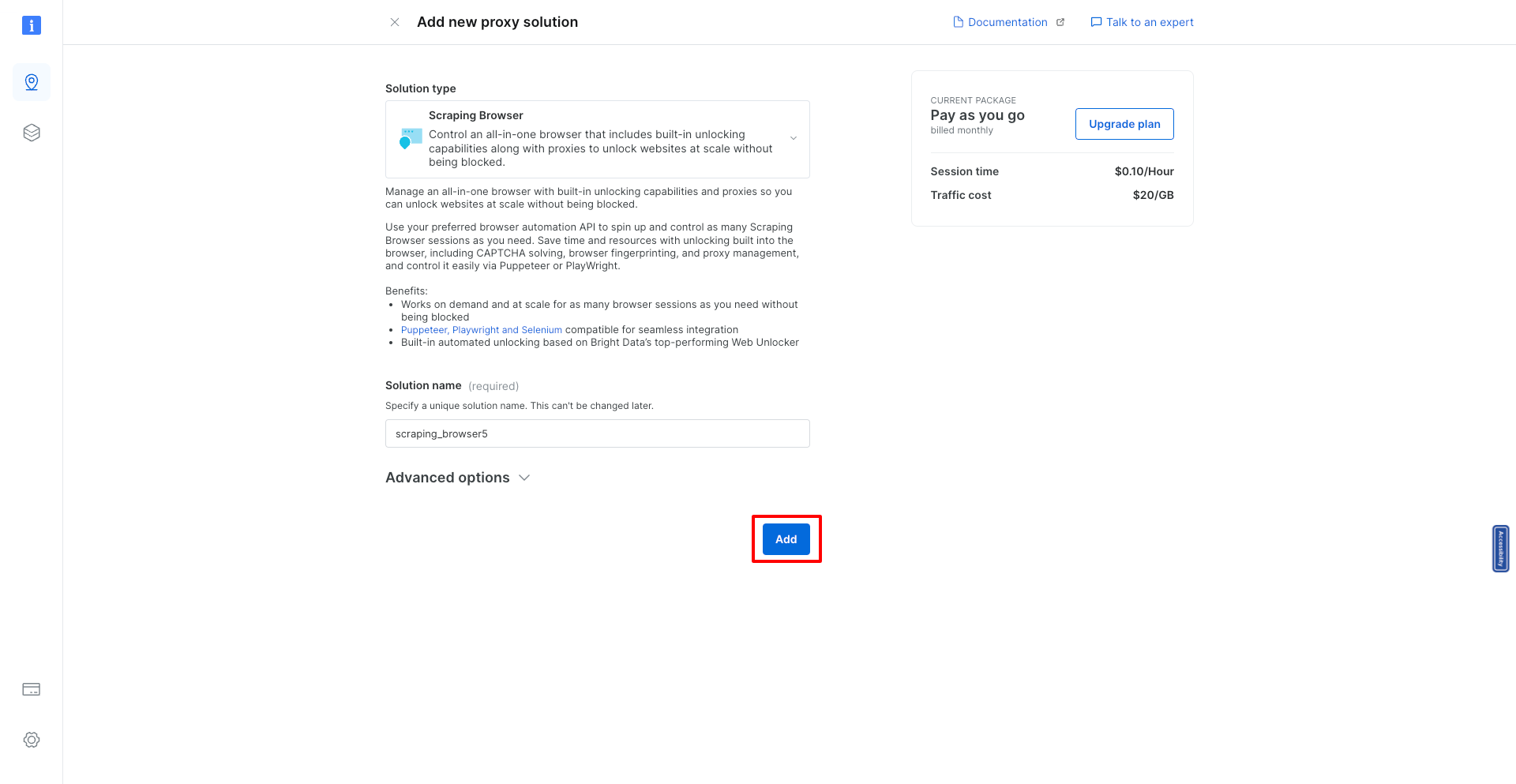 #### 第 8 步:查看您的抓取瀏覽器詳細訊息 新增抓取瀏覽器後,您將被導向到一個頁面,您可以在其中查看新建立的抓取瀏覽器的所有詳細資訊。這些資訊對於整合和使用至關重要。 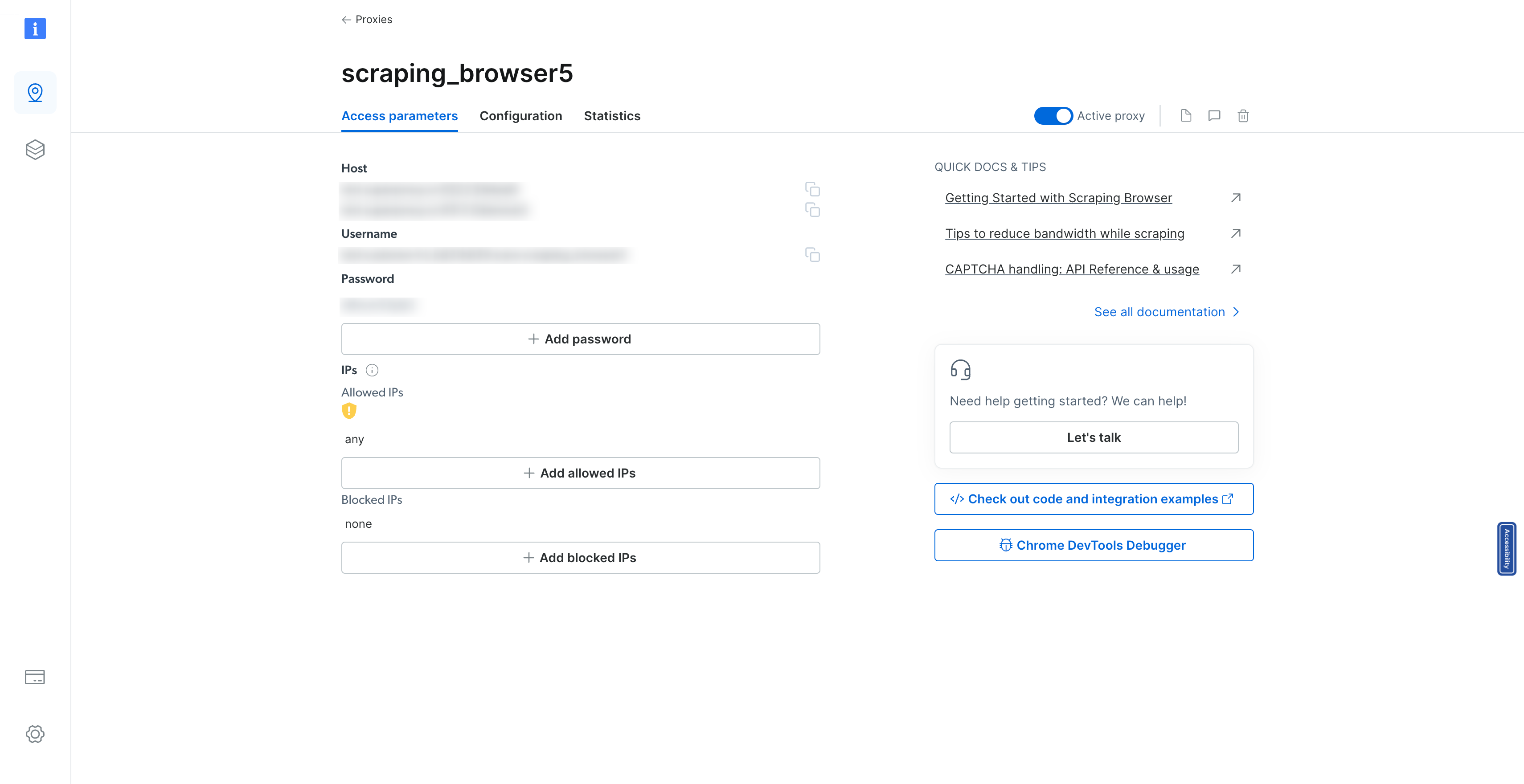 #### 第 9 步:存取程式碼和整合範例 尋找“查看程式碼和整合範例”按鈕。點擊此按鈕將為您提供如何跨多種程式語言和程式庫整合和使用抓取瀏覽器的全面視圖。對於希望自訂抓取設定的開發人員來說,此資源非常寶貴。 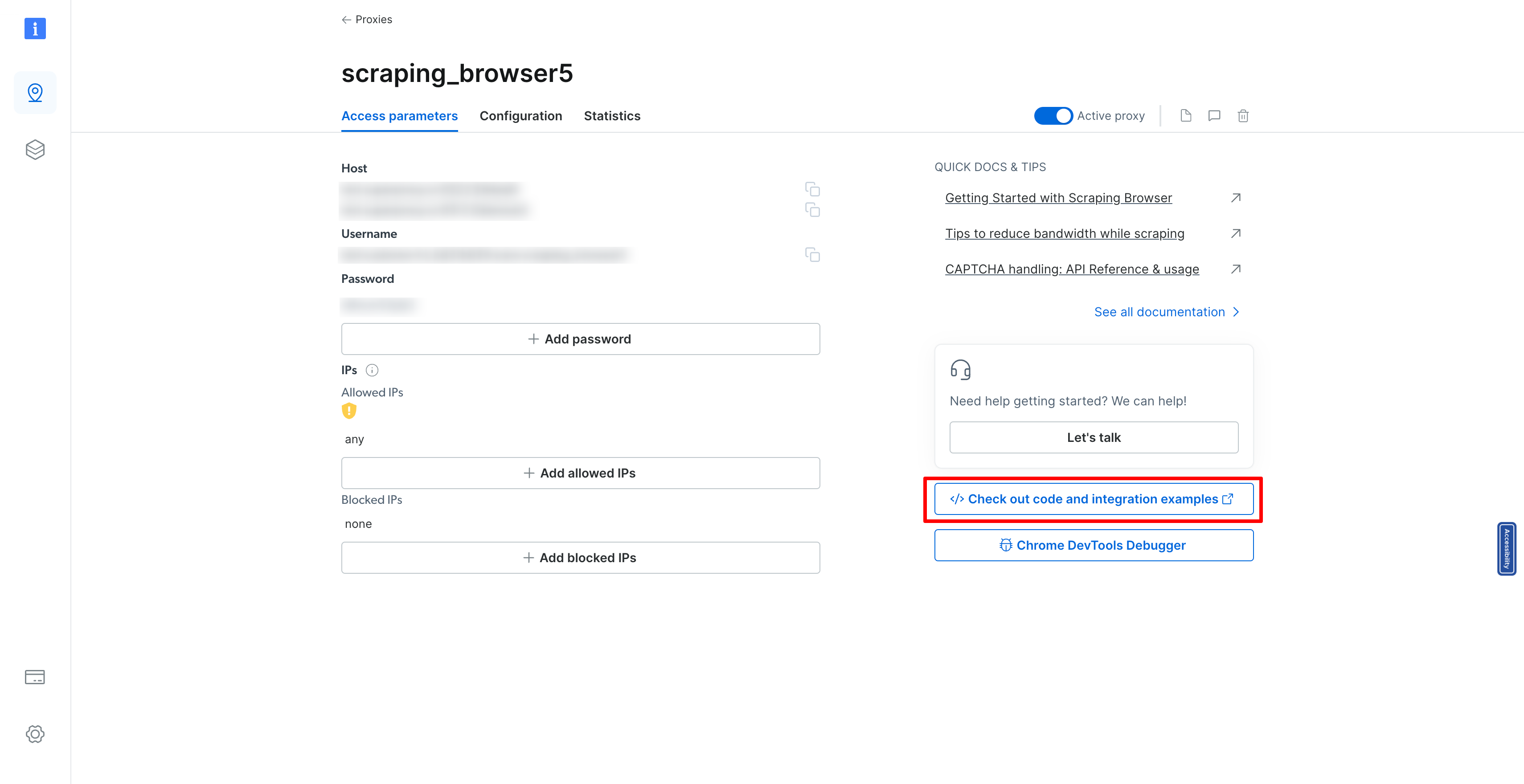 #### 第 10 步:整合您的抓取瀏覽器 最後,複製 SRS\_WS\_ENDPOINT 變數。這是一條關鍵訊息,您需要將其整合到原始程式碼中,以便您的應用程式能夠與您剛剛設定的抓取瀏覽器進行通訊。 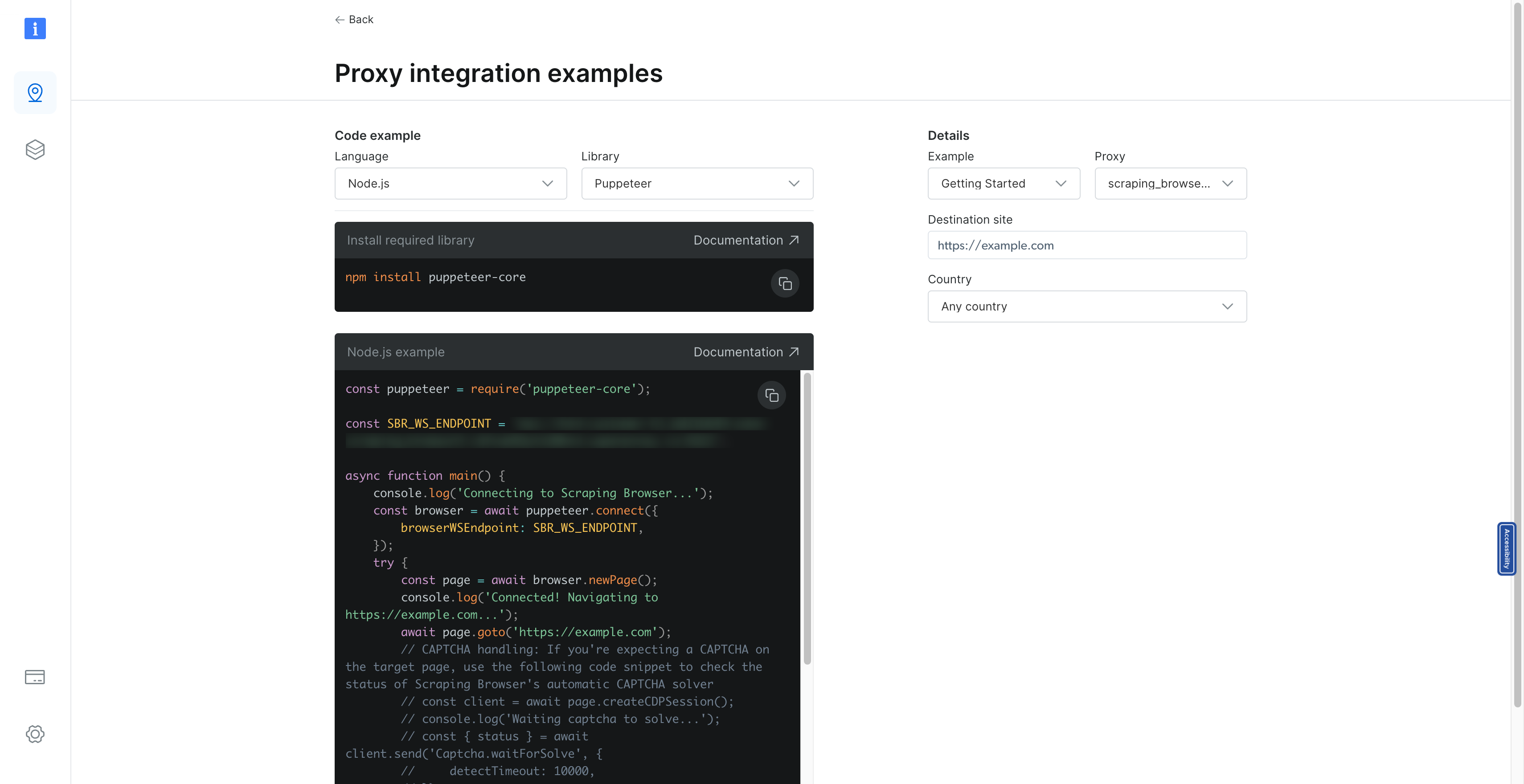 透過遵循這些詳細步驟,您已在 Bright Data 平台中成功建立了一個抓取瀏覽器,準備好處理您的網頁抓取任務。請記住,Bright Data 提供廣泛的文件和支持,幫助您最大限度地提高抓取專案的效率和效果。無論您是在收集市場情報、進行研究還是監控競爭格局,新設定的抓取瀏覽器都是資料收集庫中的強大工具。 ### 第 7 步:使用 Puppeteer 實作抓取邏輯 從我們上次設定用於抓取航班資料的 Next.js 應用程式的地方開始,下一個關鍵步驟是實現實際的抓取邏輯。此過程涉及利用 Puppeteer 連接到瀏覽器實例、導航到目標 URL(在我們的範例中為 Kayak)並抓取必要的飛行資料。提供的程式碼片段概述了實現此目標的複雜方法,與我們先前建立的 BullMQ 工作設定無縫整合。讓我們分解這個抓取邏輯的元件,並了解它如何適合我們的應用程式。 #### 建立與瀏覽器的連接 我們抓取過程的第一步是透過 Puppeteer 建立與瀏覽器的連線。這是透過利用`puppeteer.connect`方法來完成的,該方法使用 WebSocket 端點 ( `SBR_WS_ENDPOINT` ) 連接到現有的瀏覽器實例。此環境變數應設定為您正在使用的抓取瀏覽器服務的 WebSocket URL,例如 Bright Data: ``` const browser = await puppeteer.connect({ browserWSEndpoint: SBR_WS_ENDPOINT, }); ``` #### 開啟新頁面並導航到目標 URL 連線後,我們在瀏覽器中建立一個新頁面並導航到作業資料中指定的目標 URL。此 URL 是我們打算從中抓取航班資料的特定 Kayak 搜尋結果頁面: ``` const page = await browser.newPage(); await page.goto(job.data.url); ``` #### 抓取航班資料 我們邏輯的核心在於從頁面中抓取航班資料。我們透過使用`page.evaluate`來實現這一點,這是一種 Puppeteer 方法,允許我們在瀏覽器上下文中執行腳本。在此腳本中,我們等待必要的元素加載,然後繼續收集航班資訊: - **Flight Selector** :我們以`.nrc6-wrapper`類別為目標元素,其中包含航班詳細資訊。 - **資料擷取**:對於每個航班元素,我們提取詳細訊息,例如航空公司徽標、出發和到達時間、航班持續時間、航空公司名稱和價格。出發和到達時間經過清理,以刪除最後不必要的數值,確保我們準確地捕捉時間。 - **價格處理**:價格在刪除所有非數字字元後提取為整數,確保其可用於數值運算或比較。 擷取的資料被建構成飛行物件陣列,每個物件都包含上述詳細資訊: ``` const scrappedFlights = await page.evaluate(async () => { // Data extraction logic const flights = []; // Process each flight element // ... return flights; }); ``` #### 錯誤處理和清理 我們的抓取邏輯被包裝在一個 try-catch 區塊中,以在抓取過程中優雅地處理任何潛在的錯誤。無論結果如何,我們都會確保瀏覽器在finally區塊中正確關閉,從而保持資源效率並防止潛在的記憶體洩漏: ``` try { // Scraping logic } catch (error) { console.log({ error }); } finally { await browser.close(); console.log("Browser closed successfully."); } ``` #### 整個程式碼 ``` const SBR_WS_ENDPOINT = process.env.SBR_WS_ENDPOINT; export const register = async () => { if (process.env.NEXT_RUNTIME === "nodejs") { const { Worker } = await import("bullmq"); const puppeteer = await import("puppeteer"); const { connection } = await import("./lib/redis"); const { importQueue } = await import("./lib/queue"); new Worker( "importQueue", async (job) => { const browser = await puppeteer.connect({ browserWSEndpoint: SBR_WS_ENDPOINT, }); try { const page = await browser.newPage(); console.log("in flight scraping"); console.log("Connected! Navigating to " + job.data.url); await page.goto(job.data.url); console.log("Navigated! Scraping page content..."); const scrappedFlights = await page.evaluate(async () => { await new Promise((resolve) => setTimeout(resolve, 5000)); const flights = []; const flightSelectors = document.querySelectorAll(".nrc6-wrapper"); flightSelectors.forEach((flightElement) => { const airlineLogo = flightElement.querySelector("img")?.src || ""; const [rawDepartureTime, rawArrivalTime] = ( flightElement.querySelector(".vmXl")?.innerText || "" ).split(" – "); // Function to extract time and remove numeric values at the end const extractTime = (rawTime: string): string => { const timeWithoutNumbers = rawTime .replace(/[0-9+\s]+$/, "") .trim(); return timeWithoutNumbers; }; const departureTime = extractTime(rawDepartureTime); const arrivalTime = extractTime(rawArrivalTime); const flightDuration = ( flightElement.querySelector(".xdW8")?.children[0]?.innerText || "" ).trim(); const airlineName = ( flightElement.querySelector(".VY2U")?.children[1]?.innerText || "" ).trim(); // Extract price const price = parseInt( ( flightElement.querySelector(".f8F1-price-text")?.innerText || "" ) .replace(/[^\d]/g, "") .trim(), 10 ); flights.push({ airlineLogo, departureTime, arrivalTime, flightDuration, airlineName, price, }); }); return flights; }); } catch (error) { console.log({ error }); } finally { await browser.close(); console.log("Browser closed successfully."); } }, { connection, concurrency: 10, removeOnComplete: { count: 1000 }, removeOnFail: { count: 5000 }, } ); } }; ``` ### 步驟8:航班搜尋功能 基於我們的航班資料抓取功能,讓我們將全面的航班搜尋功能整合到我們的 Next.js 應用程式中。此功能將為使用者提供一個動態介面,透過指定出發地、目的地和日期來搜尋航班。利用強大的 Next.js 框架以及現代 UI 庫和狀態管理,我們建立了引人入勝且響應迅速的航班搜尋體驗。 #### 航班搜尋功能的關鍵組成部分 1. **動態城市選擇**:此功能包括來源和目的地輸入的自動完成功能,由預先定義的城市機場程式碼清單提供支援。當使用者輸入時,應用程式會過濾並顯示匹配的城市,透過更輕鬆地尋找和選擇機場來增強用戶體驗。 2. **日期選擇**:使用者可以透過日期輸入選擇預期的航班日期,為規劃旅行提供彈性。 3. **抓取狀態監控**:啟動抓取作業後,應用程式透過定期 API 呼叫來監控作業的狀態。這種非同步檢查允許應用程式使用抓取過程的狀態更新 UI,確保使用者了解進度和結果。 #### 航班搜尋元件的完整程式碼 ``` "use client"; import { useAppStore } from "@/store"; import { USER_API_ROUTES } from "@/utils/api-routes"; import { cityAirportCode } from "@/utils/city-airport-codes"; import { Button, Input, Listbox, ListboxItem } from "@nextui-org/react"; import axios from "axios"; import Image from "next/image"; import { useRouter } from "next/navigation"; import React, { useEffect, useRef, useState } from "react"; import { FaCalendarAlt, FaSearch } from "react-icons/fa"; const SearchFlights = () => { const router = useRouter(); const { setScraping, setScrapingType, setScrappedFlights } = useAppStore(); const [loadingJobId, setLoadingJobId] = useState<number | undefined>(undefined); const [source, setSource] = useState(""); const [sourceOptions, setSourceOptions] = useState< { city: string; code: string; }[] >([]); const [destination, setDestination] = useState(""); const [destinationOptions, setDestinationOptions] = useState< { city: string; code: string; }[] >([]); const [flightDate, setFlightDate] = useState(() => { const today = new Date(); return today.toISOString().split("T")[0]; }); const handleSourceChange = (query: string) => { const matchingCities = Object.entries(cityAirportCode) .filter(([, city]) => city.toLowerCase().includes(query.toLowerCase())) .map(([code, city]) => ({ code, city })) .splice(0, 5); setSourceOptions(matchingCities); }; const destinationChange = (query: string) => { const matchingCities = Object.entries(cityAirportCode) .filter(([, city]) => city.toLowerCase().includes(query.toLowerCase())) .map(([code, city]) => ({ code, city })) .splice(0, 5); setDestinationOptions(matchingCities); }; const startScraping = async () => { if (source && destination && flightDate) { const data = await axios.get(`${USER_API_ROUTES.FLIGHT_SCRAPE}?source=${source}&destination=${destination}&date=${flightDate}`); if (data.data.id) { setLoadingJobId(data.data.id); setScraping(true); setScrapingType("flight"); } } }; useEffect(() => { if (loadingJobId) { const checkIfJobCompleted = async () => { try { const response = await axios.get(`${USER_API_ROUTES.FLIGHT_SCRAPE_STATUS}?jobId=${loadingJobId}`); if (response.data.status) { set ScrappedFlights(response.data.flights); clearInterval(jobIntervalRef.current); setScraping(false); setScrapingType(undefined); router.push(`/flights?data=${flightDate}`); } } catch (error) { console.log(error); } }; jobIntervalRef.current = setInterval(checkIfJobCompleted, 3000); } return () => clearInterval(jobIntervalRef.current); }, [loadingJobId]); return ( <div className="h-[90vh] flex items-center justify-center"> <div className="absolute left-0 top-0 h-[100vh] w-[100vw] max-w-[100vw] overflow-hidden overflow-x-hidden"> <Image src="/flight-search.png" fill alt="Search" /> </div> <div className="absolute h-[50vh] w-[60vw] flex flex-col gap-5"> {/* UI and functionality for flight search */} </div> </div> ); }; export default SearchFlights; ``` ### 步驟9:航班搜尋頁面UI  ### 顯示航班搜尋結果 成功抓取飛行資料後,下一個關鍵步驟是以使用者友善的方式將這些結果呈現給使用者。 Next.js 應用程式中的 Flights 元件就是為此目的而設計的。 ``` "use client"; import { useAppStore } from "@/store"; import { USER_API_ROUTES } from "@/utils/api-routes"; import { Button } from "@nextui-org/react"; import axios from "axios"; import Image from "next/image"; import { useRouter, useSearchParams } from "next/navigation"; import React from "react"; import { FaChevronLeft } from "react-icons/fa"; import { MdOutlineFlight } from "react-icons/md"; const Flights = () => { const router = useRouter(); const searchParams = useSearchParams(); const date = searchParams.get("date"); const { scrappedFlights, userInfo } = useAppStore(); const getRandomNumber = () => Math.floor(Math.random() * 41); const bookFLight = async (flightId: number) => {}; return ( <div className="m-10 px-[20vw] min-h-[80vh]"> <Button className="my-5" variant="shadow" color="primary" size="lg" onClick={() => router.push("/search-flights")} > <FaChevronLeft /> Go Back </Button> <div className="flex-col flex gap-5"> {scrappedFlights.length === 0 && ( <div className="flex items-center justify-center py-5 px-10 mt-10 rounded-lg text-red-500 bg-red-100 font-medium"> No Flights found. </div> )} {scrappedFlights.map((flight: any) => { const seatsLeft = getRandomNumber(); return ( <div key={flight.id} className="grid grid-cols-12 border bg-gray-200 rounded-xl font-medium drop-shadow-md" > <div className="col-span-9 bg-white rounded-l-xl p-10 flex flex-col gap-5"> <div className="grid grid-cols-4 gap-4"> <div className="flex flex-col gap-3 font-medium"> <div> <div className="relative w-20 h-16"> <Image src={flight.logo} alt="airline name" fill /> </div> </div> <div>{flight.name}</div> </div> <div className="col-span-3 flex justify-between"> <div className="flex flex-col gap-2"> <div className="text-blue-600">From</div> <div> <span className="text-3xl"> <strong>{flight.departureTime}</strong> </span> </div> <div>{flight.from}</div> </div> <div className="flex flex-col items-center justify-center gap-2"> <div className="bg-violet-100 w-max p-3 text-4xl text-blue-600 rounded-full"> <MdOutlineFlight /> </div> <div> <span className="text-lg"> <strong>Non-stop</strong> </span> </div> <div>{flight.duration}</div> </div> <div className="flex flex-col gap-2"> <div className="text-blue-600">To</div> <div> <span className="text-3xl"> <strong>{flight.arrivalTime}</strong> </span> </div> <div>{flight.to}</div> </div> </div> </div> <div className="flex justify-center gap-10 bg-violet-100 p-3 rounded-lg"> <div className="flex"> <span>Airplane </span> <span className="text-blue-600 font-semibold"> Boeing 787 </span> </div> <div className="flex"> <span>Travel Class: </span> <span className="text-blue-600 font-semibold">Economy</span> </div> </div> <div className="flex justify-between font-medium"> <div> Refundable <span className="text-blue-600"> $5 ecash</span> </div> <div className={`${ seatsLeft > 20 ? "text-green-500" : "text-red-500" }`} > Only {seatsLeft} Seats Left </div> <div className="cursor-pointer">Flight Details</div> </div> </div> <div className="col-span-3 bg-violet-100 rounded-r-xl h-full flex flex-col items-center justify-center gap-5"> <div> <div> <span className="line-through font-light"> ${flight.price + 140} </span> </div> <div className="flex items-center gap-2"> <span className="text-5xl font-bold">${flight.price}</span> <span className="text-blue-600">20% OFF</span> </div> </div> <Button variant="ghost" radius="full" size="lg" color="primary" onClick={() => { if (userInfo) bookFLight(flight.id); }} > {userInfo ? "Book Now" : "Login to Book"} </Button> </div> </div> ); })} </div> </div> ); }; export default Flights; ``` #### 航班搜尋結果  ### 探索完整的指南和程式碼庫 上面共享的部分和程式碼片段僅代表使用 Next.js 建立強大的航班資料抓取和搜尋應用程式所需的完整功能和程式碼的一小部分。為了掌握這個專案的全部內容,包括高級功能、優化和最佳實踐,我邀請您更深入地研究我的線上綜合資源。 #### 在 YouTube 上觀看詳細說明 有關引導您完成此應用程式的開發過程、編碼細微差別和功能的逐步影片指南,請觀看我的 YouTube 影片。本教程旨在讓您更深入地了解這些概念,讓您按照自己的步調進行操作並獲得對 Next.js 應用程式開發的寶貴見解。 https://www.youtube.com/watch?v=ZWVhk0fxHM0 #### 在 GitHub 上探索完整程式碼 如果您渴望探索完整的程式碼,請造訪我的 GitHub 儲存庫。在那裡,您將找到完整的程式碼庫,包括讓該應用程式在您自己的電腦上執行所需的所有元件、實用程式和設定說明。 https://github.com/koolkishan/nextjs-travel-planner ### 結論 使用 Next.js 建立飛行資料抓取和搜尋工具等綜合應用程式展示了現代 Web 開發工具和框架的強大功能和多功能性。無論您是希望提高技能的經驗豐富的開發人員,還是渴望深入 Web 開發的初學者,這些資源都是為您的旅程量身定制的。在 YouTube 上觀看詳細教程,在 GitHub 上探索完整程式碼,並加入對話以增強您的開發專業知識並為充滿活力的開發者社群做出貢獻。 --- 原文出處:https://dev.to/kishansheth/nextjs-14-booking-app-with-live-data-scraping-using-scraping-browser-610
> **2019 年 9 月 25 日更新:**感謝[ラナ・kuaru](https://twitter.com/rana_kualu)的辛勤工作,本文現已提供日文版。請點擊下面的連結查看他們的工作。如果您知道本文被翻譯成其他語言,請告訴我,我會將其發佈在這裡。 [🇯🇵 閱讀日語](https://qiita.com/rana_kualu/items/7b62898d373901466f5c) > **2019 年 7 月 8 日更新:**我最近發現大約兩年前發佈在法語留言板上的[這篇非常相似的文章](https://bookmarks.ecyseo.net/?EAWvDw)。如果您有興趣學習一些 shell 命令——並且您*會說 français* ,那麼它是對我下面的文章的一個很好的補充。 直到大約一年前,我幾乎只在 macOS 和 Ubuntu 作業系統中工作。在這兩個作業系統上, `bash`是我的預設 shell。在過去的六、七年裡,我對`bash`工作原理有了大致的了解,並想為那些剛入門的人概述一些更常見/有用的命令。如果您認為您了解有關`bash`所有訊息,請無論如何看看下面的內容 - 我已經提供了一些提示和您可能忘記的標誌的提醒,這可以讓您的工作更輕鬆一些。 下面的命令或多或少以敘述風格排列,因此如果您剛開始使用`bash` ,您可以從頭到尾完成操作。事情到最後通常會變得不那麼常見並且變得更加困難。 <a name="toc"></a> 目錄 -- - [基礎](#the-basics) ``` - [First Commands, Navigating the Filesystem](#first-commands) ``` ``` - [`pwd / ls / cd`](#pwd-ls-cd) ``` ``` - [`; / && / &`](#semicolon-andand-and) ``` ``` - [Getting Help](#getting-help) ``` ``` - [`-h`](#minus-h) ``` ``` - [`man`](#man) ``` ``` - [Viewing and Editing Files](#viewing-and-editing-files) ``` ``` - [`head / tail / cat / less`](#head-tail-cat-less) ``` ``` - [`nano / nedit`](#nano-nedit) ``` ``` - [Creating and Deleting Files and Directories](#creating-and-deleting-files) ``` ``` - [`touch`](#touch) ``` ``` - [`mkdir / rm / rmdir`](#mkdir-rm-rmdir) ``` ``` - [Moving and Copying Files, Making Links, Command History](#moving-and-copying-files) ``` ``` - [`mv / cp / ln`](#mv-cp-ln) ``` ``` - [Command History](#command-history) ``` ``` - [Directory Trees, Disk Usage, and Processes](#directory-trees-disk-usage-processes) ``` ``` - [`mkdir –p / tree`](#mkdir--p-tree) ``` ``` - [`df / du / ps`](#df-du-ps) ``` ``` - [Miscellaneous](#basic-misc) ``` ``` - [`passwd / logout / exit`](#passwd-logout-exit) ``` ``` - [`clear / *`](#clear-glob) ``` - [中間的](#intermediate) ``` - [Disk, Memory, and Processor Usage](#disk-memory-processor) ``` ``` - [`ncdu`](#ncdu) ``` ``` - [`top / htop`](#top-htop) ``` ``` - [REPLs and Software Versions](#REPLs-software-versions) ``` ``` - [REPLs](#REPLs) ``` ``` - [`-version / --version / -v`](#version) ``` ``` - [Environment Variables and Aliases](#env-vars-aliases) ``` ``` - [Environment Variables](#env-vars) ``` ``` - [Aliases](#aliases) ``` ``` - [Basic `bash` Scripting](#basic-bash-scripting) ``` ``` - [`bash` Scripts](#bash-scripts) ``` ``` - [Custom Prompt and `ls`](#custom-prompt-ls) ``` ``` - [Config Files](#config-files) ``` ``` - [Config Files / `.bashrc`](#config-bashrc) ``` ``` - [Types of Shells](#types-of-shells) ``` ``` - [Finding Things](#finding-things) ``` ``` - [`whereis / which / whatis`](#whereis-which-whatis) ``` ``` - [`locate / find`](#locate-find) ``` ``` - [Downloading Things](#downloading-things) ``` ``` - [`ping / wget / curl`](#ping-wget-curl) ``` ``` - [`apt / gunzip / tar / gzip`](#apt-gunzip-tar-gzip) ``` ``` - [Redirecting Input and Output](#redirecting-io) ``` ``` - [`| / > / < / echo / printf`](#pipe-gt-lt-echo-printf) ``` ``` - [`0 / 1 / 2 / tee`](#std-tee) ``` - [先進的](#advanced) ``` - [Superuser](#superuser) ``` ``` - [`sudo / su`](#sudo-su) ``` ``` - [`!!`](#click-click) ``` ``` - [File Permissions](#file-permissions) ``` ``` - [File Permissions](#file-permissions-sub) ``` ``` - [`chmod / chown`](#chmod-chown) ``` ``` - [User and Group Management](#users-groups) ``` ``` - [Users](#users) ``` ``` - [Groups](#groups) ``` ``` - [Text Processing](#text-processing) ``` ``` - [`uniq / sort / diff / cmp`](#uniq-sort-diff-cmp) ``` ``` - [`cut / sed`](#cut-sed) ``` ``` - [Pattern Matching](#pattern-matching) ``` ``` - [`grep`](#grep) ``` ``` - [`awk`](#awk) ``` ``` - [Copying Files Over `ssh`](#ssh) ``` ``` - [`ssh / scp`](#ssh-scp) ``` ``` - [`rsync`](#rsync) ``` ``` - [Long-Running Processes](#long-running-processes) ``` ``` - [`yes / nohup / ps / kill`](#yes-nohup-ps-kill) ``` ``` - [`cron / crontab / >>`](#cron) ``` ``` - [Miscellaneous](#advanced-misc) ``` ``` - [`pushd / popd`](#pushd-popd) ``` ``` - [`xdg-open`](#xdg-open) ``` ``` - [`xargs`](#xargs) ``` - [獎勵:有趣但大多無用的東西](#bonus) ``` - [`w / write / wall / lynx`](#w-write-wall-lynx) ``` ``` - [`nautilus / date / cal / bc`](#nautilus-date-cal-bc) ``` --- <a name="the-basics"></a> 基礎 == <a name="first-commands"></a> 第一個指令,瀏覽檔案系統 ------------ 現代檔案系統具有目錄(資料夾)樹,其中目錄要么是*根目錄*(沒有父目錄),要么是*子目錄*(包含在單一其他目錄中,我們稱之為“父目錄”)。向後遍歷檔案樹(從子目錄到父目錄)將始終到達根目錄。有些檔案系統有多個根目錄(如 Windows 的磁碟機: `C:\` 、 `A:\`等),但 Unix 和類別 Unix 系統只有一個名為`\`的根目錄。 <a name="pwd-ls-cd"></a> ### `pwd / ls / cd` [\[ 返回目錄 \]](#toc) 在檔案系統中工作時,使用者始終*在*某個目錄中工作,我們稱之為當前目錄或*工作目錄*。使用`pwd`列印使用者的工作目錄: ``` [ andrew@pc01 ~ ]$ pwd /home/andrew ``` 使用`ls`列出該目錄的內容(檔案和/或子目錄等): ``` [ andrew@pc01 ~ ]$ ls Git TEST jdoc test test.file ``` > **獎金:** > > 使用`ls -a`顯示隱藏(“點”)文件 > > 使用`ls -l`顯示文件詳細訊息 > > 組合多個標誌,如`ls -l -a` > > 有時您可以連結諸如`ls -la`之類的標誌,而不是`ls -l -a` 使用`cd`更改到不同的目錄(更改目錄): ``` [ andrew@pc01 ~ ]$ cd TEST/ [ andrew@pc01 TEST ]$ pwd /home/andrew/TEST [ andrew@pc01 TEST ]$ cd A [ andrew@pc01 A ]$ pwd /home/andrew/TEST/A ``` `cd ..`是「 `cd`到父目錄」的簡寫: ``` [ andrew@pc01 A ]$ cd .. [ andrew@pc01 TEST ]$ pwd /home/andrew/TEST ``` `cd ~`或只是`cd`是「 `cd`到我的主目錄」的簡寫(通常`/home/username`或類似的東西): ``` [ andrew@pc01 TEST ]$ cd [ andrew@pc01 ~ ]$ pwd /home/andrew ``` > **獎金:** > > `cd ~user`表示「 `cd`到`user`的主目錄 > > 您可以使用`cd ../..`等跳轉多個目錄等級。 > > 使用`cd -`返回到最近的目錄 > > `.`是「此目錄」的簡寫,因此`cd .`不會做太多事情 <a name="semicolon-andand-and"></a> ### `; / && / &` [\[ 返回目錄 \]](#toc) 我們在命令列中輸入的內容稱為*命令*,它們總是執行儲存在電腦上某處的一些機器碼。有時這個機器碼是一個內建的Linux命令,有時它是一個應用程式,有時它是你自己寫的一些程式碼。有時,我們會想依序執行一個指令。為此,我們可以使用`;` (分號): ``` [ andrew@pc01 ~ ]$ ls; pwd Git TEST jdoc test test.file /home/andrew ``` 上面的分號表示我首先 ( `ls` ) 列出工作目錄的內容,然後 ( `pwd` ) 列印其位置。連結命令的另一個有用工具是`&&` 。使用`&&`時,如果左側命令失敗,則右側命令將不會執行。 `;`和`&&`都可以在同一行中多次使用: ``` # whoops! I made a typo here! [ andrew@pc01 ~ ]$ cd /Giit/Parser && pwd && ls && cd -bash: cd: /Giit/Parser: No such file or directory # the first command passes now, so the following commands are run [ andrew@pc01 ~ ]$ cd Git/Parser/ && pwd && ls && cd /home/andrew/Git/Parser README.md doc.sh pom.xml resource run.sh shell.sh source src target ``` ....但是與`;` ,即使第一個命令失敗,第二個命令也會執行: ``` # pwd and ls still run, even though the cd command failed [ andrew@pc01 ~ ]$ cd /Giit/Parser ; pwd ; ls -bash: cd: /Giit/Parser: No such file or directory /home/andrew Git TEST jdoc test test.file ``` `&`看起來與`&&`類似,但實際上實現了完全不同的功能。通常,當您執行長時間執行的命令時,命令列將等待該命令完成,然後才允許您輸入另一個命令。在命令後面加上`&`可以防止這種情況發生,並允許您在舊命令仍在執行時執行新命令: ``` [ andrew@pc01 ~ ]$ cd Git/Parser && mvn package & cd [1] 9263 ``` > **額外的好處:**當我們在命令後使用`&`來「隱藏」它時,我們說該作業(或「進程」;這些術語或多或少可以互換)是「後台的」。若要查看目前正在執行的背景作業,請使用`jobs`指令: > ````bash \[ andrew@pc01 ~ \]$ 職位 \[1\]+ 執行 cd Git/Parser/ && mvn package & ``` <a name="getting-help"></a> ## Getting Help <a name="minus-h"></a> ### `-h` [[ Back to Table of Contents ]](#toc) Type `-h` or `--help` after almost any command to bring up a help menu for that command: ``` \[ andrew@pc01 ~ \]$ du --help 用法:你\[選項\]...\[檔案\]... 或: du \[選項\]... --files0-from=F 對目錄遞歸地總結文件集的磁碟使用情況。 長期權的強制性參數對於短期權也是強制性的。 -0, --null 以 NUL 結束每個輸出行,而不是換行符 -a, --all 計算所有檔案的寫入計數,而不僅僅是目錄 ``` --apparent-size print apparent sizes, rather than disk usage; although ``` ``` the apparent size is usually smaller, it may be ``` ``` larger due to holes in ('sparse') files, internal ``` ``` fragmentation, indirect blocks, and the like ``` -B, --block-size=SIZE 在列印前按 SIZE 縮放大小;例如, ``` '-BM' prints sizes in units of 1,048,576 bytes; ``` ``` see SIZE format below ``` … ``` <a name="man"></a> ### `man` [[ Back to Table of Contents ]](#toc) Type `man` before almost any command to bring up a manual for that command (quit `man` with `q`): ``` LS(1) 使用者指令 LS(1) 姓名 ``` ls - list directory contents ``` 概要 ``` ls [OPTION]... [FILE]... ``` 描述 ``` List information about the FILEs (the current directory by default). ``` ``` Sort entries alphabetically if none of -cftuvSUX nor --sort is speci- ``` ``` fied. ``` ``` Mandatory arguments to long options are mandatory for short options ``` ``` too. ``` … ``` <a name="viewing-and-editing-files"></a> ## Viewing and Editing Files <a name="head-tail-cat-less"></a> ### `head / tail / cat / less` [[ Back to Table of Contents ]](#toc) `head` outputs the first few lines of a file. The `-n` flag specifies the number of lines to show (the default is 10): ``` 列印前三行 ===== \[ andrew@pc01 ~ \]$ 頭 -n 3 c 這 文件 有 ``` `tail` outputs the last few lines of a file. You can get the last `n` lines (like above), or you can get the end of the file beginning from the `N`-th line with `tail -n +N`: ``` 從第 4 行開始列印文件末尾 ============== \[ andrew@pc01 ~ \]$ tail -n +4 c 確切地 六 線 ``` `cat` concatenates a list of files and sends them to the standard output stream (usually the terminal). `cat` can be used with just a single file, or multiple files, and is often used to quickly view them. (**Be warned**: if you use `cat` in this way, you may be accused of a [_Useless Use of Cat_ (UUOC)](http://bit.ly/2SPHE4V), but it's not that big of a deal, so don't worry too much about it.) ``` \[ andrew@pc01 ~ \]$ 貓 a 歸檔一個 \[ andrew@pc01 ~ \]$ 貓 ab 歸檔一個 文件b ``` `less` is another tool for quickly viewing a file -- it opens up a `vim`-like read-only window. (Yes, there is a command called `more`, but `less` -- unintuitively -- offers a superset of the functionality of `more` and is recommended over it.) Learn more (or less?) about [less](http://man7.org/linux/man-pages/man1/less.1.html) and [more](http://man7.org/linux/man-pages/man1/more.1.html) at their `man` pages. <a name="nano-nedit"></a> ### `nano / nedit` [[ Back to Table of Contents ]](#toc) `nano` is a minimalistic command-line text editor. It's a great editor for beginners or people who don't want to learn a million shortcuts. It was more than sufficient for me for the first few years of my coding career (I'm only now starting to look into more powerful editors, mainly because defining your own syntax highlighting in `nano` can be a bit of a pain.) `nedit` is a small graphical editor, it opens up an X Window and allows point-and-click editing, drag-and-drop, syntax highlighting and more. I use `nedit` sometimes when I want to make small changes to a script and re-run it over and over. Other common CLI (command-line interface) / GUI (graphical user interface) editors include `emacs`, `vi`, `vim`, `gedit`, Notepad++, Atom, and lots more. Some cool ones that I've played around with (and can endorse) include Micro, Light Table, and VS Code. All modern editors offer basic conveniences like search and replace, syntax highlighting, and so on. `vi(m)` and `emacs` have more features than `nano` and `nedit`, but they have a much steeper learning curve. Try a few different editors out and find one that works for you! <a name="creating-and-deleting-files"></a> ## Creating and Deleting Files and Directories <a name="touch"></a> ### `touch` [[ Back to Table of Contents ]](#toc) `touch` was created to modify file timestamps, but it can also be used to quickly create an empty file. You can create a new file by opening it with a text editor, like `nano`: ``` \[ andrew@pc01 前 \]$ ls \[ andrew@pc01 ex \]$ 奈米 a ``` _...editing file..._ ``` \[ andrew@pc01 前 \]$ ls A ``` ...or by simply using `touch`: ``` \[ andrew@pc01 ex \]$ touch b && ls ab ``` > **Bonus**: > > Background a process with \^z (Ctrl+z) > > ```bash > [ andrew@pc01 ex ]$ nano a > ``` > > _...editing file, then hit \^z..._ > > ```bash > Use fg to return to nano > > [1]+ Stopped nano a > [ andrew@pc01 ex ]$ fg > ``` > > _...editing file again..._ --- > **Double Bonus:** > > Kill the current (foreground) process by pressing \^c (Ctrl+c) while it’s running > > Kill a background process with `kill %N` where `N` is the job index shown by the `jobs` command <a name="mkdir-rm-rmdir"></a> ### `mkdir / rm / rmdir` [[ Back to Table of Contents ]](#toc) `mkdir` is used to create new, empty directories: ``` \[ andrew@pc01 ex \]$ ls && mkdir c && ls ab ABC ``` You can remove any file with `rm` -- but be careful, this is non-recoverable! ``` \[ andrew@pc01 ex \]$ rm a && ls 西元前 ``` You can add an _"are you sure?"_ prompt with the `-i` flag: ``` \[ andrew@pc01 前 \]$ rm -ib rm:刪除常規空文件“b”? y ``` Remove an empty directory with `rmdir`. If you `ls -a` in an empty directory, you should only see a reference to the directory itself (`.`) and a reference to its parent directory (`..`): ``` \[ andrew@pc01 ex \]$ rmdir c && ls -a 。 .. ``` `rmdir` removes empty directories only: ``` \[ andrew@pc01 ex \]$ cd .. && ls 測試/ \*.txt 0.txt 1.txt a a.txt bc \[ andrew@pc01 ~ \]$ rmdir 測試/ rmdir:無法刪除“test/”:目錄不為空 ``` ...but you can remove a directory -- and all of its contents -- with `rm -rf` (`-r` = recursive, `-f` = force): ``` \[ andrew@pc01 ~ \]$ rm –rf 測試 ``` <a name="moving-and-copying-files"></a> ## Moving and Copying Files, Making Links, Command History <a name="mv-cp-ln"></a> ### `mv / cp / ln` [[ Back to Table of Contents ]](#toc) `mv` moves / renames a file. You can `mv` a file to a new directory and keep the same file name or `mv` a file to a "new file" (rename it): ``` \[ andrew@pc01 ex \]$ ls && mv ae && ls A B C D BCDE ``` `cp` copies a file: ``` \[ andrew@pc01 ex \]$ cp e e2 && ls BCDE E2 ``` `ln` creates a hard link to a file: ``` ln 的第一個參數是 TARGET,第二個參數是 NEW LINK ================================= \[ andrew@pc01 ex \]$ ln bf && ls bcde e2 f ``` `ln -s` creates a soft link to a file: ``` \[ andrew@pc01 ex \]$ ln -sbg && ls BCDE E2 FG ``` Hard links reference the same actual bytes in memory which contain a file, while soft links refer to the original file name, which itself points to those bytes. [You can read more about soft vs. hard links here.](http://bit.ly/2D0W8cN) <a name="command-history"></a> ### Command History [[ Back to Table of Contents ]](#toc) `bash` has two big features to help you complete and re-run commands, the first is _tab completion_. Simply type the first part of a command, hit the \<tab\> key, and let the terminal guess what you're trying to do: ``` \[ andrew@pc01 目錄 \]$ ls 另一個長檔名 這是一個長檔名 一個新檔名 \[ andrew@pc01 目錄 \]$ ls t ``` _...hit the TAB key after typing `ls t` and the command is completed..._ ``` \[ andrew@pc01 dir \]$ ls 這是檔名 這是長檔名 ``` You may have to hit \<TAB\> multiple times if there's an ambiguity: ``` \[ andrew@pc01 目錄 \]$ ls a \[ andrew@pc01 目錄 \]$ ls an 一個新檔名另一個長檔名 ``` `bash` keeps a short history of the commands you've typed previously and lets you search through those commands by typing \^r (Ctrl+r): ``` \[ andrew@pc01 目錄 \] ``` _...hit \^r (Ctrl+r) to search the command history..._ ``` (反向搜尋)``: ``` _...type 'anew' and the last command containing this is found..._ ``` (reverse-i-search)`anew': 觸碰新檔名 ``` <a name="directory-trees-disk-usage-processes"></a> ## Directory Trees, Disk Usage, and Processes <a name="mkdir--p-tree"></a> ### `mkdir –p / tree` [[ Back to Table of Contents ]](#toc) `mkdir`, by default, only makes a single directory. This means that if, for instance, directory `d/e` doesn't exist, then `d/e/f` can't be made with `mkdir` by itself: ``` \[ andrew@pc01 ex \]$ ls && mkdir d/e/f ABC mkdir:無法建立目錄「d/e/f」:沒有這樣的檔案或目錄 ``` But if we pass the `-p` flag to `mkdir`, it will make all directories in the path if they don't already exist: ``` \[ andrew@pc01 ex \]$ mkdir -pd/e/f && ls A B C D ``` `tree` can help you better visualise a directory's structure by printing a nicely-formatted directory tree. By default, it prints the entire tree structure (beginning with the specified directory), but you can restrict it to a certain number of levels with the `-L` flag: ``` \[ andrew@pc01 前 \]$ 樹 -L 2 。 |-- 一個 |-- b |-- c `--d ``` `--e ``` 3個目錄,2個文件 ``` You can hide empty directories in `tree`'s output with `--prune`. Note that this also removes "recursively empty" directories, or directories which aren't empty _per se_, but which contain only other empty directories, or other recursively empty directories: ``` \[ andrew@pc01 ex \]$ 樹 --prune 。 |-- 一個 `--b ``` <a name="df-du-ps"></a> ### `df / du / ps` [[ Back to Table of Contents ]](#toc) `df` is used to show how much space is taken up by files for the disks or your system (hard drives, etc.). ``` \[ andrew@pc01 前 \]$ df -h 已使用的檔案系統大小 可用 使用% 安裝於 udev 126G 0 126G 0% /dev tmpfs 26G 2.0G 24G 8% /執行 /dev/mapper/ubuntu--vg-root 1.6T 1.3T 252G 84% / … ``` In the above command, `-h` doesn't mean "help", but "human-readable". Some commands use this convention to display file / disk sizes with `K` for kilobytes, `G` for gigabytes, and so on, instead of writing out a gigantic integer number of bytes. `du` shows file space usage for a particular directory and its subdirectories. If you want to know how much space is free on a given hard drive, use `df`; if you want to know how much space a directory is taking up, use `du`: ``` \[ andrew@pc01 ex \]$ 你 4 ./d/e/f 8./d/e 12 ./天 4./c 20 . ``` `du` takes a `--max-depth=N` flag, which only shows directories `N` levels down (or fewer) from the specified directory: ``` \[ andrew@pc01 ex \]$ du -h --max-深度=1 12K./天 4.0K./c 20K。 ``` `ps` shows all of the user's currently-running processes (aka. jobs): ``` \[ andrew@pc01 前 \]$ ps PID TTY 時間 CMD 16642 分/15 00:00:00 ps 25409 點/15 00:00:00 重擊 ``` <a name="basic-misc"></a> ## Miscellaneous <a name="passwd-logout-exit"></a> ### `passwd / logout / exit` [[ Back to Table of Contents ]](#toc) Change your account password with `passwd`. It will ask for your current password for verification, then ask you to enter the new password twice, so you don't make any typos: ``` \[ andrew@pc01 目錄 \]$ 密碼 更改安德魯的密碼。 (目前)UNIX 密碼: 輸入新的 UNIX 密碼: 重新輸入新的 UNIX 密碼: passwd:密碼更新成功 ``` `logout` exits a shell you’ve logged in to (where you have a user account): ``` \[ andrew@pc01 目錄 \]$ 註銷 ────────────────────────────────────────────────── ── ────────────────────────────── 會話已停止 ``` - Press <return> to exit tab ``` ``` - Press R to restart session ``` ``` - Press S to save terminal output to file ``` ``` `exit` exits any kind of shell: ``` \[ andrew@pc01 ~ \]$ 退出 登出 ────────────────────────────────────────────────── ── ────────────────────────────── 會話已停止 ``` - Press <return> to exit tab ``` ``` - Press R to restart session ``` ``` - Press S to save terminal output to file ``` ``` <a name="clear-glob"></a> ### `clear / *` [[ Back to Table of Contents ]](#toc) Run `clear` to move the current terminal line to the top of the screen. This command just adds blank lines below the current prompt line. It's good for clearing your workspace. Use the glob (`*`, aka. Kleene Star, aka. wildcard) when looking for files. Notice the difference between the following two commands: ``` \[ andrew@pc01 ~ \]$ ls Git/Parser/source/ PArrayUtils.java PFile.java PSQLFile.java PWatchman.java PDateTimeUtils.java PFixedWidthFile.java PStringUtils.java PXSVFile.java PDelimitedFile.java PNode.java PTextFile.java Parser.java \[ andrew@pc01 ~ \]$ ls Git/Parser/source/PD\* Git/Parser/source/PDateTimeUtils.java Git/Parser/source/PDelimitedFile.java ``` The glob can be used multiple times in a command and matches zero or more characers: ``` \[ andrew@pc01 ~ \]$ ls Git/Parser/source/P *D* m\* Git/Parser/source/PDateTimeUtils.java Git/Parser/source/PDelimitedFile.java ``` <a name="intermediate"></a> # Intermediate <a name="disk-memory-processor"></a> ## Disk, Memory, and Processor Usage <a name="ncdu"></a> ### `ncdu` [[ Back to Table of Contents ]](#toc) `ncdu` (NCurses Disk Usage) provides a navigable overview of file space usage, like an improved `du`. It opens a read-only `vim`-like window (press `q` to quit): ``` \[ andrew@pc01 ~ \]$ ncdu ncdu 1.11 ~ 使用箭頭鍵導航,按 ?求助 \--- /home/安德魯 ------------------------------------------- ------------------ 148.2 MiB \[##########\] /.m2 91.5 MiB \[######\] /.sbt 79.8 MiB \[######\] /.cache 64.9 MiB \[####\] /.ivy2 40.6 MiB \[##\] /.sdkman 30.2 MiB \[##\] /.local 27.4 MiB \[#\] /.mozilla 24.4 MiB \[#\] /.nanobackups 10.2 MiB \[ \] .confout3.txt ``` 8.4 MiB [ ] /.config ``` ``` 5.9 MiB [ ] /.nbi ``` ``` 5.8 MiB [ ] /.oh-my-zsh ``` ``` 4.3 MiB [ ] /Git ``` ``` 3.7 MiB [ ] /.myshell ``` ``` 1.7 MiB [ ] /jdoc ``` ``` 1.5 MiB [ ] .confout2.txt ``` ``` 1.5 MiB [ ] /.netbeans ``` ``` 1.1 MiB [ ] /.jenv ``` 564.0 KiB \[ \] /.rstudio-desktop 磁碟使用總量:552.7 MiB 表觀大小:523.6 MiB 專案:14618 ``` <a name="top-htop"></a> ### `top / htop` [[ Back to Table of Contents ]](#toc) `top` displays all currently-running processes and their owners, memory usage, and more. `htop` is an improved, interactive `top`. (Note: you can pass the `-u username` flag to restrict the displayed processes to only those owner by `username`.) ``` \[ andrew@pc01 ~ \]$ htop 1 \[ 0.0%\] 9 \[ 0.0%\] 17 \[ 0.0%\] 25 \[ 0.0%\] 2 \[ 0.0%\] 10 \[ 0.0%\] 18 \[ 0.0%\] 26 \[ 0.0%\] 3 \[ 0.0%\] 11 \[ 0.0%\] 19 \[ 0.0%\] 27 \[ 0.0%\] 4 \[ 0.0%\] 12 \[ 0.0%\] 20 \[ 0.0%\] 28 \[ 0.0%\] 5 \[ 0.0%\] 13 \[ 0.0%\] 21 \[| 1.3%\] 29 \[ 0.0%\] 6 \[ 0.0%\] 14 \[ 0.0%\] 22 \[ 0.0%\] 30 \[| 0.6%\] 7 \[ 0.0%\] 15 \[ 0.0%\] 23 \[ 0.0%\] 31 \[ 0.0%\] 8 \[ 0.0%\] 16 \[ 0.0%\] 24 \[ 0.0%\] 32 \[ 0.0%\] Mem\[|||||||||||||||||||1.42G/252G\] 任務:188、366 個; 1 執行 交換電壓\[| 2.47G/256G\]平均負載:0.00 0.00 0.00 ``` Uptime: 432 days(!), 00:03:55 ``` PID USER PRI NI VIRT RES SHR S CPU% MEM% TIME+ 指令 9389 安德魯 20 0 23344 3848 2848 R 1.3 0.0 0:00.10 htop 10103 根 20 0 3216M 17896 2444 S 0.7 0.0 5h48:56 /usr/bin/dockerd ``` 1 root 20 0 181M 4604 2972 S 0.0 0.0 15:29.66 /lib/systemd/syst ``` 533 根 20 0 44676 6908 6716 S 0.0 0.0 11:19.77 /lib/systemd/syst 546 根 20 0 244M 0 0 S 0.0 0.0 0:01.39 /sbin/lvmetad -f 1526 根 20 0 329M 2252 1916 S 0.0 0.0 0:00.00 /usr/sbin/ModemMa 1544 根 20 0 329M 2252 1916 S 0.0 0.0 0:00.06 /usr/sbin/ModemMa F1Help F2Setup F3SearchF4FilterF5Tree F6SortByF7Nice -F8Nice +F9Kill F10Quit ``` <a name="REPLs-software-versions"></a> ## REPLs and Software Versions <a name="REPLs"></a> ### REPLs [[ Back to Table of Contents ]](#toc) A **REPL** is a Read-Evaluate-Print Loop, similar to the command line, but usually used for particular programming languages. You can open the Python REPL with the `python` command (and quit with the `quit()` function): ``` \[ andrew@pc01 ~ \]$ python Python 3.5.2(默認,2018 年 11 月 12 日,13:43:14)... > > > 辭職() ``` Open the R REPL with the `R` command (and quit with the `q()` function): ``` \[ andrew@pc01 ~ \]$ R R版3.5.2(2018-12-20)--「蛋殼冰屋」... > q() 儲存工作區影像? \[是/否/c\]: 否 ``` Open the Scala REPL with the `scala` command (and quit with the `:quit` command): ``` \[ andrew@pc01 ~ \]$ scala 歡迎使用 Scala 2.11.12 ... 斯卡拉>:退出 ``` Open the Java REPL with the `jshell` command (and quit with the `/exit` command): ``` \[ andrew@pc01 ~ \]$ jshell |歡迎使用 JShell——版本 11.0.1 ... jshell> /退出 ``` Alternatively, you can exit any of these REPLs with \^d (Ctrl+d). \^d is the EOF (end of file) marker on Unix and signifies the end of input. <a name="version"></a> ### `-version / --version / -v` [[ Back to Table of Contents ]](#toc) Most commands and programs have a `-version` or `--version` flag which gives the software version of that command or program. Most applications make this information easily available: ``` \[ andrew@pc01 ~ \]$ ls --version ls (GNU coreutils) 8.25 ... \[ andrew@pc01 ~ \]$ ncdu -版本 NCDU 1.11 \[ andrew@pc01 ~ \]$ python --version Python 3.5.2 ``` ...but some are less intuitive: ``` \[ andrew@pc01 ~ \]$ sbt scalaVersion … \[資訊\]2.12.4 ``` Note that some programs use `-v` as a version flag, while others use `-v` to mean "verbose", which will run the application while printing lots of diagnostic or debugging information: ``` SCP(1) BSD 通用指令手冊 SCP(1) 姓名 ``` scp -- secure copy (remote file copy program) ``` … -v 詳細模式。導致 scp 和 ssh(1) 列印偵錯訊息 ``` about their progress. This is helpful in debugging connection, ``` ``` authentication, and configuration problems. ``` … ``` <a name="env-vars-aliases"></a> ## Environment Variables and Aliases <a name="env-vars"></a> ### Environment Variables [[ Back to Table of Contents ]](#toc) **Environment variables** (sometimes shortened to "env vars") are persistent variables that can be created and used within your `bash` shell. They are defined with an equals sign (`=`) and used with a dollar sign (`$`). You can see all currently-defined env vars with `printenv`: ``` \[ andrew@pc01 ~ \]$ printenv SPARK\_HOME=/usr/local/spark 術語=xterm … ``` Set a new environment variable with an `=` sign (don't put any spaces before or after the `=`, though!): ``` \[ andrew@pc01 ~ \]$ myvar=你好 ``` Print a specific env var to the terminal with `echo` and a preceding `$` sign: ``` \[ andrew@pc01 ~ \]$ echo $myvar 你好 ``` Environment variables which contain spaces or other whitespace should be surrounded by quotes (`"..."`). Note that reassigning a value to an env var overwrites it without warning: ``` \[ andrew@pc01 ~ \]$ myvar="你好,世界!" && 回顯 $myvar 你好世界! ``` Env vars can also be defined using the `export` command. When defined this way, they will also be available to sub-processes (commands called from this shell): ``` \[ andrew@pc01 ~ \]$ export myvar="另一" && echo $myvar 另一個 ``` You can unset an environment variable by leaving the right-hand side of the `=` blank or by using the `unset` command: ``` \[ andrew@pc01 ~ \]$ 取消設定 mynewvar \[ andrew@pc01 ~ \]$ echo $mynewvar ``` <a name="aliases"></a> ### Aliases [[ Back to Table of Contents ]](#toc) **Aliases** are similar to environment variables but are usually used in a different way -- to replace long commands with shorter ones: ``` \[ andrew@pc01 apidocs \]$ ls -l -a -h -t 總計 220K drwxr-xr-x 5 安德魯 安德魯 4.0K 12 月 21 日 12:37 。 -rw-r--r-- 1 安德魯 安德魯 9.9K 十二月 21 12:37 help-doc.html -rw-r--r-- 1 安德魯 安德魯 4.5K 12 月 21 日 12:37 script.js … \[ andrew@pc01 apidocs \]$ 別名 lc="ls -l -a -h -t" \[ andrew@pc01 apidocs \]$ lc 總計 220K drwxr-xr-x 5 安德魯 安德魯 4.0K 12 月 21 日 12:37 。 -rw-r--r-- 1 安德魯 安德魯 9.9K 十二月 21 12:37 help-doc.html -rw-r--r-- 1 安德魯 安德魯 4.5K 12 月 21 日 12:37 script.js … ``` You can remove an alias with `unalias`: ``` \[ andrew@pc01 apidocs \]$ unalias lc \[ andrew@pc01 apidocs \]$ lc 目前未安裝程式“lc”。 … ``` > **Bonus:** > > [Read about the subtle differences between environment variables and aliases here.](http://bit.ly/2TDG8Tx) > > [Some programs, like **git**, allow you to define aliases specifically for that software.](http://bit.ly/2TG8X1A) <a name="basic-bash-scripting"></a> ## Basic `bash` Scripting <a name="bash-scripts"></a> ### `bash` Scripts [[ Back to Table of Contents ]](#toc) `bash` scripts (usually ending in `.sh`) allow you to automate complicated processes, packaging them into reusable functions. A `bash` script can contain any number of normal shell commands: ``` \[ andrew@pc01 ~ \]$ echo "ls && touch file && ls" > ex.sh ``` A shell script can be executed with the `source` command or the `sh` command: ``` \[ andrew@pc01 ~ \]$ 源 ex.sh 桌面 Git TEST c ex.sh 專案測試 桌面 Git TEST c ex.sh 檔案專案測試 ``` Shell scripts can be made executable with the `chmod` command (more on this later): ``` \[ andrew@pc01 ~ \]$ echo "ls && touch file2 && ls" > ex2.sh \[ andrew@pc01 ~ \]$ chmod +x ex2.sh ``` An executable shell script can be run by preceding it with `./`: ``` \[ andrew@pc01 ~ \]$ ./ex2.sh 桌面 Git TEST c ex.sh ex2.sh 檔案專案測試 桌面 Git TEST c ex.sh ex2.sh 檔案 file2 專案測試 ``` Long lines of code can be split by ending a command with `\`: ``` \[ andrew@pc01 ~ \]$ echo "for i in {1..3}; do echo \\ > \\"歡迎\\$i次\\";完成” > ex3.sh ``` Bash scripts can contain loops, functions, and more! ``` \[ andrew@pc01 ~ \]$ 源 ex3.sh 歡迎1次 歡迎2次 歡迎3次 ``` <a name="custom-prompt-ls"></a> ### Custom Prompt and `ls` [[ Back to Table of Contents ]](#toc) Bash scripting can make your life a whole lot easier and more colourful. [Check out this great bash scripting cheat sheet.](https://devhints.io/bash) `$PS1` (Prompt String 1) is the environment variable that defines your main shell prompt ([learn about the other prompts here](http://bit.ly/2SPgsmT)): ``` \[ andrew@pc01 ~ \]$ printf "%q" $PS1 $'\\n\\\[\\E\[1m\\\]\\\[\\E\[30m\\\]\\A'$'\\\[\\E\[37m\\\]|\\\[\\E\[36m\\\]\\u\\\[\\E\[37m \\\]@\\\[\\E\[34m\\\]\\h'$'\\\[\\E\[32m\\\]\\W\\\[\\E\[37m\\\]|'$'\\\[\\E(B\\E\[m\\\] ' ``` You can change your default prompt with the `export` command: ``` \[ andrew@pc01 ~ \]$ export PS1="\\n此處指令> " 此處指令> echo $PS1 \\n此處指令> ``` ...[you can add colours, too!](http://bit.ly/2TMbEit): ``` 此處指令> export PS1="\\e\[1;31m\\n程式碼: \\e\[39m" (這應該是紅色的,但在 Markdown 中可能不會這樣顯示) =============================== 程式碼:回顯$PS1 \\e\[1;31m\\n程式碼: \\e\[39m ``` You can also change the colours shown by `ls` by editing the `$LS_COLORS` environment variable: ``` (同樣,這些顏色可能不會出現在 Markdown 中) =========================== 程式碼:ls 桌面 Git TEST c ex.sh ex2.sh ex3.sh 檔案 file2 專案測試 程式碼:匯出 LS\_COLORS='di=31:fi=0:ln=96:or=31:mi=31:ex=92' 程式碼:ls 桌面 Git TEST c ex.sh ex2.sh ex3.sh 檔案 file2 專案測試 ``` <a name="config-files"></a> ## Config Files <a name="config-bashrc"></a> ### Config Files / `.bashrc` [[ Back to Table of Contents ]](#toc) If you tried the commands in the last section and logged out and back in, you may have noticed that your changes disappeared. _config_ (configuration) files let you maintain settings for your shell or for a particular program every time you log in (or run that program). The main configuration file for a `bash` shell is the `~/.bashrc` file. Aliases, environment variables, and functions added to `~/.bashrc` will be available every time you log in. Commands in `~/.bashrc` will be run every time you log in. If you edit your `~/.bashrc` file, you can reload it without logging out by using the `source` command: ``` \[ andrew@pc01 ~ \]$ nano ~/.bashrc ``` _...add the line `echo “~/.bashrc loaded!”` to the top of the file_... ``` \[ andrew@pc01 ~ \]$ 源 ~/.bashrc ~/.bashrc 已載入! ``` _...log out and log back in..._ ``` 最後登入:2019 年 1 月 11 日星期五 10:29:07 從 111.11.11.111 ~/.bashrc 已加載! \[ 安德魯@pc01 ~ \] ``` <a name="types-of-shells"></a> ### Types of Shells [[ Back to Table of Contents ]](#toc) _Login_ shells are shells you log in to (where you have a username). _Interactive_ shells are shells which accept commands. Shells can be login and interactive, non-login and non-interactive, or any other combination. In addition to `~/.bashrc`, there are a few other scripts which are `sourced` by the shell automatically when you log in or log out. These are: - `/etc/profile` - `~/.bash_profile` - `~/.bash_login` - `~/.profile` - `~/.bash_logout` - `/etc/bash.bash_logout` Which of these scripts are sourced, and the order in which they're sourced, depend on the type of shell opened. See [the bash man page](https://linux.die.net/man/1/bash) and [these](http://bit.ly/2TGCwA8) Stack Overflow [posts](http://bit.ly/2TFHFsf) for more information. Note that `bash` scripts can `source` other scripts. For instance, in your `~/.bashrc`, you could include the line: ``` 來源~/.bashrc\_addl ``` ...which would also `source` that `.bashrc_addl` script. This file can contain its own aliases, functions, environment variables, and so on. It could, in turn, `source` other scripts, as well. (Be careful to avoid infinite loops of script-sourcing!) It may be helpful to split commands into different shell scripts based on functionality or machine type (Ubuntu vs. Red Hat vs. macOS), for example: - `~/.bash_ubuntu` -- configuration specific to Ubuntu-based machines - `~/.bashrc_styles` -- aesthetic settings, like `PS1` and `LS_COLORS` - `~/.bash_java` -- configuration specific to the Java language I try to keep separate `bash` files for aesthetic configurations and OS- or machine-specific code, and then I have one big `bash` file containing shortcuts, etc. that I use on every machine and every OS. Note that there are also _different shells_. `bash` is just one kind of shell (the "Bourne Again Shell"). Other common ones include `zsh`, `csh`, `fish`, and more. Play around with different shells and find one that's right for you, but be aware that this tutorial contains `bash` shell commands only and not everything listed here (maybe none of it) will be applicable to shells other than `bash`. <a name="finding-things"></a> ## Finding Things <a name="whereis-which-whatis"></a> ### `whereis / which / whatis` [[ Back to Table of Contents ]](#toc) `whereis` searches for "possibly useful" files related to a particular command. It will attempt to return the location of the binary (executable machine code), source (code source files), and `man` page for that command: ``` \[ andrew@pc01 ~ \]$ whereis ls ls: /bin/ls /usr/share/man/man1/ls.1.gz ``` `which` will only return the location of the binary (the command itself): ``` \[ andrew@pc01 ~ \]$ 其中 ls /bin/ls ``` `whatis` prints out the one-line description of a command from its `man` page: ``` \[ andrew@pc01 ~ \]$ 什麼是哪裡是哪個什麼是 whereis (1) - 尋找指令的二進位、原始檔和手冊頁文件 which (1) - 定位指令 Whatis (1) - 顯示一行手冊頁描述 ``` `which` is useful for finding the "original version" of a command which may be hidden by an alias: ``` \[ andrew@pc01 ~ \]$ 別名 ls="ls -l" “original” ls 已被上面定義的別名“隱藏” =========================== \[ andrew@pc01 ~ \]$ ls 總計 36 drwxr-xr-x 2 安德魯 andrew 4096 Jan 9 14:47 桌面 drwxr-xr-x 4 安德魯 安德魯 4096 十二月 6 10:43 Git … 但我們仍然可以使用返回的位置來呼叫「原始」ls ======================= \[ andrew@pc01 ~ \]$ /bin/ls 桌面 Git TEST c ex.sh ex2.sh ex3.sh 檔案 file2 專案測試 ``` <a name="locate-find"></a> ### `locate / find` [[ Back to Table of Contents ]](#toc) `locate` finds a file anywhere on the system by referring to a semi-regularly-updated cached list of files: ``` \[ andrew@pc01 ~ \]$ 找到 README.md /home/andrew/.config/micro/plugins/gotham-colors/README.md /home/andrew/.jenv/README.md /home/andrew/.myshell/README.md … ``` Because it's just searching a list, `locate` is usually faster than the alternative, `find`. `find` iterates through the file system to find the file you're looking for. Because it's actually looking at the files which _currently_ exist on the system, though, it will always return an up-to-date list of files, which is not necessarily true with `locate`. ``` \[ andrew@pc01 ~ \]$ find ~/ -iname "README.md" /home/andrew/.jenv/README.md /home/andrew/.config/micro/plugins/gotham-colors/README.md /home/andrew/.oh-my-zsh/plugins/ant/README.md … ``` `find` was written for the very first version of Unix in 1971, and is therefore much more widely available than `locate`, which was added to GNU in 1994. `find` has many more features than `locate`, and can search by file age, size, ownership, type, timestamp, permissions, depth within the file system; `find` can search using regular expressions, execute commands on files it finds, and more. When you need a fast (but possibly outdated) list of files, or you’re not sure what directory a particular file is in, use `locate`. When you need an accurate file list, maybe based on something other than the files’ names, and you need to do something with those files, use `find`. <a name="downloading-things"></a> ## Downloading Things <a name="ping-wget-curl"></a> ### `ping / wget / curl` [[ Back to Table of Contents ]](#toc) `ping` attempts to open a line of communication with a network host. Mainly, it's used to check whether or not your Internet connection is down: ``` \[ andrew@pc01 ~ \]$ ping google.com PING google.com (74.125.193.100) 56(84) 位元組資料。 使用 32 位元組資料 Ping 74.125.193.100: 來自 74.125.193.100 的回覆:位元組=32 時間<1ms TTL=64 … ``` `wget` is used to easily download a file from the Internet: ``` \[ andrew@pc01 ~ \]$ wget \\ > http://releases.ubuntu.com/18.10/ubuntu-18.10-desktop-amd64.iso ``` `curl` can be used just like `wget` (don’t forget the `--output` flag): ``` \[ andrew@pc01 ~ \]$ 捲曲 \\ > http://releases.ubuntu.com/18.10/ubuntu-18.10-desktop-amd64.iso \\ > \--輸出ubuntu.iso ``` `curl` and `wget` have their own strengths and weaknesses. `curl` supports many more protocols and is more widely available than `wget`; `curl` can also send data, while `wget` can only receive data. `wget` can download files recursively, while `curl` cannot. In general, I use `wget` when I need to download things from the Internet. I don’t often need to send data using `curl`, but it’s good to be aware of it for the rare occasion that you do. <a name="apt-gunzip-tar-gzip"></a> ### `apt / gunzip / tar / gzip` [[ Back to Table of Contents ]](#toc) Debian-descended Linux distributions have a fantastic package management tool called `apt`. It can be used to install, upgrade, or delete software on your machine. To search `apt` for a particular piece of software, use `apt search`, and install it with `apt install`: ``` \[ andrew@pc01 ~ \]$ apt 搜尋漂白位 ...bleachbit/bionic、bionic 2.0-2 全部 從系統中刪除不需要的文件 您需要“sudo”來安裝軟體 ============== \[ andrew@pc01 ~ \]$ sudo apt installbleachbit ``` Linux software often comes packaged in `.tar.gz` ("tarball") files: ``` \[ andrew@pc01 ~ \]$ wget \\ > https://github.com/atom/atom/releases/download/v1.35.0-beta0/atom-amd64.tar.gz ``` ...these types of files can be unzipped with `gunzip`: ``` \[ andrew@pc01 ~ \]$gunzipatom-amd64.tar.gz && ls 原子 amd64.tar ``` A `.tar.gz` file will be `gunzip`-ped to a `.tar` file, which can be extracted to a directory of files using `tar -xf` (`-x` for "extract", `-f` to specify the file to "untar"): ``` \[ andrew@pc01 ~ \]$ tar -xfatom-amd64.tar && mv \\ 原子-beta-1.35.0-beta0-amd64 原子 && ls 原子atom-amd64.tar ``` To go in the reverse direction, you can create (`-c`) a tar file from a directory and zip it (or unzip it, as appropriate) with `-z`: ``` \[ andrew@pc01 ~ \]$ tar -zcf 壓縮.tar.gz 原子 && ls 原子atom-amd64.tar壓縮.tar.gz ``` `.tar` files can also be zipped with `gzip`: ``` \[ andrew@pc01 ~ \]$ gzipatom-amd64.tar && ls 原子 原子-amd64.tar.gz 壓縮.tar.gz ``` <a name="redirecting-io"></a> ## Redirecting Input and Output <a name="pipe-gt-lt-echo-printf"></a> ### `| / > / < / echo / printf` [[ Back to Table of Contents ]](#toc) By default, shell commands read their input from the standard input stream (aka. stdin or 0) and write to the standard output stream (aka. stdout or 1), unless there’s an error, which is written to the standard error stream (aka. stderr or 2). `echo` writes text to stdout by default, which in most cases will simply print it to the terminal: ``` \[ andrew@pc01 ~ \]$ 回顯“你好” 你好 ``` The pipe operator, `|`, redirects the output of the first command to the input of the second command: ``` 'wc'(字數)傳回檔案中的行數、字數、位元組數 ======================== \[ andrew@pc01 ~ \]$ echo "範例文件" |廁所 ``` 1 2 17 ``` ``` `>` redirects output from stdout to a particular location ``` \[ andrew@pc01 ~ \]$ echo "test" > 文件 && 頭文件 測試 ``` `printf` is an improved `echo`, allowing formatting and escape sequences: ``` \[ andrew@pc01 ~ \]$ printf "1\\n3\\n2" 1 3 2 ``` `<` gets input from a particular location, rather than stdin: ``` 'sort' 依字母/數字順序對檔案的行進行排序 ======================== \[ andrew@pc01 ~ \]$ sort <(printf "1\\n3\\n2") 1 2 3 ``` Rather than a [UUOC](#viewing-and-editing-files), the recommended way to send the contents of a file to a command is to use `<`. Note that this causes data to "flow" right-to-left on the command line, rather than (the perhaps more natural, for English-speakers) left-to-right: ``` \[ andrew@pc01 ~ \]$ printf "1\\n3\\n2" > 文件 && 排序 < 文件 1 2 3 ``` <a name="std-tee"></a> ### `0 / 1 / 2 / tee` [[ Back to Table of Contents ]](#toc) 0, 1, and 2 are the standard input, output, and error streams, respectively. Input and output streams can be redirected with the `|`, `>`, and `<` operators mentioned previously, but stdin, stdout, and stderr can also be manipulated directly using their numeric identifiers: Write to stdout or stderr with `>&1` or `>&2`: ``` \[ andrew@pc01 ~ \]$ 貓測試 回顯“標準輸出”>&1 回顯“標準錯誤”>&2 ``` By default, stdout and stderr both print output to the terminal: ``` \[ andrew@pc01 ~ \]$ ./測試 標準錯誤 標準輸出 ``` Redirect stdout to `/dev/null` (only print output sent to stderr): ``` \[ andrew@pc01 ~ \]$ ./test 1>/dev/null 標準錯誤 ``` Redirect stderr to `/dev/null` (only print output sent to stdout): ``` \[ andrew@pc01 ~ \]$ ./test 2>/dev/null 標準輸出 ``` Redirect all output to `/dev/null` (print nothing): ``` \[ andrew@pc01 ~ \]$ ./test &>/dev/null ``` Send output to stdout and any number of additional locations with `tee`: ``` \[ andrew@pc01 ~ \]$ ls && echo "測試" | tee 文件1 文件2 文件3 && ls 文件0 測試 文件0 文件1 文件2 文件3 ``` <a name="advanced"></a> # Advanced <a name="superuser"></a> ## Superuser <a name="sudo-su"></a> ### `sudo / su` [[ Back to Table of Contents ]](#toc) You can check what your username is with `whoami`: ``` \[ andrew@pc01 abc \]$ whoami 安德魯 ``` ...and run a command as another user with `sudo -u username` (you will need that user's password): ``` \[ andrew@pc01 abc \]$ sudo -u 測試觸摸 def && ls -l 總計 0 -rw-r--r-- 1 次測試 0 Jan 11 20:05 def ``` If `–u` is not provided, the default user is the superuser (usually called "root"), with unlimited permissions: ``` \[ andrew@pc01 abc \]$ sudo touch ghi && ls -l 總計 0 -rw-r--r-- 1 次測試 0 Jan 11 20:05 def -rw-r--r-- 1 root root 0 Jan 11 20:14 ghi ``` Use `su` to become another user temporarily (and `exit` to switch back): ``` \[ andrew@pc01 abc \]$ su 測試 密碼: test@pc01:/home/andrew/abc$ whoami 測試 test@pc01:/home/andrew/abc$ 退出 出口 \[ andrew@pc01 abc \]$ whoami 安德魯 ``` [Learn more about the differences between `sudo` and `su` here.](http://bit.ly/2SKQH77) <a name="click-click"></a> ### `!!` [[ Back to Table of Contents ]](#toc) The superuser (usually "root") is the only person who can install software, create users, and so on. Sometimes it's easy to forget that, and you may get an error: ``` \[ andrew@pc01 ~ \]$ apt 安裝 ruby E:無法開啟鎖定檔案 /var/lib/dpkg/lock-frontend - 開啟(13:權限被拒絕) E: 無法取得 dpkg 前端鎖定 (/var/lib/dpkg/lock-frontend),您是 root 嗎? ``` You could retype the command and add `sudo` at the front of it (run it as the superuser): ``` \[ andrew@pc01 ~ \]$ sudo apt install ruby 正在閱讀包裝清單... ``` Or, you could use the `!!` shortcut, which retains the previous command: ``` \[ andrew@pc01 ~ \]$ apt 安裝 ruby E:無法開啟鎖定檔案 /var/lib/dpkg/lock-frontend - 開啟(13:權限被拒絕) E: 無法取得 dpkg 前端鎖定 (/var/lib/dpkg/lock-frontend),您是 root 嗎? \[ andrew@pc01 ~ \]$ sudo !! sudo apt 安裝 ruby 正在閱讀包裝清單... ``` By default, running a command with `sudo` (and correctly entering the password) allows the user to run superuser commands for the next 15 minutes. Once those 15 minutes are up, the user will again be prompted to enter the superuser password if they try to run a restricted command. <a name="file-permissions"></a> ## File Permissions <a name="file-permissions-sub"></a> ### File Permissions [[ Back to Table of Contents ]](#toc) Files may be able to be read (`r`), written to (`w`), and/or executed (`x`) by different users or groups of users, or not at all. File permissions can be seen with the `ls -l` command and are represented by 10 characters: ``` \[ andrew@pc01 ~ \]$ ls -lh 總計 8 drwxr-xr-x 4 安德魯 安德魯 4.0K 1 月 4 日 19:37 品嚐 -rwxr-xr-x 1 安德魯 安德魯 40 Jan 11 16:16 測試 -rw-r--r-- 1 安德魯 安德魯 0 一月 11 16:34 tist ``` The first character of each line represents the type of file, (`d` = directory, `l` = link, `-` = regular file, and so on); then there are three groups of three characters which represent the permissions held by the user (u) who owns the file, the permissions held by the group (g) which owns the file, and the permissions held any other (o) users. (The number which follows this string of characters is the number of links in the file system to that file (4 or 1 above).) `r` means that person / those people have read permission, `w` is write permission, `x` is execute permission. If a directory is “executable”, that means it can be opened and its contents can be listed. These three permissions are often represented with a single three-digit number, where, if `x` is enabled, the number is incremented by 1, if `w` is enabled, the number is incremented by 2, and if `r` is enabled, the number is incremented by 4. Note that these are equivalent to binary digits (`r-x` -> `101` -> `5`, for example). So the above three files have permissions of 755, 755, and 644, respectively. The next two strings in each list are the name of the owner (`andrew`, in this case) and the group of the owner (also `andrew`, in this case). Then comes the size of the file, its most recent modification time, and its name. The `–h` flag makes the output human readable (i.e. printing `4.0K` instead of `4096` bytes). <a name="chmod-chown"></a> ### `chmod / chown` [[ Back to Table of Contents ]](#toc) File permissions can be modified with `chmod` by setting the access bits: ``` \[ andrew@pc01 ~ \]$ chmod 777 測試 && chmod 000 tit && ls -lh 總計 8.0K drwxr-xr-x 4 安德魯 安德魯 4.0K 1 月 4 日 19:37 品嚐 -rwxrwxrwx 1 安德魯 安德魯 40 Jan 11 16:16 測試 \---------- 1 安德魯 安德魯 0 一月 11 16:34 tist ``` ...or by adding (`+`) or removing (`-`) `r`, `w`, and `x` permissions with flags: ``` \[ andrew@pc01 ~ \]$ chmod +rwx Tist && chmod -w 測試 && ls -lh chmod:測試:新權限是 r-xrwxrwx,而不是 r-xr-xr-x 總計 8.0K drwxr-xr-x 4 安德魯 安德魯 4.0K 1 月 4 日 19:37 品嚐 -r-xrwxrwx 1 安德魯 安德魯 40 Jan 11 16:16 測試 -rwxr-xr-x 1 安德魯 安德魯 0 一月 11 16:34 tist ``` The user who owns a file can be changed with `chown`: ``` \[ andrew@pc01 ~ \]$ sudo chown 碼頭測試 ``` The group which owns a file can be changed with `chgrp`: ``` \[ andrew@pc01 ~ \]$ sudo chgrp hadoop tit && ls -lh 總計 8.0K drwxr-xr-x 4 安德魯 安德魯 4.0K 1 月 4 日 19:37 品嚐 \-----w--w- 1 瑪麗娜·安德魯 2011 年 1 月 40 日 16:16 測試 -rwxr-xr-x 1 安德魯 hadoop 0 一月 11 16:34 tist ``` <a name="users-groups"></a> ## User and Group Management <a name="users"></a> ### Users [[ Back to Table of Contents ]](#toc) `users` shows all users currently logged in. Note that a user can be logged in multiple times if -- for instance -- they're connected via multiple `ssh` sessions. ``` \[ andrew@pc01 ~ \]$ 用戶 安德魯·科林·科林·科林·科林·科林·克里希納·克里希納 ``` To see all users (even those not logged in), check `/etc/passwd`. (**WARNING**: do not modify this file! You can corrupt your user accounts and make it impossible to log in to your system.) ``` \[ andrew@pc01 ~ \]$ alias au="cut -d: -f1 /etc/passwd \\ > |排序| uniq”&& au \_易於 一個廣告 安德魯... ``` Add a user with `useradd`: ``` \[ andrew@pc01 ~ \]$ sudo useradd aardvark && au \_易於 土豚 一個廣告... ``` Delete a user with `userdel`: ``` \[ andrew@pc01 ~ \]$ sudo userdel aardvark && au \_易於 一個廣告 安德魯... ``` [Change a user’s default shell, username, password, or group membership with `usermod`.](http://bit.ly/2D4upIg) <a name="groups"></a> ### Groups [[ Back to Table of Contents ]](#toc) `groups` shows all of the groups of which the current user is a member: ``` \[ andrew@pc01 ~ \]$ 組 andrew adm cdrom sudo dial plugdev lpadmin sambashare hadoop ``` To see all groups on the system, check `/etc/group`. (**DO NOT MODIFY** this file unless you know what you are doing.) ``` \[ andrew@pc01 ~ \]$ alias ag=“cut -d: -f1 /etc/group \\ > |排序”&& ag 管理員 一個廣告 安德魯... ``` Add a group with `groupadd`: ``` \[ andrew@pc01 ~ \]$ sudo groupadd aardvark && ag 土豚 管理員 一個廣告... ``` Delete a group with `groupdel`: ``` \[ andrew@pc01 ~ \]$ sudo groupdel aardvark && ag 管理員 一個廣告 安德魯... ``` [Change a group’s name, ID number, or password with `groupmod`.](https://linux.die.net/man/8/groupmod) <a name="text-processing"></a> ## Text Processing <a name="uniq-sort-diff-cmp"></a> ### `uniq / sort / diff / cmp` [[ Back to Table of Contents ]](#toc) `uniq` can print unique lines (default) or repeated lines: ``` \[ andrew@pc01 man \]$ printf "1\\n2\\n2" > a && \\ > printf "1\\n3\\n2" > b \[ andrew@pc01 人 \]$ uniq a 1 2 ``` `sort` will sort lines alphabetically / numerically: ``` \[ andrew@pc01 man \]$ 排序 b 1 2 3 ``` `diff` will report which lines differ between two files: ``` \[ andrew@pc01 人 \]$ diff ab 2c2 < 2 --- > 3 ``` `cmp` reports which bytes differ between two files: ``` \[andrew@pc01 人\]$ cmp ab ab 不同:字元 3,第 2 行 ``` <a name="cut-sed"></a> ### `cut / sed` [[ Back to Table of Contents ]](#toc) `cut` is usually used to cut a line into sections on some delimiter (good for CSV processing). `-d` specifies the delimiter and `-f` specifies the field index to print (starting with 1 for the first field): ``` \[ andrew@pc01 人 \]$ printf "137.99.234.23" > c \[ andrew@pc01 man \]$ cut -d'.' c-f1 137 ``` `sed` is commonly used to replace a string with another string in a file: ``` \[ andrew@pc01 man \]$ echo "舊" | sed s/舊/新/ 新的 ``` ...but `sed` is an extremely powerful utility, and cannot be properly summarised here. It’s actually Turing-complete, so it can do anything that any other programming language can do. `sed` can find and replace based on regular expressions, selectively print lines of a file which match or contain a certain pattern, edit text files in-place and non-interactively, and much more. A few good tutorials on `sed` include: - [https://www.tutorialspoint.com/sed/](https://www.tutorialspoint.com/sed/) - [http://www.grymoire.com/Unix/Sed.html](http://www.grymoire.com/Unix/Sed.html) - [https://www.computerhope.com/unix/used.htm](https://www.computerhope.com/unix/used.htm) <a name="pattern-matching"></a> ## Pattern Matching <a name="grep"></a> ### `grep` [[ Back to Table of Contents ]](#toc) The name `grep` comes from `g`/`re`/`p` (search `g`lobally for a `r`egular `e`xpression and `p`rint it); it’s used for finding text in files. `grep` is used to find lines of a file which match some pattern: ``` \[ andrew@pc01 ~ \]$ grep -e " *.fi.* " /etc/profile /etc/profile:Bourne shell 的系統範圍 .profile 檔案 (sh(1)) =================================================== ``` # The file bash.bashrc already sets the default PS1. ``` ``` fi ``` ``` fi ``` … ``` ...or contain some word: ``` \[ andrew@pc01 ~ \]$ grep "andrew" /etc/passwd 安德魯:x:1000:1000:安德魯,,,:/home/andrew:/bin/bash ``` `grep` is usually the go-to choice for simply finding matching lines in a file, if you’re planning on allowing some other program to handle those lines (or if you just want to view them). `grep` allows for (`-E`) use of extended regular expressions, (`-F`) matching any one of multiple strings at once, and (`-r`) recursively searching files within a directory. These flags used to be implemented as separate commands (`egrep`, `fgrep`, and `rgrep`, respectively), but those commands are now deprecated. > **Bonus**: [see the origins of the names of a few famous `bash` commands](https://kb.iu.edu/d/abnd) <a name="awk"></a> ### `awk` [[ Back to Table of Contents ]](#toc) `awk` is a pattern-matching language built around reading and manipulating delimited data files, like CSV files. As a rule of thumb, `grep` is good for finding strings and patterns in files, `sed` is good for one-to-one replacement of strings in files, and `awk` is good for extracting strings and patterns from files and analysing them. As an example of what `awk` can do, here’s a file containing two columns of data: ``` \[ andrew@pc01 ~ \]$ printf "A 10\\nB 20\\nC 60" > 文件 ``` Loop over the lines, add the number to sum, increment count, print the average: ``` \[ andrew@pc01 ~ \]$ awk 'BEGIN {sum=0;計數=0; OFS=“”} {sum+=$2; count++} END {print "平均值:", sum/count}' 文件 平均:30 ``` `sed` and `awk` are both Turing-complete languages. There have been multiple books written about each of them. They can be extremely useful with pattern matching and text processing. I really don’t have enough space here to do either of them justice. Go read more about them! > **Bonus**: [learn about some of the differences between `sed`, `grep`, and `awk`](http://bit.ly/2AI3IaN) <a name="ssh"></a> ## Copying Files Over `ssh` <a name="ssh-scp"></a> ### `ssh / scp` [[ Back to Table of Contents ]](#toc) `ssh` is how Unix-based machines connect to each other over a network: ``` \[ andrew@pc01 ~ \]$ ssh –p安德魯@137.xxx.xxx.89 上次登入:2019 年 1 月 11 日星期五 12:30:52,來自 137.xxx.xxx.199 ``` Notice that my prompt has changed as I’m now on a different machine: ``` \[ andrew@pc02 ~ \]$ 退出 登出 與 137.xxx.xxx.89 的連線已關閉。 ``` Create a file on machine 1: ``` \[ andrew@pc01 ~ \]$ echo "你好" > 你好 ``` Copy it to machine 2 using `scp` (secure copy; note that `scp` uses `–P` for a port #, `ssh` uses `–p`) ``` \[ andrew@pc01 ~ \]$ scp –P你好安德魯@137.xxx.xxx.89:~ 你好 100% 0 0.0KB/秒 00:00 ``` `ssh` into machine 2: ``` \[ andrew@pc02 ~ \]$ ssh –p安德魯@137.xxx.xxx.89 上次登入:2019 年 1 月 11 日星期五 22:47:37,來自 137.xxx.xxx.79 ``` The file’s there! ``` \[ andrew@pc02 ~ \]$ ls 你好多xargs \[ andrew@pc02 ~ \]$ 貓你好 你好 ``` <a name="rsync"></a> ### `rsync` [[ Back to Table of Contents ]](#toc) `rsync` is a file-copying tool which minimises the amount of data copied by looking for deltas (changes) between files. Suppose we have two directories: `d`, with one file, and `s`, with two files: ``` \[ andrew@pc01 d \]$ ls && ls ../s f0 f0 f1 ``` Sync the directories (copying only missing data) with `rsync`: ``` \[ andrew@pc01 d \]$ rsync -off ../s/\* . 正在發送增量文件列表... ``` `d` now contains all files that `s` contains: ``` \[ andrew@pc01 d \]$ ls f0 f1 ``` `rsync` can be performed over `ssh` as well: ``` \[ andrew@pc02 r \]$ ls \[ andrew@pc02 r \]$ rsync -avz -e "ssh -p “ [email protected]:~/s/\* 。 接收增量檔案列表 f0 f1 發送 62 位元組 接收 150 位元組 141.33 位元組/秒 總大小為 0 加速率為 0.00 \[ andrew@pc02 r \]$ ls f0 f1 ``` <a name="long-running-processes"></a> ## Long-Running Processes <a name="yes-nohup-ps-kill"></a> ### `yes / nohup / ps / kill` [[ Back to Table of Contents ]](#toc) Sometimes, `ssh` connections can disconnect due to network or hardware problems. Any processes initialized through that connection will be “hung up” and terminate. Running a command with `nohup` insures that the command will not be hung up if the shell is closed or if the network connection fails. Run `yes` (continually outputs "y" until it’s killed) with `nohup`: ``` \[ andrew@pc01 ~ \]$ nohup 是 & \[1\]13173 ``` `ps` shows a list of the current user’s processes (note PID number 13173): ``` \[ andrew@pc01 ~ \]$ ps | sed -n '/是/p' 13173 分/10 00:00:12 是 ``` _...log out and log back into this shell..._ The process has disappeared from `ps`! ``` \[ andrew@pc01 ~ \]$ ps | sed -n '/是/p' ``` But it still appears in `top` and `htop` output: ``` \[ andrew@pc01 ~ \]$ 頂部 -bn 1 | sed -n '/是/p' 13173 安德魯 20 0 4372 704 636 D 25.0 0.0 0:35.99 是 ``` Kill this process with `-9` followed by its process ID (PID) number: ``` \[ andrew@pc01 ~ \]$ 殺死 -9 13173 ``` It no longer appears in `top`, because it’s been killed: ``` \[ andrew@pc01 ~ \]$ 頂部 -bn 1 | sed -n '/是/p' ``` <a name="cron"></a> ### `cron / crontab / >>` [[ Back to Table of Contents ]](#toc) `cron` provides an easy way of automating regular, scheduled tasks. You can edit your `cron` jobs with `crontab –e` (opens a text editor). Append the line: ``` - - - - - 日期 >> ~/datefile.txt ``` This will run the `date` command every minute, appending (with the `>>` operator) the output to a file: ``` \[ andrew@pc02 ~ \]$ head ~/datefile.txt 2019 年 1 月 12 日星期六 14:37:01 GMT 2019 年 1 月 12 日星期六
介紹 -- 過去一年,生成式人工智慧一直是科技領域的熱門話題。每個人都在使用它來建造很酷的專案。谷歌有自己的生成人工智慧,稱為 Gemini。 最近,Google 為 Gemini 開發者推出了 API。它附帶了幾個庫和框架,開發人員可以使用它們將其合併到他們的應用程式中。 在本文中,我們將建立一個簡單的 Node.js 應用程式並將 Google Gemini 整合到其中。我們將使用[**Google Gemini SDK**](https://www.npmjs.com/package/@google/generative-ai) 。 那麼,事不宜遲,讓我們開始吧! 什麼是雙子座? -------  Google Gemini 是由 Google AI 開發的強大且多方面的 AI 模型。 Gemini 不僅處理文字;也處理文字。它可以理解和操作各種格式,如程式碼、音訊、圖像和視訊。這為您的 Node.js 專案帶來了令人興奮的可能性。 專案設定: ----- ### **1.建立Node.js專案:** 要啟動我們的專案,我們需要設定 Node.js 環境。那麼,讓我們建立一個節點專案。在終端機中執行以下命令。 ``` npm init ``` 這將初始化一個新的 Node.js 專案。 ### 2.安裝依賴項: 現在,我們將安裝專案所需的依賴項。 ``` npm install express body-parser @google/generative-ai dotenv ``` 這將安裝以下軟體包: - express:流行的 Node.js Web 框架 - body-parser:用來解析請求體的中介軟體 - @google/generative-ai:用於存取 Gemini 模型的套件 - dotenv:從 .env 檔案載入環境變數 ### 3.**設定環境變數:** 接下來,我們將建立一個`.env`資料夾來安全地儲存 API 憑證等敏感資訊。 ``` //.env API_KEY=YOUR_API_KEY PORT=3000 ``` ### 4.**取得API金鑰:** 在使用 Gemini 之前,我們需要從 Google Developers Console 設定 API 憑證。為此,我們需要註冊 Google 帳戶並建立 API 金鑰。 登入後,前往<https://makersuite.google.com/app/apikey> 。我們會得到這樣的結果:  然後我們將點擊“建立 API 金鑰”按鈕。這將產生一個唯一的 API 金鑰,我們將使用它來驗證對 Google Generative AI API 的請求。 > 要測試您的 API,您可以執行以下 Curl 命令: > > ```javascript > 捲曲\\ > -H '內容類型:application/json' \\ > -d '{"contents":\[{"parts":\[{"text":"寫一個關於魔法背包的故事"}\]}\]}' \\ > -X POST https://generativelanguage.googleapis.com/v1beta/models/gemini-pro:generateContent?key=YOUR\_API\_KEY > ```` > > 將`YOUR_API_KEY`替換為我們先前獲得的實際 API 金鑰。 取得 API 金鑰後,我們將使用 API 金鑰更新`.env`檔。 ### 5. 建立 Express 伺服器: 現在,我們將在根目錄中建立一個`index.js`檔案並設定一個基本的express 伺服器。請看下面的程式碼: ``` const express = require("express"); const dotenv = require("dotenv"); dotenv.config(); const app = express(); const port = process.env.PORT; app.get("/", (req, res) => { res.send("Hello World"); }); app.listen(port, () => { console.log(`Server running on port ${port}`); }); ``` 在這裡,我們使用“dotenv”套件從`.env`檔案存取連接埠號碼。 在專案的頂部,我們使用`dotenv.config()`載入環境變數,使其可以在整個檔案中存取。 ### 6. 執行專案: 在此步驟中,我們將向`package.json`檔案新增一個啟動腳本,以輕鬆執行我們的專案。 因此,將以下腳本新增至 package.json 檔案中。 ``` "scripts": { "start": "node index.js" } ``` package.json 檔案應如下所示: 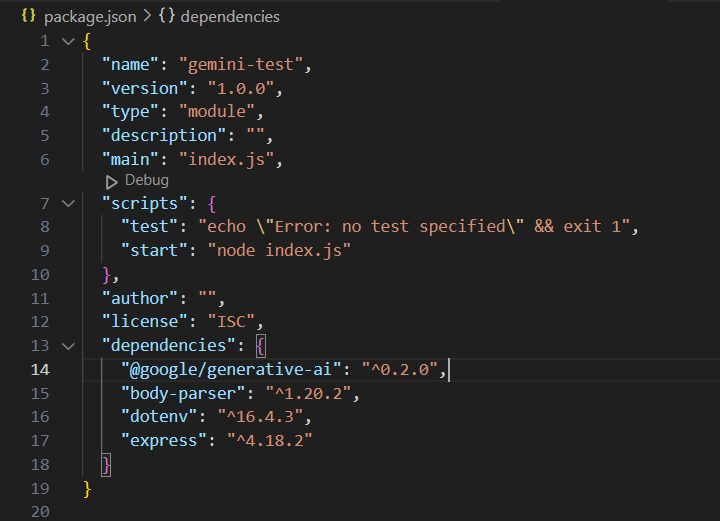 要檢查一切是否正常,讓我們使用以下命令執行該專案: ``` npm run start ``` 這將啟動 Express 伺服器。現在如果我們造訪這個 URL <http://localhost:3000/>我們會得到:  驚人的!專案設定已完成並且執行完美。接下來,我們將在下一節中將 Gemini 加入我們的專案中 新增Google雙子座: ------------ ### 1. 設定路由和中介軟體: 要將 Gemini 新增至我們的專案中,我們將建立一個`/generate`路由,以便與 Gemini AI 進行通訊。 為此,將以下程式碼新增至`index.js`檔案。 ``` const bodyParser = require("body-parser"); const { generateResponse } = require("./controllers/index.js"); //middleware to parse the body content to JSON app.use(bodyParser.json()); app.post("/generate", generateResponse); ``` 在這裡,我們使用`body-parser`中間件將內容解析為 JSON 格式。 ### 2.設定Google Generative AI: 現在,我們將建立一個控制器資料夾,並在其中建立一個`index.js`檔案。在這裡,我們將建立一個新的控制器函數來處理上面程式碼中聲明的生成路由。 ``` const { GoogleGenerativeAI } = require("@google/generative-ai"); const dotenv = require("dotenv"); dotenv.config(); // GoogleGenerativeAI required config const configuration = new GoogleGenerativeAI(process.env.API_KEY); // Model initialization const modelId = "gemini-pro"; const model = configuration.getGenerativeModel({ model: modelId }); ``` 在這裡,我們透過傳遞環境變數中的 API 金鑰來為 Google Generative AI API 建立一個配置物件。 然後,我們透過向配置物件的`getGenerativeModel`方法提供模型 ID(“gemini-pro”)來初始化模型。 > #### **型號配置:** > > 我們也可以依照自己的方便配置模型參數 > > 這些參數值控制模型如何產生回應。 > > 例子: > > ```javascript > 常量產生配置 = { > 停止序列:\[“紅色”\], > 最大輸出令牌:200, > 溫度:0.9, > 頂部P:0.1, > 頂級K:16, > }; > > const model = configuration.getGenerativeModel({ model: modelId, GenerationConfig }); > ```` > #### **安全設定:** > > 我們可以使用安全設定來防止有害的反應。預設情況下,安全性設定配置為阻止在各個維度上具有中等到高可能性不安全的內容。 > > 這是一個例子: > > ```javascript > const { HarmBlockThreshold, HarmCategory } = require("@google/generative-ai"); > > 常量安全設定 = \[ > { > ``` > category: HarmCategory.HARM_CATEGORY_HARASSMENT, > > ``` > ``` > threshold: HarmBlockThreshold.BLOCK_ONLY_HIGH, > > ``` > }, > { > ``` > category: HarmCategory.HARM_CATEGORY_HATE_SPEECH, > > ``` > ``` > threshold: HarmBlockThreshold.BLOCK_MEDIUM_AND_ABOVE, > > ``` > }, > \]; > > const model = genAI.getGenerativeModel({ model: "MODEL\_NAME", safetySettings }); > ```` > > 透過這些安全設置,我們可以透過最大限度地減少有害內容生成的可能性來增強安全性。 ### 3. 管理對話歷史記錄: 為了追蹤對話歷史記錄,我們建立了一個陣列`history`並將其從控制器檔案中匯出: ``` export const history = []; ``` ### 4.**實現控制器功能:** 現在,我們將編寫一個控制器函數`generateResponse`來處理產生路由(/generate)並產生對使用者請求的回應。 ``` /** * Generates a response based on the given prompt. * @param {Object} req - The request object. * @param {Object} res - The response object. * @returns {Promise} - A promise that resolves when the response is sent. */ export const generateResponse = async (req, res) => { try { const { prompt } = req.body; const result = await model.generateContent(prompt); const response = await result.response; const text = response.text(); console.log(text); history.push(text); console.log(history); res.send({ response: text }); } catch (err) { console.error(err); res.status(500).json({ message: "Internal server error" }); } }; ``` 在這裡,我們從請求正文中獲取提示,並使用`model.generateContent`方法根據提示產生回應。 為了追蹤響應,我們將響應推送到歷史陣列。 ### 5. 查看回覆紀錄: 現在,我們將建立一條路線來檢查我們的回應歷史記錄。該端點傳回`history`陣列。 將簡單程式碼加入`./index.js`資料夾中。 ``` app.get("/generate", (req, res) => { res.send(history); }); ``` 我們就完成了! ### 6.執行專案: 現在,我們必須檢查我們的應用程式是否正常運作! 讓我們使用以下命令來執行我們的專案: ``` npm run start ``` 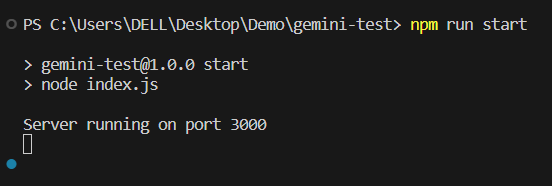 沒有錯誤!感謝上帝! :) 它運作正常。 ### 7. 檢查功能 接下來,我們將使用 Postman 發出 Post 請求來驗證我們的控制器功能。 我們將使用以下 JSON 負載向<http://localhost:3000/generate>發送 POST 請求: ``` { "prompt": "Write 3 Javascript Tips for Beginners" } ``` 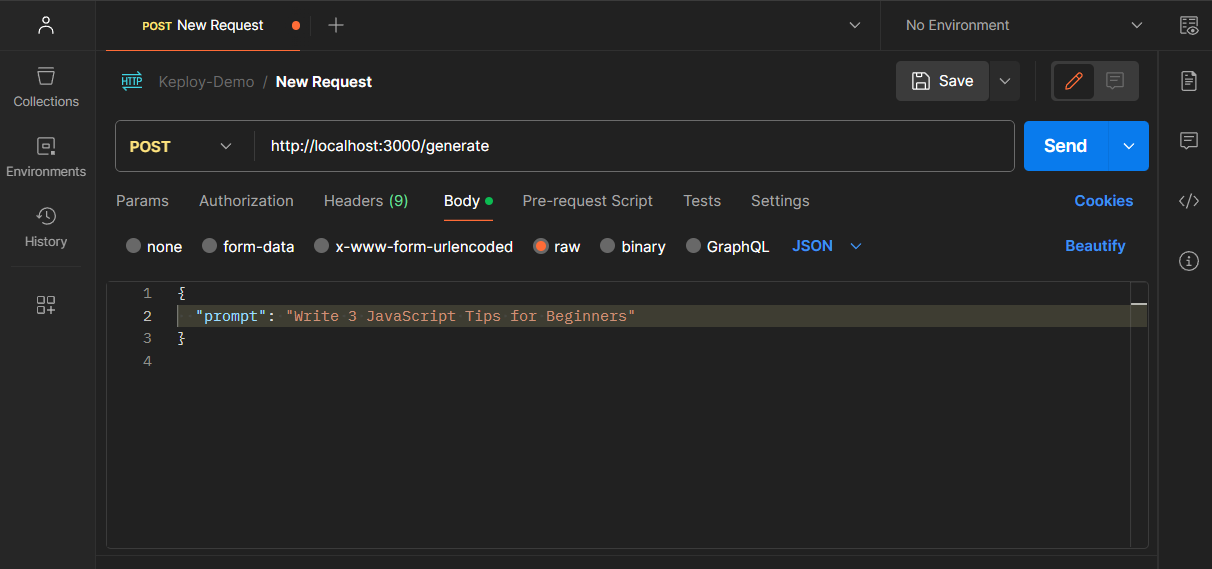 我們得到了回應: ``` { "response": "1. **Use console.log() for Debugging:**\n - console.log() is a useful tool for debugging your JavaScript code. It allows you to inspect the values of variables and expressions, and to see how your code is executing. This can be especially helpful when you encounter errors or unexpected behavior in your program.\n\n2. **Learn the Basics of Data Types:**\n - JavaScript has several built-in data types, including strings, numbers, booleans, and objects. Understanding the properties and behaviors of each data type is crucial for writing effective code. For instance, strings can be manipulated using string methods, while numbers can be used in mathematical operations.\n\n3. **Use Strict Mode:**\n - Strict mode is a way to opt-in to a restricted and secure subset of JavaScript. It helps you to write more secure and reliable code, as it throws errors for common mistakes that would otherwise go unnoticed in regular JavaScript mode. To enable strict mode, simply add \"use strict;\" at the beginning of your JavaScript file or module." } ``` 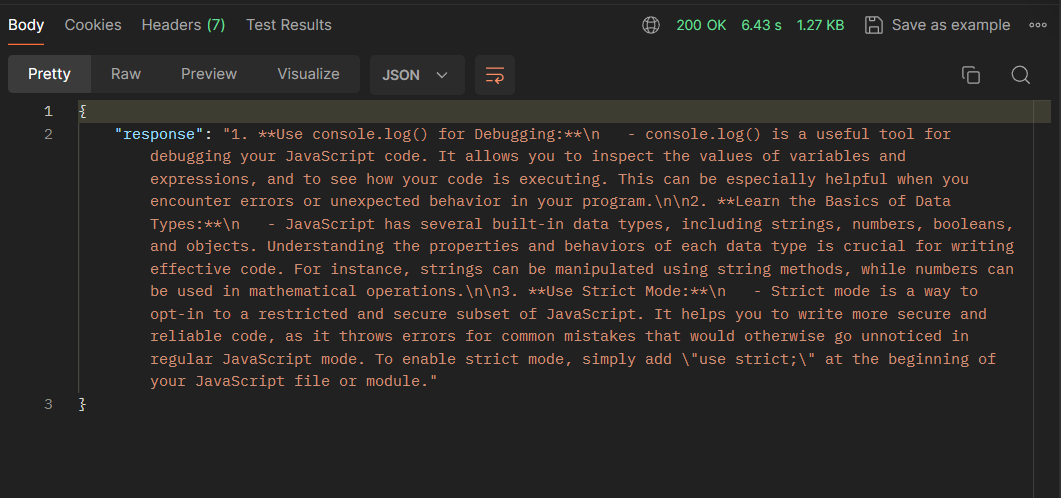 偉大的!我們的 Gemini AI 整合正在按預期工作! 此外,我們可以造訪[http://localhost:3000/generate 的](http://localhost:3000/generate)歷史記錄端點來查看對話歷史記錄。 這樣,我們就將 Gemini AI 整合到了 Node.js 應用程式中。在接下來的文章中,我們將探索 Gemini AI 的更多用例。 到那時,請繼續關注! 結論 -- 如果您發現這篇部落格文章有幫助,請考慮與可能受益的其他人分享。您也可以關注我,以了解更多有關 Javascript、React 和其他 Web 開發主題的內容。 要贊助我的工作,請存取: [Arindam 的贊助頁面](https://arindam1729.hashnode.dev/sponsor)並探索各種贊助選項。 在[Twitter](https://twitter.com/intent/follow?screen_name=Arindam_1729) 、 [LinkedIn](https://www.linkedin.com/in/arindam2004/) 、 [Youtube](https://www.youtube.com/channel/@Arindam_1729)和[GitHub](https://github.com/Arindam200)上與我聯絡。 感謝您的閱讀:)  --- 原文出處:https://dev.to/arindam_1729/how-to-use-google-gemini-with-nodejs-2d39
長話短說 ---- 俗話說,給貓剝皮有多種方法…在科技界,給 Lambda 函數剝皮有 5 種方法 🤩 我們將比較 5 個開發工具 - ✅[翼](#1-wing) - ✅[刷子](#2-pulumi) - ✅ [AWS-CDK](#3-awscdk) - ✅ [Terraform 的 CDK](#4-cdk-for-terraform) - ✅[地形](#5-terraform) 介紹 -- 當開發人員試圖彌合開發和 DevOps 之間的差距時,我認為比較程式語言和 DevTools 會很有幫助。 讓我們從一個簡單函數的想法開始,該函數將文字檔案上傳到我們的雲端應用程式中的儲存桶。 下一步是展示實現這一目標的幾種方法。 **注意:**在雲端開發中,管理權限和儲存桶身分、打包執行時程式碼以及處理基礎架構和執行時的多個檔案會增加開發過程的複雜性。  讓我們深入研究一些程式碼! --- 1.[翼](https://github.com/winglang/wing) --------------------------------------- > [安裝 Wing](https://www.winglang.io/docs)後,讓我們建立一個檔案: `main.w` > 如果您不熟悉 Wing 程式語言,請查看[此處的](https://github.com/winglang/wing)**開源儲存庫** ``` bring cloud; let bucket = new cloud.Bucket(); new cloud.Function(inflight () => { bucket.put("hello.txt", "world!"); }); ``` **讓我們詳細分析一下上面程式碼中發生的情況。** > `bring cloud`是 Wing 的導入語法 > **建立一個雲端儲存桶:** `let bucket = new cloud.Bucket();`初始化一個新的雲端儲存桶實例。 > 在後端,Wing 平台在您的雲端供應商環境中配置一個新儲存桶。此桶用於儲存和檢索資料。 > **建立雲端函數:** `new cloud.Function(inflight () => { ... });`語句定義了一個新的雲函數。 > 該函數被觸發後,將執行其主體內定義的操作。 > `bucket.put("hello.txt", "world!");`上傳一個名為 hello.txt 的文件,其中包含內容世界!到之前建立的雲端儲存桶。 編譯並部署到 AWS ---------- - `wing compile --platform tf-aws main.w` - `terraform apply` 就是這樣,Wing 負責處理複雜性(權限、在執行時程式碼中獲取存儲桶身份、將執行時程式碼打包到存儲桶中、必須編寫多個文件 - 用於基礎設施和執行時)等。 更不用說它會產生 IAC(TF 或 CF),以及可以使用現有工具部署的 Javascript。 但在開發時,您可以使用本機模擬器獲得即時回饋並縮短迭代周期  Wing 甚至還有一個[遊樂場](https://www.winglang.io/play/?code=YgByAGkAbgBnACAAYwBsAG8AdQBkADsACgAKAGwAZQB0ACAAYgB1AGMAawBlAHQAIAA9ACAAbgBlAHcAIABjAGwAbwB1AGQALgBCAHUAYwBrAGUAdAAoACkAOwAKAAoAbgBlAHcAIABjAGwAbwB1AGQALgBGAHUAbgBjAHQAaQBvAG4AKABpAG4AZgBsAGkAZwBoAHQAIAAoACkAIAA9AD4AIAB7AAoAIAAgAGIAdQBjAGsAZQB0AC4AcAB1AHQAKAAiAGgAZQBsAGwAbwAuAHQAeAB0ACIALAAgACIAdwBvAHIAbABkACEAIgApADsACgB9ACkAOwA%3D),您可以在瀏覽器中試用! 2.[刷子](https://www.pulumi.com) ------------------------------ > 步驟1:初始化一個新的Pulumi專案 ``` mkdir pulumi-s3-lambda-ts cd pulumi-s3-lambda-ts pulumi new aws-typescript ``` > 步驟 2. 編寫程式碼以將文字檔案上傳到 S3。 這將是您的專案結構。 ``` pulumi-s3-lambda-ts/ ├─ src/ │ ├─ index.ts # Pulumi infrastructure code │ └─ lambda/ │ └─ index.ts # Lambda function code to upload a file to S3 ├─ tsconfig.json # TypeScript configuration └─ package.json # Node.js project file with dependencies ``` 讓我們將此程式碼加入**index.ts** ``` import * as pulumi from "@pulumi/pulumi"; import * as aws from "@pulumi/aws"; // Create an AWS S3 bucket const bucket = new aws.s3.Bucket("myBucket", { acl: "private", }); // IAM role for the Lambda function const lambdaRole = new aws.iam.Role("lambdaRole", { assumeRolePolicy: JSON.stringify({ Version: "2023-10-17", Statement: [{ Action: "sts:AssumeRole", Principal: { Service: "lambda.amazonaws.com", }, Effect: "Allow", Sid: "", }], }), }); // Attach the AWSLambdaBasicExecutionRole policy new aws.iam.RolePolicyAttachment("lambdaExecutionRole", { role: lambdaRole, policyArn: aws.iam.ManagedPolicy.AWSLambdaBasicExecutionRole, }); // Policy to allow Lambda function to access the S3 bucket const lambdaS3Policy = new aws.iam.Policy("lambdaS3Policy", { policy: bucket.arn.apply(arn => JSON.stringify({ Version: "2023-10-17", Statement: [{ Action: ["s3:PutObject", "s3:GetObject"], Resource: `${arn}/*`, Effect: "Allow", }], })), }); // Attach policy to Lambda role new aws.iam.RolePolicyAttachment("lambdaS3PolicyAttachment", { role: lambdaRole, policyArn: lambdaS3Policy.arn, }); // Lambda function const lambda = new aws.lambda.Function("myLambda", { code: new pulumi.asset.AssetArchive({ ".": new pulumi.asset.FileArchive("./src/lambda"), }), runtime: aws.lambda.Runtime.NodeJS12dX, role: lambdaRole.arn, handler: "index.handler", environment: { variables: { BUCKET_NAME: bucket.bucket, }, }, }); export const bucketName = bucket.id; export const lambdaArn = lambda.arn; ``` 接下來,為 Lambda 函數程式碼建立**lambda/index.ts**目錄: ``` import { S3 } from "aws-sdk"; const s3 = new S3(); export const handler = async (): Promise<void> => { const bucketName = process.env.BUCKET_NAME || ""; const fileName = "example.txt"; const content = "Hello, Pulumi!"; const params = { Bucket: bucketName, Key: fileName, Body: content, }; try { await s3.putObject(params).promise(); console.log(`File uploaded successfully at https://${bucketName}.s3.amazonaws.com/${fileName}`); } catch (err) { console.log(err); } }; ``` > 步驟 3:TypeScript 設定 (tsconfig.json) ``` { "compilerOptions": { "target": "ES2018", "module": "CommonJS", "strict": true, "esModuleInterop": true, "skipLibCheck": true, "forceConsistentCasingInFileNames": true }, "include": ["src/**/*.ts"], "exclude": ["node_modules", "**/*.spec.ts"] } ``` **建立Pulumi專案後,會自動產生yaml檔案。** **pulumi.yaml** ``` name: s3-lambda-pulumi runtime: nodejs description: A simple example that uploads a file to an S3 bucket using a Lambda function template: config: aws:region: description: The AWS region to deploy into default: us-west-2 ``` 與 Pulumi 一起部署 ------------- 確保正確設定包含`index.js`檔案的`lambda`目錄。然後,執行以下命令來部署您的基礎架構: `pulumi up` --- 3. [AWS-CDK](https://aws.amazon.com/cdk) ---------------------------------------- > 步驟1:初始化一個新的CDK專案 ``` mkdir cdk-s3-lambda cd cdk-s3-lambda cdk init app --language=typescript ``` > 第 2 步:新增依賴項 ``` npm install @aws-cdk/aws-lambda @aws-cdk/aws-s3 ``` > 步驟 3:在 CDK 中定義 AWS 資源 文件: **index.js** ``` import * as cdk from '@aws-cdk/core'; import * as lambda from '@aws-cdk/aws-lambda'; import * as s3 from '@aws-cdk/aws-s3'; export class CdkS3LambdaStack extends cdk.Stack { constructor(scope: cdk.Construct, id: string, props?: cdk.StackProps) { super(scope, id, props); // Create the S3 bucket const bucket = new s3.Bucket(this, 'MyBucket', { removalPolicy: cdk.RemovalPolicy.DESTROY, // NOT recommended for production code }); // Define the Lambda function const lambdaFunction = new lambda.Function(this, 'MyLambda', { runtime: lambda.Runtime.NODEJS_14_X, // Define the runtime handler: 'index.handler', // Specifies the entry point code: lambda.Code.fromAsset('lambda'), // Directory containing your Lambda code environment: { BUCKET_NAME: bucket.bucketName, }, }); // Grant the Lambda function permissions to write to the S3 bucket bucket.grantWrite(lambdaFunction); } } ``` > 步驟 4:Lambda 函數程式碼 在 pulumi 目錄中建立與上面相同的檔案結構: **index.ts** ``` import { S3 } from 'aws-sdk'; const s3 = new S3(); exports.handler = async (event: any) => { const bucketName = process.env.BUCKET_NAME; const fileName = 'uploaded_file.txt'; const content = 'Hello, CDK! This file was uploaded by a Lambda function!'; try { const result = await s3.putObject({ Bucket: bucketName!, Key: fileName, Body: content, }).promise(); console.log(`File uploaded successfully: ${result}`); return { statusCode: 200, body: `File uploaded successfully: ${fileName}`, }; } catch (error) { console.log(error); return { statusCode: 500, body: `Failed to upload file: ${error}`, }; } }; ``` 部署 CDK 堆疊 --------- 首先,編譯 TypeScript 程式碼: `npm run build` ,然後 將您的 CDK 部署到 AWS: `cdk deploy` --- [4.Terraform 的 CDK](https://developer.hashicorp.com/terraform/cdktf) -------------------------------------------------------------------- > 步驟1:初始化一個新的CDKTF專案 ``` mkdir cdktf-s3-lambda-ts cd cdktf-s3-lambda-ts ``` 然後,使用 TypeScript 初始化一個新的 CDKTF 專案: ``` cdktf init --template="typescript" --local ``` > 步驟 2:安裝 AWS Provider 並新增相依性 ``` npm install @cdktf/provider-aws ``` > 第 3 步:定義基礎設施 編輯 main.ts 以定義 S3 儲存桶和 Lambda 函數: ``` import { Construct } from 'constructs'; import { App, TerraformStack } from 'cdktf'; import { AwsProvider, s3, lambdafunction, iam } from '@cdktf/provider-aws'; class MyStack extends TerraformStack { constructor(scope: Construct, id: string) { super(scope, id); new AwsProvider(this, 'aws', { region: 'us-west-2' }); // S3 bucket const bucket = new s3.S3Bucket(this, 'lambdaBucket', { bucketPrefix: 'cdktf-lambda-' }); // IAM role for Lambda const role = new iam.IamRole(this, 'lambdaRole', { name: 'lambda_execution_role', assumeRolePolicy: JSON.stringify({ Version: '2023-10-17', Statement: [{ Action: 'sts:AssumeRole', Principal: { Service: 'lambda.amazonaws.com' }, Effect: 'Allow', }], }), }); new iam.IamRolePolicyAttachment(this, 'lambdaPolicy', { role: role.name, policyArn: 'arn:aws:iam::aws:policy/service-role/AWSLambdaBasicExecutionRole', }); const lambdaFunction = new lambdafunction.LambdaFunction(this, 'MyLambda', { functionName: 'myLambdaFunction', handler: 'index.handler', role: role.arn, runtime: 'nodejs14.x', s3Bucket: bucket.bucket, // Assuming the Lambda code is uploaded to this bucket s3Key: 'lambda.zip', // Assuming the Lambda code zip file is named lambda.zip environment: { variables: { BUCKET_NAME: bucket.bucket, }, }, }); // Grant the Lambda function permissions to write to the S3 bucket new s3.S3BucketPolicy(this, 'BucketPolicy', { bucket: bucket.bucket, policy: bucket.bucket.apply(name => JSON.stringify({ Version: '2023-10-17', Statement: [{ Action: 's3:*', Resource: `arn:aws:s3:::${name}/*`, Effect: 'Allow', Principal: { AWS: role.arn, }, }], })), }); } } const app = new App(); new MyStack(app, 'cdktf-s3-lambda-ts'); app.synth(); ``` > 步驟 4:Lambda 函數程式碼 Lambda 函數程式碼應使用 TypeScript 編寫並編譯為 JavaScript,因為 AWS Lambda 本機執行 JavaScript。以下是您需要編譯和壓縮的 Lambda 函數的範例**index.ts** : ``` import { S3 } from 'aws-sdk'; const s3 = new S3(); exports.handler = async () => { const bucketName = process.env.BUCKET_NAME || ''; const content = 'Hello, CDKTF!'; const params = { Bucket: bucketName, Key: `upload-${Date.now()}.txt`, Body: content, }; try { await s3.putObject(params).promise(); return { statusCode: 200, body: 'File uploaded successfully' }; } catch (err) { console.error(err); return { statusCode: 500, body: 'Failed to upload file' }; } }; ``` 您需要將此 TypeScript 程式碼編譯為 JavaScript,對其進行壓縮,然後手動或使用腳本將其上傳到 S3 儲存桶。 確保 LambdaFunction 資源中的 s3Key 指向儲存桶中正確的 zip 檔案。 編譯和部署您的 CDKTF 專案 ---------------- 使用`npm run build`編譯專案 **生成 Terraform 配置文件** 執行`cdktf synth`指令。此命令執行您的 CDKTF 應用程式,該應用程式在`cdktf.out`目錄中產生 Terraform 設定檔( `*.tf.json`檔案): **部署您的基礎設施** `cdktf deploy` 5.[地形](https://developer.hashicorp.com/terraform) ------------------------------------------------- > 第 1 步:Terraform 設定 定義您的 AWS 供應商和 S3 儲存桶 使用以下內容建立名為**main.tf**的檔案: ``` provider "aws" { region = "us-west-2" # Choose your AWS region } resource "aws_s3_bucket" "lambda_bucket" { bucket_prefix = "lambda-upload-bucket-" acl = "private" } resource "aws_iam_role" "lambda_execution_role" { name = "lambda_execution_role" assume_role_policy = jsonencode({ Version = "2023-10-17" Statement = [ { Action = "sts:AssumeRole" Effect = "Allow" Principal = { Service = "lambda.amazonaws.com" } }, ] }) } resource "aws_iam_policy" "lambda_s3_policy" { name = "lambda_s3_policy" description = "IAM policy for Lambda to access S3" policy = jsonencode({ Version = "2023-10-17" Statement = [ { Action = ["s3:PutObject", "s3:GetObject"], Effect = "Allow", Resource = "${aws_s3_bucket.lambda_bucket.arn}/*" }, ] }) } resource "aws_iam_role_policy_attachment" "lambda_s3_access" { role = aws_iam_role.lambda_execution_role.name policy_arn = aws_iam_policy.lambda_s3_policy.arn } resource "aws_lambda_function" "uploader_lambda" { function_name = "S3Uploader" s3_bucket = "YOUR_DEPLOYMENT_BUCKET_NAME" # Set your deployment bucket name here s3_key = "lambda.zip" # Upload your ZIP file to S3 and set its key here handler = "index.handler" role = aws_iam_role.lambda_execution_role.arn runtime = "nodejs14.x" environment { variables = { BUCKET_NAME = aws_s3_bucket.lambda_bucket.bucket } } } ``` > 步驟 2:Lambda 函數程式碼 (TypeScript) 為 Lambda 函數建立 TypeScript 檔案**index.ts** : ``` import { S3 } from 'aws-sdk'; const s3 = new S3(); exports.handler = async (event: any) => { const bucketName = process.env.BUCKET_NAME; const fileName = `uploaded-${Date.now()}.txt`; const content = 'Hello, Terraform and AWS Lambda!'; try { await s3.putObject({ Bucket: bucketName!, Key: fileName, Body: content, }).promise(); console.log('Upload successful'); return { statusCode: 200, body: JSON.stringify({ message: 'Upload successful' }), }; } catch (error) { console.error('Upload failed:', error); return { statusCode: 500, body: JSON.stringify({ message: 'Upload failed' }), }; } }; ``` 最後,將 Lambda 函數程式碼上傳到指定的 S3 儲存桶後,執行`terraform apply` 。 --- 我希望您喜歡在我們的雲端應用程式中編寫將文字檔案上傳到儲存桶的函數的五種簡單方法的比較。 正如您所看到的,除了一段程式碼之外,大多數程式碼都變得非常複雜。 結論! --- [](https://github.com/winglang/wing) 點擊圖片⬆️  > 如果您對 Wing 感興趣並且喜歡我們如何簡化雲端開發流程,請給我們一顆 ⭐ 顆星。 {% cta https://github.com/winglang/wing %} 請star ⭐ Wing {% endcta %} --- 原文出處:https://dev.to/winglang/5-ways-to-write-a-simple-function-in-your-cloud-app-1jgl
剛開始接觸**物件導向編程**,對**SOLID**感到有點迷失?不用擔心,在本文中,我將向您解釋它並提供如何在程式碼開發中使用它的範例。 什麼是固體? ------ 在物件導向程式設計中, **SOLID**是五個設計原則的縮寫,旨在增強對軟體的理解、開發和維護。 透過應用這組原則,您應該注意到錯誤的減少、程式碼品質的提高、程式碼組織性更強、耦合性降低、重構增強以及程式碼重用的鼓勵。讓我們來看看他們。 1. S-單一職責原則 -----------  > SRP - 單一職責原則 這確實很簡單,但非常重要:**一個類別應該有一個且只有一個改變的理由。** 不再建立具有多種功能和職責的類,是嗎?您可能遇到甚至建立了一個可以完成所有操作的類,即所謂的*God Class* 。目前看起來似乎沒問題,但是當您需要更改該類別的邏輯時,肯定會出現問題。 > 上帝類別:在OOP中,這是一個`do`或`knows`太多事情的類別。 ``` class ProfileManager { authenticateUser(username: string, password: string): boolean { // Authenticate logic } showUserProfile(username: string): UserProfile { // Show user profile logic } updateUserProfile(username: string): UserProfile { // Update user profile logic } setUserPermissions(username: string): void { // Set permission logic } } ``` 此**ProfileManager**類別執行**四個**不同的任務,違反了 SRP 原則。它正在驗證和更新資料、進行演示,最重要的是,它正在設定權限,所有這些都是同時進行的。 ### 這可能導致的問題 - `Lack of cohesion -`一個類別不應該承擔不屬於它自己的責任; - `Too much information in one place -`你的類別最終會產生許多依賴性並且難以進行更改; - `Challenges in implementing automated tests -`很難模擬這樣的類別。 現在,將**SRP**應用到`ProfileManager`類別中,讓我們來看看這個原則可以帶來的改進: ``` class AuthenticationManager { authenticateUser(username: string, password: string): boolean { // Authenticate logic } } class UserProfileManager { showUserProfile(username: string): UserProfile { // Show user profile logic } updateUserProfile(username: string): UserProfile { // Update user profile logic } } class PermissionManager { setUserPermissions(username: string): void { // Set permission logic } } ``` 您可能想知道, `can I apply this only to classes?`答案是:**完全不是**。您也可以(並且應該)將其應用於方法和函數。 ``` // ❌ function processTasks(taskList: Task[]): void { taskList.forEach((task) => { // Processing logic involving multiple responsibilities updateTaskStatus(task); displayTaskDetails(task); validateTaskCompletion(task); verifyTaskExistence(task); }); } // ✅ function updateTaskStatus(task: Task): Task { // Logic for updating task status return { ...task, completed: true }; } function displayTaskDetails(task: Task): void { // Logic for displaying task details console.log(`Task ID: ${task.id}, Description: ${task.description}`); } function validateTaskCompletion(task: Task): boolean { // Logic for validating task completion return task.completed; } function verifyTaskExistence(task: Task): boolean { // Logic for verifying task existence return tasks.some((t) => t.id === task.id); } ``` 美麗、優雅、有組織的程式碼。這個原則是其他原則的基礎;透過應用它,您應該建立高品質、可讀且可維護的程式碼。 2. O——開閉原則 ----------  > OCP-開閉原則 **物件或實體應該對擴充開放,但對修改關閉。**如果您需要加入功能,最好擴展而不是修改原始程式碼。 想像一下,您需要一個類別來計算某些多邊形的面積。 ``` class Circle { radius: number; constructor(radius: number) { this.radius = radius; } area(): number { return Math.PI * this.radius ** 2; } } class Square { sideLength: number; constructor(sideLength: number) { this.sideLength = sideLength; } calculateArea(): number { return this.sideLength ** 2; } } class areaCalculator { totalArea(shapes: Shape[]): number { let total = 0; shapes.forEach((shape) => { if (shape instanceof Square) { total += (shape as any).calculateArea(); } else { total += shape.area(); } }); return total; } } ``` `areaCalculator`類別的任務是計算不同多邊形的面積,每個多邊形都有自己的面積邏輯。如果您,'lil dev,需要加入新形狀,例如三角形或矩形,您會發現自己**需要**更改此類來進行更改,對吧?這就是你遇到問題的地方,違反了`Open-Closed Principle` 。 我想到了什麼解決方案?可能會在類別中加入另一個方法並完成,問題解決了🤩。不完全是,年輕學徒😓,這就是問題所在! **修改現有類別以新增行為會帶來嚴重的風險,可能會將錯誤引入到已執行的內容中。** > 請記住:OCP 堅持認為類別應該對修改關閉,對擴展開放。 看看重構程式碼帶來的美妙之處: ``` interface Shape { area(): number; } class Circle implements Shape { radius: number; constructor(radius: number) { this.radius = radius; } area(): number { return Math.PI * this.radius ** 2; } } class Square implements Shape { sideLength: number; constructor(sideLength: number) { this.sideLength = sideLength; } area(): number { return this.sideLength ** 2; } } class AreaCalculator { totalArea(shapes: Shape[]): number { let total = 0; shapes.forEach((shape) => { total += shape.area(); }); return total; } } ``` 查看`AreaCalculator`類別:它不再需要知道要呼叫哪些方法來註冊該類別。它可以透過呼叫介面強加的契約來正確地呼叫區域方法,這是它唯一需要的。 > 只要它們實作了 Shape 接口,一切就可以正常運作。 <br/> > 分離介面背後的可擴展行為並反轉依賴關係。 > > [鮑伯叔叔](https://en.wikipedia.org/wiki/Robert_C._Martin) - `Open for extension:`您可以為類別新增功能或行為,而無需變更其原始程式碼。 - `Closed for modification:`如果您的類別已經具有可以正常工作的功能或行為,請不要更改其原始程式碼以加入新內容。 3. L——里氏代換原理 ------------  > LSP - 里氏替換原理 里氏替換原則指出**衍生類別必須可替換其基底類別。** 這個原則由 Barbara Liskov 在 1987 年提出,閱讀她的解釋可能會有點複雜。不過,不用擔心,我將提供另一個解釋和範例來幫助您理解。 > 如果對於 S 類型的每個物件 o1 都有一個 T 類型的物件 o2,使得對於所有用 T 定義的程式 P,當 o1 取代 o2 時 P 的行為保持不變,則 S 是 T 的子類型。 > > 芭芭拉‧利斯科夫,1987 你做對了?不,可能不是。是的,我第一次讀時不明白(接下來的一百遍也不明白),但等等,還有另一種解釋: > 如果 S 是 T 的子類型,則程式中類型 T 的物件可以用類型 S 的物件替換,而不改變該程式的屬性。 > > [維基百科](https://en.wikipedia.org/wiki/Liskov_substitution_principle) 如果您更喜歡視覺學習者,請不要擔心,這裡有一個例子: ``` class Person { speakName() { return "I am a person!"; } } class Child extends Person { speakName() { return "I am a child!"; } } const person = new Person(); const child = new Child(); function printName(message: string) { console.log(message); } printName(person.speakName()); // I am a person! printName(child.speakName()); // I am a child! ``` 父類別和衍生類別作為參數傳遞,程式碼繼續按預期工作。魔法?是的,這就是我們的朋友倒鉤的魔力。 ### 違規行為範例: - 重寫/實作一個不執行任何操作的方法; - 從基類傳回不同類型的值。 - 拋出意外的異常; 4. I——介面隔離原則 ------------  > ISP-介面隔離原則 這句話說**不應該強迫一個類別實作它不使用的介面和方法。**建立更具體的介面比建立大而通用的介面更好。 在下面的範例中,建立一個**Book**介面來抽象化書籍行為,然後類別實作該介面: ``` interface Book { read(): void; download(): void; } class OnlineBook implements Book { read(): void { // does something } download(): void { // does something } } class PhysicalBook implements Book { read(): void { // does something } download(): void { // This implementation doesn't make sense for a book // it violates the Interface Segregation Principle } } ``` 通用`Book`介面迫使`PhysicalBook`類別做出毫無意義的行為(*或者我們在 Matrix 中下載實體書籍?* )並且違反了**ISP**和**LSP**原則。 使用**ISP**解決此問題: ``` interface Readable { read(): void; } interface Downloadable { download(): void; } class OnlineBook implements Readable, Downloadable { read(): void { // does something } download(): void { // does something } } class PhysicalBook implements Readable { read(): void { // does something } } ``` 現在好多了。我們從`Book`介面中刪除了`download()`方法,並將其加入到派生介面`Downloadable`中。這樣,行為就可以在我們的上下文中正確隔離,並且我們仍然尊重**介面隔離原則**。 5.D-依賴倒置原則 ----------  > DIP - 依賴倒置原理 這個是這樣的:**依賴抽象而不是實現。** > 高層模組不應該依賴低層模組。兩者都應該依賴抽象。 > > 抽像不應該依賴細節。細節應該取決於抽象。 > > 鮑伯叔叔 現在我將展示一個簡單的程式碼來說明 DIP。在此範例中,有一個從資料庫取得使用者的服務。首先,讓我們建立一個與資料庫連接的具體類別: ``` // Low-level module class MySQLDatabase { getUserData(id: number): string { // Logic to fetch user data from MySQL database } } ``` 現在,讓我們建立一個取決於具體實作的服務類別: ``` // High-level module class UserService { private database: MySQLDatabase; constructor() { this.database = new MySQLDatabase(); } getUser(id: number): string { return this.database.getUserData(id); } } ``` 在上面的範例中, `UserService`直接依賴`MySQLDatabase`的具體實作。這違反了**DIP** ,因為**高級**類別 UserService 直接依賴**低階**類別。 如果我們想要切換到不同的資料庫系統(例如PostgreSQL),我們需要修改UserService類,這`AWFUL`了! 讓我們使用**DIP**修復此程式碼。高級類別`UserService`不應依賴特定實現,而應依賴抽象。讓我們建立一個`Database`介面作為抽象: ``` // Abstract interface (abstraction) for the low-level module interface Database { getUserData(id: number): string; } ``` 現在, `MySQLDatabase`和`PostgreSQLDatabase`的具體實作應該要實作這個介面: ``` class MySQLDatabase implements Database { getUserData(id: number): string { // Logic to fetch user data from MySQL database } } // Another low-level module implementing the Database interface class PostgreSQLDatabase implements Database { getUserData(id: number): string { // Logic to fetch user data from PostgreSQL database } } ``` 最後,UserService 類別可以依賴`Database`抽象: ``` class UserService { private database: Database; constructor(database: Database) { this.database = database; } getUser(id: number): string { return this.database.getUserData(id); } } ``` 這樣, `UserService`類別依賴`Database`抽象,而不是具體實現,滿足**依賴倒置原則**。 結論 -- 透過採用這些原則,開發人員可以建立更能適應變化的系統,使維護變得更容易,並隨著時間的推移提高程式碼品質。 本文的全部內容源自各種其他文章、我的個人筆記以及我**在深入研究物件導向程式設計 (OOP) 領域**時遇到的數十個線上影片。範例中使用的程式碼片段是基於我對這些原則的解釋和理解而建立的。我真的希望,我的小學徒,我能為促進你的理解和學習進步做出貢獻。 衷心希望您喜歡這篇文章,別忘了關注! 註:圖片取自[本文](https://medium.com/backticks-tildes/the-s-o-l-i-d-principles-in-pictures-b34ce2f1e898) --- 原文出處:https://dev.to/lukeskw/solid-principles-theyre-rock-solid-for-good-reason-31hn
所以我現在已經進入 Web 開發大約 3 年了,專業也有一年多了,這是我處理一個與資料庫查詢最佳化相關的問題的時候,我不是 SQL 專家,我可以得到這份工作完成。沒有花哨的查詢、觸發器、預存程序等。無論如何,我不得不穀歌搜尋最後一個。 長話短說..我們的 ORM (TypeORM) 把我們搞砸了.. ## 免責聲明: 這並不是要誹謗 TypeORM 或任何 ORM。它們是為其建置目的而設計的特殊工具。我在最後附加了一些參考連結,這些連結是人們面臨類似問題的公開討論。無論如何,讓我們繼續這篇文章。 ## 問題! 我們的提交表有超過 70 萬筆記錄,表現非常糟糕。從表中取得資料的最長時間超過 6 秒。  查詢相當簡單。我們所擁有的只是 4 個連接、幾個 where 子句(大約 4 個)、排序(在created_at time 字段上的 DESC)、限制和跳過。 ## 根本原因分析.. 導致我們的提交表大幅放緩的幾個因素如下:- - **索引** - 對用於連接表的欄位進行不正確的索引或未進行索引。 - **不必要的連接** - 我們的查詢中有一些不必要的連接,可以將其刪除以獲得更多效能。 - **空字串錯誤** - 我們程式碼中的一個錯誤,如果沒有為這些列提供使用者輸入,我們將與作為查詢的 where 條件一部分的所有列的空字串 (“”) 進行比較。 - **ORM** - ORM 正在執行一個超級愚蠢的查詢來獲取資料。 這些是我在檢查程式碼和資料庫模式以及分析正在執行以獲取所需資料的查詢時發現的精確點。 ## 對提到的每個問題進行分析和測試。 ###<u>原因 1:索引</u> 在進行了一些谷歌搜尋並閱讀了人們的類似問題後,我發現我們的問題並不是那麼大。人們正在為數百萬行而苦苦掙扎,而我們的只是其中的一小部分,所以一定是我們做錯了什麼。 早期解決這些問題的社區提出了許多建議。我發現進行適當的索引會有很大幫助。 因此,為了進行測試,我從 beta 資料庫中獲取了提交內容,該資料庫擁有大約超過 **100k 記錄**。 在沒有任何最佳化的情況下,執行整個過程平均需要 **2.3 秒**。 (當然,這個時間不僅包括在資料庫上執行查詢的時間,還包括透過網路傳播資料的時間)  在向列加入索引後,我確實發現它縮短了幾毫秒的時間,但這還不夠。它仍然在 **2 秒** 左右,而且往往不止於此。 所以有點令人失望!無論如何,繼續下一個目標。 ### <u>原因 2:空字串錯誤</u> 因此,我們的時間從 **2.3** 秒縮短到了大約 2 秒,這對於索引來說並不算多。但後來我在我們的程式碼中發現了一個小錯誤,假設有四個輸入欄位供使用者根據四個不同的列鍵入和過濾結果。如果使用者沒有在任何輸入上鍵入任何內容(主要是在頁面首次載入時),且 API 呼叫會直接取得最新資料,而不進行任何過濾,僅進行連接和排序。 因此,在那一刻,我們為資料庫中的所有列傳遞了“”字串,這似乎無害,但實際上發生的情況是,資料庫正在對所有四列進行查找,您猜對了“”字串。所以進行了大量的查找,實際上什麼都沒有。 因此,當我將其更改為空(如empty/null)時(相當於從查詢中刪除where子句),查詢時間從**2.3秒變為1.3秒**。 如果您想知道使用使用者提供的實際輸入進行過濾需要多長時間。大約**500ms**(這是可以接受的)。 結論 - 即使您的資料庫使用所有可搜尋列進行索引,“”字串也不能很好地發揮作用。 好的,我們正朝著正確的方向前進。我們整整縮短了 1 秒,但我們仍然必須將其控制在 **200/150ms** 以下,所以還有很長的路要走。 ### <u>原因 3:不必要的連接</u> 在查詢提交時,我們正在與不需要的比賽和課程表進行連接。因此,當所有內容都加入到程式碼中時,我們只是刪除了它,但這表明審閱者並沒有給予太多關注(我是其中之一)。 ### <u>原因 4:ORM</u> 這是造成最多的問題.. 好.. 問題!!. 所以有一種叫做 **主動記錄模式** 的東西,TypeORM 為我們提供了使用類似 JSON 的物件產生 SQL 查詢的東西,一個例子就是。 ``` model.find({ select: { userName : true, firstName : true }, where: { userName : “SomeUsername” }, relations: { user : true, contest: true, problem: true }, order: { created_at : “ASC/DESC” , skip: 0, take: 10, }) ``` 因此,這使得開發變得快速、簡單,對於不擅長編寫原始 SQL 查詢的開發人員來說,感覺非常直觀,因為這是最抽象的版本,您實際上是在建立 JSON 物件來產生 SQL 查詢。 這種方法看起來不錯,而且大多數時候都有效,但在我們的例子中,它做了一些非常愚蠢的事情,我不會輸入它在做什麼,這樣你就可以自己看到查詢。 簡而言之,它正在執行兩個查詢,首先對於這種情況根本不需要,它可以通過我稍後編寫並測試的一個簡單的單個查詢輕鬆完成。 它不僅執行兩個單獨的查詢(原因尚不清楚,因為這是一個已知問題,有時在使用typeorm 的活動記錄模式時發生),它還將四個表連接兩次,每個查詢一次,然後還排序兩次各一次。 (這實際上沒有任何意義) 這也是表演受到最大打擊的地方。自己看看下面的查詢。 ``` SELECT DISTINCT `distinctAlias`.`Submission_id` AS `ids_Submission_id`, `distinctAlias`.`Submission_created_at` FROM (SELECT `Submission`.`id` AS `Submission_id`, ... more selects FROM `submission` `Submission` LEFT JOIN `problem` `SubmissionSubmission_problem` ON `SubmissionSubmission_problem`.`id`=`Submission`.`problemId` LEFT JOIN `user` `SubmissionSubmission_user` ON `Submission_Submission_user`.`id`=`Submission`.`userId`) `distinctAlias` ORDER BY `distinctAlias`.`Submission_created_at` DESC, `Submission_id` ASC LIMIT 10 ``` ``` SELECT `Submission`.`id` AS `Submission_id`, `Submission`.`language` AS `Submission_language`, `Submission`.`verdictCode` AS `Submission_verdictCode`, `Submission`.`tokens` ... shit ton of selects FROM `submission` `Submission` LEFT JOIN `problem` `SubmissionSubmission_problem` ON `SubmissionSubmission_problem`.`id`=`Submission`.`problemId` LEFT JOIN `user` `SubmissionSubmission_user` ON `Submission_Submission_user`.`id`=`Submission`.`userId` WHERE `Submission`.`id` IN (?, ?, ?, ?, ?, ?, ?, ?, ?, ?) ORDER BY `Submission`.`created_at` DESC ``` 所以這兩個查詢是問題的主要原因,也是主要原因之一。 因此,我編寫了一個簡單的原始 SQL 查詢來執行與它嘗試使用 2 個單獨的查詢執行的完全相同的操作,查詢如下:- ``` SELECT Submission.id, Submission.language, Submission.verdictCode, ... FROM submission AS Submission LEFT JOIN problem ... LEFT JOIN user ... ORDER BY Submission.created_at DESC LIMIT 10 ``` 當我們執行這個查詢時,它的執行時間僅為 **100ms!!!** 因此,我們現在從 **1.3** 秒移至 **100ms**,總體從 **2.3** 秒移至 **100ms** 效能提升超過 **23 倍。** 之後我就去睡覺了。仍然需要做更多的測試,並嘗試找出邊緣情況(如果有),並提出為此編寫查詢的最佳方法。目前,我正在考慮使用 TypeORM 提供的儲存庫模式或查詢建構器模式。 第二天: 又來了.. ### <u>全文索引</u> **全文索引**可以提高從這些索引列中搜尋單字和短語的效率,我們也可以嘗試一下。 (這是我的同事 Jay 提出的一個非常好的觀點,它進一步提高了表現)。 ###<u>發現了一些更重要的點。</u> 在 MySQL 中最佳化具有唯一索引的資料列上的「LIKE」查詢時,可以採用一些策略來提高效能。以下是一些建議: 1. **索引優化:** - **使用全文索引:** 如果您的「LIKE」查詢涉及在列中搜尋單字或片語,請考慮使用全文索引而不是常規唯一索引。全文索引是專門為基於文字的搜尋而設計的,可以提供更快、更準確的結果。 - **使用排序規則:** 確保列的排序規則不區分大小寫和重音。這可以透過使用「utf8_general_ci」或「utf8mb4_general_ci」等排序規則來實現。它允許更有效地利用索引,因為搜尋變得不區分大小寫和重音。 2. **查詢最佳化:** - **前綴搜尋:**如果您的`LIKE`查詢在末尾使用通配符(例如,`column LIKE 'prefix%'`),索引仍然可以有效地使用。但是,如果通配符位於開頭(例如“column LIKE '%suffix'”),則不會使用索引。在這種情況下,請考慮使用替代技術,例如全文搜尋或儲存列的反向值以實現高效的後綴搜尋。 - **最小化通配符:** 模式開頭的通配符(`'%suffix'`)會使查詢速度明顯變慢。如果可能,請嘗試建立查詢,使通配符僅出現在模式的末尾(「前綴%」)。 - **參數綁定:** 如果您從應用程式內執行「LIKE」查詢,請使用參數綁定或準備好的語句,而不是直接連接查詢字串。這有助於防止SQL注入並允許資料庫更有效地快取執行計劃。 3. **快取和查詢結果:** - **快取查詢結果:** 如果`LIKE`查詢結果相對靜態或不需要即時,可以考慮實作像memcached或Redis這樣的快取機制。快取可以透過直接從記憶體提供結果來顯著縮短反應時間。 - **物化視圖:** 如果經常執行「LIKE」查詢且資料列的資料相對靜態,請考慮建立物化視圖來預先計算並儲存「LIKE」查詢的結果。如果查詢物化視圖所帶來的效能提升超過了額外的儲存和維護需求,則此方法可能會很有用。 值得注意的是,這些優化策略的有效性可能會根據您的特定用例而有所不同。 ### 經過所有測試後建議的改進點。 1. 修正將空字串傳遞到 where/過濾條件的問題。 2. 在效能至關重要的讀取操作中,轉而使用查詢建構器而不是活動記錄模式。 3. 在用於搜尋和過濾的欄位中新增索引。另外,在不唯一且用於搜尋的列上新增全文索引。 4. 刪除/避免不必要的連線。如果可能的話,重組架構以在必要時複製資料。 5. 使用 LIKE 運算子搜尋時,使用「prefix%」模式,而不是我們使用的預設模式「%suff+pref%」。使用前綴模式有助於資料庫使用索引並提供更好的結果。 儘管如此,我們成功地將查詢時間從 **7 秒** 降低到 **<=150 毫秒**,這樣做後感覺很好,因為這是我第一次涉足性能和優化並尋找從我們已有的資源中榨取更多資源的方法。 特別感謝[Mitesh Sir](https://www.linkedin.com/in/miteshskj/) 在這次調查期間指出了潛在的原因並引導我走向正確的方向,並一遍又一遍地重新啟動測試伺服器😂因為由於記憶體限制,在多次執行測試後,資料庫會變得非常慢。 如果您想更多地談論與這一切相關的內容,請在 X 上關注我,https://twitter.com/RishiNavneet ### 參考 1. https://github.com/typeorm/typeorm/issues/3857#issuecomment-714758799 2. https://github.com/typeorm/typeorm/issues/3857 3. https://stackoverflow.com/questions/714950/mysql-performance-optimization-order-by-datetime-field 4. https://stackoverflow.com/questions/22411979/mysql-select-millions-of-rows 5. https://dba.stackexchange.com/questions/20335/can-mysql-reasonously-perform-queries-on-billions-of-rows 6. https://stackoverflow.com/questions/38346613/mysql-and-a-table-with-100-millions-of-rows 7. https://github.com/typeorm/typeorm/issues/3191 PS - 這些改進很久以前就完成了,我只是懶得發布它😬。 --- 原文出處:https://dev.to/navneet7716/optimizing-sql-queries-h9j
喜歡這些文章嗎?買書吧! [***Jason C. McDonald 的《Dead Simple Python》可從 No Starch Press 取得。](https://nostarch.com/dead-simple-python) --- 教程最糟糕的部分始終是它們的簡單性,不是嗎?您很少會發現一個包含多個文件的文件,更罕見的是包含多個目錄的文件。 我發現**建立 Python 專案**是語言教學中最常被忽略的部分之一。更糟的是,許多開發人員都會犯錯,在一堆常見錯誤中跌跌撞撞,直到他們得到至少「有效」的東西。 好訊息是:您不必成為他們中的一員! 在《Dead Simple Python》系列的本期中,我們將探索「import」語句、模組、包,以及如何將所有內容組合在一起而不費力氣。我們甚至會涉及 VCS、PEP 和 Python 之禪。係好安全帶! # 設定儲存庫 在我們深入研究實際的專案結構之前,讓我們先討論一下它如何適合我們的版本控制系統 [VCS]…從您*需要* VCS 的事實開始!有幾個原因是... * 追蹤您所做的每一個更改, * 弄清楚你什麼時候弄壞了東西, * 能夠查看舊版的程式碼, * 備份您的程式碼,以及 * 與他人合作。 您有很多選擇。 **Git** 是最明顯的,尤其是當您不知道還可以使用什麼時。您可以在 GitHub、GitLab、Bitbucket 或 Gitote 等上免費託管 Git 儲存庫。如果您想要 Git 以外的東西,還有許多其他選擇,包括 Mercurial、Bazaar、Subversion(儘管如果您使用最後一個,您可能會被同行視為恐龍。) 我將悄悄假設您在本指南的其餘部分中使用 Git,因為這是我專門使用的。 建立儲存庫並將「本機副本」複製到電腦後,您就可以開始設定專案了。您至少需要建立以下內容: - `README.md`:您的專案及其目標的描述。 - `LICENSE.md`:您的專案的許可證(如果它是開源的)。 (有關選擇一個的更多訊息,請參閱 [opensource.org](https://opensource.org/)。) - `.gitignore`:一個特殊文件,告訴 Git 要忽略哪些文件和目錄。 (如果您使用其他 VCS,則該檔案具有不同的名稱。請尋找。) - 包含您的專案名稱的目錄。 沒錯...**我們的Python 程式碼檔案實際上屬於一個單獨的子目錄!** 這非常重要,因為我們的儲存庫的根目錄將變得非常混亂,其中包含建置檔案、打包腳本、虛擬環境以及各種方式其他實際上不屬於原始碼的內容。 僅為了舉例,我們將虛構的專案稱為「awesomething」。 # PEP 8 和命名 Python 風格主要由一組稱為 **Python 增強提案**(縮寫為 **PEP**)的文件管轄。當然,並非所有 PEP 都被實際採納——這就是它們被稱為「提案」的原因——但有些是被採納的。您可以在Python官方網站上瀏覽主PEP索引。此索引的正式名稱為 [PEP 0](https://www.python.org/dev/peps/)。 現在,我們主要關注 [**PEP 8**](https://www.python.org/dev/peps/pep-0008/),它最初由 Python 語言建立者 Guido van Rossum 於2001 年。該文件正式概述了所有Python 開發人員應普遍遵循的程式設計風格。把它放在枕頭下!學習它,遵循它,鼓勵其他人也這樣做。 (附註:PEP 8 指出樣式規則總是有例外。它是*指南*,而不是*命令*。) 現在,我們主要關注標題為 [“包和模組名稱”](https://www.python.org/dev/peps/pep-0008/#package-and-module-names)的部分。。 > 模組應該有簡短的、全小寫的名稱。如果可以提高可讀性,可以在模組名稱中使用下劃線。 Python 套件也應該有短的、全小寫的名稱,儘管不鼓勵使用底線。 我們稍後會了解*模組*和*包*到底是什麼,但現在,請了解**模組由檔案名稱命名**,而**套件由其目錄名稱命名**。 換句話說,**檔案名稱應全部小寫,如果可以提高可讀性,則使用下劃線。**同樣,**目錄名稱應全部小寫,如果可以避免,則不使用下劃線**。換句話說... + 執行此動作:`awesomething/data/load_settings.py` + 不是這個:`awesomething/Data/LoadSettings.py` 我知道,我知道,這是一種冗長的表達方式,但至少我在你的步驟中加入了一點 PEP。 (*你好?這個東西開著嗎?*) # 套件和模組 這會讓人感覺虎頭蛇尾,但這裡是那些承諾的定義: **任何Python(`.py`)檔案都是一個*模組*,目錄中的一堆模組是一個*套件*。** 嗯……差不多了。要讓目錄成為包,您還必須做另一件事,那就是將名為「__init__.py」的檔案貼到其中。實際上,您不必將任何內容*放入*該文件中。它必須在那裡。 您也可以使用`__init__.py` 做其他很酷的事情,但這超出了本指南的範圍,因此[請閱讀文件以了解更多資訊](https://docs.python.org/3/tutorial/modules.html#packages)。 如果你*確實*忘記了套件中的`__init__.py`,它會做一些比失敗更奇怪的事情,因為這使它成為一個**隱式命名空間包**。您可以使用這種特殊類型的套件做一些有趣的事情,但我不會在這裡討論。像往常一樣,您可以透過閱讀文件來了解更多:[PEP 420:隱式命名空間包](https://www.python.org/dev/peps/pep-0420/)。 所以,如果我們看看我們的專案結構,`awesomething` 實際上是一個包,它可以包含其他包。因此,我們可以將「awesomething」稱為我們的*頂級包*,以及其*子包*下的所有包。一旦我們開始進口東西,這將非常重要。 讓我們看一下我的現實專案“遺漏”的快照,以了解我們如何建置東西... ``` omission-git ├── LICENSE.md ├── omission │ ├── app.py │ ├── common │ │ ├── classproperty.py │ │ ├── constants.py │ │ ├── game_enums.py │ │ └── __init__.py │ ├── data │ │ ├── data_loader.py │ │ ├── game_round_settings.py │ │ ├── __init__.py │ │ ├── scoreboard.py │ │ └── settings.py │ ├── game │ │ ├── content_loader.py │ │ ├── game_item.py │ │ ├── game_round.py │ │ ├── __init__.py │ │ └── timer.py │ ├── __init__.py │ ├── __main__.py │ ├── resources │ └── tests │ ├── __init__.py │ ├── test_game_item.py │ ├── test_game_round_settings.py │ ├── test_scoreboard.py │ ├── test_settings.py │ ├── test_test.py │ └── test_timer.py ├── pylintrc ├── README.md └── .gitignore ``` (如果您想知道的話,我使用 UNIX 程式“tree”來製作上面的小圖。) 您會看到我有一個名為“omission”的頂級包,它有四個子包:“common”、“data”、“game”和“tests”。我還有“resources”目錄,但只包含遊戲音訊、圖像等(為簡潔起見,此處省略)。 `resources` 不是一個包,因為它不包含 `__init__.py`。 我的頂層包中還有另一個特殊檔案:`__main__.py`。這是當我們直接透過「python -m omission」執行頂級套件時執行的檔案。我們稍後會討論「__main__.py」中的內容。 # 導入如何進行 如果您以前編寫過任何有意義的 Python 程式碼,那麼您幾乎肯定熟悉「import」語句。例如... ``` import re ``` 知道當我們導入模組時,我們實際上是在執行它是有幫助的。這意味著模組中的任何“import”語句也正在執行。 例如,[`re.py`](https://github.com/python/cpython/blob/3.7/Lib/re.py#L122) 有幾個自己的 import 語句,當我們說 `導入重新`。這並不意味著它們可用於我們從*導入“re”的文件,但這確實意味著這些文件必須存在。如果(由於某種不太可能的原因)“enum.py”在您的環境中被刪除,並且您執行了“import re”,它將失敗並出現錯誤... > 回溯(最近一次呼叫最後一次): > 檔案“weird.py”,第 1 行,位於 <module> 中 > 進口再 > 檔案“re.py”,第 122 行,位於 <module> 中 > 導入枚舉 > ModuleNotFoundError:沒有名為「enum」的模組 當然,讀到這裡,你可能會有點困惑。有人問我為什麼找不到外部模組(在本例中為“re”)。其他人想知道為什麼要導入內部模組(此處為“enum”),因為他們沒有直接在程式碼中請求它。答案很簡單:我們導入了 `re`,然後導入了 `enum`。 當然,上面的場景是虛構的:「import enum」和「import re」在正常情況下永遠不會失敗,因為這兩個模組都是Python核心庫的一部分。這只是一個愚蠢的例子。 ;) # 匯入註意事項 實際上有多種導入方式,但其中大多數應該很少使用(如果有的話)。 對於下面的所有範例,我們假設有一個名為「smart_door.py」的檔案: ``` # smart_door.py def close(): print("Ahhhhhhhhhhhh.") def open(): print("Thank you for making a simple door very happy.") ``` 例如,我們將在 Python 互動式 shell 中執行本節中的其餘程式碼,執行位置與「smart_door.py」相同。 如果我們想執行`open()`函數,我們必須先導入模組`smart_door`。最簡單的方法是...... ``` import smart_door smart_door.open() smart_door.close() ``` 我們實際上會說“smart_door”是“open()”和“close()”的**命名空間**。 Python 開發人員非常喜歡命名空間,因為它們讓函數和其他內容的來源一目了然。 (順便說一句,不要將 *命名空間* 與 *隱式命名空間包* 混淆。它們是兩個不同的東西。) **Python 之禪**,也稱為 [PEP 20](https://www.python.org/dev/peps/pep-0020/),定義了 Python 語言背後的哲學。最後一行有一個聲明解決了這個問題: > 命名空間是一個非常棒的想法——讓我們做更多這樣的事情! 然而,在某種程度上,命名空間可能會變得很痛苦,尤其是對於嵌套包來說。 `foo.bar.baz.whatever.doThing()` 太醜了。值得慶幸的是,我們確實有辦法避免*每次*呼叫函數時都必須使用命名空間。 如果我們希望能夠使用 `open()` 函數,而不必總是在其前面加上模組名稱,我們可以這樣做... ``` from smart_door import open open() ``` 但請注意,「close()」和「smart_door.close()」在最後一個場景中都不起作用,因為我們沒有直接匯入該函數。要使用它,我們必須將程式碼更改為這樣... ``` from smart_door import open, close open() close() ``` 在之前可怕的嵌套包噩夢中,我們現在可以說“from foo.bar.baz.whatever import doThing”,然後直接使用“doThing()”。或者,如果我們想要一點命名空間,我們可以說“from foo.bar.baz importwhatever”,然後說“whatever.doThing()”。 “導入”系統非常靈活。 但不久之後,您可能會發現自己說“但是我的模組中有數百個函數,我想全部使用它們!”這是許多開發人員偏離軌道的地方,這樣做... ``` from smart_door import * ``` **這非常非常糟糕!** 簡而言之,它直接導入模組中的所有內容,這是一個問題。想像一下下面的程式碼... ``` from smart_door import * from gzip import * open() ``` 你認為會發生什麼事?答案是,「gzip.open()」將是被呼叫的函數,因為這是在我們的程式碼中導入並定義的「open()」的最後一個版本。 `smart_door.open()` 已被 **shadowed** - 我們不能稱之為 `open()`,這意味著我們實際上根本無法呼叫它。 當然,由於我們通常不知道,或者至少不記得每個導入的模組中的*每個*函數、類別和變數,所以我們很容易陷入一堆混亂。 *Python 之禪* 也解決了這個情況... > 顯式優於隱式。 您永遠不必“猜測”函數或變數來自何處。文件中的某個位置應該有程式碼“明確”告訴我們它來自哪裡。前兩個場景證明了這一點。 我還應該提到,早期的 `foo.bar.baz.whatever.doThing()` 場景是 Python 開發人員不喜歡看到的。也來自 *Python 之禪*... > 扁平比嵌套更好。 一些包的嵌套是可以的,但是當你的專案開始看起來像一套精緻的俄羅斯娃娃時,你就做錯了。將模組組織到包中,但保持相當簡單。 # 在您的專案中匯入 我們之前建立的專案文件結構即將「非常方便」。回想一下我的「遺漏」專案... ``` omission-git ├── LICENSE.md ├── omission │ ├── app.py │ ├── common │ │ ├── classproperty.py │ │ ├── constants.py │ │ ├── game_enums.py │ │ └── __init__.py │ ├── data │ │ ├── data_loader.py │ │ ├── game_round_settings.py │ │ ├── __init__.py │ │ ├── scoreboard.py │ │ └── settings.py │ ├── game │ │ ├── content_loader.py │ │ ├── game_item.py │ │ ├── game_round.py │ │ ├── __init__.py │ │ └── timer.py │ ├── __init__.py │ ├── __main__.py │ ├── resources │ └── tests │ ├── __init__.py │ ├── test_game_item.py │ ├── test_game_round_settings.py │ ├── test_scoreboard.py │ ├── test_settings.py │ ├── test_test.py │ └── test_timer.py ├── pylintrc ├── README.md └── .gitignore ``` 在我的“game_round_settings”模組中,由“omission/data/game_round_settings.py”定義,我想使用“GameMode”類別。類別在「omission/common/game_enums.py」中定義。我怎樣才能到達它? 因為我將“omission”定義為包,並將模組組織到子包中,所以實際上非常簡單。在“game_round_settings.py”中,我說...... ``` from omission.common.game_enums import GameMode ``` 這稱為**絕對導入**。它從頂級包“omission”開始,然後進入“common”包,在其中查找“game_enums.py”。 一些開發人員向我提供更像「from common.game_enums import GameMode」的導入語句,並想知道為什麼它不起作用。簡而言之,「data」套件(「game_round_settings.py」所在的位置)不知道其兄弟包。 然而,它確實知道它的父母。正因為如此,Python 有一種叫做「相對導入」的東西,它可以讓我們做同樣的事情,就像這樣... ``` from ..common.game_enums import GameMode ``` `..` 表示“此套件的直接父包”,在本例中為“omission”。因此,導入後退一級,進入“common”,並找到“game_enums.py”。 關於是否使用絕對導入或相對導入有許多爭論。就我個人而言,我更喜歡盡可能使用絕對導入,因為它使程式碼更具可讀性。不過,您可以自己做決定。唯一重要的部分是結果是「顯而易見的」——任何東西的來源都不應該是神秘的。 (繼續閱讀:[Real Python - Python 中的絕對導入與相對導入](https://realpython.com/absolute-vs-relative-python-imports/) 這裡還隱藏著另一個陷阱!在 `omission/data/settings.py` 中,我有這一行: ``` from omission.data.game_round_settings import GameRoundSettings ``` 當然,由於這兩個模組都在同一個包中,我們應該可以直接說“from game_round_settings import GameRoundSettings”,對嗎? *錯誤!* 它實際上無法找到“game_round_settings.py”。這是因為我們正在執行頂級包“omission”,這意味著**搜尋路徑**(Python 查找模組的位置以及順序)的工作方式不同。 但是,我們可以使用相對導入來代替: ``` from .game_round_settings import GameRoundSettings ``` 在這種情況下,單一“.”表示“這個包”。 如果您熟悉典型的 UNIX 檔案系統,這應該開始有意義。 `..` 表示“後一級”,“.` 表示“目前位置”。當然,Python 更進一步:`...` 表示“後兩級”,`....` 表示“後三級”,依此類推。 但是,請記住,這些「等級」不僅僅是簡單的目錄。他們是包裹。如果在一個不是包的普通目錄中有兩個不同的包,則不能使用相對導入從一個包跳到另一個包。為此,您必須使用 Python 搜尋路徑,但這超出了本指南的範圍。 (請參閱本文末尾的文件。) # `__main__.py` 還記得我提到在我們的頂級包中建立一個 `__main__.py` 嗎?這是一個特殊的文件,當我們直接使用 Python 執行套件時會執行該文件。我的“omission”包可以使用“python -m omission”從我的存儲庫的根目錄執行。 這是該文件的內容: ``` from omission import app if __name__ == '__main__': app.run() ``` 是的,實際上就是這樣!我正在從頂級包“omission”導入我的模組“app”。 請記住,我也可以說「來自…」。改為導入應用程式。或者,如果我只想說“run()”而不是“app.run()”,我可以執行“from omission.app import run”或“from .app import run”。最後,只要程式碼可讀,我如何進行導入並沒有太大的技術差異。 (附註:我們可以爭論為我的主要`run()` 函數設定一個單獨的`app.py` 對我來說是否合乎邏輯,但我有我的理由......而且它們超出了本指南的範圍。 ) 首先讓大多數人感到困惑的部分是整個「if __name__ == '__main__'」語句。 Python 沒有太多**樣板** - 必須非常普遍地使用且幾乎不需要修改的程式碼 - 但這是那些罕見的位元之一。 `__name__` 是每個 Python 模組的特殊字串屬性。如果我將“print(__name__)”行貼在“omission/data/settings.py”的頂部,當該模組被導入(並因此執行)時,我們會看到“omission.data.settings”被打印出去。 當模組直接透過「python -m some_module」運作時,模組會被指派一個特殊值「__name__」:「__main__」。 因此,「if __name__ == '__main__':」實際上是在檢查該模組是否以 *main* 模組執行。如果是,它將在條件下執行程式碼。 您可以透過另一種方式看到這一點。如果我將以下內容加入到“app.py”的底部... ``` if __name__ == '__main__': run() ``` ……然後我可以直接透過 `python -m omission.app` 執行該模組,結果與 `python -m omission` 相同。現在`__main__.py`被完全忽略,`omission/app.py`的`__name__`是`"__main__.py"`。 同時,如果我只是執行“python -m omission”,“app.py”中的特殊程式碼將被忽略,因為它的“__name__”現在又是“omission.app”。 看看效果如何? # 總結 我們來複習。 * 每個專案都應該使用 VCS,例如 Git。有很多選項可供選擇。 * 每個 Python 程式碼檔案 (`.py`) 都是一個 **模組**。 * 將您的模組組織到**包**中。每個包必須包含一個特殊的「__init__.py」檔案。 * 您的專案通常應由一個頂級包組成,通常包含子包。該頂級包通常共享您的專案的名稱,並作為專案存儲庫根目錄中的目錄存在。 * **永遠不要**在導入語句中使用「*」。在考慮可能的例外之前,Python 之禪指出「特殊情況並沒有特殊到足以違反規則」。 * 使用絕對或相對導入來引用專案中的其他模組。 * 可執行專案的頂層套件中應該有一個`__main__.py`。然後,您可以使用「python -m myproject」直接執行該套件。 當然,我們可以在建立 Python 專案時使用許多更高級的概念和技巧,但我們不會在這裡討論。我強烈建議閱讀文件: + [Python 參考:導入系統](https://docs.python.org/3/reference/import.html) + [Python 教學:模組](https://docs.python.org/3/tutorial/modules.html) + [PEP 8:Python 風格指南](https://www.python.org/dev/peps/pep-0008/) + [PEP 20:Python 之禪](https://www.python.org/dev/peps/pep-0020/) + [PEP 240:隱式命名空間套件](https://www.python.org/dev/peps/pep-0420/) --- *感謝 `grym`、`deniska` (Freenode IRC `#python`)、@cbrintnall 和 @rhymes (Dev) 提出的修改建議。* --- 原文出處:https://dev.to/codemouse92/dead-simple-python-project-structure-and-imports-38c6
如果你錯過了,Node 的建立者 Ryan Dahl 的新 Javascript 和 Typescript runtime[已發布](https://deno.land/)!它有一些非常酷的功能,可供公眾使用!讓我們來看看一些簡潔的功能,並開始建立一個簡單的 hello world! ## 什麼是 Deno? Deno 是 Typescript(和 Javascript)的新runtime,主要用 Rust 寫。它有一些[偉大的目標](https://deno.land/manual.html#goals)和一些非常有趣的“非目標”,例如不使用`npm`並且沒有package.json。 ## 安裝 安裝 deno 就像執行以下命令一樣簡單: `curl -fsSL https://deno.land/x/install/install.sh |噓` 然後複製“export”行並將其新增至“~/bashrc”或“~/bash_profile”中。 打開一個新終端並執行“deno”。您應該會收到“>”提示。輸入“exit”,讓我們深入研究一些功能! ## Deno 中的酷功能 ### 預設打字稿 預設情況下,整合 Deno 來執行 Typescript 檔案。它基本上使 Javascript 中的類型成為一等公民。不再需要透過 Babel 編譯來在伺服器端 Javascript 中使用 Typescript。 ### 從 URL 導入 Deno 允許您從網頁匯入,就像在瀏覽器中一樣。只需在您通常命名模組的位置新增一個 URL: ``` import { bgBlue, red, bold } from "https://deno.land/std/colors/mod.ts"; ``` ### 標準庫 此外,Deno 有一個易於導入和使用的標準函式庫。有些模組可以執行多種不同的操作,例如 HTTP 處理、日期時間工作和檔案系統工作。您可以在[此處](https://github.com/denoland/deno_std)查看。 ### 使用 ES 模組 最後,Deno 僅支援 ES 模組語法,這表示不再需要 `require()` 語句,只需良好的 ole' `import x from "y"`。 ## 你好世界範例 讓我們快速看一下 Hello World,其中重點介紹了其中一些功能! 將其複製到“hello-world.ts”檔案中。 ``` import { bgBlue, red, bold } from "https://deno.land/std/colors/mod.ts"; const sayHello = (name: string = "world") => { console.log(bgBlue(red(bold(`Hello ${name}!`)))); } sayHello(); sayHello("Conlin"); ``` 現在您可以使用“deno hello-world.ts”執行它,它應該會列印出一些內容。 將“sayHello”呼叫之一更改為“sayHello(15);”並重新執行它。您應該看到類型錯誤,因為 15 不是字串!太酷了! 您還會注意到如何從 URL 導入 - 它從標準庫中獲取一些控制台顏色內容! # 最後的想法 Deno 還沒有完全準備好用於生產 - 有幾個 [bug](https://deno.land/benchmarks.html#req-per-sec),但開發正在快速推進!這絕對是一個很酷的新開源專案,值得關注! --- 原文出處:https://dev.to/wuz/getting-started-with-deno-e1m
> 本文主要讲解脚本文件加载失败时的处理,对于其他类型的文件加载错误时,解决方向大致一样 ## 背景 在我们开发网站应用时,我们可能会遇到脚本加载失败的情况,导致脚本加载失败的原因有很多,比如用户的网络问题、终端设备问题、用户浏览器版本等诸多因素。 ## 解决方案 在 JavaScript 中,我们可以创建一个监听来监听脚本加载失败的情况,然后针对加载失败的脚本进行重新加载。 重新加载的方案,一般是通过更换域名来解决。我们给每个脚本添加一个映射关系表,用来在加载失败时匹配新的域名进行重试。 具体的解决方案,下面我一步一步讲解,另外希望大家可以仔细阅读注释中的内容 ```html <!DOCTYPE html> <html lang="en"> <head> <meta charset="UTF-8" /> <meta name="viewport" content="width=device-width, initial-scale=1.0" /> <title>脚本加载失败如何重试</title> <script> window.addEventListener( "error", // 监听全局错误 function (e) { console.log(e); }, true // 由于脚本加载失败不会冒泡,所以我们要在捕获阶段进行监听 ); </script> </head> <body> <script src="https://www.zowlsat.com/api/1.js"></script> <script src="https://www.qqqqqqq.com/api/2.js"></script> <script src="https://www.zowlsat.com/api/3.js"></script> </body> </html> ``` 此时我们可以在浏览器控制台看到以下效果  但是这个监听方法会监听到很多其他的错误,我们只需要监听脚本加载失败的错误,所以我们要通过这个监听事件的参数 e 来判断了  根据上图我们可以发现,普通错误的类型是 ErrorEvent,而脚本加载失败的类型是 Event,并且他的 target 会指向 script 标签,所以我们根据这个区别过滤掉其他的错误,这样剩下的情况才是我们需要处理的。 ```js window.addEventListener( "error", function (e) { if (e.target.tagName !== "SCRIPT" || e instanceof ErrorEvent) return; console.log(e); }, true ); ``` 接下来就是如何来实现重新加载,我们先给需要重新加载的域名建立一个映射关系,用于替换映射关系表中的域名。然后就是挨个匹配,当还是加载失败时继续匹配下一个,直到成功为止。 ```js const domainList = ["www.aaaaa.com", "www.bbbbb.com", "www.zowlsat.com"]; const retry = {}; window.addEventListener( "error", function (e) { if (e.target.tagName !== "SCRIPT" || e instanceof ErrorEvent) return; // 创建一个URL对象 const url = new URL(e.target.src); // 获取文件路径 const key = url.pathname; // 假如映射表中没有这个文件路径,那么就初始化一个映射键 if (!(key in retry)) { retry[key] = 0; } // 假如匹配完整个映射表都没重新加载成功,则放弃 const index = retry[key]; if (index >= domainList.length) { return; } // 获取新的完整路径 const domain = domainList[index]; // 替换域名 url.host = domain; // 创建新的script标签 const script = document.createElement("script"); script.src = url.toString(); // 将新的script标签追加到加载失败的script标签之前 document.body.insertBefore(script, e.target); retry[key]++; }, true // 由于脚本加载失败不会冒泡,所以我们要在捕获阶段进行监听 ); ``` 到此为止,我们功能已经基本实现,效果如下图  但是有一个很关键的问题,就是假如我 2.js 这个文件中的内容,在 3.js 中要使用,那这样的话,2.js 就必须加载到 3.js 之前,否则就会报错。此时,我们就需要在 2.js 加载失败时,阻塞浏览器的解析,知道重新加载完成或者放弃重新加载时,再继续渲染之后的内容。 那这样的话我们该怎么做呢?🤔 其实很简单,在我们入门 js 时就学到过一个知识点,就是使用`document.write` `document.write`这个方法在解析期间使用的话,会阻塞浏览器的解析,而我们现在就是需要阻塞浏览器解析,那此时我们只需要将创建 script 标签的方法更换为`document.write`方法即可。 修改之后的代码如下: ```js const domainList = ["www.aaaaa.com", "www.bbbbb.com", "www.zowlsat.com"]; const retry = {}; window.addEventListener( "error", function (e) { if (e.target.tagName !== "SCRIPT" || e instanceof ErrorEvent) return; const url = new URL(e.target.src); const key = url.pathname; if (!(key in retry)) { retry[key] = 0; } const index = retry[key]; if (index >= domainList.length) { return; } const domain = domainList[index]; url.host = domain; // 此处加上转译是因为防止编译器识别script标签为结束标签报错 document.write(`\<script src="${url.toString()}">\<\/script>`); // const script = document.createElement("script"); // script.src = url.toString(); // document.body.insertBefore(script, e.target); retry[key]++; }, true ); ``` 现在我们再打开控制台查看,现在js文件按它原来的顺序执行了,这样既不会改变原有的代码逻辑,又可以在可控范围内进行重新加载。 效果如下图:  以上是简单实现了一个js文件重新加载错误的方案,其实这个方案也可以运用到其他很多类型的文件,不限于js文件。 然后我们还需要更加细化这个方法的话,我们可能还需要考虑到这个script标签是否带有`async`、`defer`等属性,还有诸多需要考虑的点,但是沿着这个方向解决的话,大体是没有问题的。
剛開始**物件導向程式設計**,不知道**SOLID**?別擔心,在本文中我將向您解釋它並舉例說明如何在開發程式碼時使用它。 - [什麼是 SOLID?](#什麼是 SOLID) - [S - 單一責任原則](#s-single-responsibility-principle) - [開閉原則](#the-開閉原則) - [L - 里氏替換原理](#l-里氏替換原理) - [I - 介面隔離原則](#i-interface-segregation-principle) - [D - 依賴倒置原則](#d-dependency-inversion-principle) - [結論](#conclusion) ##什麼是實體? 在物件導向程式設計中,術語 SOLID 是五個設計假設的縮寫,旨在促進理解、開發和維護軟體。 當使用這套原則時,可以顯著減少錯誤的產生,提高程式碼質量,產生更有組織的程式碼,減少耦合,改進重構並鼓勵程式碼重複使用。 ## S - 單一職責原則  >*SRP - 單一職責原則* 這原則說**一個類別必須有一個且只有一個改變的理由** 就是這樣,不要建立具有多種功能和職責的類別。您可能已經完成或遇到一個可以做所有事情的類,例如“God Class”。在那一刻看起來一切都很好,但是當需要對這個類別的邏輯進行任何更改時,問題肯定會開始出現。 >**God Class - God Class:** 在物件導向程式設計中,它是一個知道太多或做太多事情的類別。 ``` class Task { createTask(){/*...*/} updateTask(){/*...*/} deleteTask(){/*...*/} showAllTasks(){/*...*/} existsTask(){/*...*/} TaskCompleter(){/*...*/} } ``` 這個 **Task** 類別透過執行 **四個** 不同的任務來打破 **SRP** 原則。它正在處理**任務**的資料、顯示、驗證和驗證。 ### 這可能導致的問題: - 「缺乏連結」-一個類別不應該承擔不屬於它自己的責任; - 「太多的資訊在一起」 - 你的類別將有很多依賴項並且很難進行更改; - 「實現自動化測試的困難」 - 很難[“mock”](https://pt.wikipedia.org/wiki/Objeto_Mock)這種類型的類別; 現在將 **SRP** 應用於 *Task* 類,讓我們看看這個原則可以帶來的改進: ``` class TaskHandler{ createTask() {/*...*/} updateTask() {/*...*/} deleteTask() {/*...*/} } class TaskViewer{ showAllTasks() {/*...*/} } class TaskChecker { existsTask() {/*...*/} } class TaskCompleter { completeTask() {/*...*/} } ``` >您可以將建立、更新和刪除放在單獨的類別中,但根據專案的上下文和大小,最好避免不必要的複雜性。 也許您問過自己「我只能將其應用於類別嗎?」不,相反,您也可以將其應用於方法和函數。 ``` //❌ function emailClients(clients: IClient[]) { clients.forEach((client)=>{ const clientRecord = db.find(client); if(clientRecord){ sendEmail(client); } }) } //✅ function isClientActive(client: IClient):boolean { const clientRecord = db.find(client); return !!clientRecord; } function getActiveClients(clients: IClient[]):<IClient | undefined> { return clients.filter(isClientActive); } function emailClients(clients: IClient[]):void { const activeClients = getActiveClients(clients); activeClients?.forEach(sandEmail); } ``` 更美觀、優雅、更有組織的程式碼。這個原則是其他原則的基礎,透過應用它,您將建立優質、易於閱讀和易於維護的程式碼。 ## O - 開閉原則  >*OCP - 開閉原則* 這個原則說的是**物件或實體必須對擴充功能開放,但對修改關閉**,如果需要加入功能,最好對其進行擴展而不是更改其原始程式碼。 想像一個學校辦公室的小型系統,其中有兩個班級代表學生的課程表:小學和高中。另外還有一個班級,定義了學生的班級。 ``` class EnsinoFundamental { gradeCurricularFundamental(){} } class EnsinoMedio { gradeCurricularMedio(){} } class SecretariaEscola { aulasDoAluno: string; cadastrarAula(aulasAluno){ if(aulasAluno instanceof EnsinoFundamental){ this.aulasDoAluno = aulasAluno.gradeCurricularFundamental(); } else if(aulasAluno.ensino instanceof EnsinoMedio){ this.aulasDoAluno = aulasAluno.gradeCurricularMedio(); } } } ``` `SecretariaEscola` 類別負責檢查學生的教育程度,以便在註冊課程時應用正確的業務規則。現在想像一下,這所學校在系統中加入了技術教育和課程表,那麼就需要修改這個課程,對吧?但是,這樣你就會遇到一個問題,那就是違反了*SOLID 的「開閉原則” *。 我想到了什麼解決方案?可能在類別中加入一個“else if”,就這樣,問題解決了。不是小學徒😐,這就是問題所在! **透過更改現有類別以加入新行為,我們面臨著將錯誤引入到已經執行的內容中的嚴重風險。** >**記住:** **OCP** 認為課程必須針對更改關閉並針對擴充功能開放。 看看重構程式碼所帶來的美妙之處: ``` interface gradeCurricular { gradeDeAulas(); } class EnsinoFundamental implements gradeCurricular { gradeDeAulas(){} } class EnsinoMedio implements gradeCurricular { gradeDeAulas(){} } class EnsinoTecnico implements gradeCurricular { gradeDeAulas(){} } class SecretariaEscola { aulasDoAluno: string; cadastrarAula(aulasAluno: gradeCurricular) { this.aulasDoAluno = aulasAluno.gradeDeAulas(); } } ``` 看到 `SecretariaEscola` 類,它不再需要知道要呼叫哪些方法來註冊該類別。它將能夠為建立的任何新型教學模式正確註冊課程表,請注意,我加入了“EnsinoTecnico”,無需更改原始程式碼。 >*自從我實作了 `gradeCurrarily` 介面以來。* >介面背後的獨立可擴展行為和反向依賴關係。 >鮑伯叔叔 - `開放擴充`:您可以為類別加入一些新功能或行為,而無需更改其原始程式碼。 -「修改關閉」:如果您的類別已經具有不存在任何問題的功能或行為,請勿變更其原始程式碼以新增內容。 ## L - 里氏替換原則  >*LSP - 里氏替換原理* 里氏替換原則 — **A** **衍生類別必須可以被其基底類別取代**。 *兄弟* Liskov 在 1987 年的一次會議上介紹的這個原理在閱讀他的解釋時有點難以理解,但是不用擔心,我將向您展示另一個解釋和一個示例來幫助您理解。 > 如果對於 S 類型的每個物件 o1 都有一個 T 類型的物件 o2,這樣,對於用 T 定義的所有程式 P,當 o1 被 o2 取代時 P 的行為不變,那麼 S 是 T 的子類型 你明白了嗎?不,我第一次讀它時(或其他十次)也不明白它,但等等,還有另一種解釋: > 如果 S 是 T 的子類型,則程式中類型 T 的物件可以用類型 S 的物件替換,而不必變更該程式的屬性。 - [維基百科](https://pt.wikipedia.org/wiki/Princ%C3%ADpio_da_substitui%C3%A7%C3%A3o_de_Liskov)。 如果您更直觀,我有一個程式碼範例: ``` class Fulano { falarNome() { return "sou fulano!"; } } class Sicrano extends Fulano { falarNome() { return "sou sicrano!"; } } const a = new Fulano(); const b = new Sicrano(); function imprimirNome(msg: string) { console.log(msg); } imprimirNome(a.falarNome()); // sou fulano! imprimirNome(b.falarNome()); // sou sicrano! ``` 父類別和衍生類別作為參數傳遞,並且程式碼繼續按預期工作,神奇嗎?沒什麼,這就是我們利斯科夫兄弟的原則。 ### 違規範例: - 覆蓋/實作一個不執行任何操作的方法; - 拋出意外的異常; - 從基底類別傳回不同類型的值; ## I - 介面隔離原則  >*ISP - 介面隔離原則* 介面隔離原則 — **不應強迫類別實作它不會使用的介面和方法。** 該原則表明,建立更具體的介面比建立通用介面更好。 在下面的範例中,建立了一個「Animal」接口來抽象化動物行為,然後類別實作該接口,請參閱: ``` interface Animal { comer(); dormir(); voar(); } class Pato implements Animal{ comer(){/*faz algo*/}; dormir(){/*faz algo*/}; voar(){/*faz algo*/}; } class Peixe implements Animal{ comer(){/*faz algo*/}; dormir(){/*faz algo*/}; voar(){/*faz algo*/}; // Esta implementação não faz sentido para um peixe // ela viola o Princípio da Segregação da Interface } ``` 通用介面「Animal」強制「Peixe」類別具有有意義的行為,最終違反了 **ISP** 原則和 **LSP** 原則。 使用 **ISP** 解決此問題: ``` interface Animal { comer(); dormir(); } interface AnimalQueVoa extends Animal { voar(); } class Peixe implements Animal{ comer(){/*faz algo*/}; dormir(){/*faz algo*/}; } class Pato implements AnimalQueVoa { comer(){/*faz algo*/}; dormir(){/*faz algo*/}; voar(){/*faz algo*/}; } ``` 現在更好了,“voar()”方法已從“Animal”介面中刪除,我們將其加入到派生介面“AnimalQueVoa”中。這樣,行為就在我們的上下文中被正確隔離,並且我們仍然尊重介面隔離的原則。 ## D - 依賴倒置原則  > *DIP — 依賴倒置原理* 依賴倒置原則 — **依賴抽象,而不是實現。** > 1. 高層模組不應該依賴低層模組。兩者都必須依賴抽象。 > > 2. 抽像不應該依賴細節。細節必須依賴抽象。 > > - *叔叔鮑伯* 在下面的範例中,我將展示一個簡單的程式碼來說明**DIP**。在此範例中,我們有一個透過不同方式(例如電子郵件和簡訊)發送訊息的通知系統。首先讓我們為這些通知方式建立具體的類別: ``` class EmailNotification { send(message) { console.log(`Enviando e-mail: ${message}`); } } class SMSNotification { send(message) { console.log(`Enviando SMS: ${message}`); } } ``` 現在,讓我們建立一個依賴這些具體實作的服務類別: ``` class NotificationService { constructor() { this.emailNotification = new EmailNotification(); this.smsNotification = new SMSNotification(); } sendNotifications(message) { this.emailNotification.send(message); this.smsNotification.send(message); } } ``` 在上面的例子中,`NotificationService`直接依賴`EmailNotification`和`SMSNotification`的具體實作。這違反了 DIP,因為高級 `NotificationService` 類別直接依賴低階類別。 讓我們使用 **DIP** 修復此程式碼。高級“NotificationService”類別不應依賴具體實現,而應依賴抽象。讓我們建立一個「Notification」介面作為抽象: ``` // Abstração para o envio de notificações interface Notification { send(message) {} } ``` 現在,具體的「EmailNotification」和「SMSNotification」實作必須實作此介面: ``` class EmailNotification implements Notification { send(message) { console.log(`Enviando e-mail: ${message}`); } } class SMSNotification implements Notification { send(message) { console.log(`Enviando SMS: ${message}`); } } ``` 最後,通知服務類別可以依賴「Notification」抽象: ``` class NotificationService { constructor(notificationMethod: Notification) { this.notificationMethod = notificationMethod; } sendNotification(message) { this.notificationMethod.send(message); } } ``` 這樣,「NotificationService」服務類別依賴「Notification」抽象,而不是具體實現,從而滿足**依賴倒置原則**。 ## 結論 透過採用這些原則,開發人員可以建立更能適應變化的系統,使維護變得更容易,並隨著時間的推移提高程式碼品質。 所有這些內容都是基於我學習 OOP 期間在網上找到的筆記、其他文章和影片,其中的解釋接近原理的作者,而示例中使用的程式碼是我根據自己對 OOP 的理解建立的。原則。讀者,我希望我對您的學習進程有所幫助。 --- 原文出處:https://dev.to/clintonrocha98/era-solid-o-que-me-faltava-bhp
Docker 是一個工具,允許開發人員將他們的應用程式及其所有依賴項打包到一個容器中。然後,這個容器就可以輕鬆地在任何安裝了 Docker 的機器上傳輸和執行,而不必擔心環境的差異。這就像是打包和執行軟體的標準化方式。 **容器是什麼?**  容器就像一個小包,其中包含程式執行所需的一切,可以輕鬆地在不同電腦上移動和執行,而不會造成任何麻煩。 最酷的部分是這個迷你電腦(容器)就像一個披著斗篷的超級英雄。它可以在任何電腦上執行,無論它們有多麼不同,因為它自帶特殊的環境。這是一種保持軟體井然有序的方式,並確保它無論在哪裡都能以相同的方式運作。  **為什麼我們需要 Docker?** 1. **一致性:** Docker 確保軟體在您的電腦、您朋友的電腦或任何電腦上以相同的方式運作。它使事情保持一致。 2. **可移植性:** 您可以將您的軟體及其朋友打包到 Docker 容器中,並且它可以移動到任何地方。這就像將您的遊戲及其所有規則放在手提箱中並在朋友家中玩。 3. **隔離:** Docker 容器就像小氣泡。氣泡內發生的事只會留在氣泡內。這意味著容器中的一個程式不會幹擾容器外的另一個程式。 4. **效率:** Docker有助於節省電腦資源。您可以讓許多容器在同一台電腦上執行,而不會相互妨礙,而不是讓一整台電腦只用於一個程式。 5. **速度:** Docker 讓啟動、停止和共享軟體變得快速、輕鬆。這就像打開和關閉遊戲機一樣 - 快速而簡單。 **什麼是 Docker 映像?** 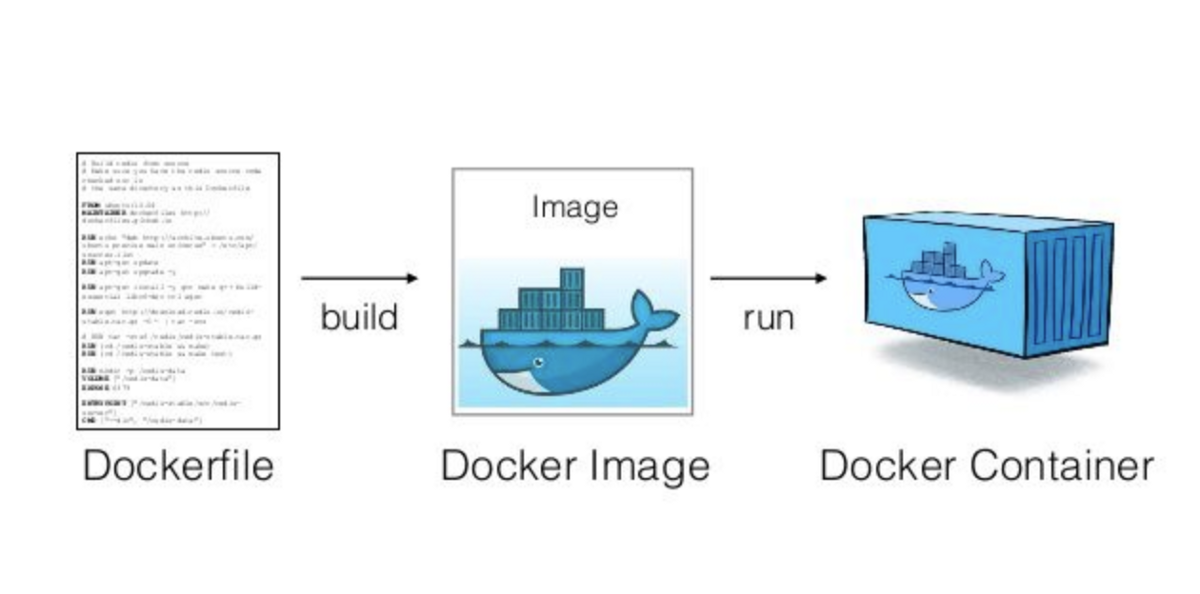 Docker 映像像是程式及其運作所需的所有內容的快照。它是一個打包版本,包括程式碼、工具和設置,就像包含所有成分的餅乾食譜的快照一樣。 **圖像是配方,容器是當您按照該配方實際製作和執行程序時所得到的。** **一些基本的 Docker 命令。** 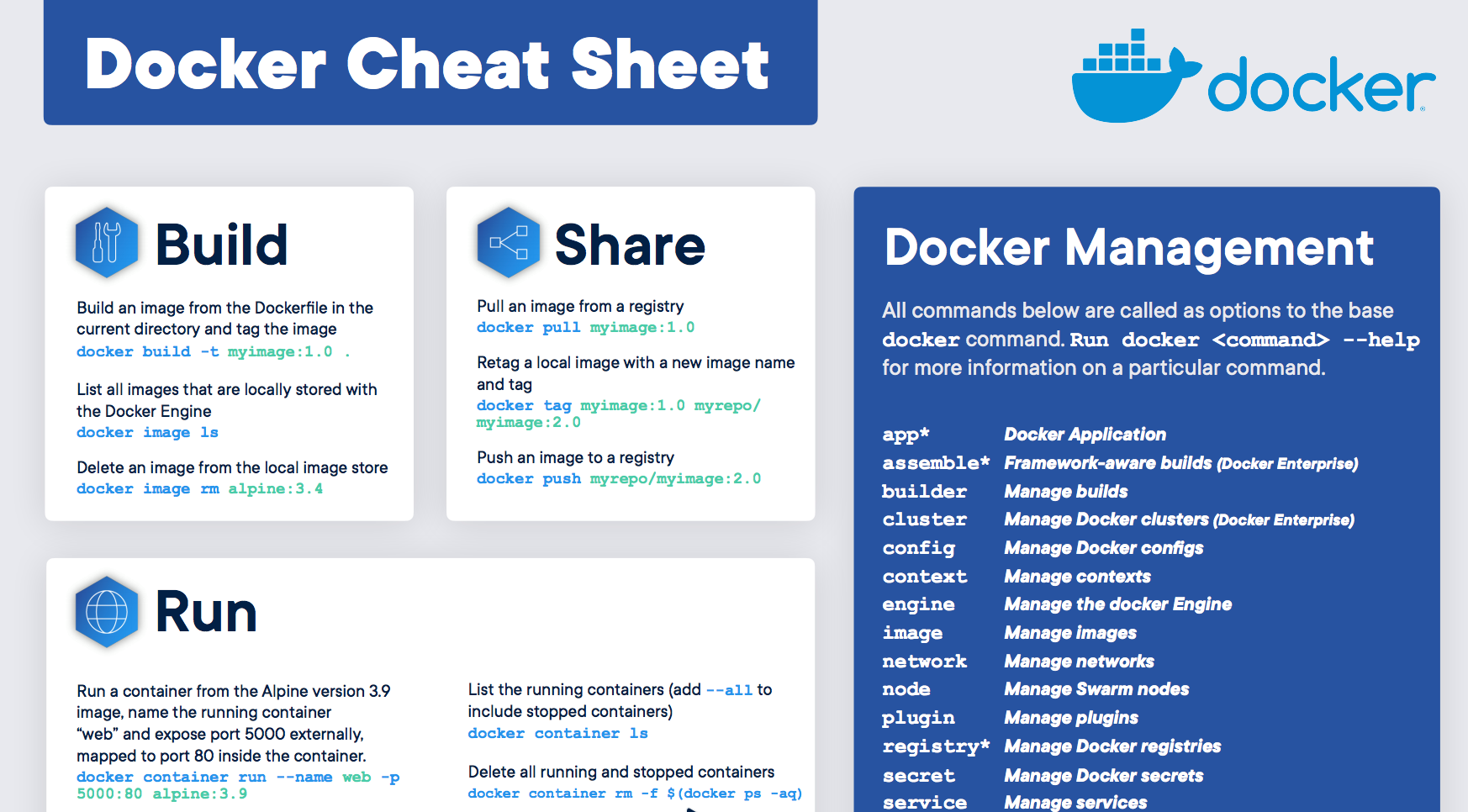 1. **`docker執行nginx`** - 此命令告訴 Docker 使用「nginx」映像執行容器。這就像告訴 Docker 啟動一個預製程式的新實例(nginx,它是一個 Web 伺服器)。 2. **`docker ps`** - 顯示正在執行的容器的清單。這就像檢查當前正在執行哪些程式。 3. **`docker ps -a`** - 顯示所有容器的列表,包括已停止的容器。這就像檢查您執行過的所有程式的歷史記錄。 4. **`docker stopsilly_sammet'** - 停止名為「silly_sammet」的正在運作的容器。這就像關閉當前正在執行的程式。 5. **`docker rmsilly_sammet'** - 刪除名為「silly_sammet」的已停止容器。這就像丟掉你不再需要的程式的指令一樣。 6. **`docker 映像`** - 列出您擁有的所有 Docker 映像。這就像查看您可以執行的所有不同程式的選單一樣。 7. **`docker rmi nginx`** - 刪除“nginx”圖像。這就像刪除您不想再使用的程式的配方。 8. **`docker拉nginx`** - 從網路下載「nginx」映像。這就像從食譜中獲取新食譜一樣。 9. **`docker 執行 ubuntu sleep 5`** - 使用「ubuntu」映像檔執行容器並使其休眠 5 秒。這就像啟動一個程序,只是等待一小會兒,然後就停止了。 10. **`docker exectracted_mcclintock cat /etc/hosts`** - 在名為「distracted_mcclintock」的正在執行的容器內執行命令。這就像在食譜書中偷看特定頁面一樣。 11. **`docker run -d kodekloud/simple-webapp`** - 從「kodekloud/simple-webapp」鏡像以分離模式執行容器。這就像啟動一個程式並讓它在背景執行。 12. **`docker Attach a043d`** - 將您的終端附加到 ID 為「a043d」的正在執行的容器。這就像跳入正在執行的程式來查看發生了什麼。 **一些 Docker 概念:** 1. **使用標籤執行:** - 標籤就像程式的版本。它指定您要執行哪個版本。 - 範例程式碼:`docker run nginx:latest` - 這將執行最新版本的 Nginx 程式。 2. **使用標準輸入執行:** - STDIN 就像在鍵盤上打字一樣。有些程式需要您的輸入。 - 範例程式碼:`docker run -i -t ubuntu` - 這會在 Ubuntu 容器內執行互動終端,讓您可以鍵入命令。 3. **使用連接埠映射執行:** - 連接埠就像門。程式使用它們與外界進行通訊。 - 範例程式碼:`docker run -p 8080:80 nginx` - 這將執行 Nginx,並打開電腦連接埠 8080 上的門,將其連接到容器的連接埠 80。 4. **使用磁碟區映射執行:** - 磁碟區就像共用資料夾。它們讓您可以將東西存放在容器之外。 - 範例程式碼:`docker run -v /your/local/folder:/container/folder nginx` - 這將執行 Nginx 並將電腦上的資料夾連接到容器內的資料夾。 5. **檢查容器:** - 檢查就像仔細檢查正在執行的程式。 - 範例程式碼:`docker檢查container_name` - 這為您提供有關正在執行或已停止的容器的詳細資訊。 6. **容器日誌:** - 日誌就像日記。他們記錄程式正在做什麼。 - 範例程式碼:“docker 日誌容器名稱” - 這會向您顯示特定容器的日誌或活動。 ##環境變數 環境變數就像程式用來尋找重要資訊的便利筆記,有點像是程式可以理解和更好工作的秘密訊息! 1. **Python腳本(app.py)中的環境變數:** - 假設您有一個用 Python 寫的程式 (app.py)。您可能想要在不更改程式碼的情況下自訂它。您可以使用環境變數。 - 範例程式碼(app.py): ``` import os app_color = os.getenv("APP_COLOR", "default_color") print(f"The app color is {app_color}") ``` - 正常運作腳本:`python app.py` - 以特定顏色執行:`export APP_COLOR=blue; python 應用程式.py` 2. **在 Docker 中使用 ENV 變數:** - Docker 容器也可以使用環境變數。這就像是向容器內的程式發出指令。 - 範例程式碼: - `docker run -e APP_COLOR=green simple-webapp-color` - 這會執行 Docker 容器(`simple-webapp-color`)並將環境變數 `APP_COLOR` 設為「綠色」。 3. **檢查環境變數:** - 有時,您會想要檢查正在執行的容器正在使用哪些環境變數。 - 範例程式碼:`docker檢查blissful_hopper` - 此命令提供有關名為“blissful_hopper”的容器的詳細訊息,包括其環境變數。 簡單來說,環境變數就像程式(或 Docker 容器)可以讀取以了解如何行為的小註釋。您可以在執行程式之前設定這些註釋,程式將使用它們來自訂自身。第二個範例中的「export」指令就像在執行程式之前寫一條註釋,告訴它如何運作。 “docker Inspect”指令就像是在容器內部查看它有什麼註解。 ## Docker 映像 **Docker 檔案:** Dockerfile 就像是 Docker 建立映像的一組指令。這就像是烤蛋糕的食譜。 ``` # Use the Ubuntu base image FROM Ubuntu # Update apt repository RUN apt-get update # Install dependencies using apt RUN apt-get install -y python # Install Python dependencies using pip RUN pip install flask RUN pip install flask-mysql # Copy source code to /opt folder COPY . /opt/source-code # Set the working directory WORKDIR /opt/source-code # Specify entry point to run the web server ENTRYPOINT ["flask", "run"] ``` **建立自己的圖像的步驟:** 1. 使用上述內容建立一個名為「Dockerfile」的檔案。 2. 將其保存在與原始碼相同的目錄中。 **建置 Docker 映像:** 在終端機中執行以下命令: ``` docker build -t your-image-name . ``` 此命令告訴 Docker 使用目前目錄中的 Dockerfile (`.`) 建置映像,並使用您選擇的名稱對其進行標記 (`-t your-image-name`)。 **分層架構:**  - 將 Docker 映像視為一個分層蛋糕。 Dockerfile 中的每個指令都會在映像上新增一層。 - 圖層可重複使用。如果您變更程式碼中的某些內容,Docker 只會重建受影響的層,從而提高效率。 **Docker 建置輸出:** - 當您建置映像檔時,Docker 會顯示流程中的每個步驟。如果發生故障,它會給您錯誤訊息。 **你可以容器化什麼?** - 幾乎所有東西!應用程式、服務、資料庫、網站,基本上任何軟體都可以容器化。 - 這就像將您的軟體放入一個盒子中,以便它可以在任何地方執行而不會造成麻煩。 ## 什麼是 Docker CMD 與 ENTRYPOINT **Docker 中的`CMD`:** - 將 CMD 視為啟動容器時程式執行的預設操作。 - 這就像說,“嘿,當你執行這個容器時,默認執行此操作。” - 範例:`CMD ["flask", "run"]` 表示當容器啟動時,它會自動執行 Flask Web 伺服器。 **CMD 範例:** ``` FROM alpine CMD ["sleep", "5"] ``` 在此範例中,當您使用此映像執行容器時,它會自動休眠 5 秒。 **Docker 中的`ENTRYPOINT`:** - 將 ENTRYPOINT 視為容器所做的主要事情。就好像boss的命令一樣。 - 它設定一個預設應用程式在容器啟動時執行,但您仍然可以根據需要覆蓋它。 - 範例:`ENTRYPOINT ["flask", "run"]` 表示容器主要用於執行 Flask Web 伺服器,但如果需要,您仍可新增更多指令。 **入口點範例:** ``` FROM alpine ENTRYPOINT ["sleep"] CMD ["5"] ``` 在這裡,主要目的是睡眠,如果您願意,您仍然可以覆蓋睡眠持續時間。 在這兩種情況下,容器在啟動時只會休眠幾秒鐘。主要區別在於如何提供參數以及它們是否可以輕鬆覆蓋。 CMD 就像在說,“這是默認要做的事情”,而 ENTRYPOINT 就像在說,“這是主要要做的事情,但如果你願意,你可以稍微調整一下。”它們都有助於定義容器啟動時執行的操作。 ## Docker 中的網路: Docker 網路幫助容器(程式)相互通信,確保它們可以順利地協同工作。 **預設網路:** - Docker 建立預設網路供容器通訊。 - 範例程式碼:`docker run ubuntu --network=host` - 這使用主機網路執行 Ubuntu 容器,這意味著它與主機共享網路命名空間。 **使用者定義的網路:** - 您可以建立自己的網路以更好地組織和控制。 - 範例程式碼: ``` docker network create --driver=bridge --subnet=182.18.0.0/16 custom-isolated-network ``` - 這將建立一個名為「custom-isolated-network」的使用者定義的橋接網絡,具有特定的子網。 **上市網路:** - 您可以查看您擁有的所有網路。 - 範例程式碼:`docker network ls` **檢查網路:** - 您可以檢查特定網路的詳細資訊。 - 範例程式碼:`docker網路檢查blissful_hopper` - 這顯示有關名為「blissful_hopper」的網路的詳細資訊。 **嵌入式 DNS:** - Docker 有一個內建的 DNS 系統,供容器透過名稱相互查找。 - 範例程式碼:`mysql.connect(mysql)` - 這可能是程式碼中的一行,其中名為「mysql」的服務使用 Docker 的 DNS 連接到另一個名為「mysql」的服務。 ## Docker 儲存:  Docker 儲存就像使用容器時決定將資料保存在哪裡一樣。您可以將它們保留在容器內,使用磁碟區在容器之間共用它們,或將它們儲存在容器外部以妥善保管。 **Docker中的檔案系統:** - Docker 使用分層架構來建立映像。 Dockerfile 中的每個指令都會在檔案系統中新增一個新圖層。 ``` # Dockerfile FROM Ubuntu RUN apt-get update && apt-get install -y python RUN pip install flask flask-mysql COPY . /opt/source-code WORKDIR /opt/source-code ENTRYPOINT ["flask", "run"] ``` - Dockerfile 中的層: - 第 1 層:Ubuntu 基礎層 - 第 2 層:apt 軟體包的更改 - 第 3 層:pip 套件的變化 - 第 4 層:原始碼 - 第 5 層:使用「flask」指令更新入口點 - 第 6 層:容器層 **影像圖層:** - 當您建立 Docker 映像時,它由唯讀層組成。每一層代表影像的變化或加入。 - 第 1 層:Ubuntu 基礎層 - 第 2 層:apt 軟體包的更改 - 第 3 層:pip 套件的變化 - 第 4 層:原始碼 - 第 5 層:使用「flask」指令更新入口點 ``` # Build the Docker image docker build -t mmumshad/my-custom-app . ``` **容器層:** - 當您執行 Docker 容器時,會在唯讀映像層上方新增一個讀寫層。該層特定於正在執行的容器。 - 第 6 層. 容器層 ``` # Run the Docker container docker run mmumshad/my-custom-app ``` **數量:** - 卷是一種在容器外部保存資料的方法。它們就像外部記憶體。 ``` # Create a Docker volume docker volume create data_volume # Use the volume in a container docker run -v data_volume:/var/mysql mysql ``` - 您也可以使用「-v」將特定目錄從主機掛載到容器: ``` # Mount a host directory to a container directory docker run -v /path/on/host:/var/mysql/mysql -d mysql ``` - docker run --mount 指令用於將主機上的特定目錄或檔案掛載到正在執行的 Docker 容器中。 ``` docker run --mount type=bind,source=/mysql,target=/var/mysql mysql ``` **儲存驅動程式:** - Docker 使用儲存驅動程式來管理資料的儲存和存取方式。一些常見的儲存驅動程式包括 AUFS、ZFS、BTRFS、Device Mapper、Overlay 和 Overlay2。 [在 Docker 管理資料](https://docs.docker.com/storage/) [關於儲存驅動程式](https://docs.docker.com/storage/storagedriver/) [卷](https://docs.docker.com/storage/volumes/) ## Docker 組合 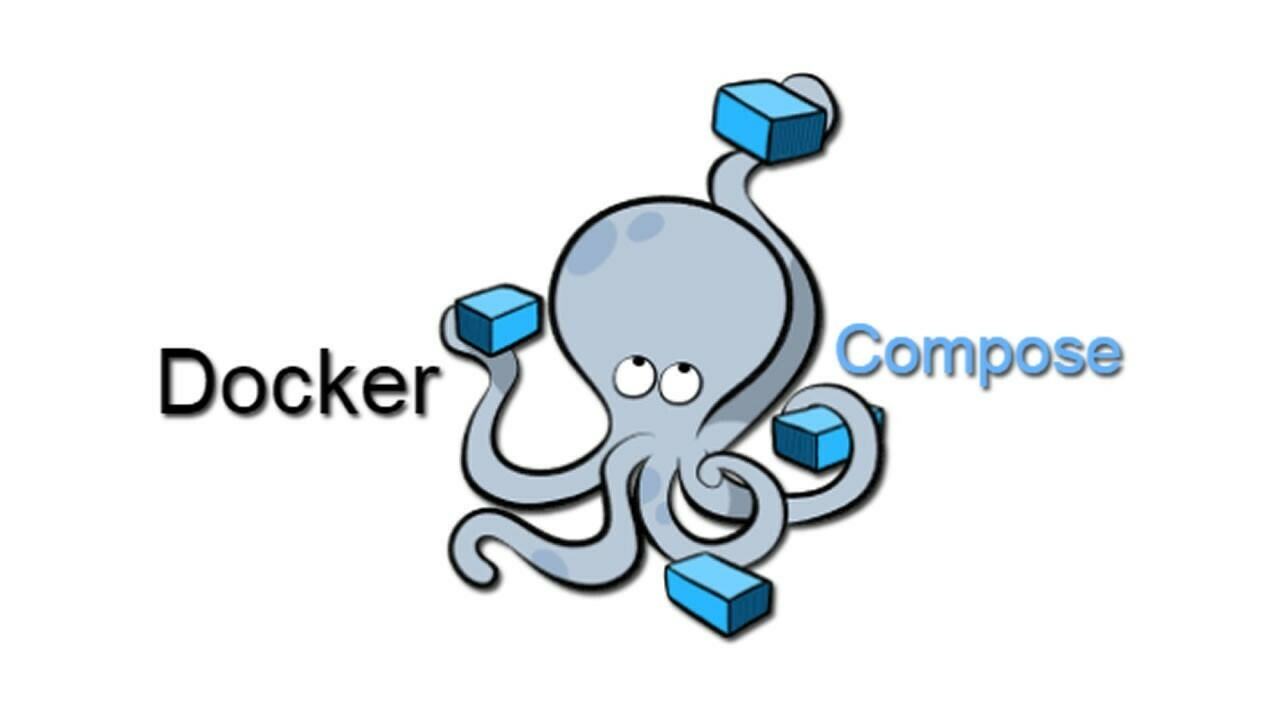 Docker Compose 是一個方便的工具,可幫助您輕鬆執行和連接不同的軟體服務,就好像它們都是同一事件的一部分一樣。 **Docker Compose 基礎:** 1. **執行單一容器:** - 通常,您可以像這樣執行單獨的 Docker 容器: ``` docker run mmumshad/simple-webapp docker run mongodb docker run redis:alpine docker run ansible ``` 2. **Docker 撰寫文件(`docker-compose.yml`):** - Docker Compose 允許您在一個簡單的檔案中定義所有這些服務: ``` # docker-compose.yml version: '3' services: web: image: 'mmumshad/simple-webapp' database: image: 'mongodb' messaging: image: 'redis:alpine' orchestration: image: 'ansible' ``` - 此檔案描述您要執行的服務(「web」、「database」、「messaging」、「orchestration」)、它們各自的映像以及任何其他配置。 3. **使用 Docker Compose 執行:** - 要一起啟動所有這些服務: ``` docker-compose up ``` - Docker Compose 負責啟動「docker-compose.yml」檔案中定義的所有容器。 4. **使用 Docker Compose 建置:** - 您也可以使用 Docker Compose 建置映像: ``` docker-compose build ``` - 此指令建置「docker-compose.yml」檔案中指定的映像。 **執行連結容器:** - 如果您要透過連結執行單一容器: ``` docker run -d --name redis redis docker run --name voting-app -p 5000:80 --link redis:redis voting-app docker run --name result-app -p 5001:80 --link db:db result-app docker run -d --name worker --link db:db --link redis:redis worker ``` - 在 Docker 中撰寫: ``` # docker-compose.yml version: '3' services: vote: image: 'voting-app' ports: - '5000:80' links: - 'redis:redis' result: image: 'result-app' ports: - '5001:80' links: - 'db:db' worker: image: 'worker' links: - 'db:db' - 'redis:redis' db: image: 'db' redis: image: 'redis' ``` Docker Compose 可讓您在單一檔案中描述整個應用程式堆疊,從而輕鬆管理、執行和連接不同的服務。這就像在一份計劃中寫下活動的所有任務,然後 Docker Compose 為您處理設定。 [Docker Compose 概述](https://docs.docker.com/compose/) [Docker 撰寫文件](https://docs.docker.com/engine/reference/commandline/compose/) ## Docker 註冊表 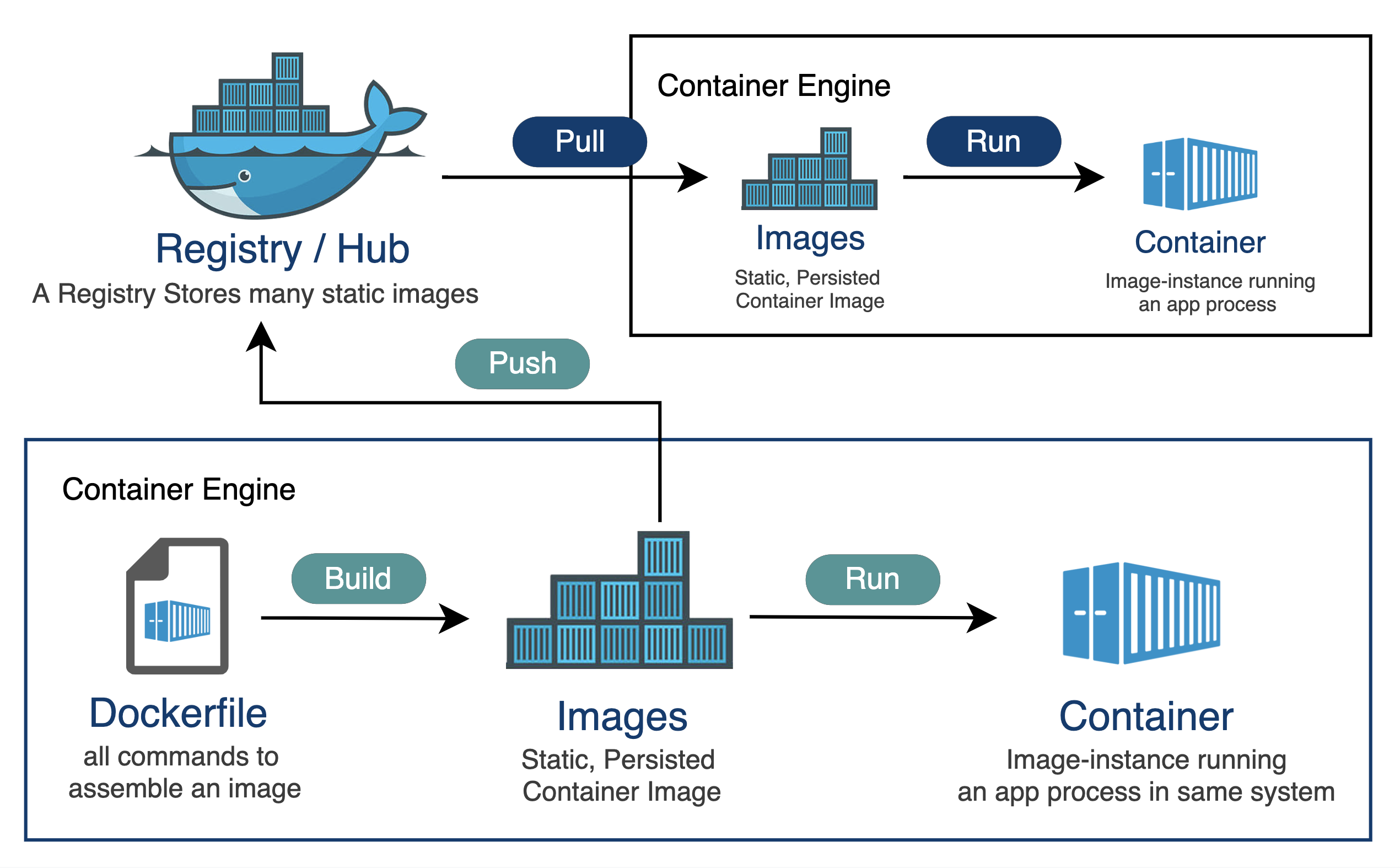 Docker 註冊表是人們儲存和分享 Docker 映像的地方,使其他人可以輕鬆使用和執行他們的軟體。它就像一個大型線上程式庫,可以輕鬆下載並在不同電腦上使用。 **Docker 註冊表基礎知識:** 1. **公共登記處:** - Docker 映像可以在 Docker Hub 等公共註冊表中儲存和共用。 - 例: ``` docker pull nginx ``` 2. **私人登記處:** - 有時,您可能希望將圖像保存在您自己的私人註冊表中。 - 例: - 登入私人註冊表: ``` bash docker login private-registry.io ``` - 從私有註冊表中的映像執行容器: ``` docker run private-registry.io/apps/internal-app ``` 3. **部署您自己的私有註冊表:** - 您可以為您的團隊或公司部署自己的私人註冊表。 - 例: - 在您的電腦上執行私有註冊表: ``` docker run -d -p 5000:5000 --name registry registry:2 ``` - 為私人註冊表標記您的圖像: ``` bash docker image tag my-image localhost:5000/my-image ``` - 將映像推送到您的私人註冊表: ``` bash docker push localhost:5000/my-image ``` - 從您的私人註冊表中提取映像: ``` bash docker pull localhost:5000/my-image ``` 4. **從遠端私有註冊表中提取:** - 您也可以使用 IP 位址或網域從遠端私有註冊表中提取映像。 - 例: ``` docker pull 192.168.56.100:5000/my-image ``` Docker 註冊表就像一個儲存空間,人們在其中保存和共享 Docker 映像。您可以將公用註冊表用於廣泛使用的映像,也可以根據您的特定需求設定自己的私人註冊表。它就像一個用於共享和儲存軟體藍圖(圖像)的特殊庫。 ## Docker 引擎 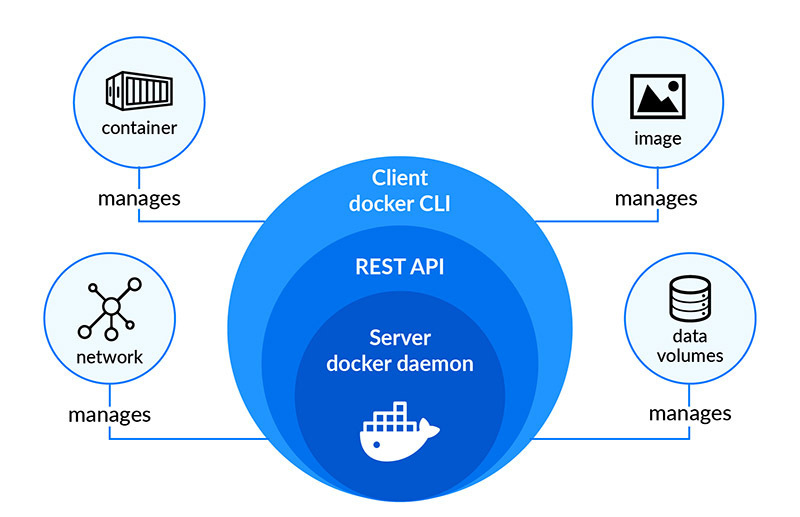 想像一下,你有一個魔盒(Docker Engine),可以為你執行和管理各種程式(容器)。 Docker Engine 就像是這個魔盒的大腦。 1. **Docker 守護程式:** - 守護程式就像魔法盒的看門人。它始終在那裡,隨時準備接受指示並確保一切順利進行。 2. **REST API:** - 將 REST API 視為一組允許您與魔盒對話的規則。它就像你和守護程式用來溝通的語言。你告訴守護程式要做什麼,它會理解,因為你們說的是同一種語言。 3. **Docker CLI(命令列介面):** - Docker CLI 就像是用來命令守護程式的魔杖。您輸入指令,守護程式就會按照您的指示進行操作。這就像說「Abracadabra」就能讓事情發生。 **連線到遠端 Docker 引擎:** 連接到遠端 Docker 引擎可讓您控制另一台機器上的容器,且設定約束可確保容器僅使用指定的資源。 1. **Docker主機IP:** - 您可以使用 IP 位址和連接埠連接到不同電腦上的 Docker 引擎。 - 例: ``` docker -H=remote-docker-engine:2375 run nginx ``` - 這告訴您的本機 Docker CLI 與遠端 Docker 引擎進行通訊。 2. **有約束地執行容器:** - Docker 允許您設定容器的資源限制,例如 CPU 和記憶體限制。 - 例: ``` docker run --cpus=0.5 ubuntu docker run --memory=100m ubuntu ``` - 這些指令限制容器僅使用半個 CPU 核心和 100 MB 記憶體。 當然,讓我們簡化一下PID命名空間的概念: **命名空間PID:** PID 命名空間可讓您為容器中的進程(如程式或任務)建立單獨的區域,因此它們有自己的一組「票號」(進程 ID),不會與容器外的進程發生衝突。 **範例程式碼:** 1. **使用主機 PID 命名空間執行容器:** - 這表示容器與主機共用相同的「票號」。 ``` docker run --pid=host ubuntu ``` 2. **執行具有隔離 PID 命名空間的容器:** - 這表示容器有自己的一組獨立於主機的「票號」。 ``` docker run --pid=container ubuntu ``` 在第一個範例中,容器與進程交互,就好像它與主機位於同一空間中一樣。在第二個範例中,容器有自己的進程隔離空間。這就像在大型活動中擁有一個私人區域,您的團隊有自己的一套票號,讓您可以獨立於活動的其餘部分進行操作。 **容器化概念:** 1. **進程 ID 命名空間:** - 容器有自己獨立的流程 ID (PID) 空間,因此容器內的流程與容器外的流程是分開的。 - 例: ``` docker run --pid=host ubuntu ``` - 此指令使用主機的 PID 命名空間來執行容器,因此它共用相同的程序。 2. **網路命名空間:** - 容器也有自己獨立的網路命名空間,這意味著它們可以有自己的網路配置。 - 例: ``` docker run --net=host nginx ``` - 此指令使用主機的網路命名空間來執行容器。 3. **Unix分時命名空間:** - 此命名空間允許容器擁有自己的時間視圖,與主機和其他容器分開。 - 例: ``` docker run --uts=host ubuntu ``` - 此指令使用主機的 Unix 時間共用命名空間來執行容器。 4. **進程間掛載命名空間:** - Mount命名空間隔離檔案系統,讓容器擁有自己的檔案系統視圖。 - 例: ``` docker run --mount=type=bind,source=/host/folder,target=/container/folder ubuntu ``` - 此指令將主機中的資料夾安裝到容器中。 當然!我們來簡化一下cgroup的概念: **C組:** cgroup(控制組的縮寫)可協助在不同進程或容器之間管理和分配系統資源,例如 CPU 和記憶體。它們確保沒有任何一個進程或容器耗盡所有可用資源,從而保持一切平衡。 **範例程式碼:** 1. **使用 Cgroup 設定 CPU 限制:** - 這就像說聚會上的每位客人只能吃一定數量的食物。 ``` docker run --cpus=0.5 ubuntu ``` - 這限制容器僅使用一半的 CPU 核心。 2. **使用 Cgroup 設定記憶體限制:** - 這就像說每位客人只能在舞池上佔據一定的空間。 ``` docker run --memory=100m ubuntu ``` - 這限制容器僅使用 100 MB 記憶體。 [Docker 引擎概述](https://docs.docker.com/engine/) [使用 Docker Engine API 進行開發](https://docs.docker.com/engine/api/) [執行時指標](https://docs.docker.com/config/containers/runmetrics/#control-groups) ## Linux容器與Windows容器的概念: **Linux 容器(預設):** Linux 容器是一種打包和執行軟體及其所需一切的方法,它們最適合執行 Linux 的電腦。 **Windows 容器:** Windows 容器是一種打包和執行軟體的方式,就像 Linux 容器一樣,但它們設計用於執行 Windows 的電腦。 **Windows 容器基礎:** 1. **集裝箱類型:** - Windows 容器有兩種主要類型:Windows Server Core 和 Nano Server。 - **Windows Server Core:** 將其視為功能更齊全的容器,適合各種應用程式。 - **Nano Server:** 將其視為一個輕量級容器,專為特定的、簡約的用例而設計。 2. **基礎鏡像:** - 基礎映像就像是建立容器時開始使用的空白畫布。 - 例: ``` docker pull mcr.microsoft.com/windows/servercore:ltsc2019 ``` - 此指令擷取 Windows Server Core 基礎映像。 - 例: ``` docker pull mcr.microsoft.com/windows/nanoserver:ltsc2019 ``` - 此命令提取 Nano Server 基礎映像。 3. **支援的環境:** - Windows 容器可以在特定版本的 Windows 作業系統上運作。 - 例: - 您可以在 Windows Server 2016 上執行 Windows 容器。 - 例: - 您可以在 Windows 10 專業版和企業版上執行 Windows 容器,並使用 Hyper-V 隔離容器進行額外隔離。 ## 容器編排  容器編排是一種管理和協調多個容器的方法,確保它們無縫協作來執行應用程式,就像一個超級智能的管理器確保所有機器人一起工作來建置完美的塔一樣。 **為什麼要編曲?** 1. **多項任務,一名經理:** - 想像一下您有許多機器人(容器)執行不同的工作。編排就像有一位超級聰明的經理(編排者),他告訴每個機器人該做什麼,並確保一切順利進行。 2. **一致性:** - 編排確保所有任務每次都以相同的方式完成。這就像為您的機器人提供了一套要遵循的指令,以確保其行為的一致性。 3. **效率:** - 編排有助於優化任務,確保資源(如時間和材料)有效利用。這就像經理確保所有機器人一起工作而不浪費能源。 4. **縮放比例:** - 當您需要完成更多工作時,編排可以輕鬆建立額外的機器人(容器)。這就像當有很多事情需要完成時神奇地召喚更多機器人來提供幫助。 5. **可靠性:** - 編排確保任務可靠地完成,即使機器人(容器)出現故障。這就像製定備份計劃來確保無論如何都能完成工作。 6. **協調:** - 編排協調任務,確保機器人無縫協作。這就像經理確保每個機器人都知道自己的角色並協作以實現總體目標。 **容器編排程式碼:** ``` # Create a Docker service with 100 replicas (instances) of a Node.js application docker service create --replicas 100 --name my-nodejs-app nodejs ``` 在這個例子中: - `docker service create`:該指令告訴 Docker 建立一個服務,該服務是一組正在執行的容器。 - `--replicas 100`:此標誌指定您需要 100 個服務實例(副本)。 - `--name my-nodejs-app`:此標誌為您的服務提供名稱,在本例中為「my-nodejs-app」。 - `nodejs`:這是 Node.js 應用程式的圖片或配方。這就像是烘焙紙杯蛋糕的藍圖。 因此,這段簡單的程式碼就像告訴您神奇的廚師助手 (Docker Swarm) 建立 Node.js 應用程式的 100 個副本,確保您有大量容器正在執行並準備好提供服務。 ## Docker 群 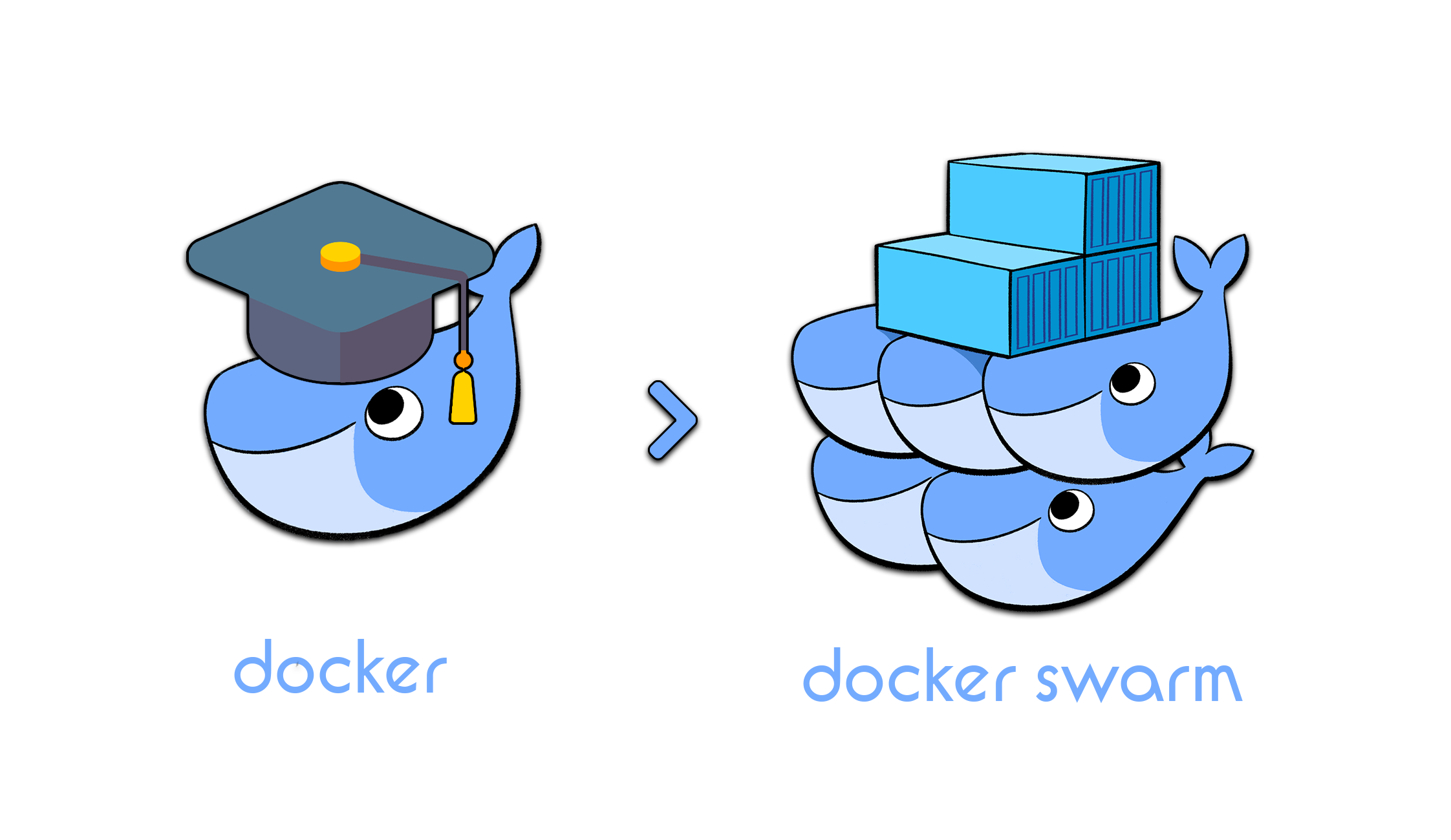 Docker Swarm 是一個工具,可以幫助協調和管理一組電腦(節點)作為一個機器人團隊一起工作,使它們能夠以協調的方式部署和執行多個容器。這就像有一個首席機器人經理,確保所有單一機器人一起建造出偉大而令人驚嘆的東西。 **設定 Docker Swarm:** 1. **群組管理器:** - 想像你有一個首席機器人(Swarm Manager)來領導團隊。主機器人決定需要做什麼,並指導其他機器人(節點)如何協同工作。 ``` # Initiate Docker Swarm on the Swarm Manager docker swarm init ``` 2. **節點工作人員:** - 現在,您的工作機器人(節點工作人員)已準備好加入團隊。 Swarm Manager 共享一個特殊的程式碼(令牌)來邀請他們一起工作。 ``` # Join a Node Worker to the Docker Swarm docker swarm join --token <token> <Swarm Manager IP> ``` **Docker Swarm 服務:** 現在您已經有了一個協調的團隊,您想要建立一項服務,例如與您的機器人團隊一起建造塔: ``` # Create a Docker service (a group of containers) with 3 replicas (instances) docker service create --replicas 3 --network frontend --name my-web-server my-web-image ``` - `--replicas 3`:此標誌告訴 Docker 建立服務的三個實例(副本)。 - `--network frontend`:此標誌指定您的服務屬於名為「frontend」的網路。 - `--name my-web-server`:這會為您的服務命名,在本例中為「my-web-server」。 - `my-web-image`:這是您的網頁伺服器的圖片或藍圖。這就像建造塔樓的配方。 您建立了一個由隊長(Swarm Manager)和工作機器人(Node Workers)組成的機器人團隊。然後,您指示他們建立一個執行您的 Web 伺服器應用程式的服務(容器群組)。主機器人確保建立 Web 伺服器的三個副本並將其連接到「前端」網路。這就像有一個首席機器人經理在工作機器人的幫助下監督多個塔(貨櫃)的建造。  **好的,這就是本文的內容。** 另外,如果您對此或其他任何問題有任何疑問,請隨時在下面的評論中或在 [Instagram](https://www.instagram.com/_abhixsh/) 、[Facebook](https://www.facebook.com/abhi.haththakage/) 或[Twitter](https://twitter.com/abhixsh)。 感謝您閱讀這篇文章,我們下一篇再見! ❤️ --- 原文出處:https://dev.to/abhixsh/docker-for-the-absolute-beginner-3h1p
你的轉職路上,還缺少一份自學作業包!寫完這幾包,直接拿作品去面試上班!
本論壇另有附設一個 LINE 新手發問&交流群組!歡迎加入討論!